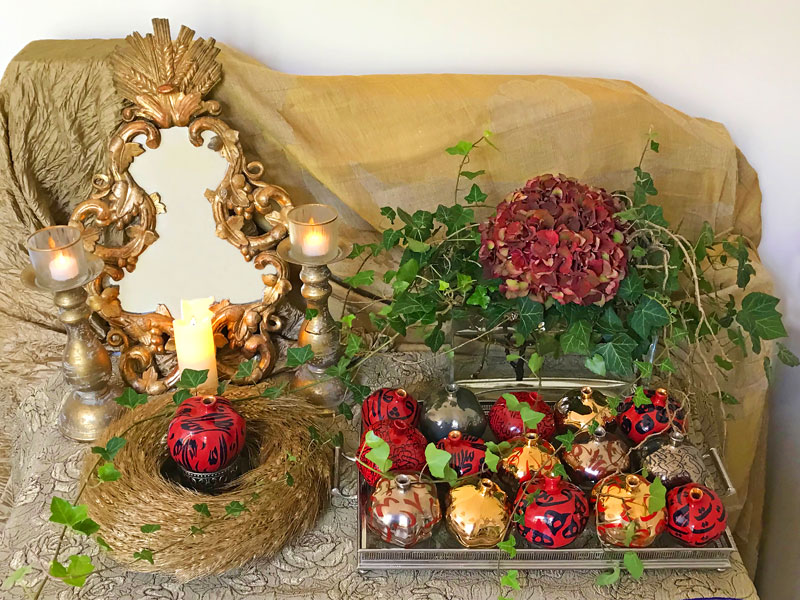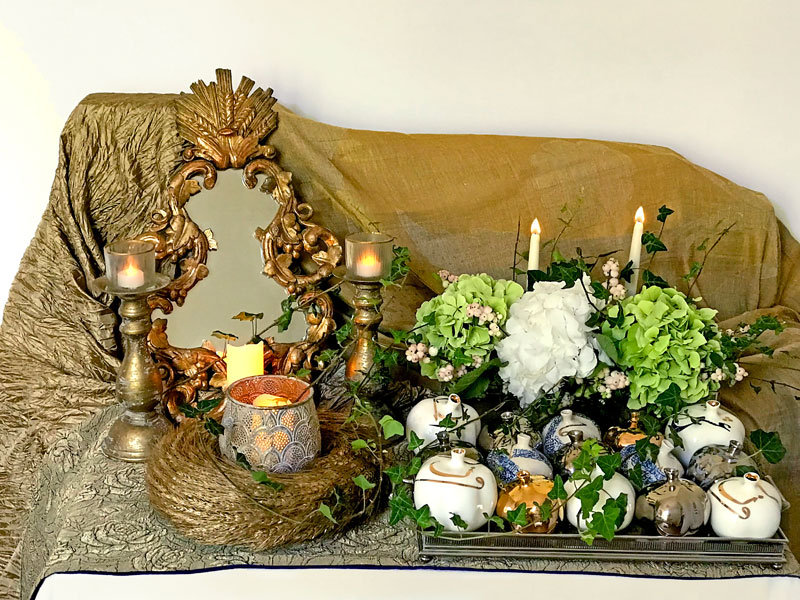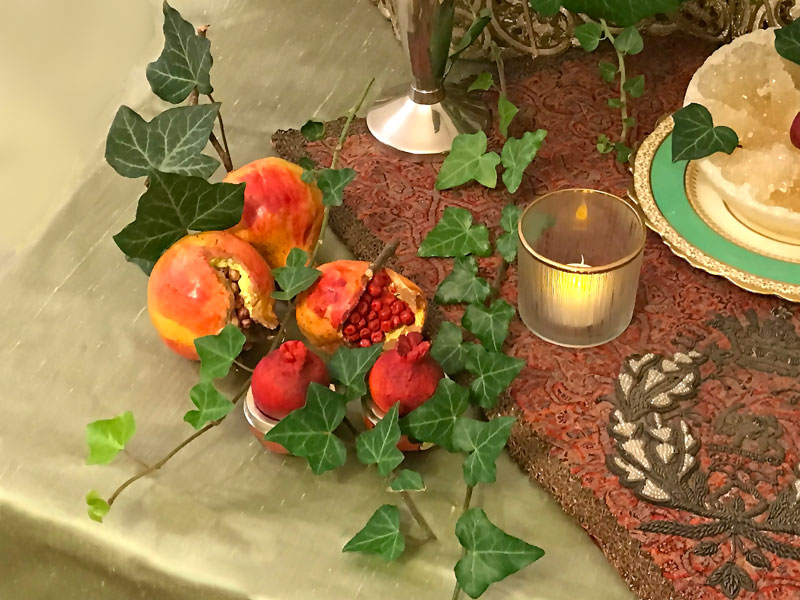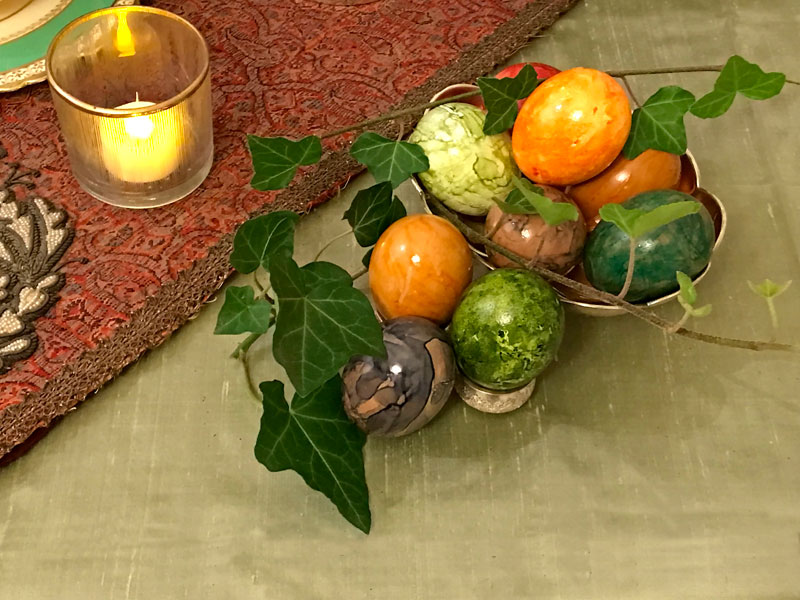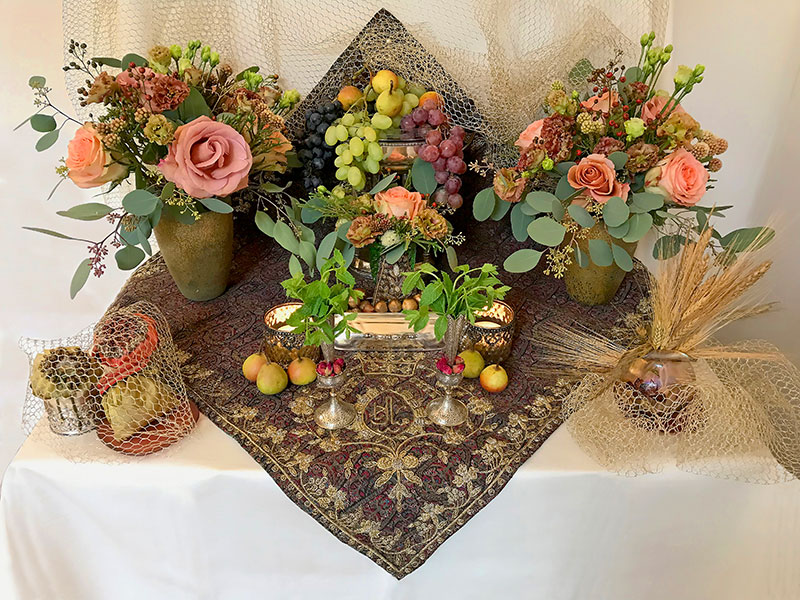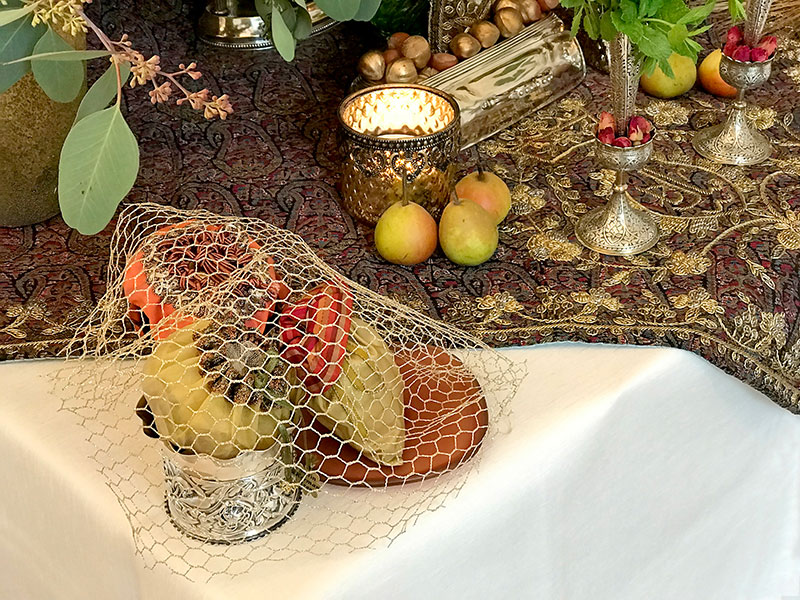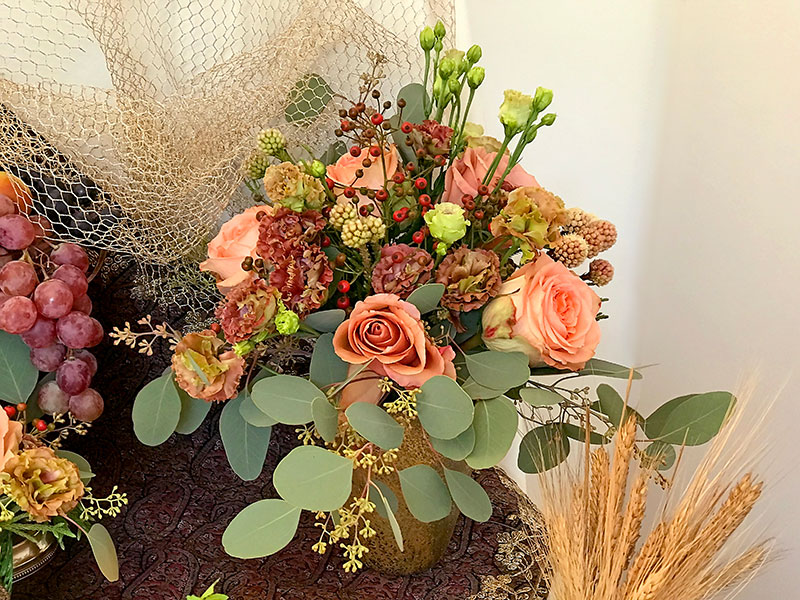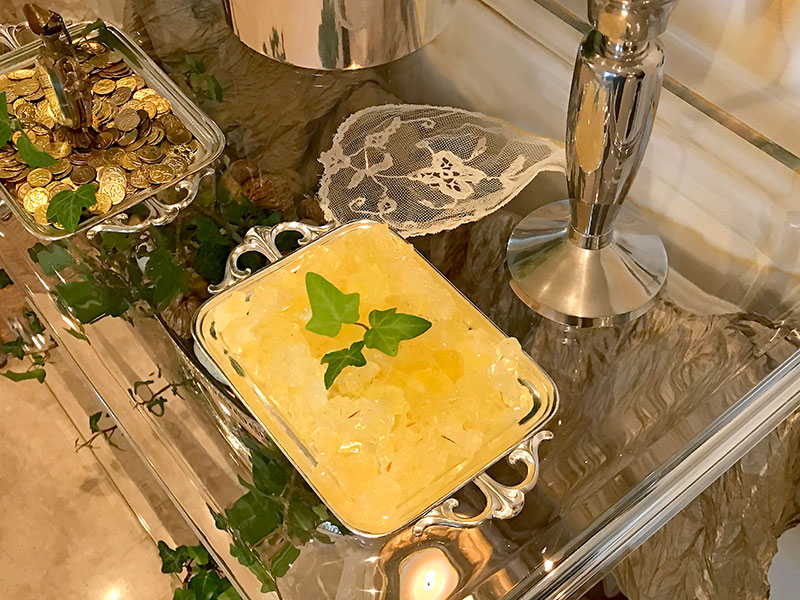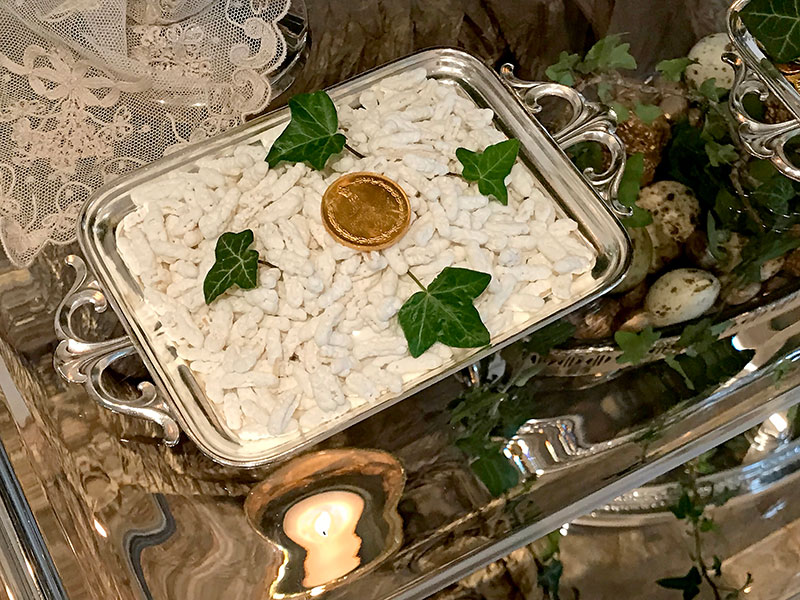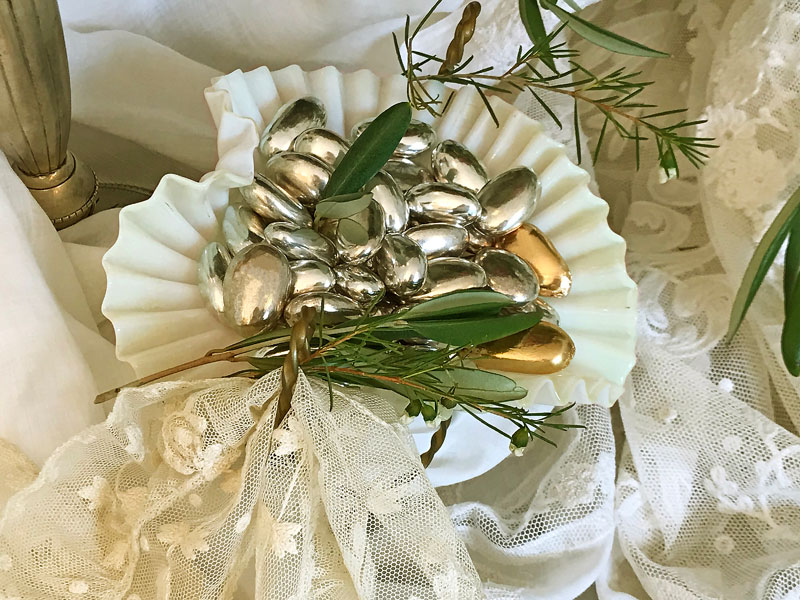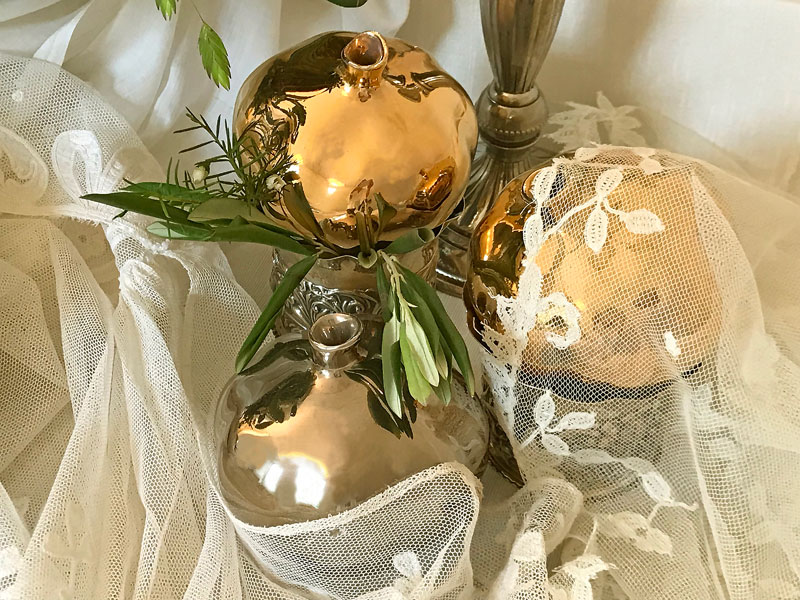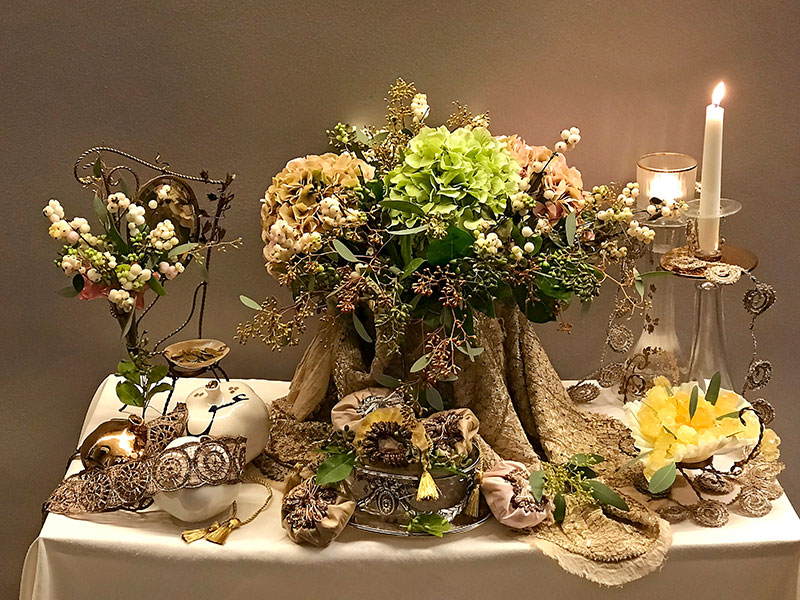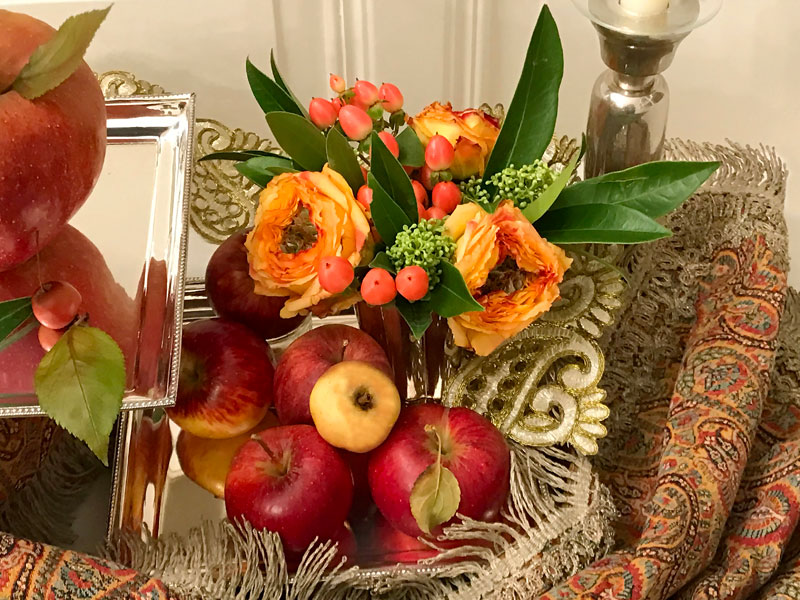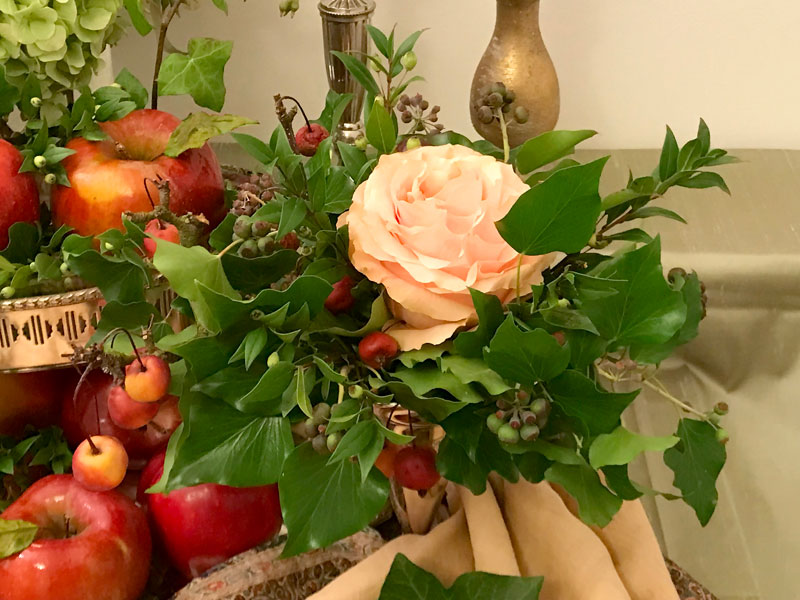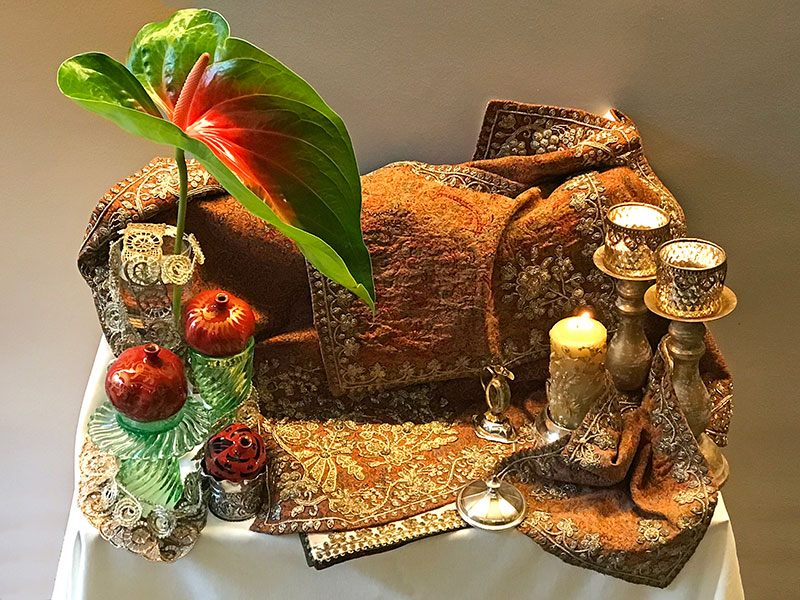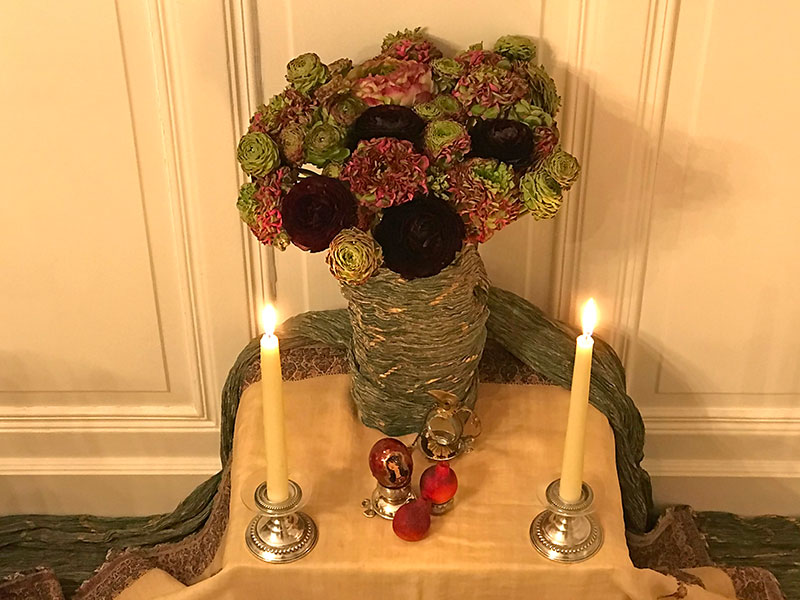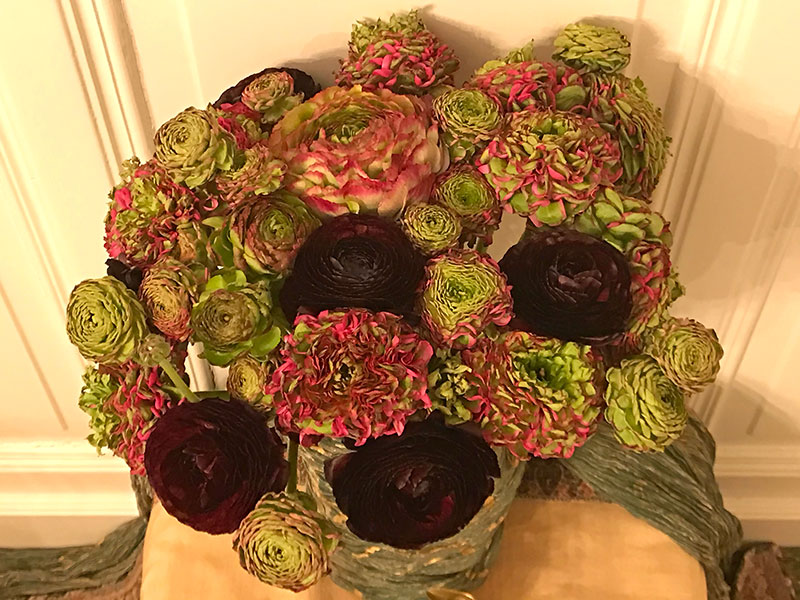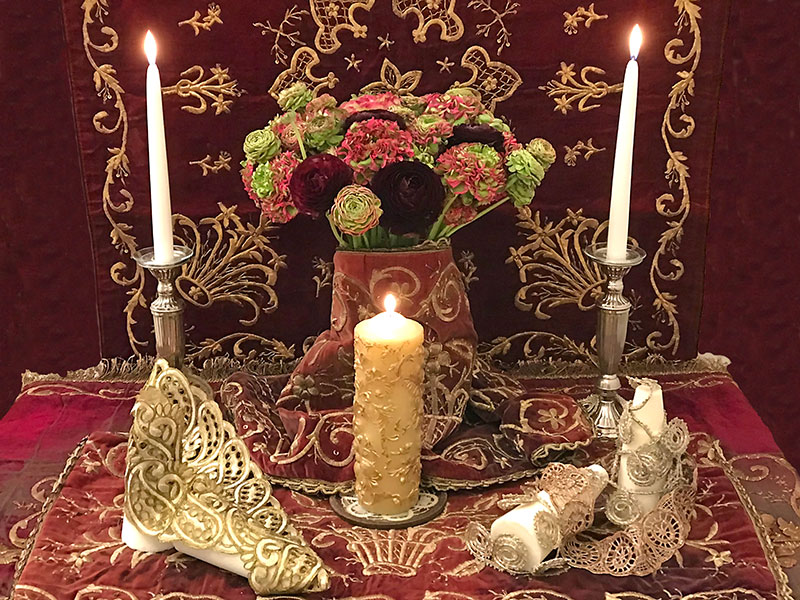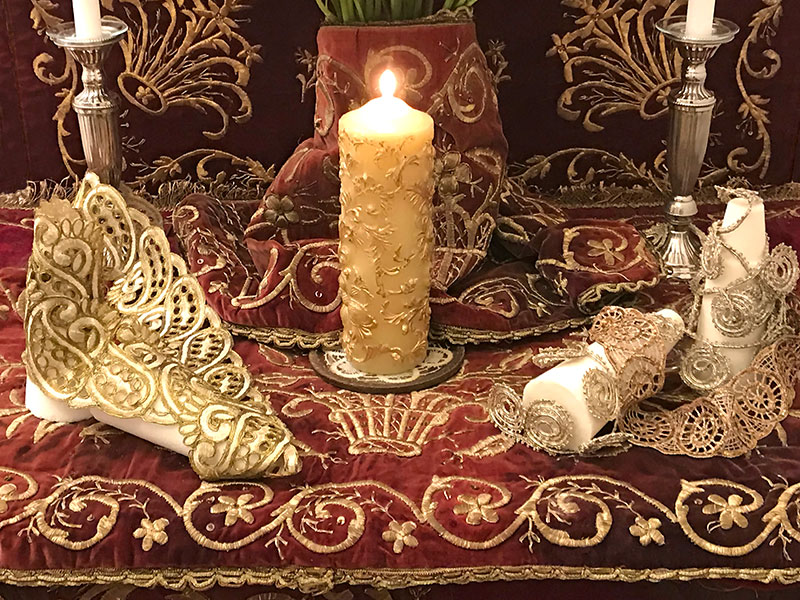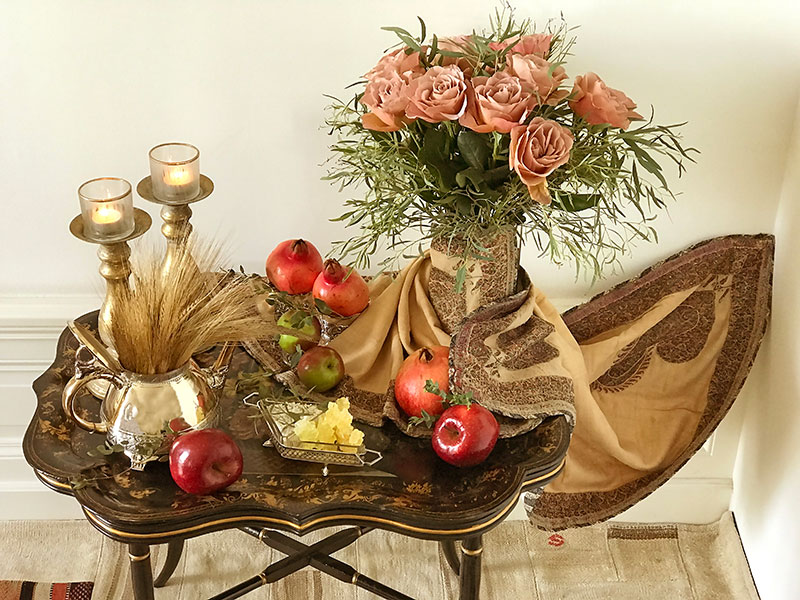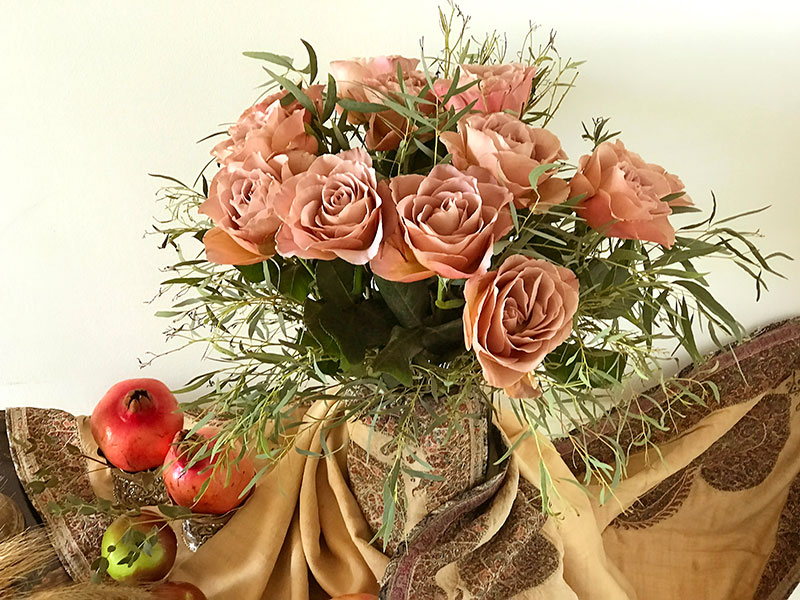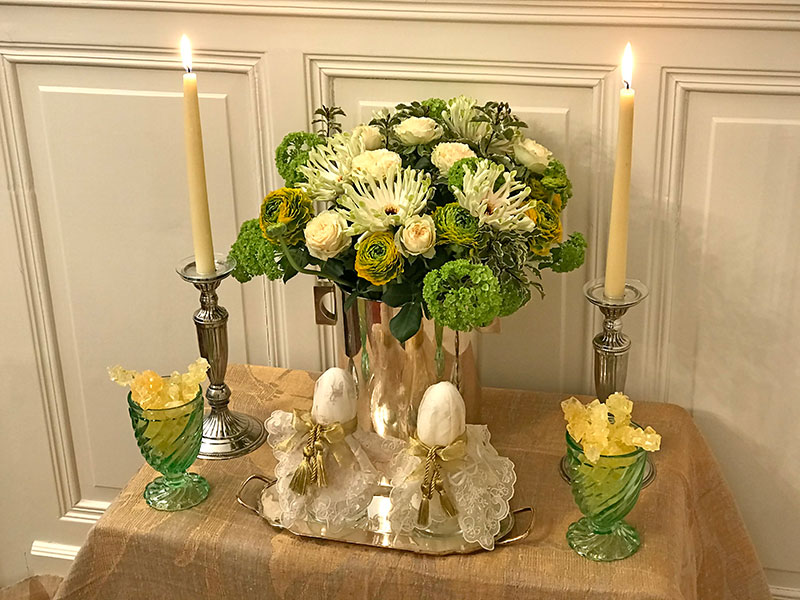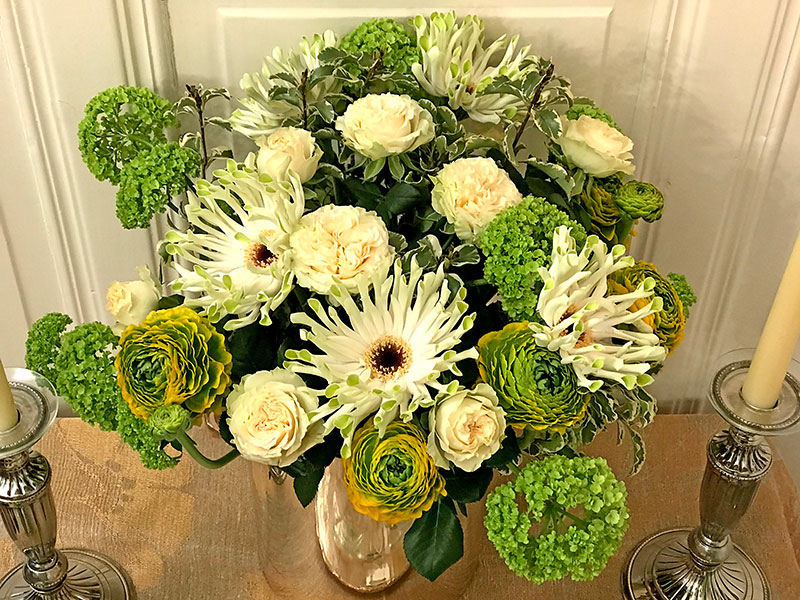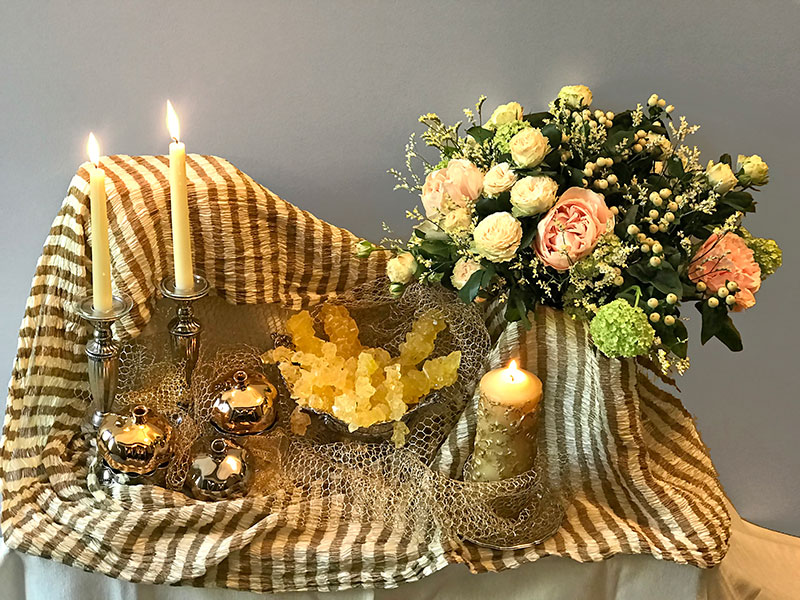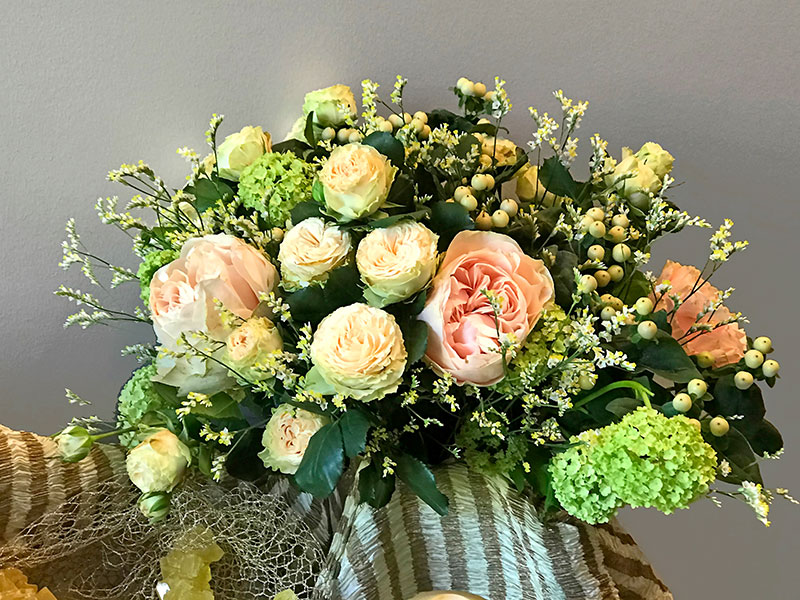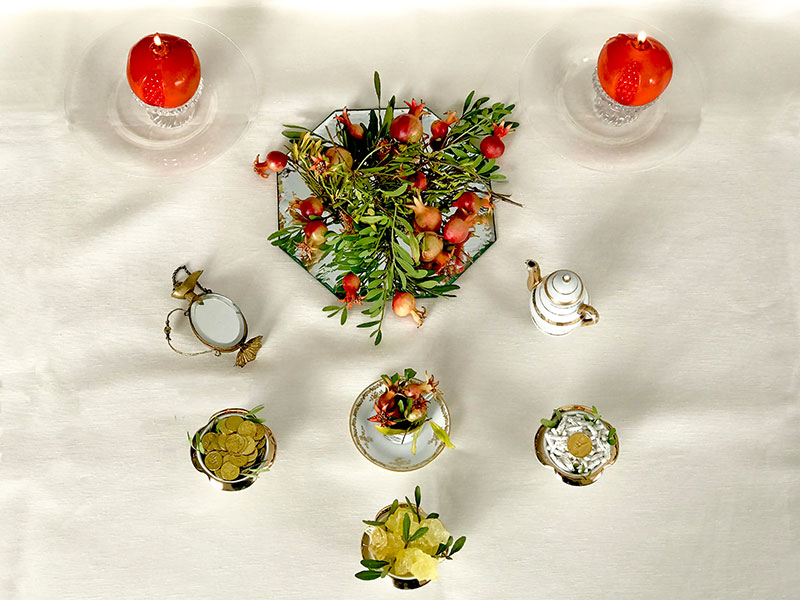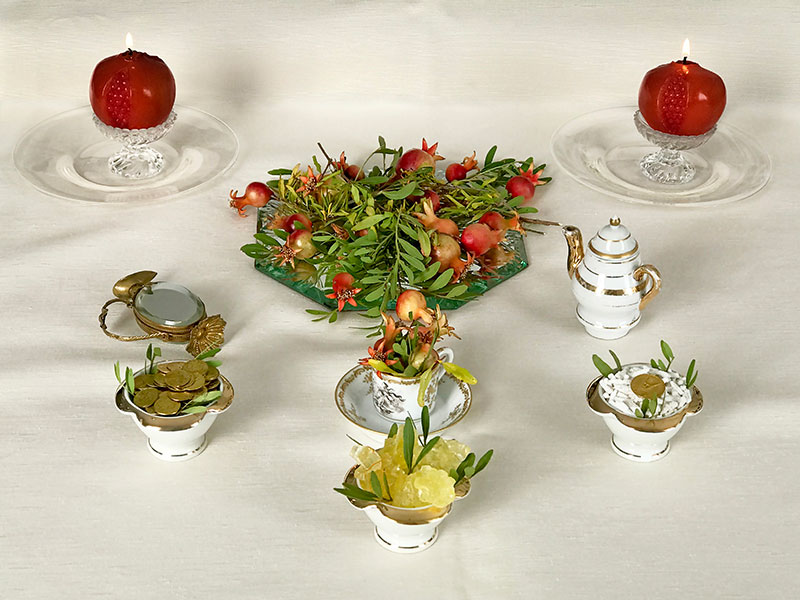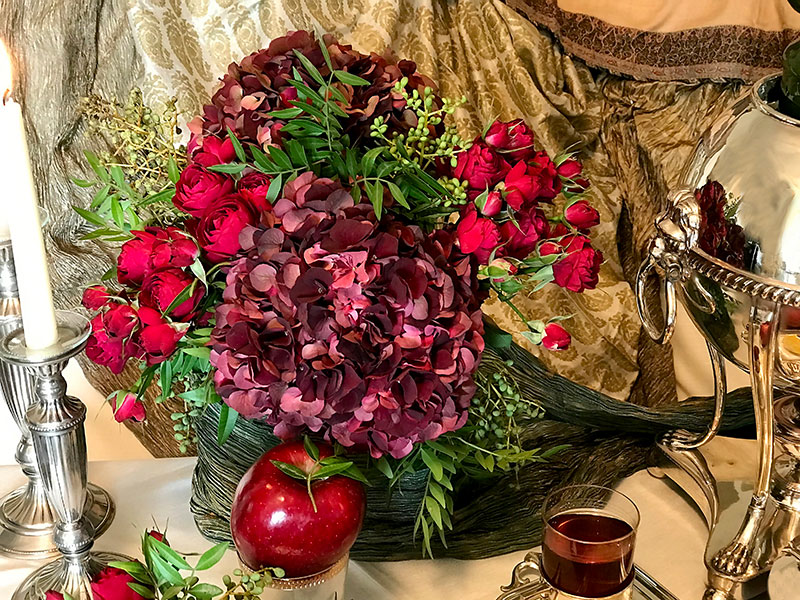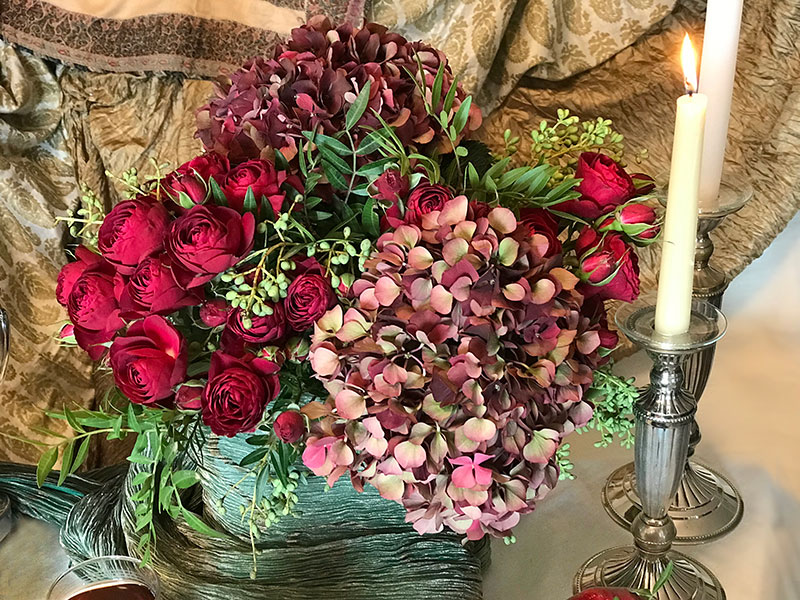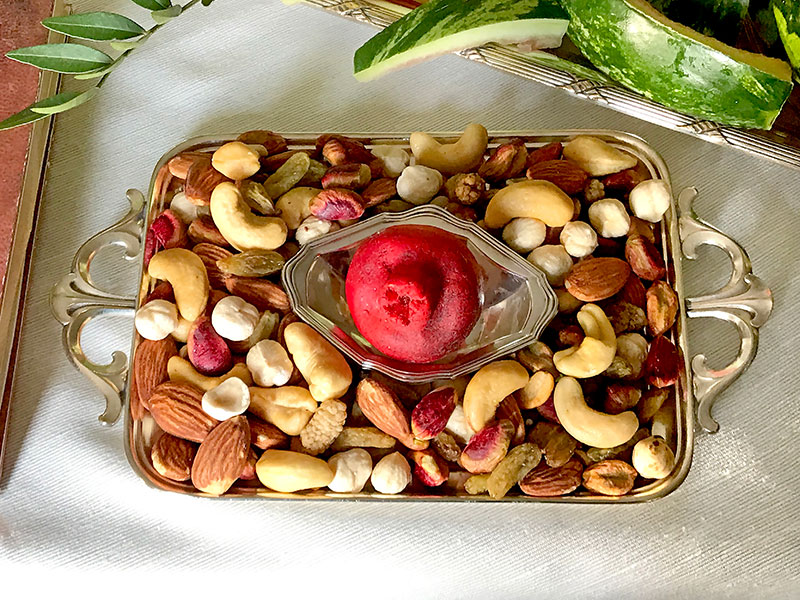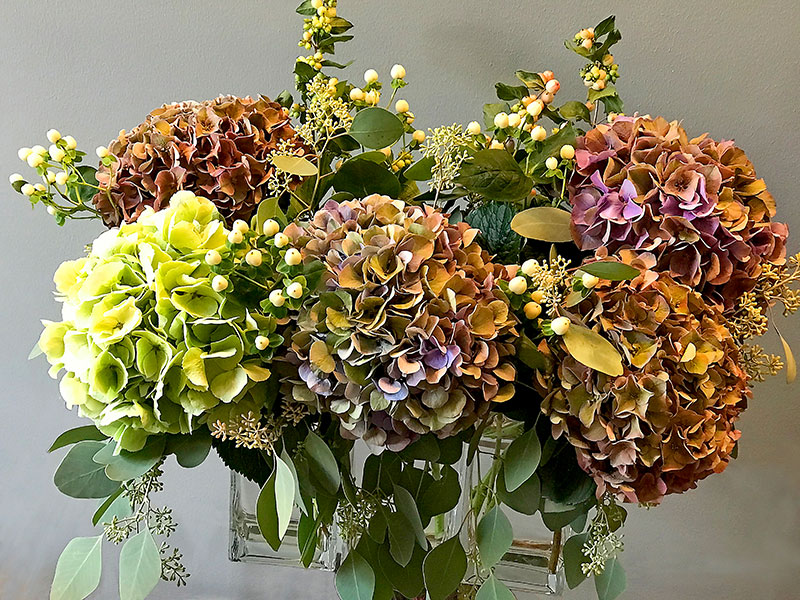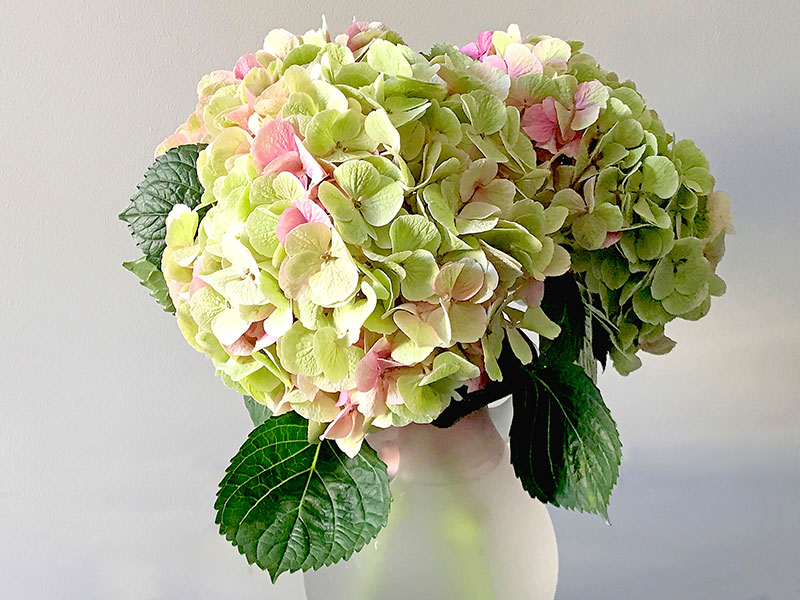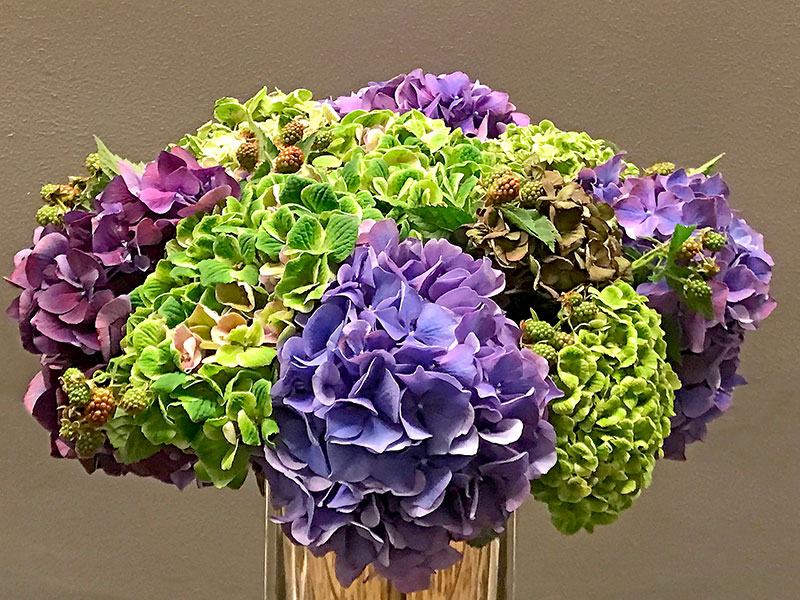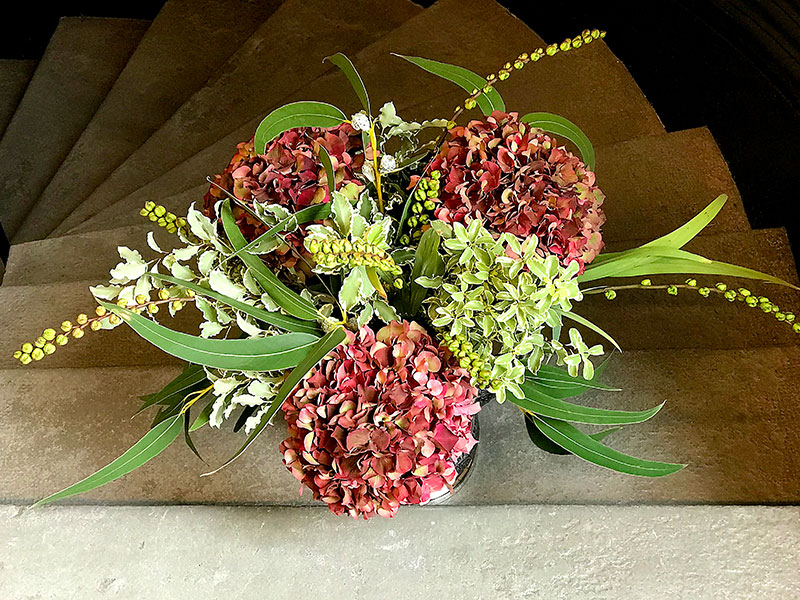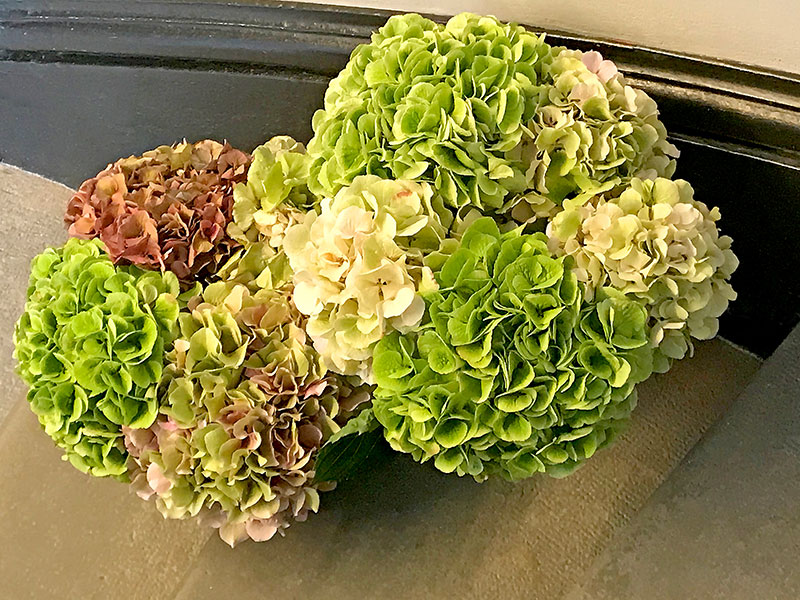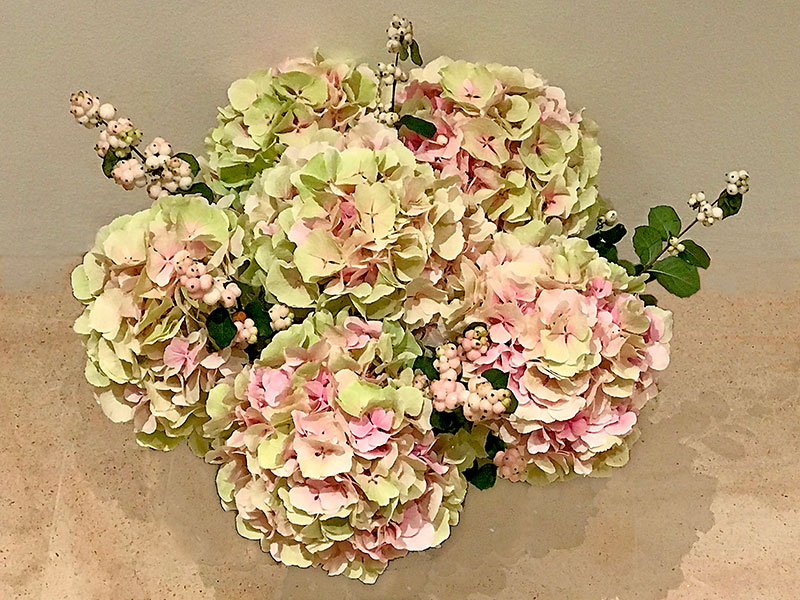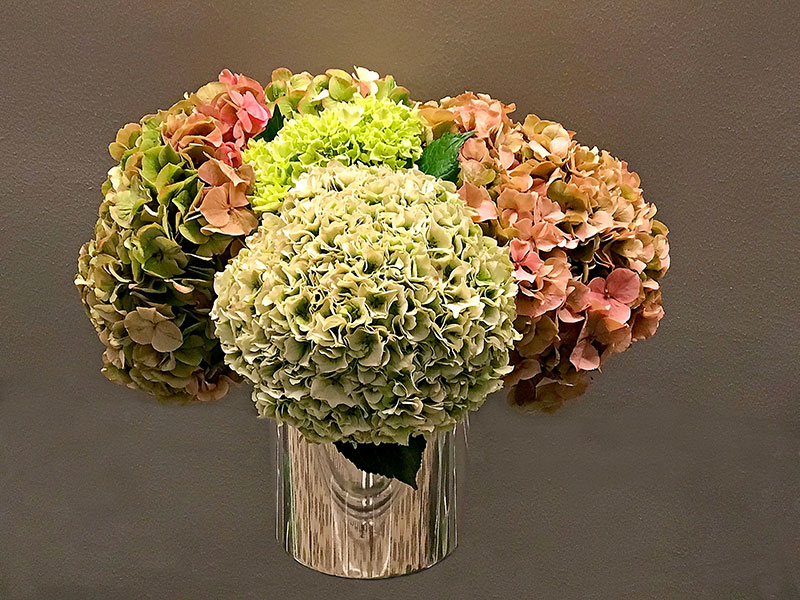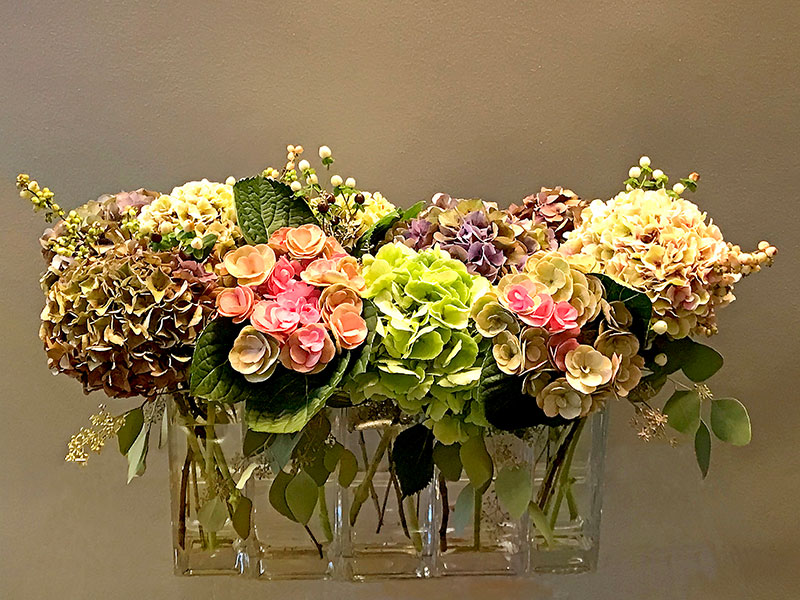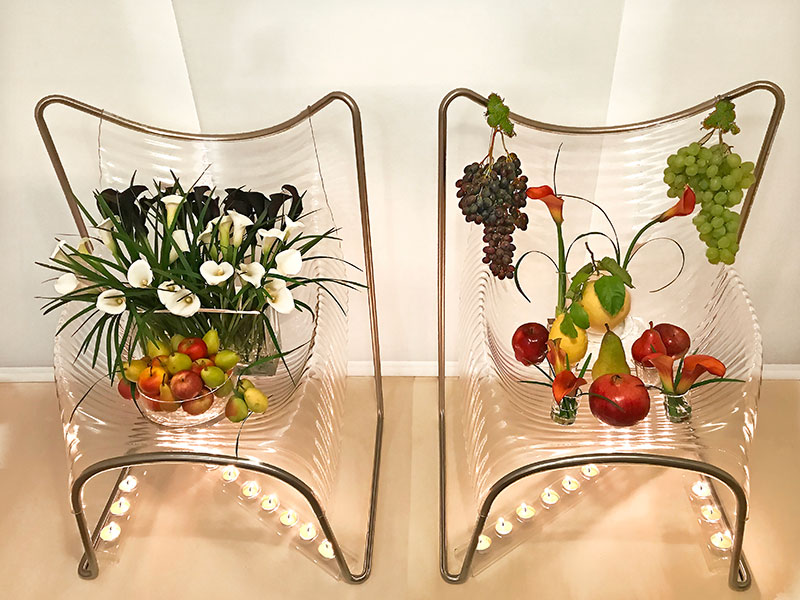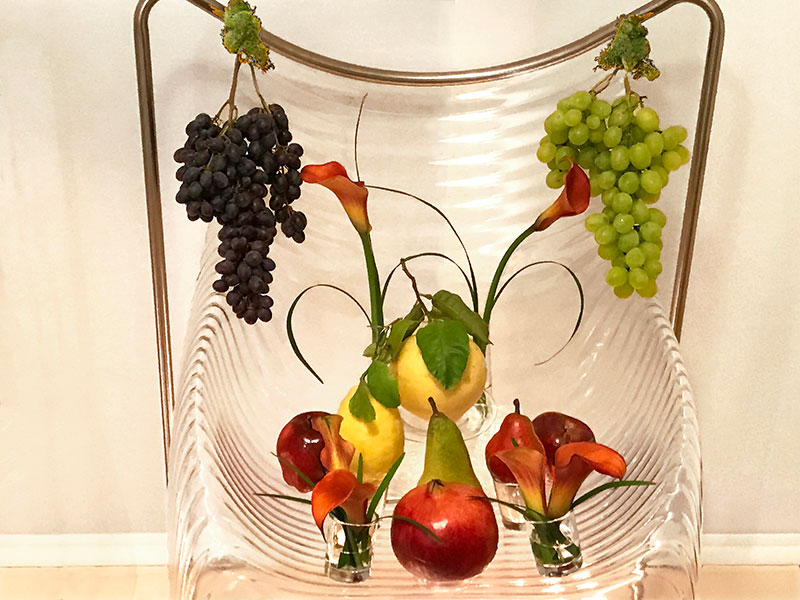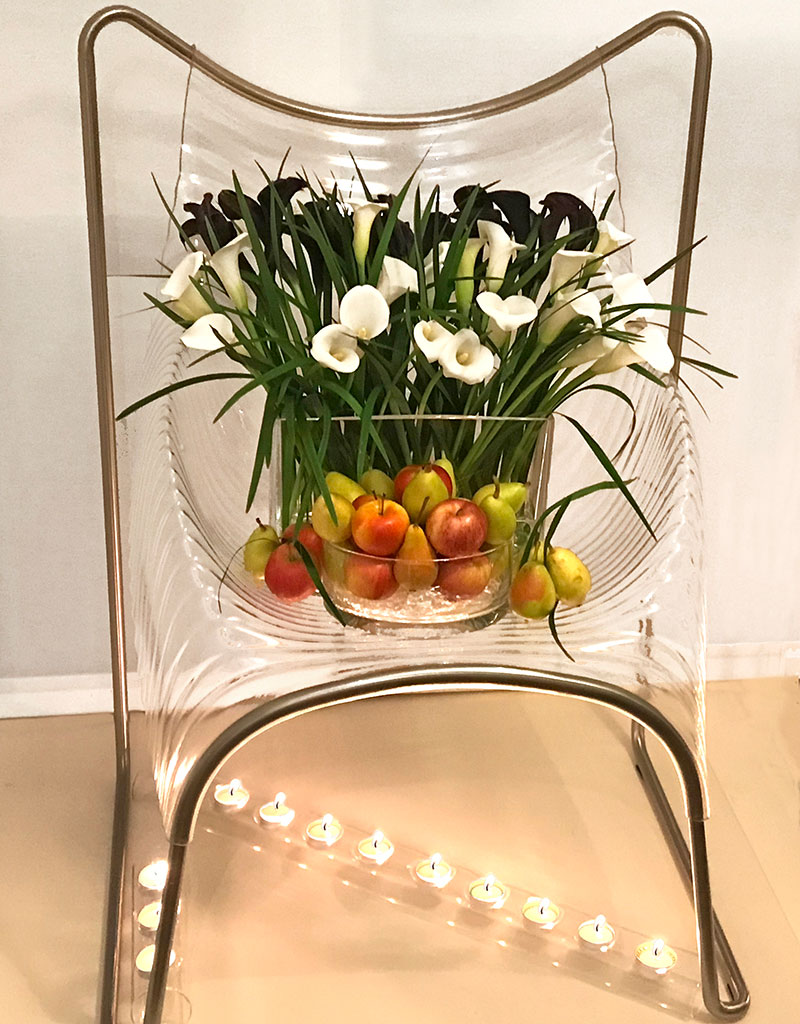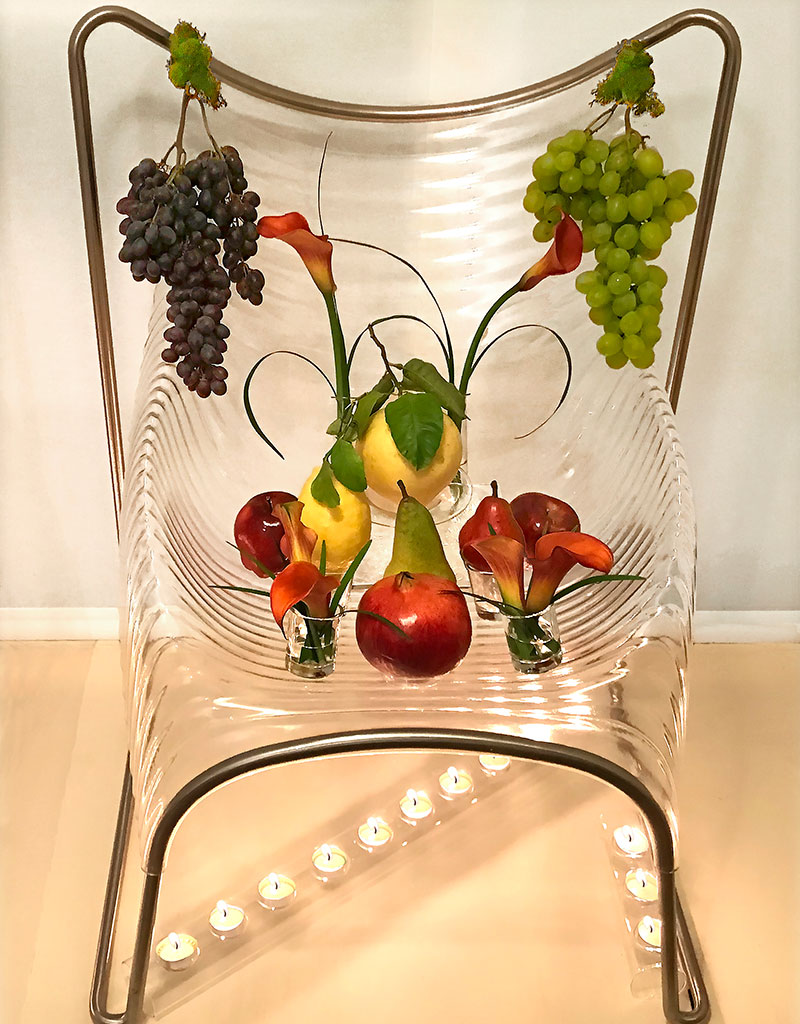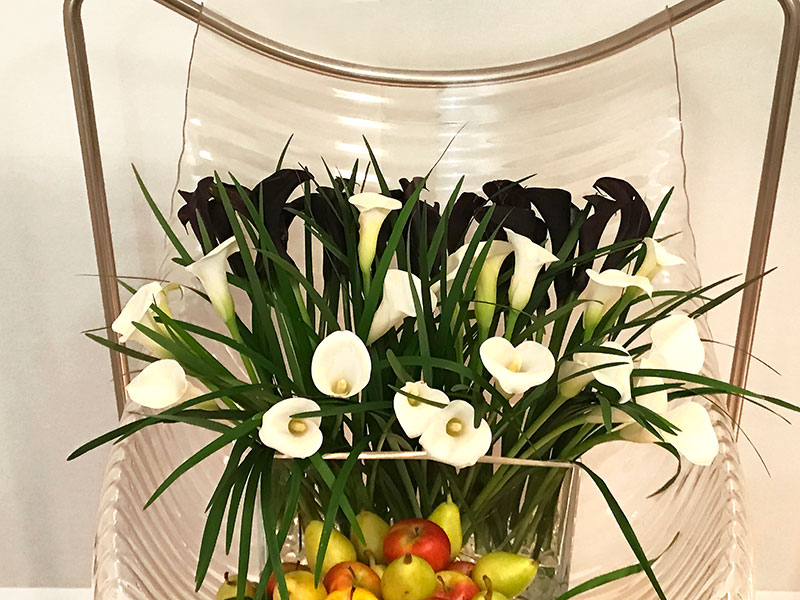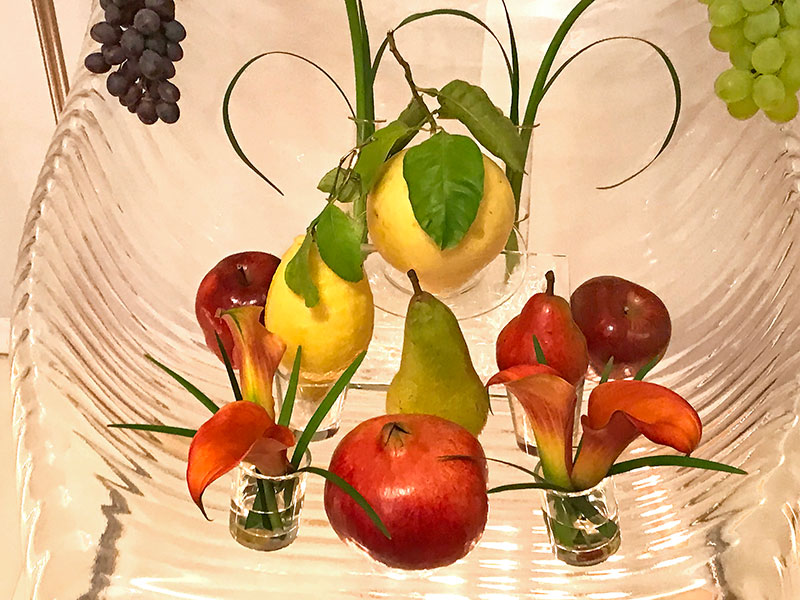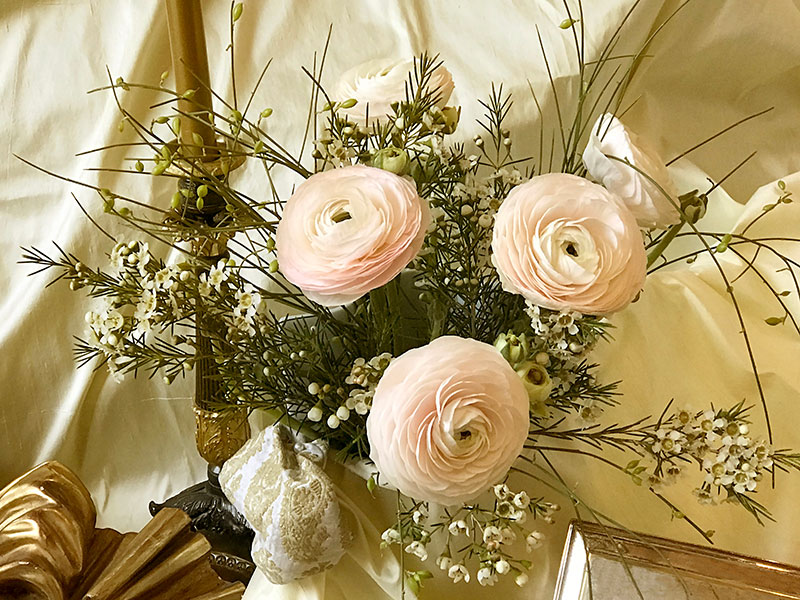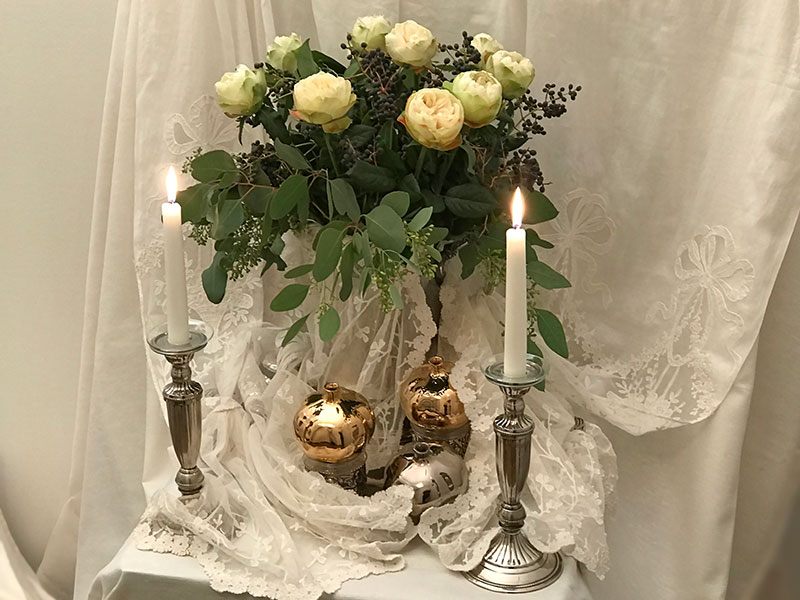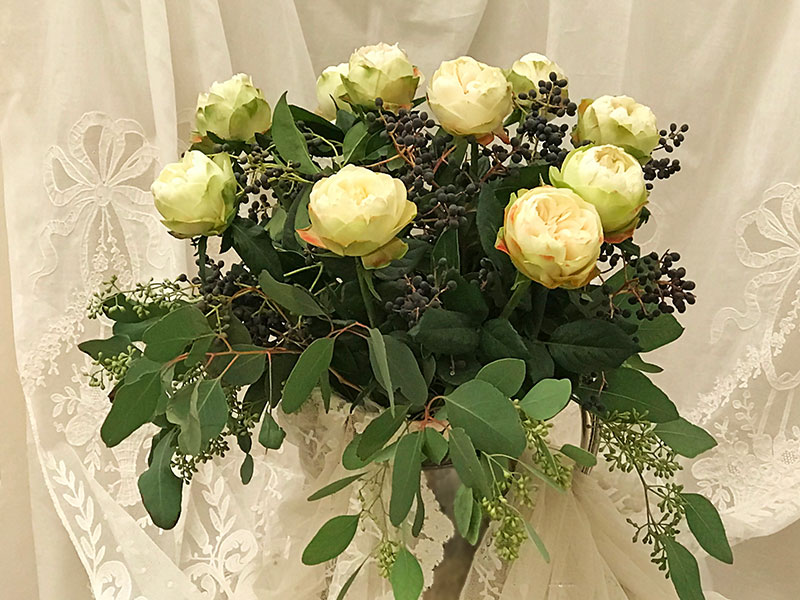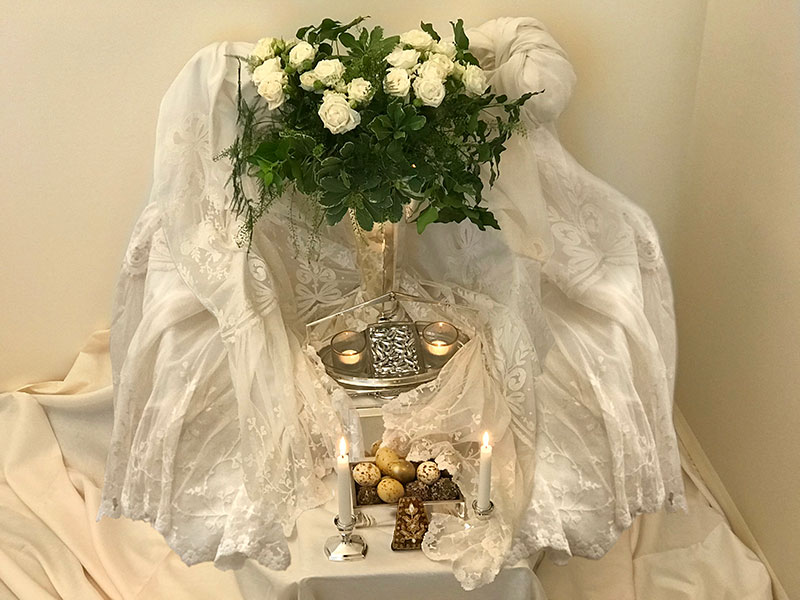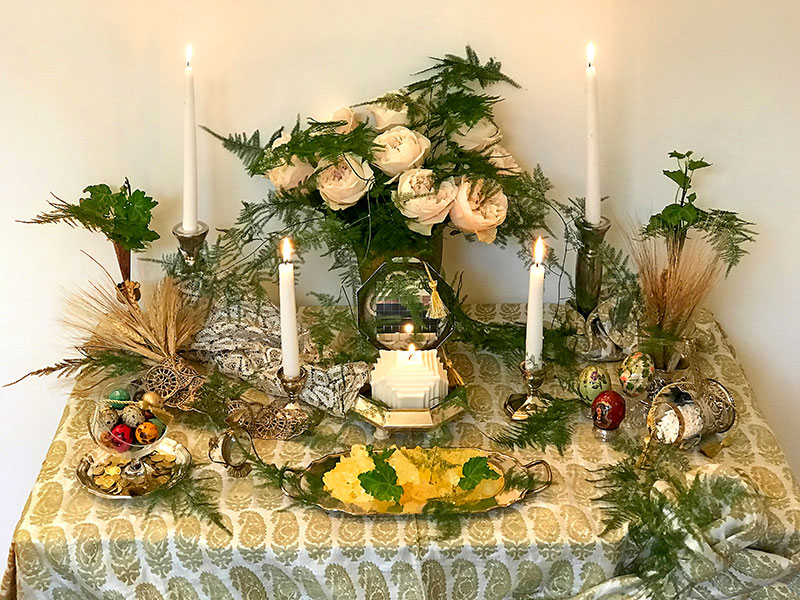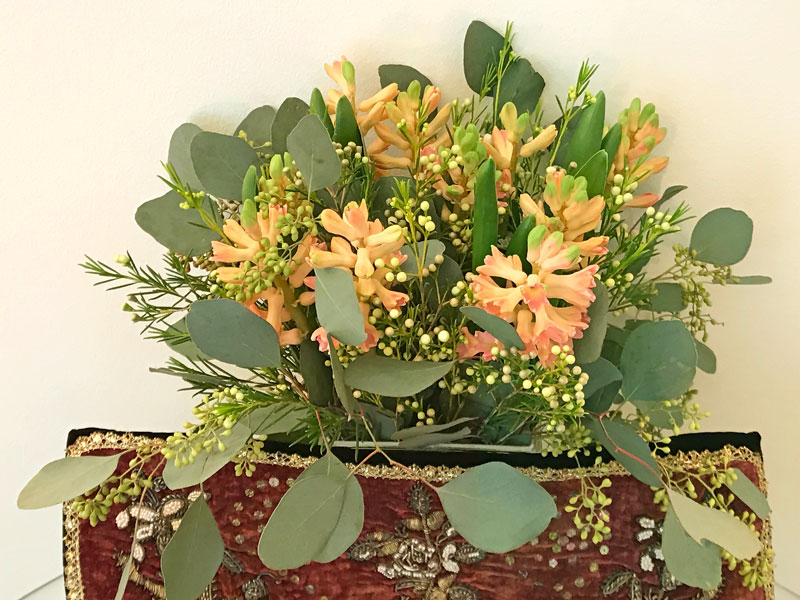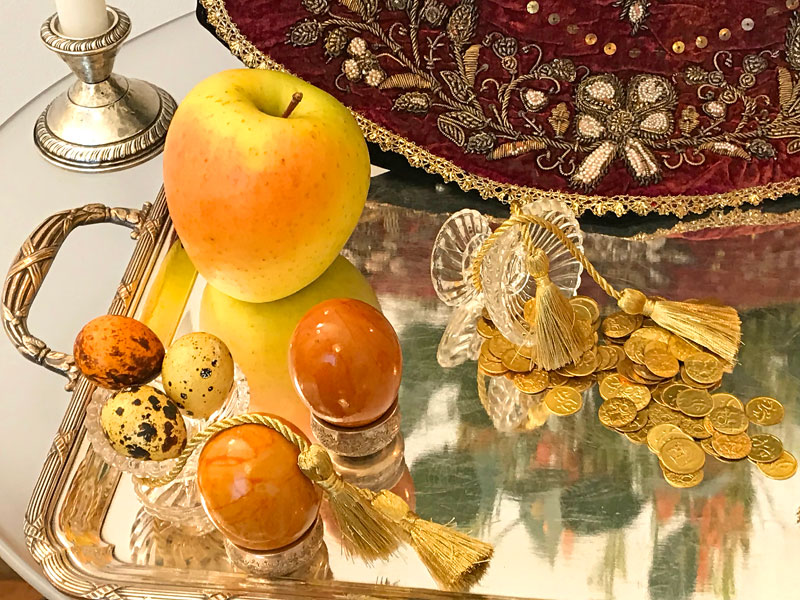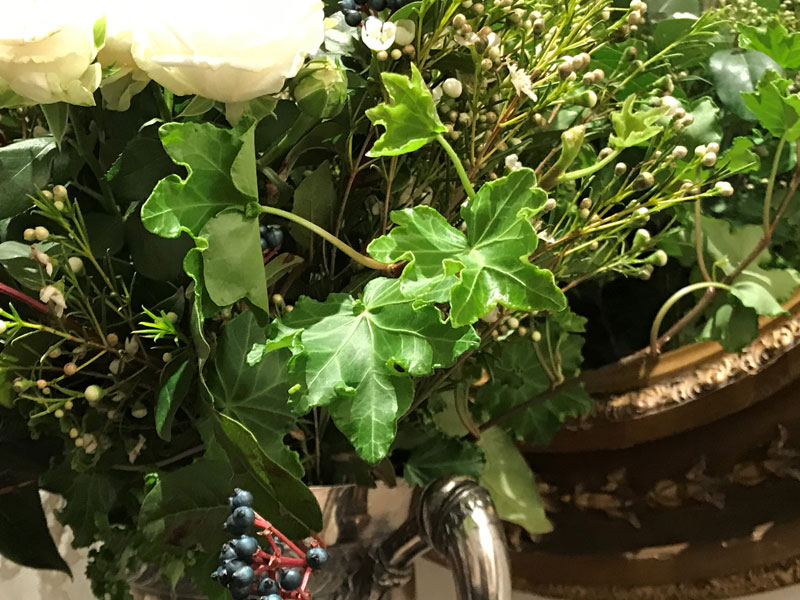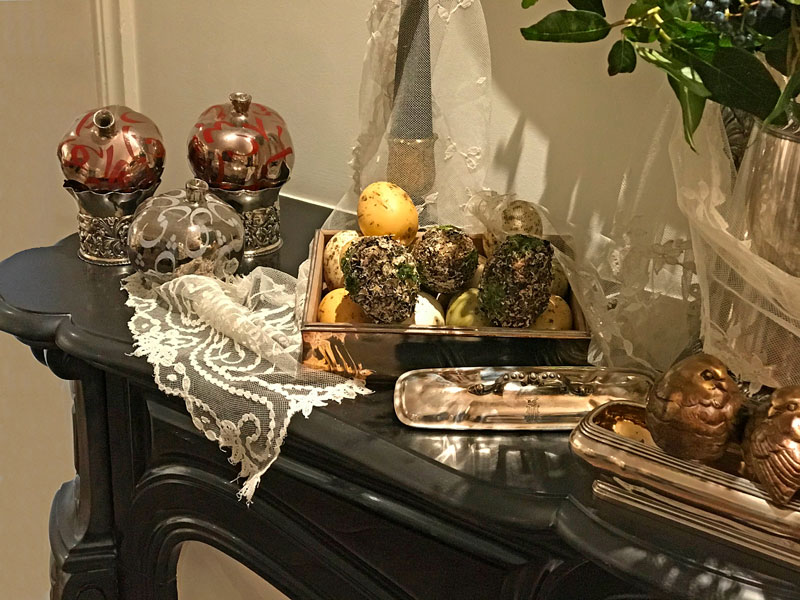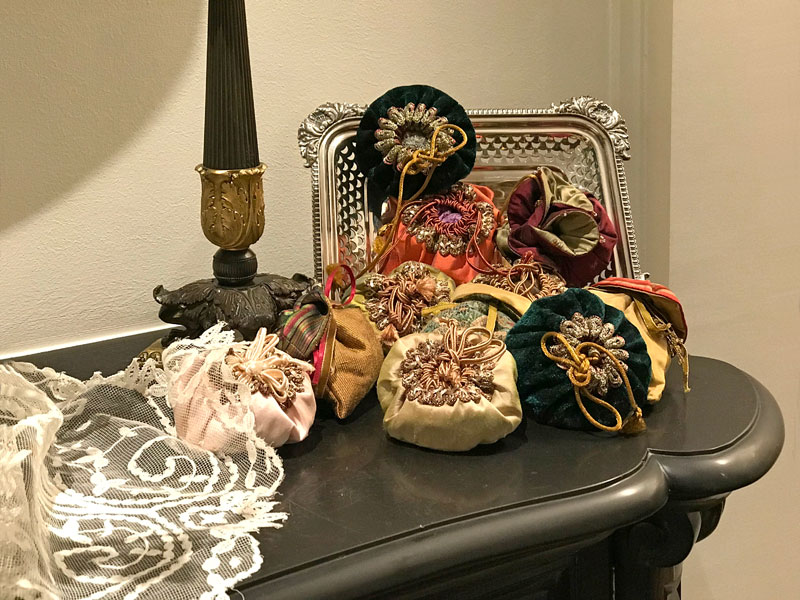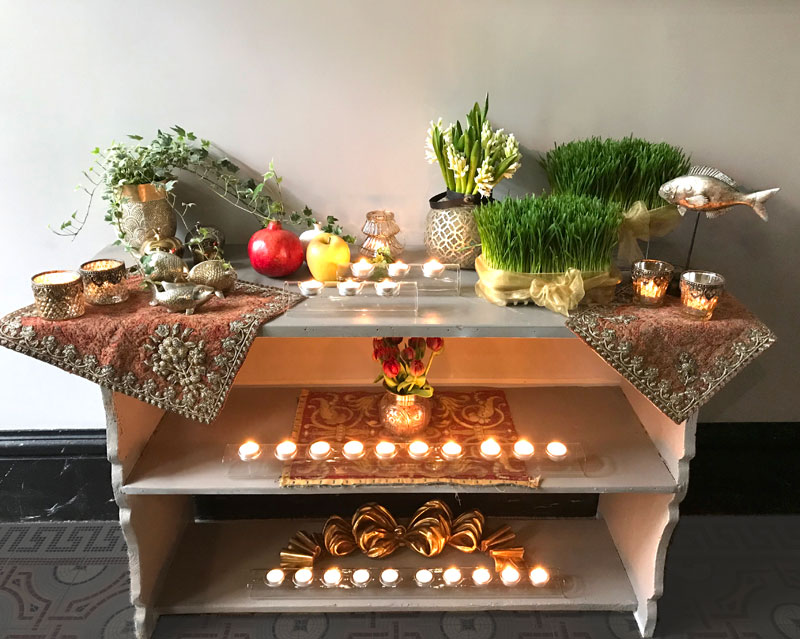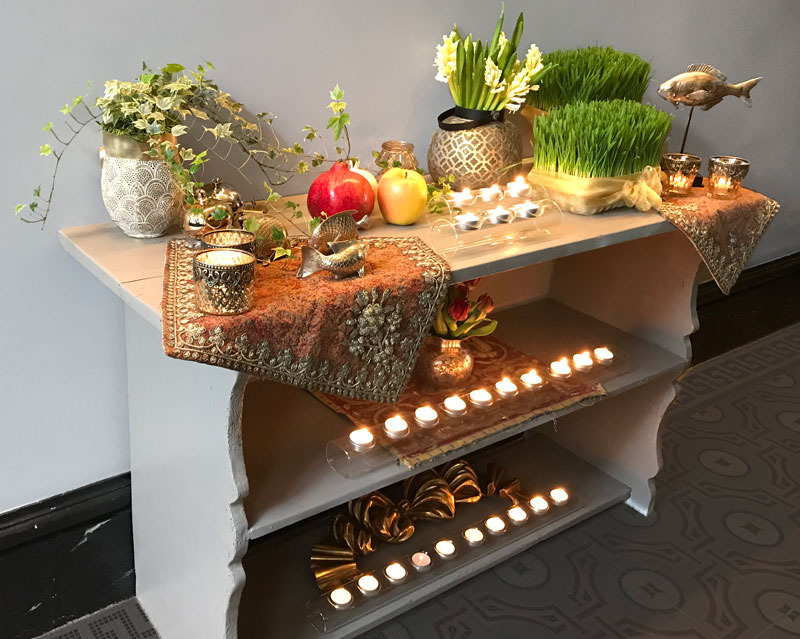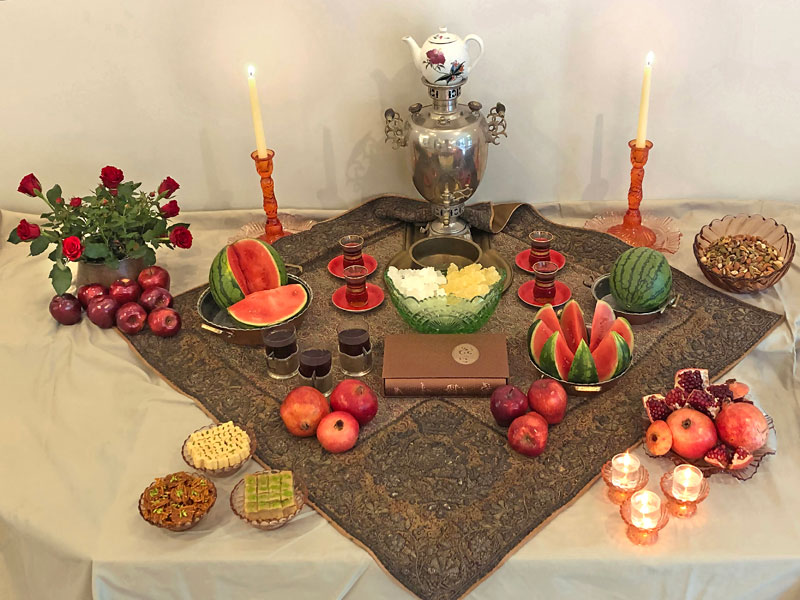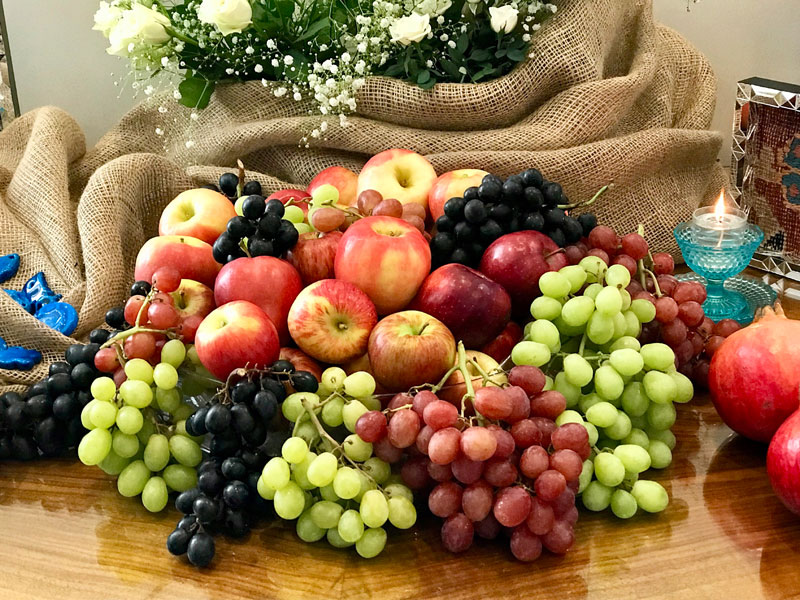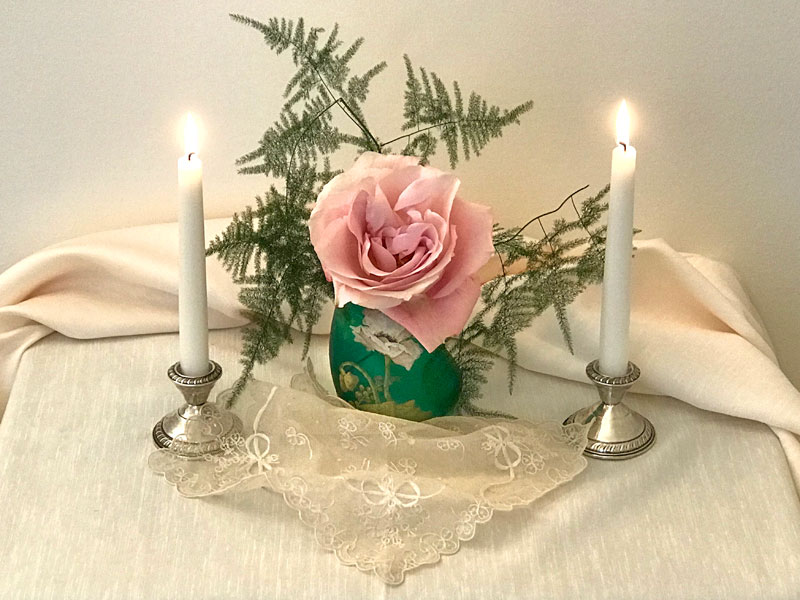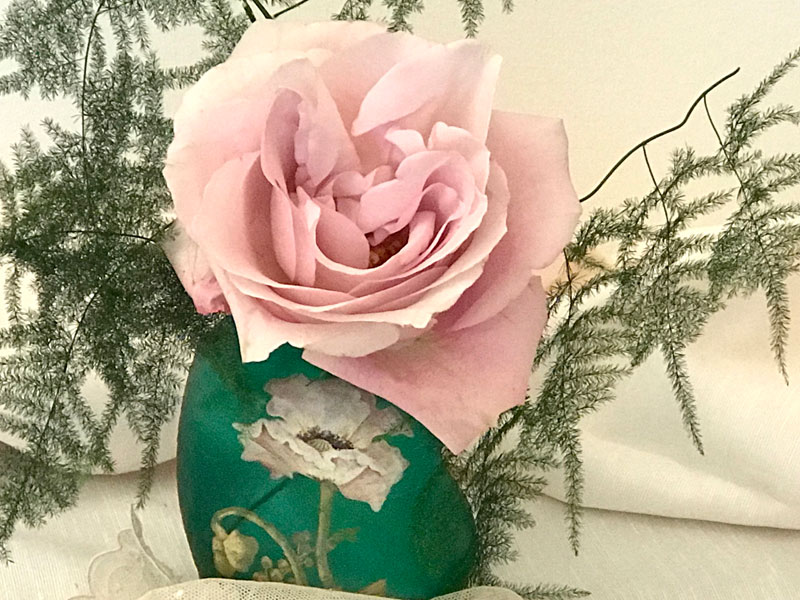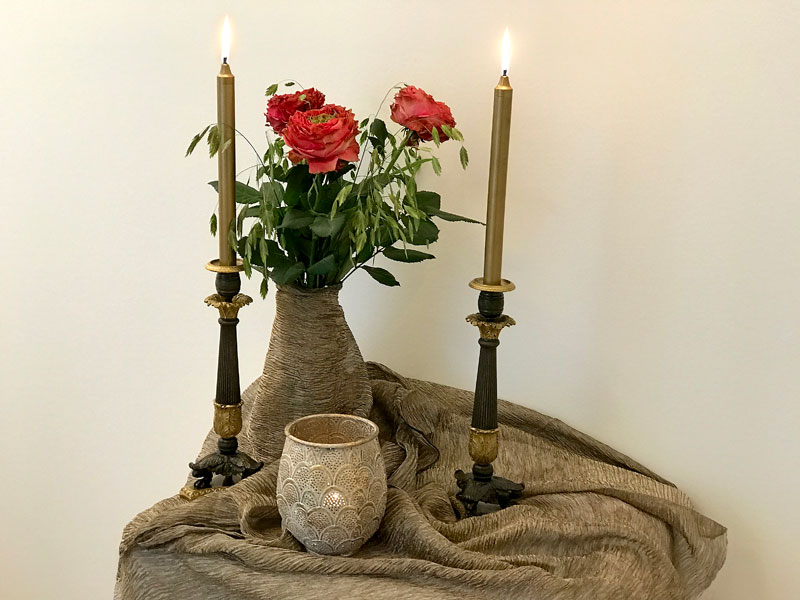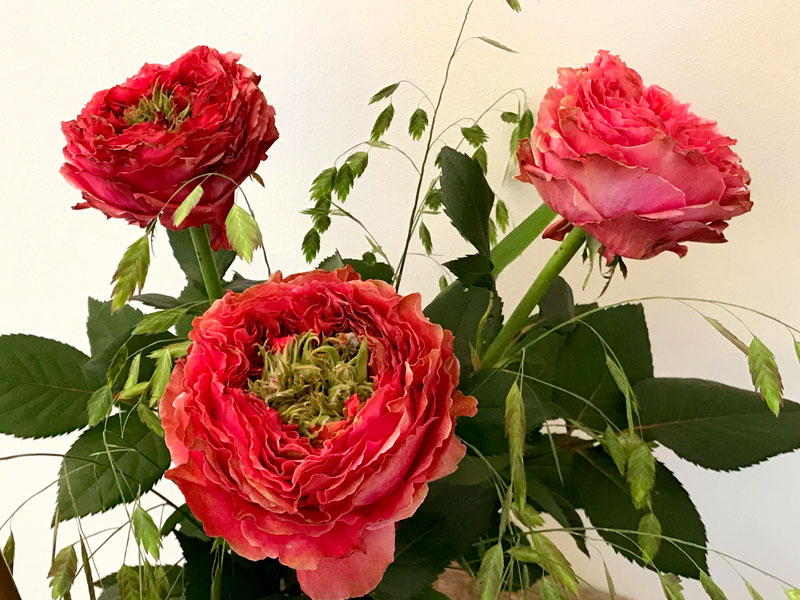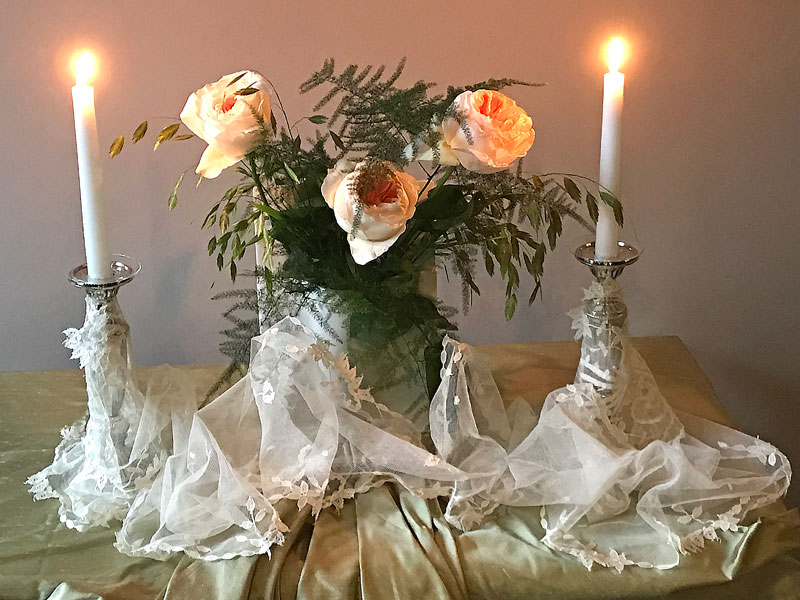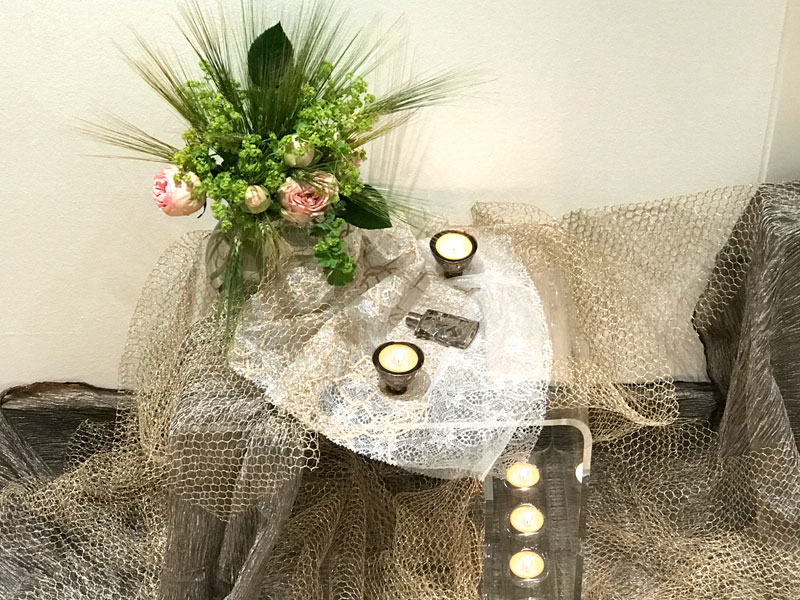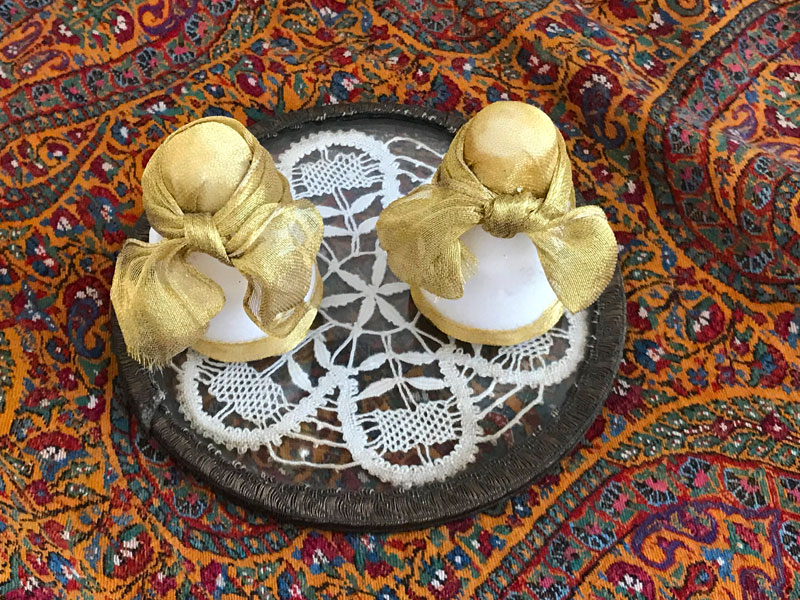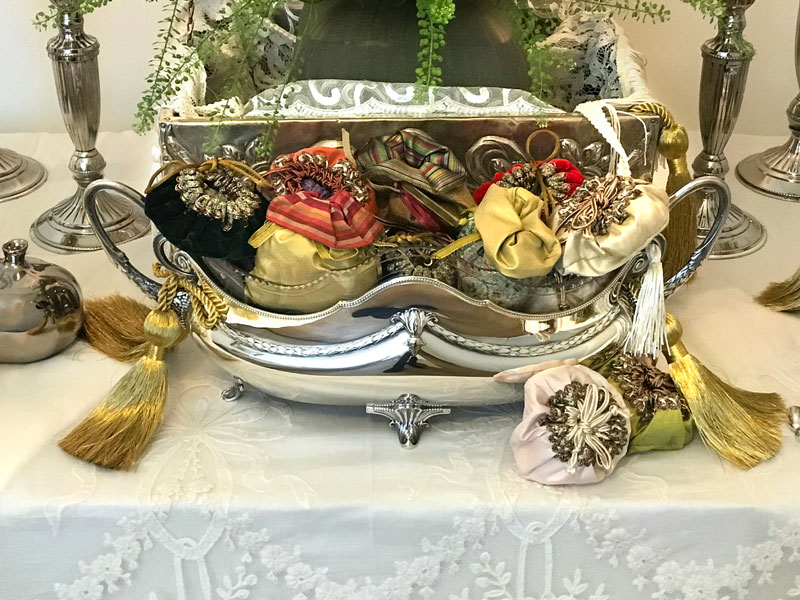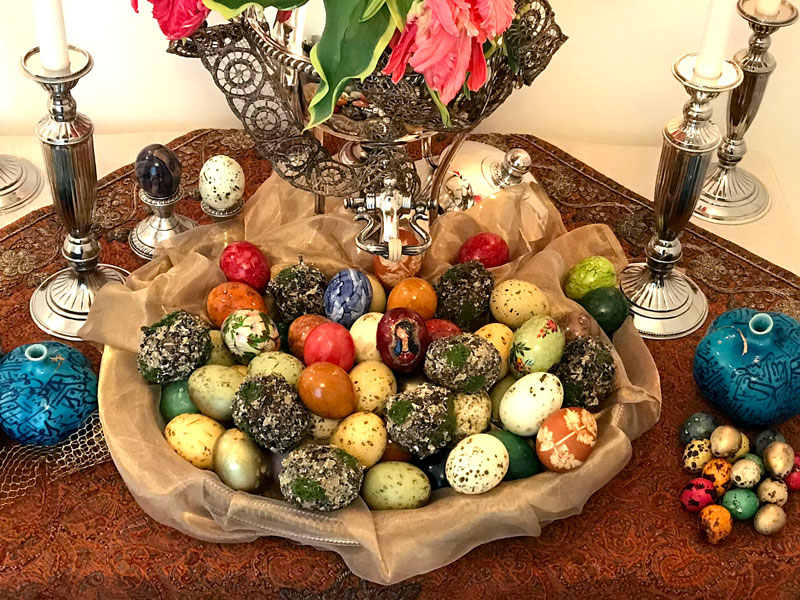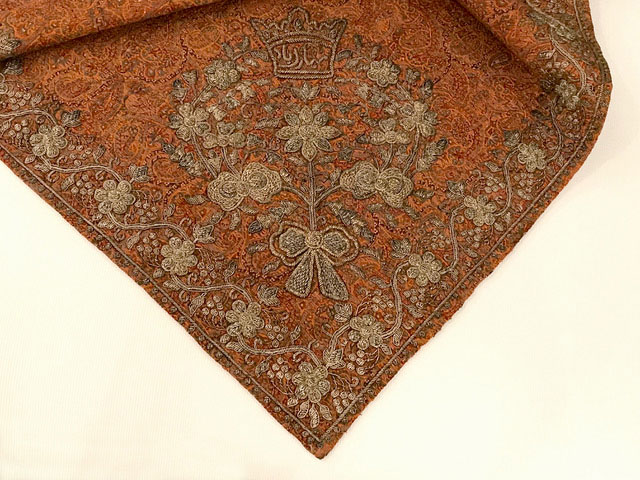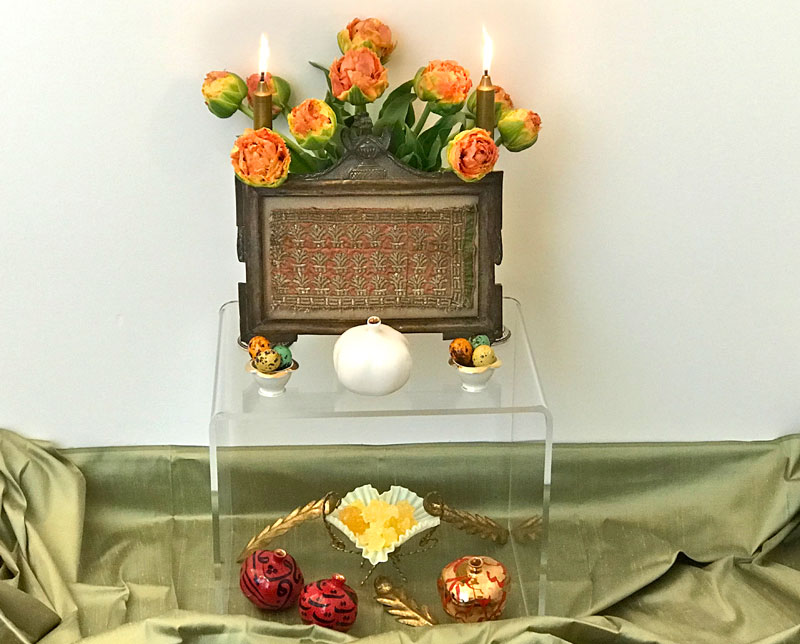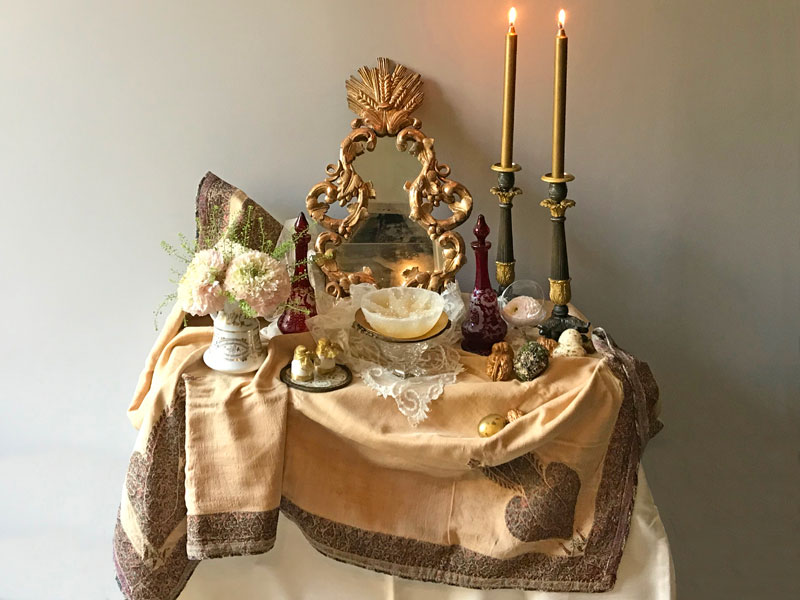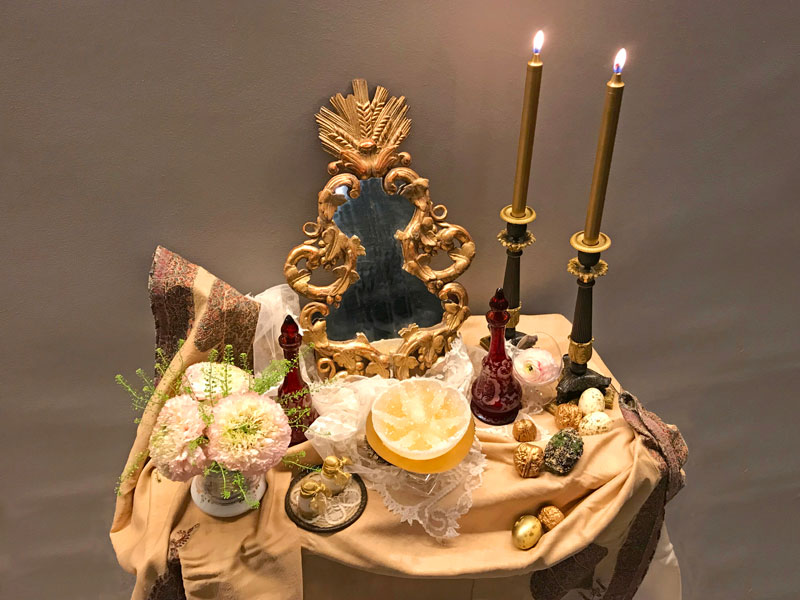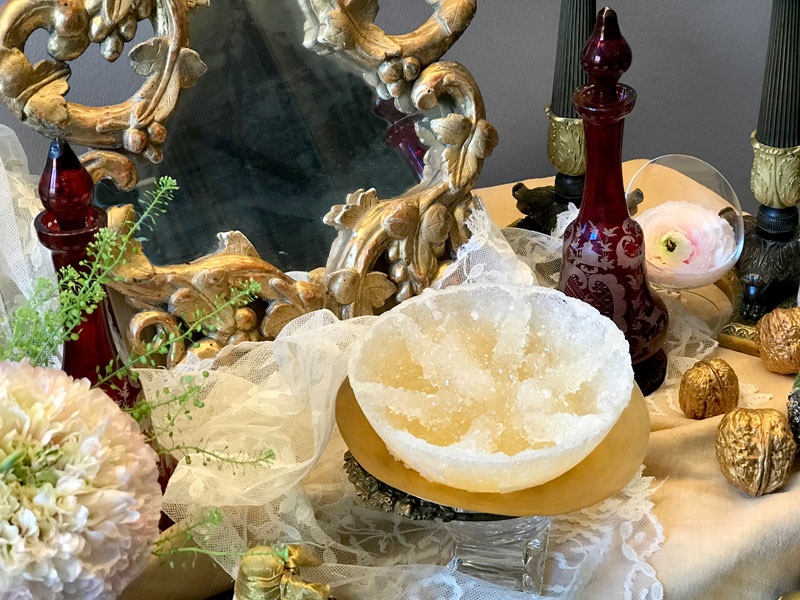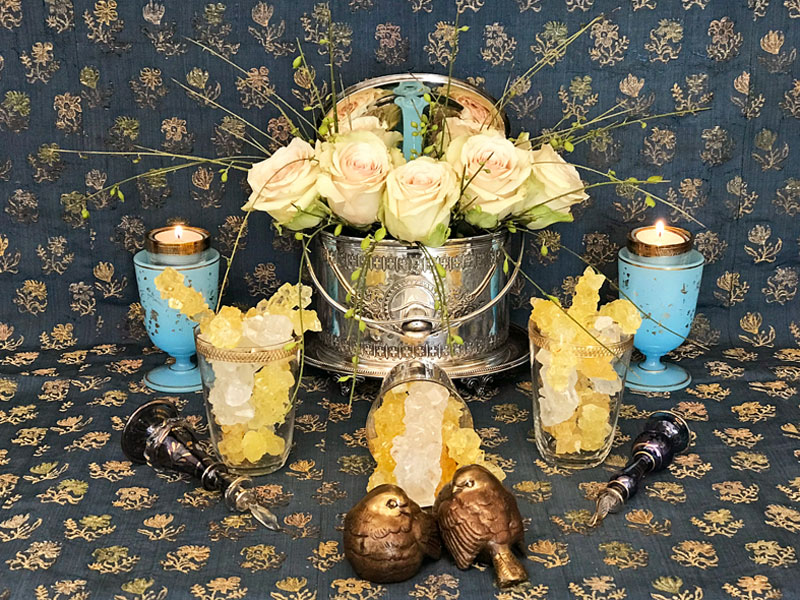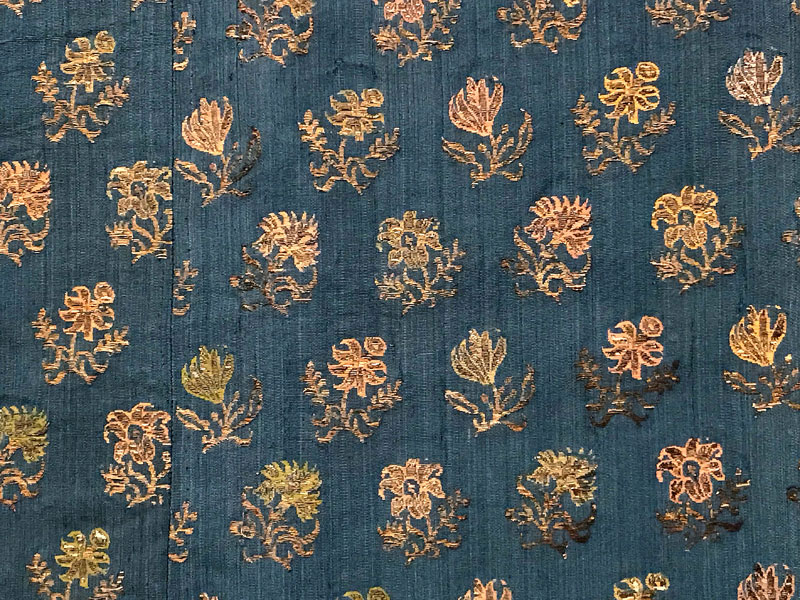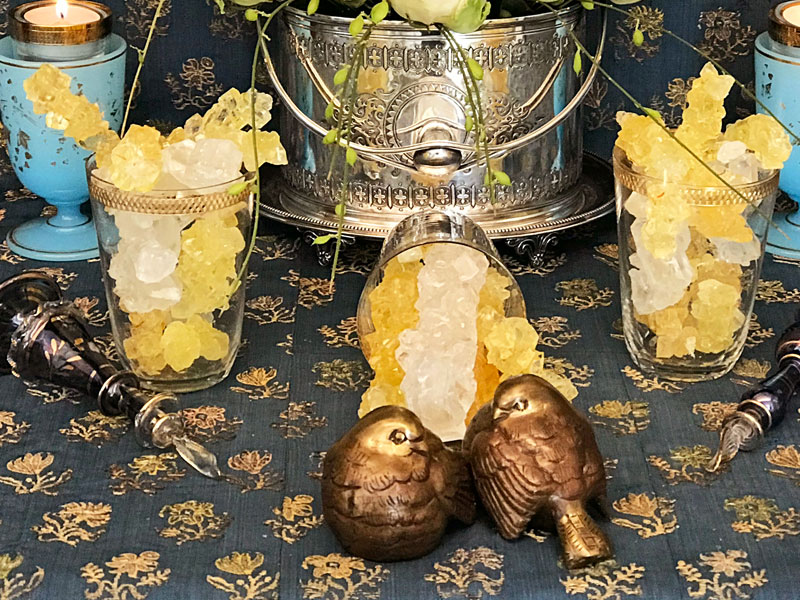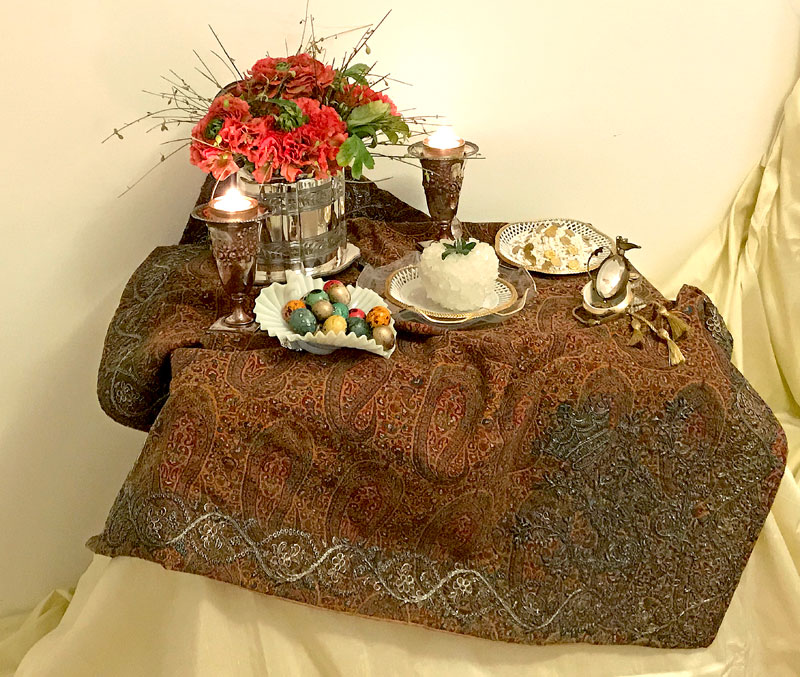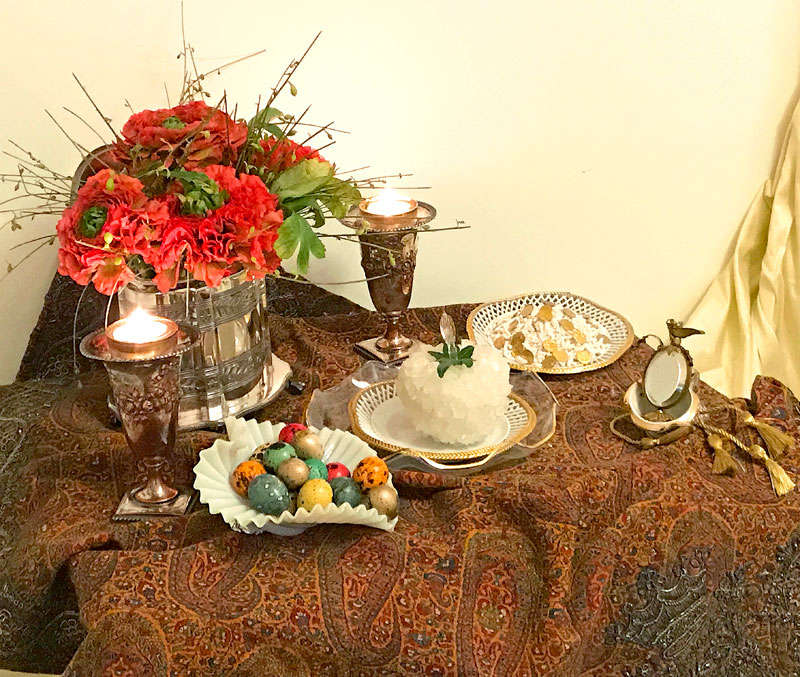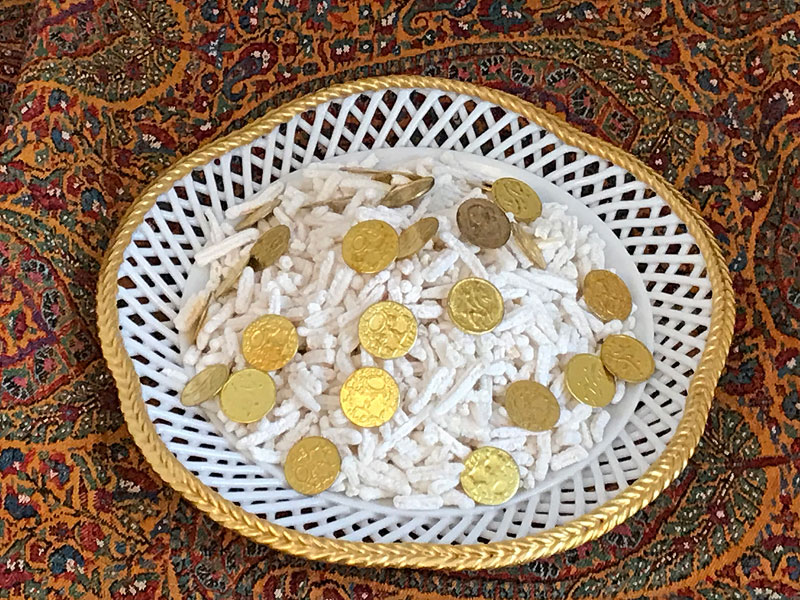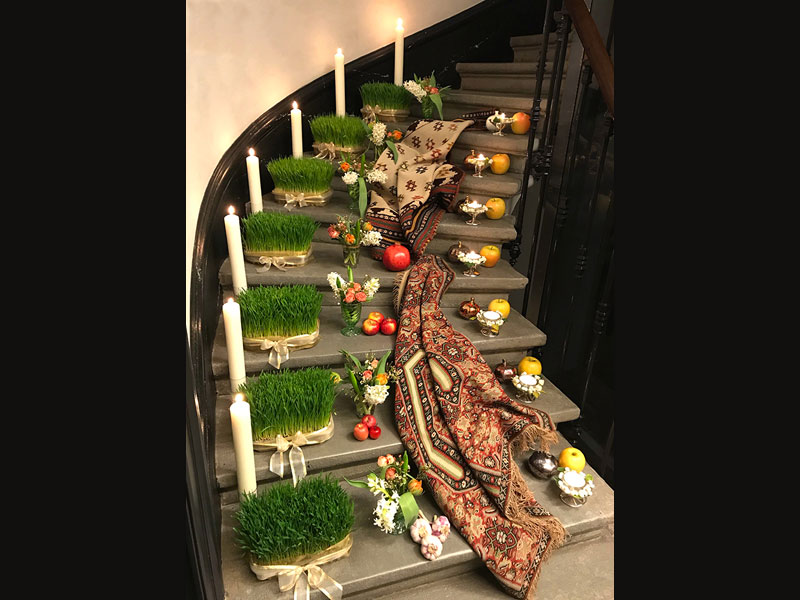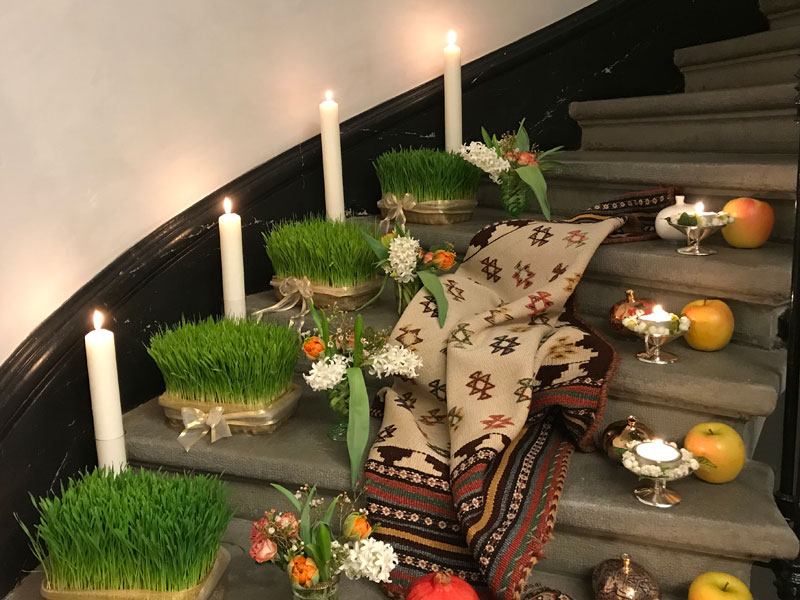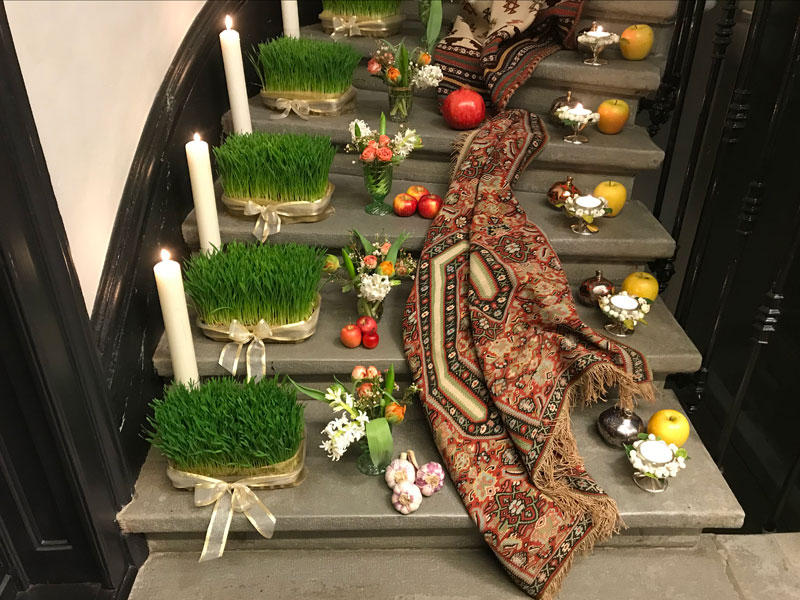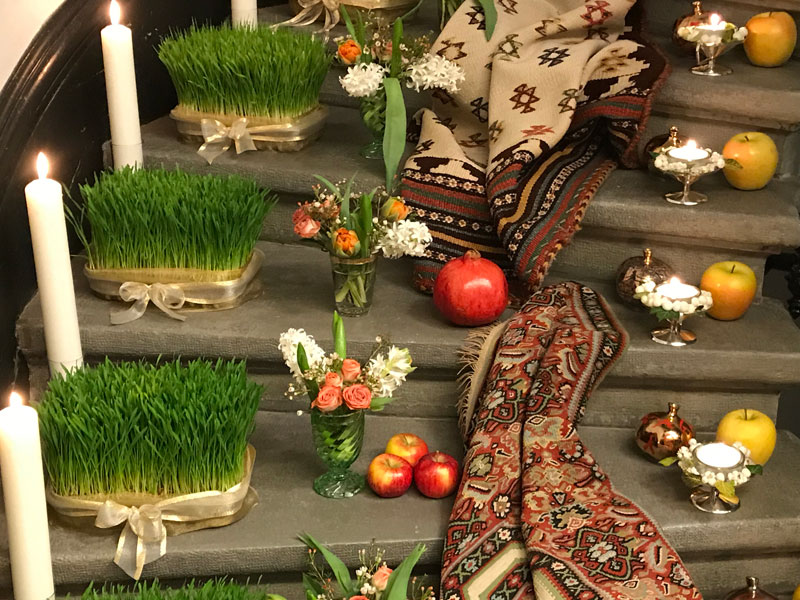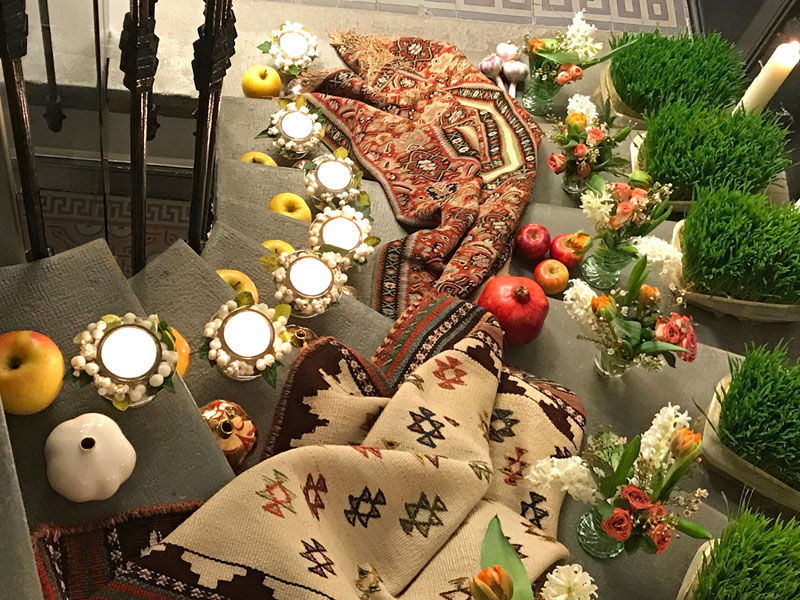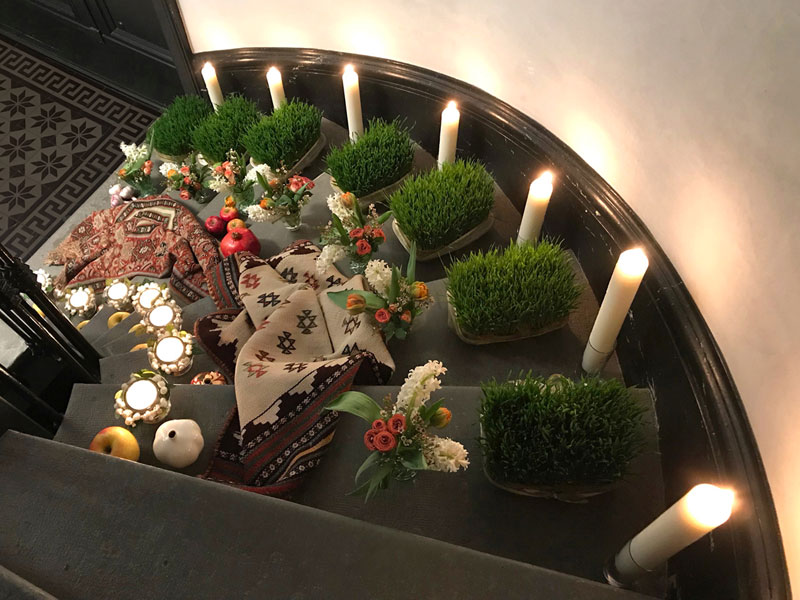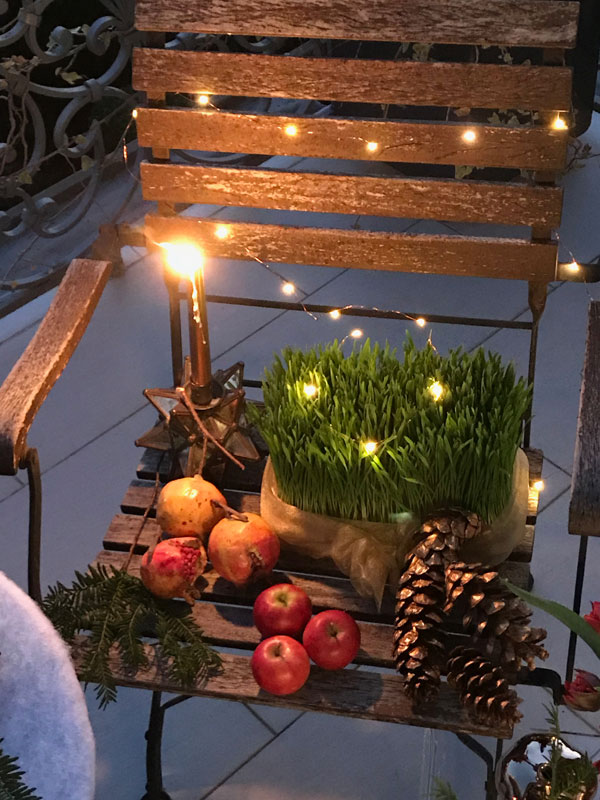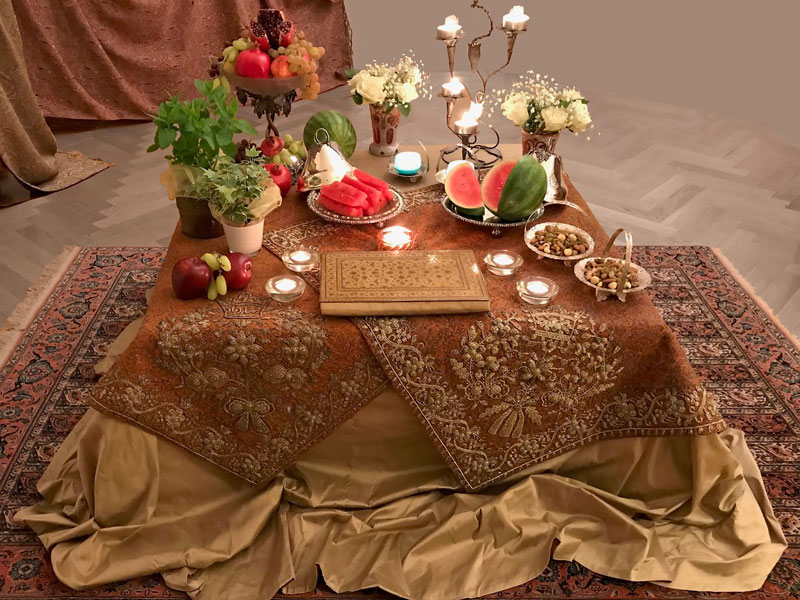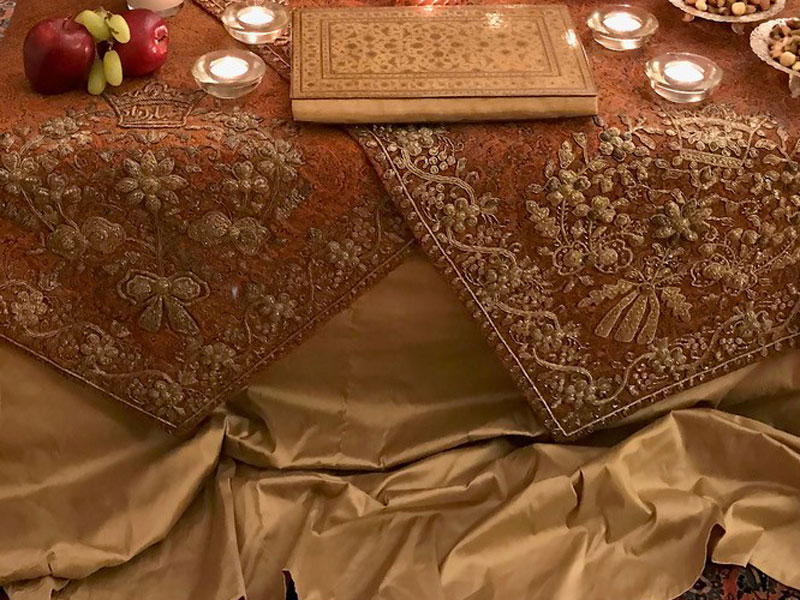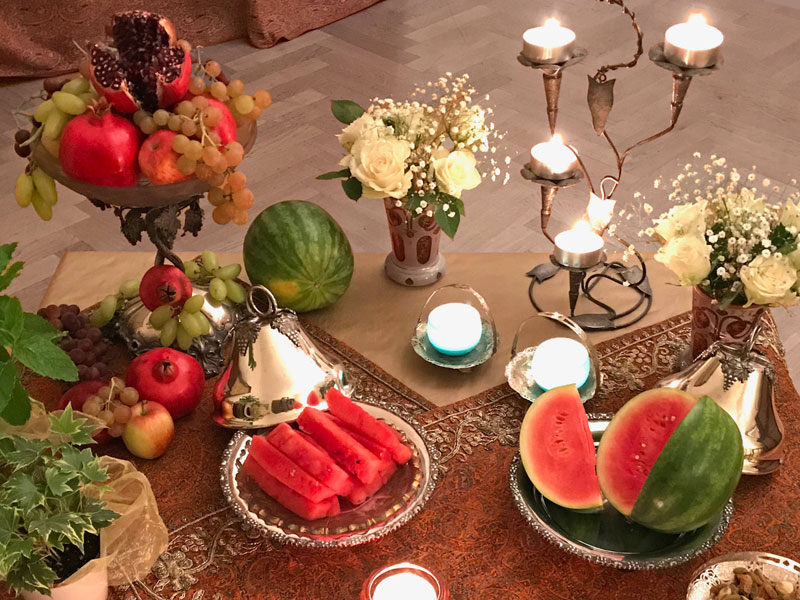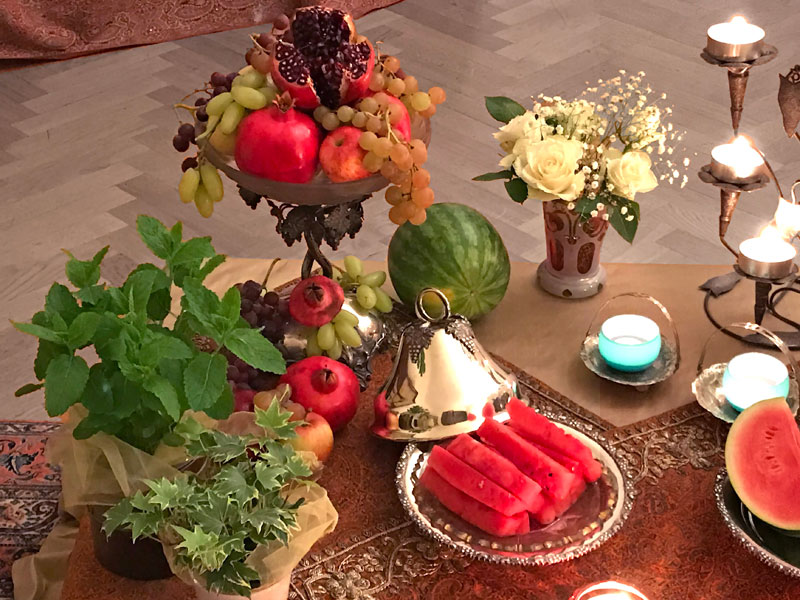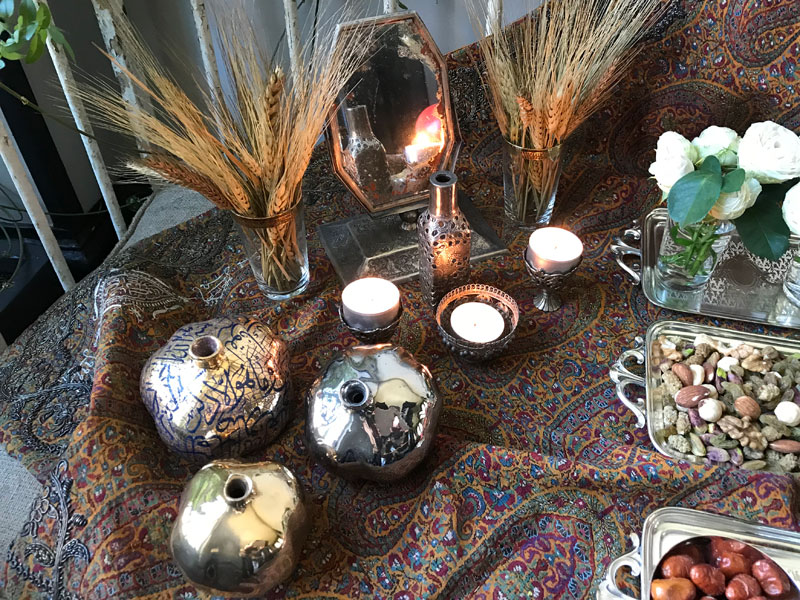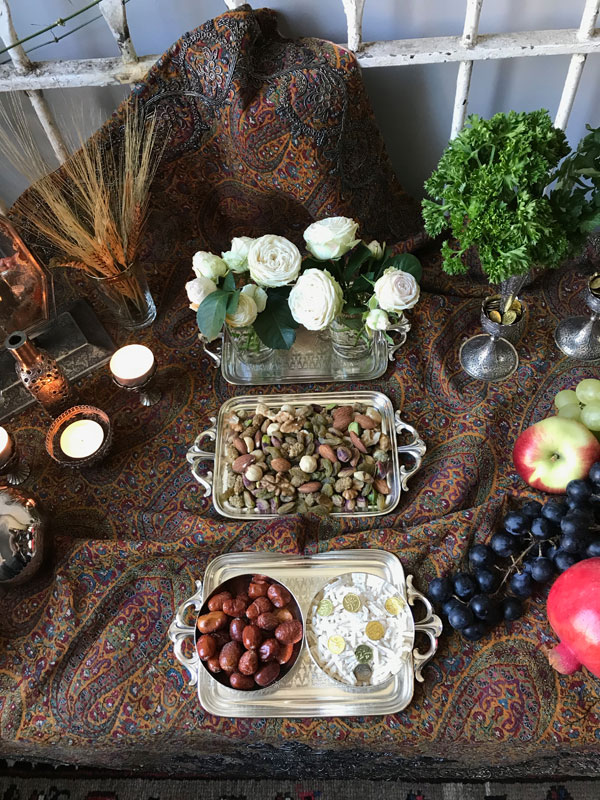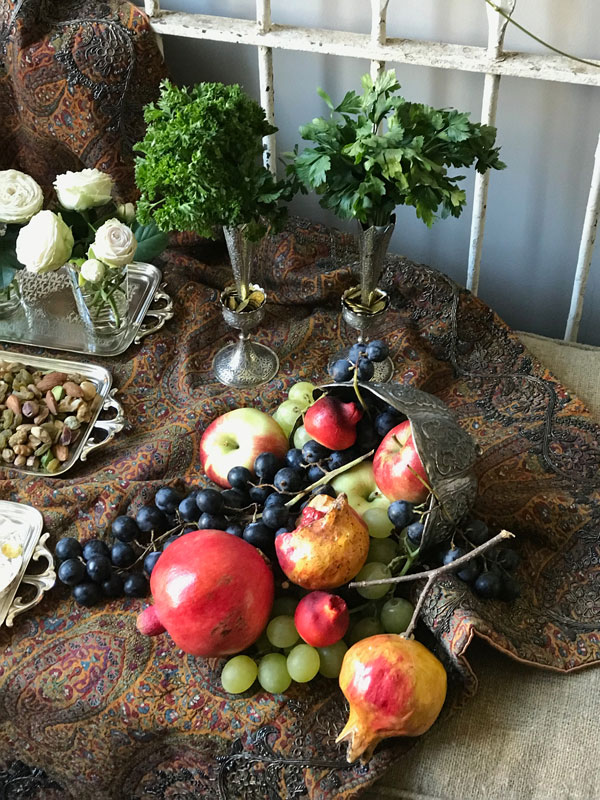SOFREHS CREATED AFTER THE PUBLICATION OF THE BOOK
Red & Gold Sofreh, Shab-e Yalda, Winter Solstice 2025
The posts of December 2025 present an elaborate sofreh, which includes various symbols of the traditions of Shab-e Yalda, the winter solstice, the longest night of the year. It is the eve of 1 Dey in the Persian calendar, corresponding to 21 December. The feast of Yalda originates in the pre-Islamic period and is associated with agriculture. The divan-e Hafez (works of 14th-century Persian poet, Hafez) to recite poetry, and red fruits are important parts of this celebration, heralding the crimson hues of sunrise after absolute darkness, and the promise of longer days ahead. It is the celebration of the passing of darkness and the rebirth of the sun. In the Persian tradition people get together, tea, sherbet, sweets and fruits are served, and stories and poetry are recited, and fortunes are told, to get through the darkest and longest night of the year, when it is believed that demons are most active.
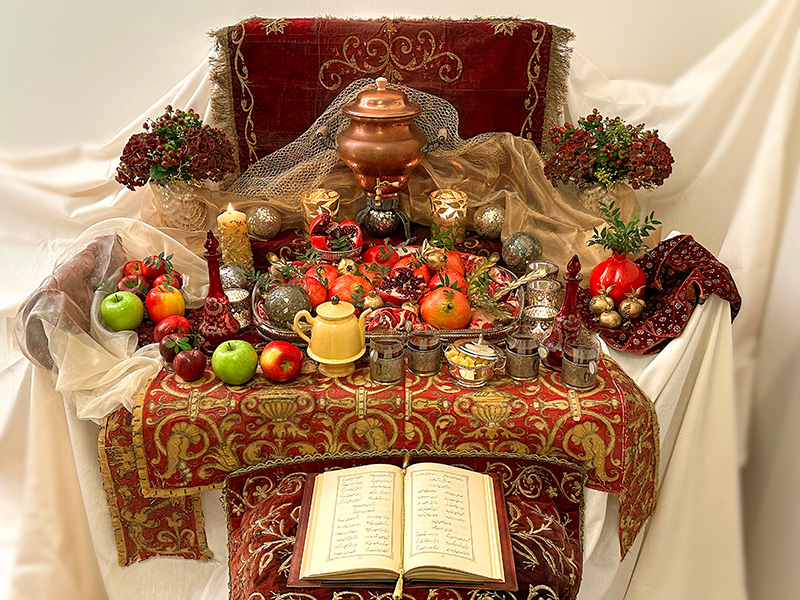
The main characteristic of this sofreh, created for Shab-e Yalda (winter solstice), is that it incorporates tones of red and gold, portrayed by rich antique textiles, flowers, fruits and objects. This elaborate sofreh showcases a samovar to serve tea, pomegranates, shiny, mainly red apples, and an open volume of the divan-e Hafez.
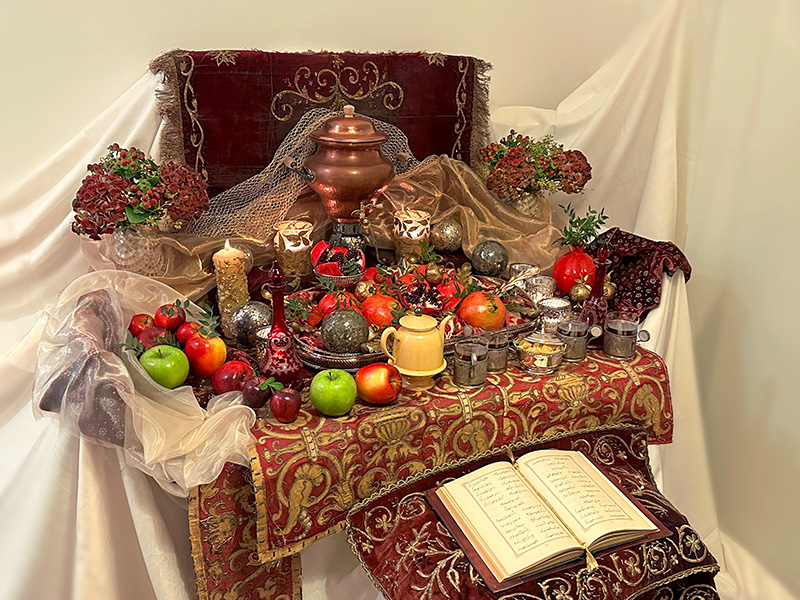
This is the side view of the same sofreh, created for Shab-e Yalda (winter solstice), incorporating tones of red and gold. The previous image was posted on the social media pages of the book at the beginning of December and this image was posted on the very night of the winter solstice in the northern hemisphere, 21 December 2025.
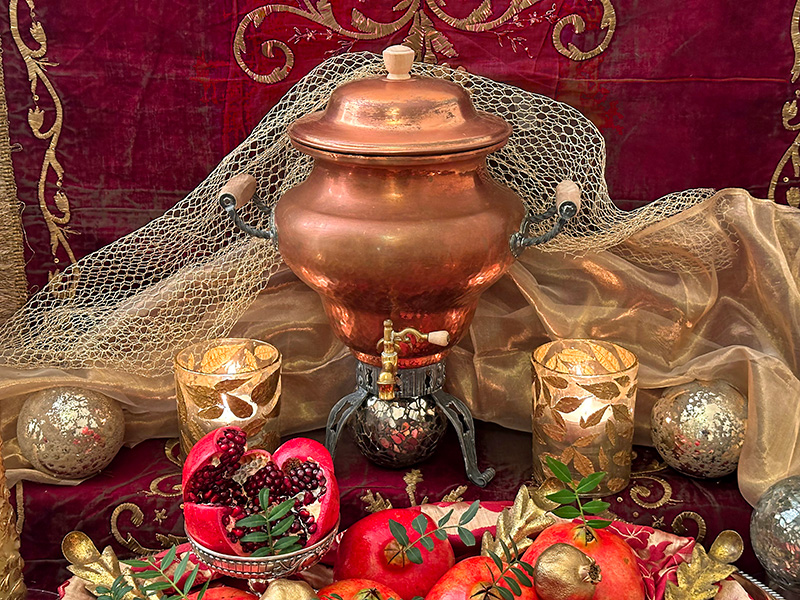
This is the central section of the red and gold sofreh. A European copper samovar, flanked by a pair of tea lights presented in ornate holders, takes centre stage. Lengths of elegantly draped gold-toned open mesh and silk create a lovely contrast with the backdrop, a length of antique embroidered red velvet. Mirrors are an important part of the Persian sofreh, and to pay homage to the Christmas season as well, a few mirrored baubles have been put on display.
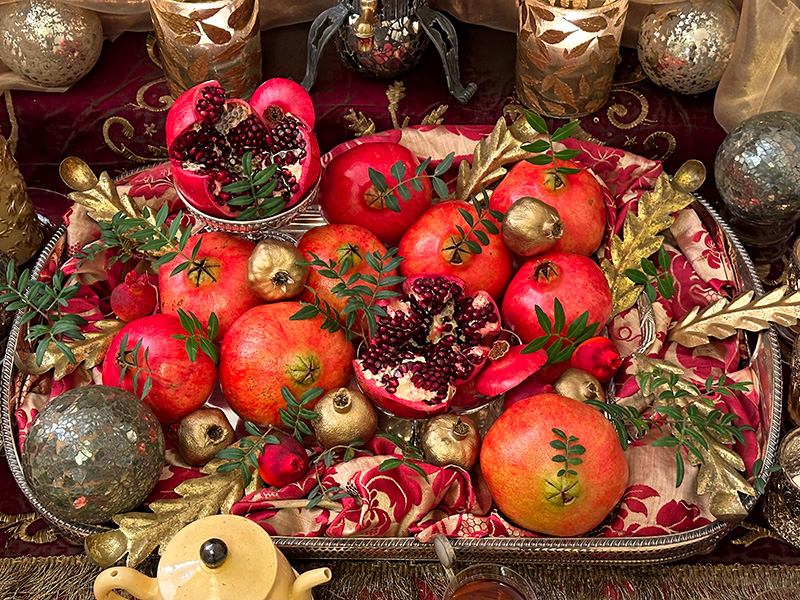
At the heart of the red and gold sofreh sits an impressive display of plump fresh pomegranates. The beauty of the open fruits, with their exposed deep-red seeds, is truly unrivalled. Delicate, dried gold-painted and miniature red sculptured pomegranates adorn this spectacular composition. A length of ruched European antique textile in red and gold, a sizeable mirrored bauble, fresh green foliage and gold-finish leaves embellish this dazzling arrangement.
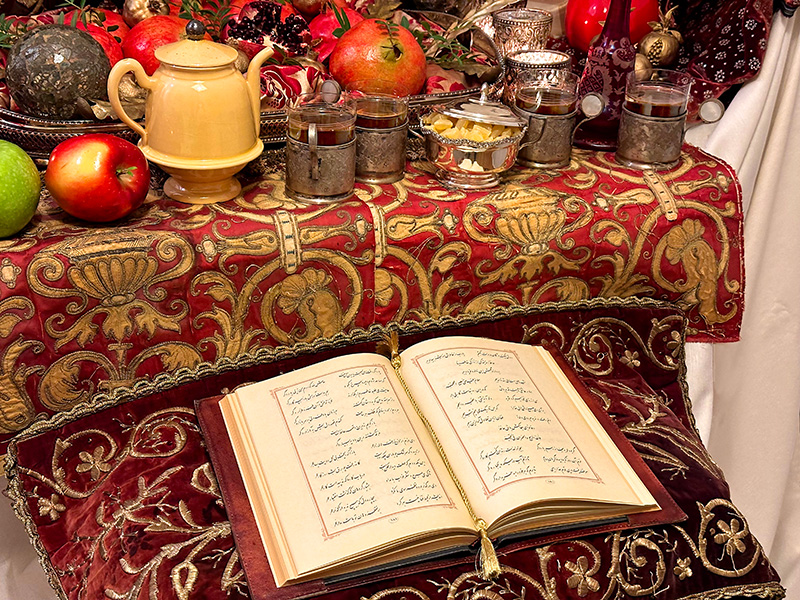
The focus of this image is the front edge of the red and gold sofreh, showcasing a lovely antique teapot and glasses of tea in antique glass holders, and a lidded silver container of traditional Persian candies. The soft-yellow teapot beautifully complements the design and the colour scheme of the elegant European antique textile it is presented on. An open volume of the divan-e Hafez is placed at a slightly lower level and on another length of antique deep-red velvet, embroidered with fine metallic gold threads.
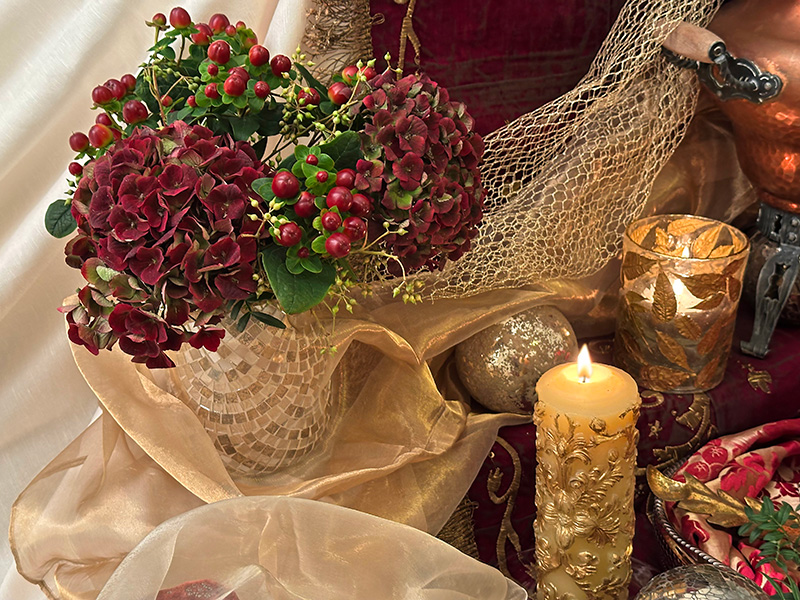
For this red and gold sofreh, a pair of bouquets of deep-red hydrangeas known as Charlotte Classic, Hypericum, Eucalyptus fruit and some foliage were put together. This image focuses on one of the bouquets, placed in one of the pair of vases, finished with mosaic mirrors, which are elegantly draped with lengths of gold-toned fine silk. Flames of an embossed pillar candle and a tea light placed in an ornate holder, both in subtle tones of gold, illuminate this section, and their reflection is visible in the mirrored bauble.
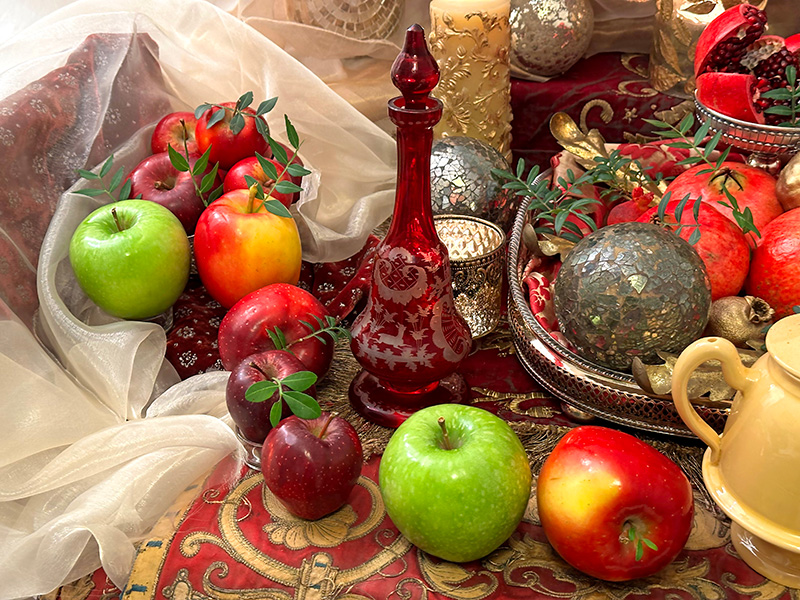
This is the left side of the red and gold sofreh. Shiny apples, many of them in tones of red, appropriate to the traditions of Shab-e Yalda, are displayed on antique textiles in various shades of red and gold. Delicate sprigs of Pistacia lentiscus foliage enhance the beauty of the shiny apples. A length of fine cream silk is elegantly draped and embellishes part of this corner. The shapely ruby-red antique flask is one of a pair containing Persian sherbet, which is also often served during the celebrations.
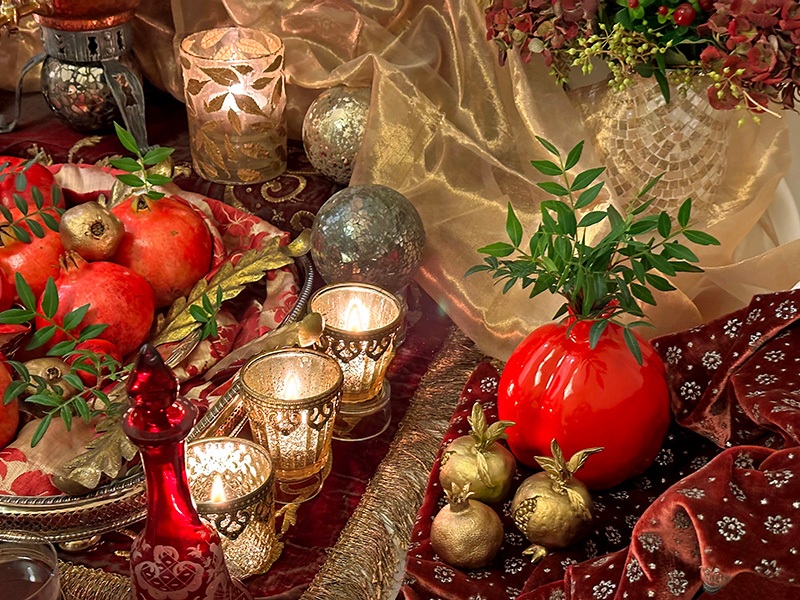
This is the right side of the red and gold sofreh. The focus of this image is an oversized ceramic pomegranate holding sprigs of Pistacia lentiscus. This particular foliage was selected as it looks quite similar to the foliage of the pomegranate tree, which loses its leaves in winter. A pair of gold-finish sculptured open pomegranates and a miniature dried pomegranate are placed on a length of antique Persian velvet, known as naqdeh duzi. Mirrored baubles and several flames embellish and illuminate this section.
Jashn-e Mehregan, October 2025
Jashn-e Mehregan is an Iranian festival which is apparently dedicated to the god of Mithra (Mehr). To read more, please visit http://www.iranicaonline.org/articles/mehragan. Very briefly, in the Persian culture, Mehregan is believed to have the same significance as Nowruz, with Nowruz signalling the beginning of spring and Mehregan marking the arrival of autumn. The celebrations, which have their origins in the pre-Islamic period and are associated with agriculture and harvest, are usually held between 16 and 21 Mehr in the Persian calendar, which correspond to 8 and 13 October. Presently, sofreh is not part of the Mehregan customs, though apparently in the past it was.
To mark the occasion, here is a sofreh showcasing a contemporary interpretation of past practices, incorporating a selection of symbolic elements, including flowers, foliage, fruits, flames, fabrics, a mirror and sweets. These augur good crops and good fortune.
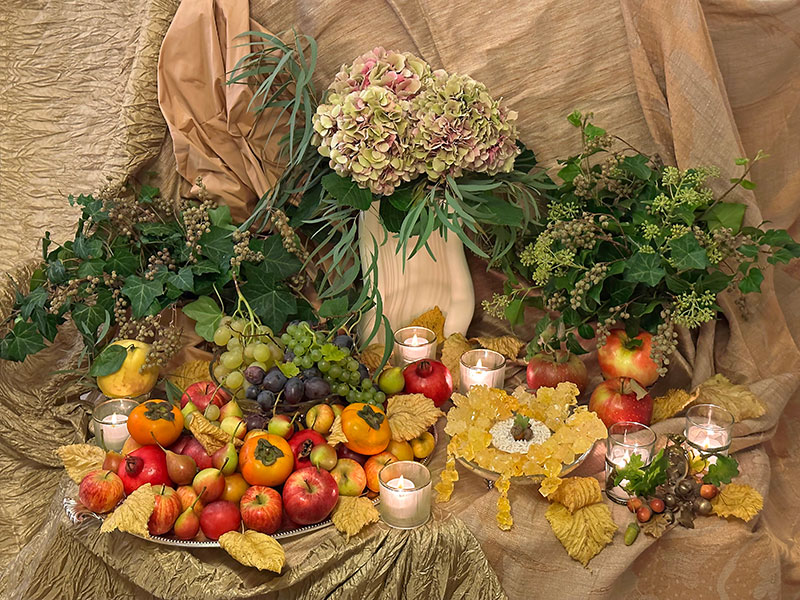
This is the overall view of the sofreh for Mehregan. The backdrop is made of a variety of softly draped, fine textiles in different shades of gold. The overall colour scheme is understated, with the colourful fruits creating a delightful contrast. The elegant sofreh is dotted with amber leaves, underlining the arrival of autumn.
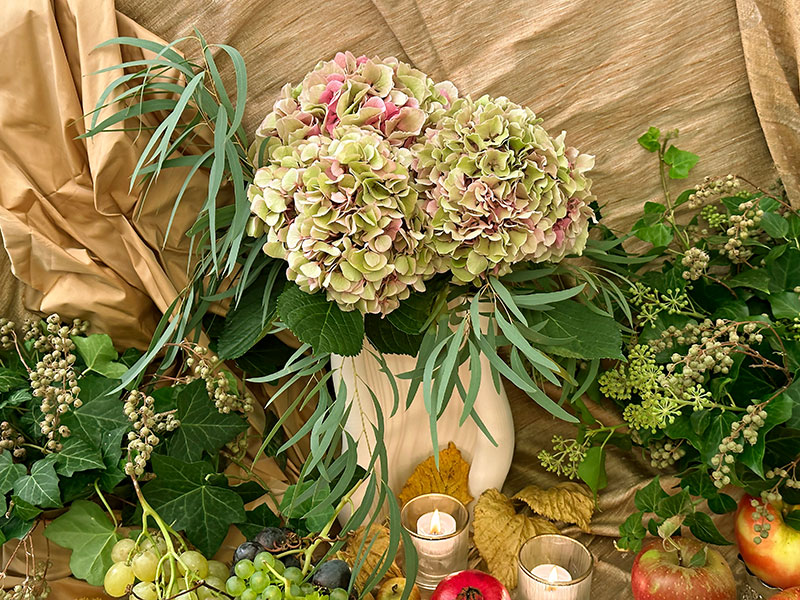
This is the central section of the sofreh. This image focuses on an ample bouquet of smoky pastel hydrangeas, known as Trendy Classic, and branches of Eucalyptus nicholii. The soft, natural arrangement is placed in an original vase, by Danish designers (https://fermliving.com/), which is an elegant sculpture in itself.
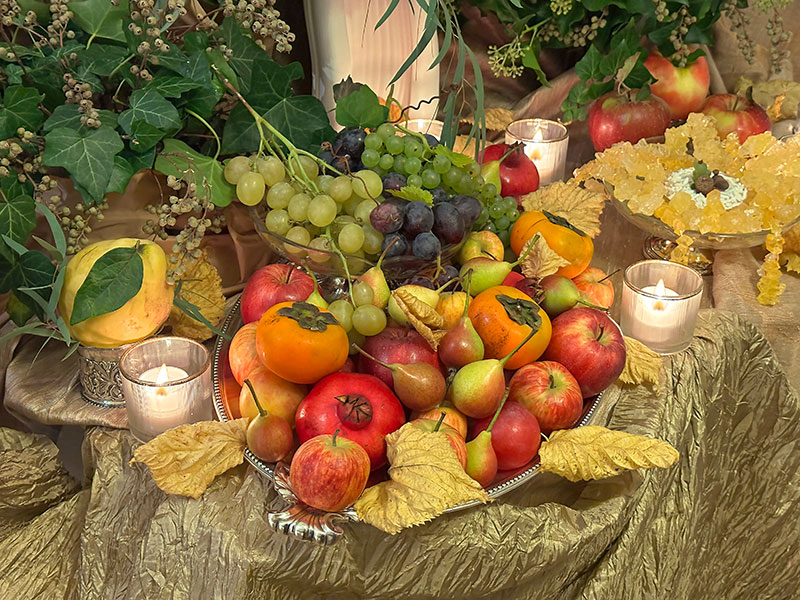
This impressive tray of heavenly autumnal fruits, a bowl of a variety of hanging grapes and a single plump quince occupy a large part of the surface. The colourful display, which includes shiny apples, miniature pears, persimmons and pomegranates, symbolizes life, good fortune, growth, prosperity and fertility. Amber autumnal leaves embellish the fruit display, which is illuminated by the flames of tea lights.
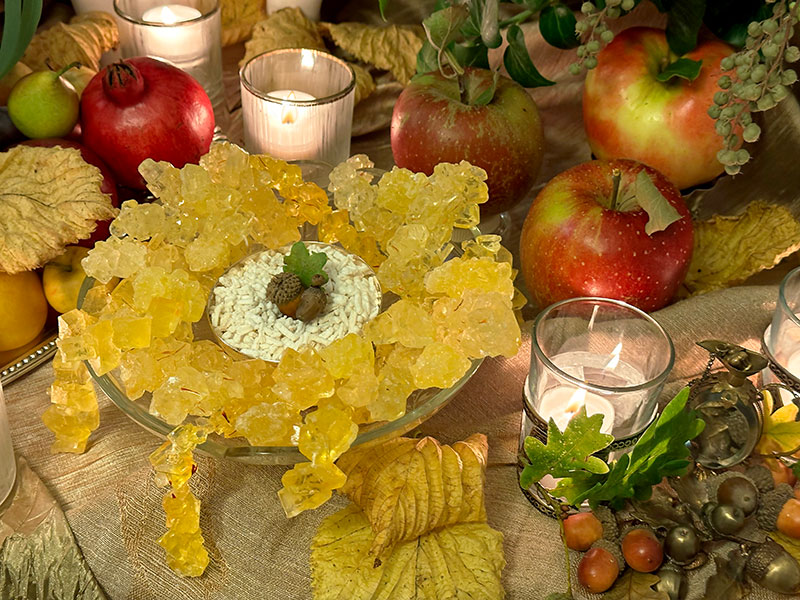
This image focuses on a charming display of Persian sugared almonds (noql), embellished with acorns and an acorn leaf, and surrounded by crystal sugar (nabat). In the Persian traditions noql o nabat, which are symbols of sweetness and harmony, are synonymous with joy and festivities. Amber autumnal leaves complement the colour scheme and embellish this corner, while flames of tea lights softly illuminate it.
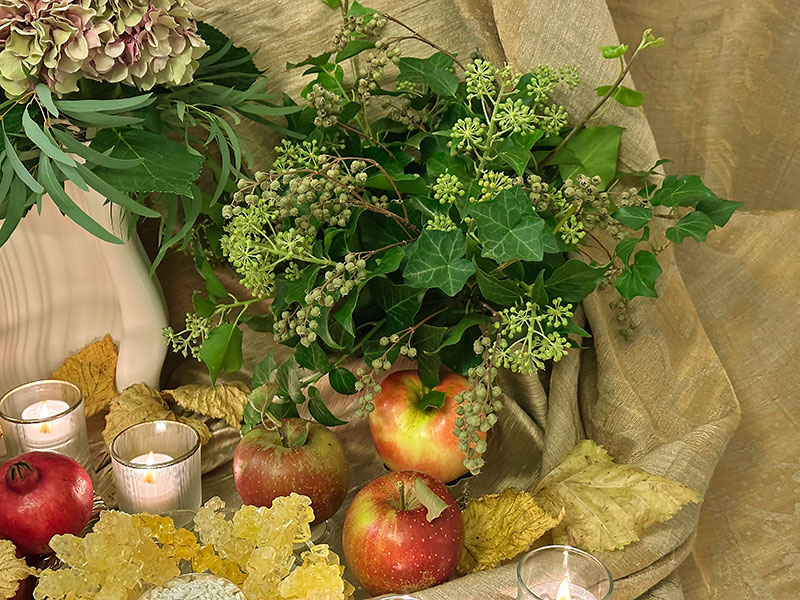
This is a close-up of one of the bouquets of mixed foliage included in the sofreh. The bouquet of various shades of green is made of berried ivies and fruits of Deutzia gracilis shrub (Japanese snow flower). At this time of the year, an abundant variety of apples are in season. These three lovely examples next to the amber autumnal leaves, illuminated by flames of the tea lights, enhance the beauty of this section. Draped textiles in soft tones of gold make for an elegant backdrop.
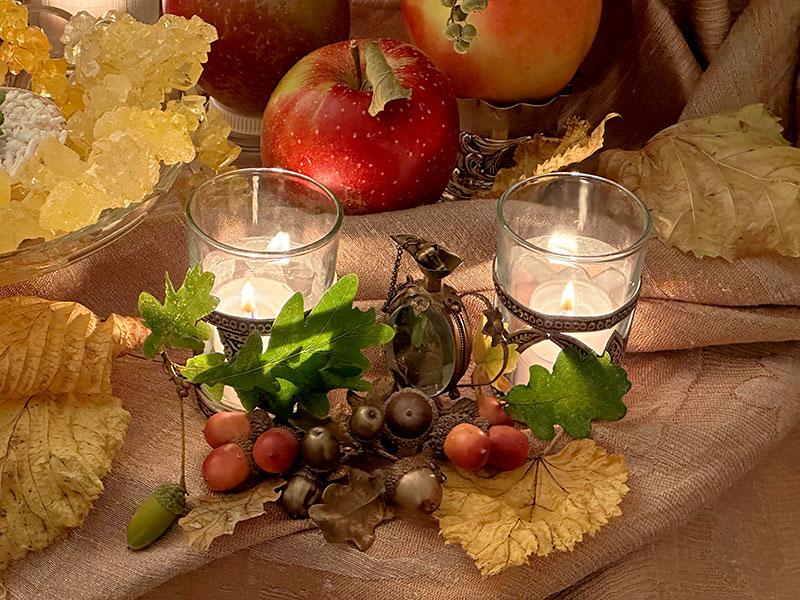
This charming mini composition sits at the edge of the sofreh. There is something strikingly poetic about acorns, which are in season in October, and they have a jewel-like quality. Here natural, artificial and a cluster of life cast bronze sculptured acorns, together with oak leaves by Wrightson & Platt (https://wrightsonandplatt.com), are on display. An antique miniature mirrored jug of syrup is placed between the tea lights. Amber autumnal leaves embellish this corner.
Echoes of Persian Sofrehs, September 2025
This month, two simple arrangements alluding to the Persian sofreh, with identical backdrops but contrasting colour schemes, are presented. Being the pomegranate (anar) season, they both celebrate the works of the Iranian/Canadian artist, Keyvan Fehri (www.keyvanfehri.com). Especially in the Persian tradition, sculptured pomegranates are popular symbolic decorative elements. However, very few boast such lifelike form and appearance as the works of Keyvan Fehri. Both sofrehs incorporate a mirror, candelabra and a wreath made of subtly gold-tined wheat sheaves. In September, different varieties and shades of hydrangeas are available, which have been included in these sofrehs, together with trailing ivies.
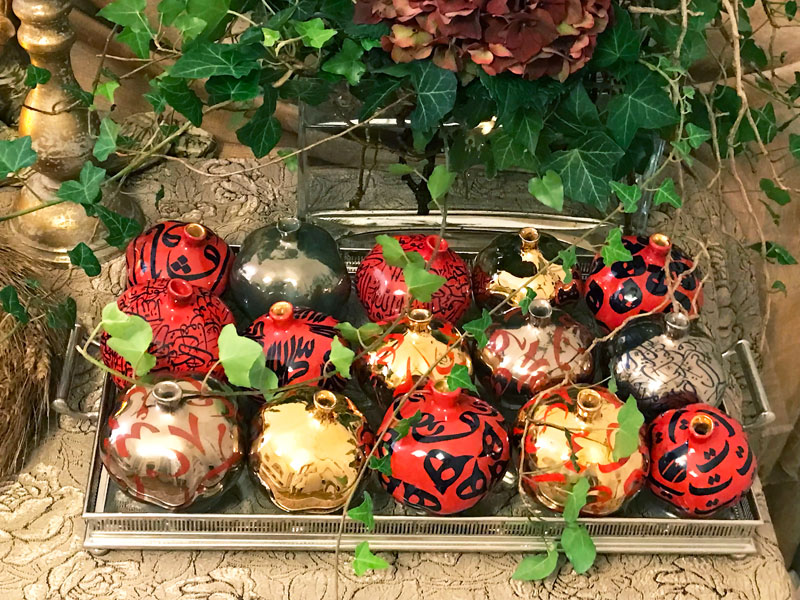
This impressive tray of gold, silver and red sculptured pomegranates presents works of the Iranian/Canadian artist, Keyvan Fehri. In the Persian culture, as in many others, pomegranates (anar) are a symbol of fertility. They are often included in the Persian sofrehs, especially the marriage sofreh (sofreh-ye aqd). The graceful branches of trailing ivy enhance the beauty of this mini composition.
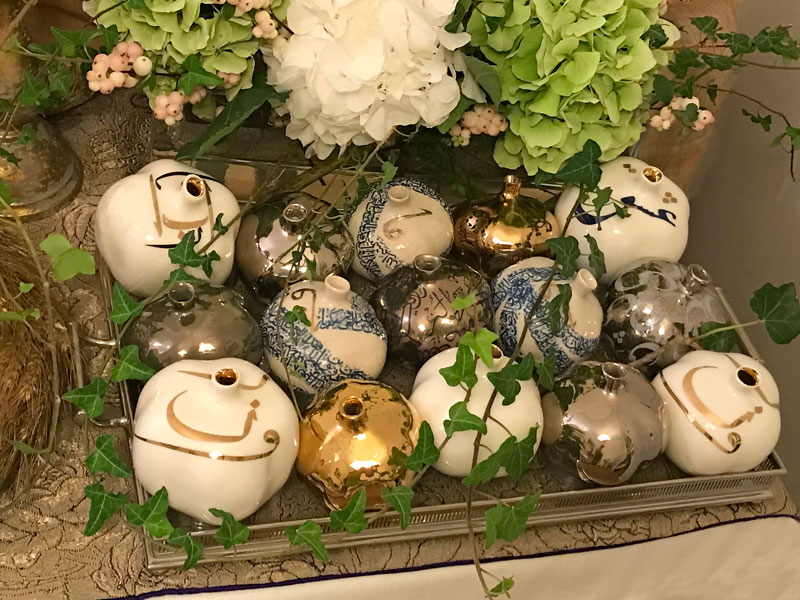
This impressive tray of gold, silver, blue and white sculptured pomegranates presents works of the Iranian/Canadian artist, Keyvan Fehri. In the Persian culture, as in many others, pomegranates (anar) are a symbol of fertility. They are often included in the Persian sofrehs, especially the marriage sofreh. The graceful branches of trailing ivy enhance the beauty of this mini composition.

At this time of the year we are truly spoilt with the varieties, sizes and colours of hydrangeas in season. This is a close-up of the wild bouquet of a single wine/burgundy oversized hydrangea and deep-green trailing ivies. The graceful movement of the branches of trailing ivy adds interest to the arrangement.

At this time of the year we are truly spoilt with the varieties and colours of hydrangeas in season. This is a close-up of the bouquet of Verena Classic and White Verena hydrangeas, Symphoricarpos and trailing ivies. The graceful movement of the branches of trailing ivy adds interest to the arrangement.
SOFREH as a Gift
The following compositions were especially designed to introduce the book on social media as a gift for different occasions. The posts present the book as a two-volume, lavishly illustrated publication which makes an enduring gift for those interested in art, culture and design. They also show that SOFREH includes many decorating ideas in the Persian spirit, as well as images of exquisite textiles, rare manuscripts and imaginative floral designs. To order your copy, please go to THE BOOK page.
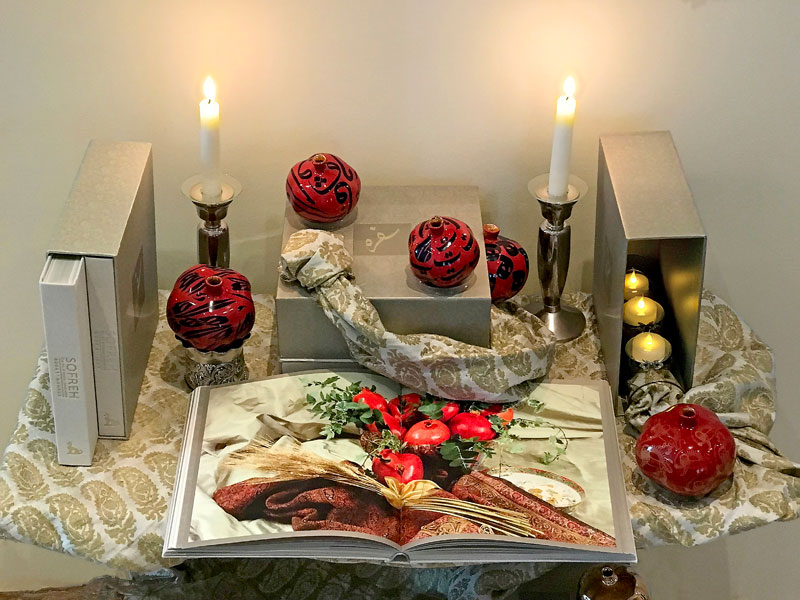
This composition was designed to suggest SOFREH as a Christmas present. It incorporates several volumes of the book, and is inspired by the traditions of the winter solstice (Shab-e Yalda). To learn more please scroll down to Shab-e Yalda, Winter Solstice, December 2021. The inclusion of red ceramic pomegranates and the image of shiny fresh pomegranates in the book echo the traditions of Shab-e Yalda. In this arrangement, one of the books showcases a double-page spread of a sofreh-ye aqd, entitled “Silver-Green Silk”, especially staged for photography.
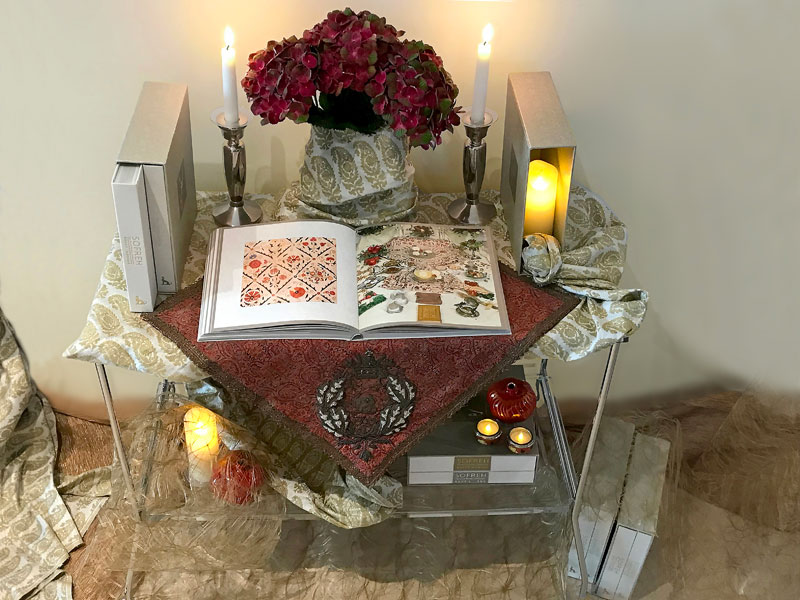
This composition, too, was designed to suggest SOFREH as a Christmas present. It incorporates several volumes of the book, and is inspired by the traditions of the winter solstice (Shab-e Yalda). To learn more please scroll down to Shab-e Yalda, Winter Solstice, December 2021. The inclusion of a length of red textile, red hydrangeas and ceramic pomegranates echo the traditions of Shab-e Yalda. In this arrangement, one of the books showcases a double-page spread of a sofreh-ye aqd, entitled “Double Reflection, Suzani Garden”, especially staged for photography.

This composition was designed to suggest SOFREH as a wedding gift. It incorporates several volumes of the book, and is inspired by the traditions of the Persian marriage sofreh (sofreh-ye aqd). The inclusion of a bouquet of Silver Lace roses and foliage, softly draped gold mesh and sculptured pomegranates echo the sofreh-ye aqd. In this arrangement, one of the books showcases a double-page spread of an ancient map of Persia and another a sofreh-ye aqd, entitled “Still Life”, which is featured in the “Live” aqds section.
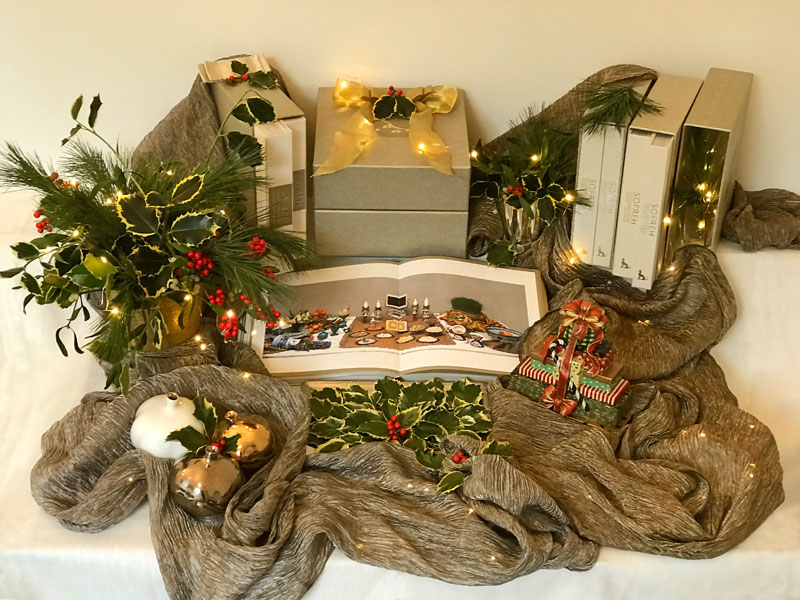
This composition was designed to suggest SOFREH as a Christmas present. It incorporates several volumes of the book, and is inspired by the traditions of Christmas. The inclusion of Christmas lights, a variety of Christmas foliage (mainly variegated holly), and shiny silver, gold and white pomegranates (reminiscent of Christmas baubles) echo the Christmas spirit. In this arrangement, one of the books showcases a double-page spread of a sofreh-ye haft sinn, entitled “Persian Blue on Gold”, especially staged for photography.
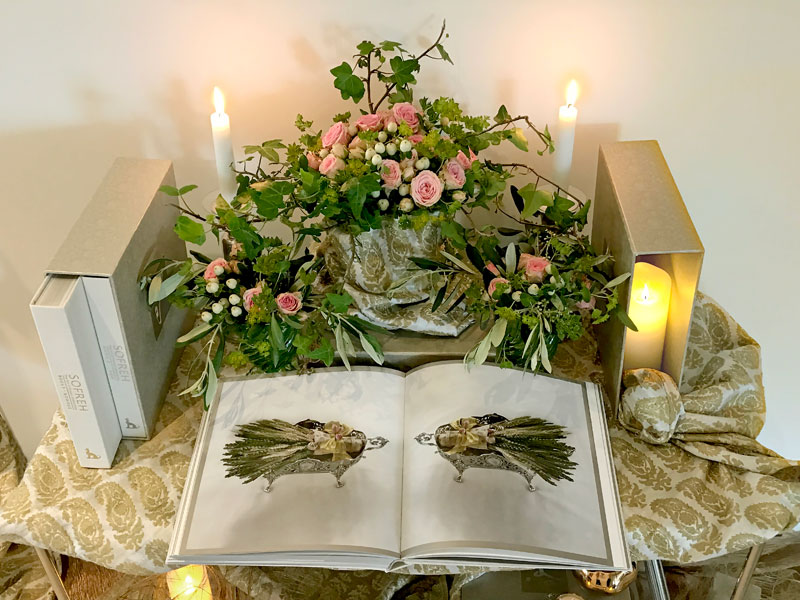
This composition was designed to suggest SOFREH as a wedding gift. It incorporates several volumes of the book, and is inspired by the traditions of the Persian marriage sofreh (sofreh-ye aqd). The inclusion of softly illuminated delicate bouquets of pink spray roses, Hypericum and foliage, and lengths of elegantly draped fine textiles, echo the sofreh-ye aqd. In this arrangement, one of the books showcases a double-page spread of the image of a pair of hand-tied sheaves of wheat from a sofreh-ye aqd, entitled "Tropical Garden”, featured in the “Live” aqds section.
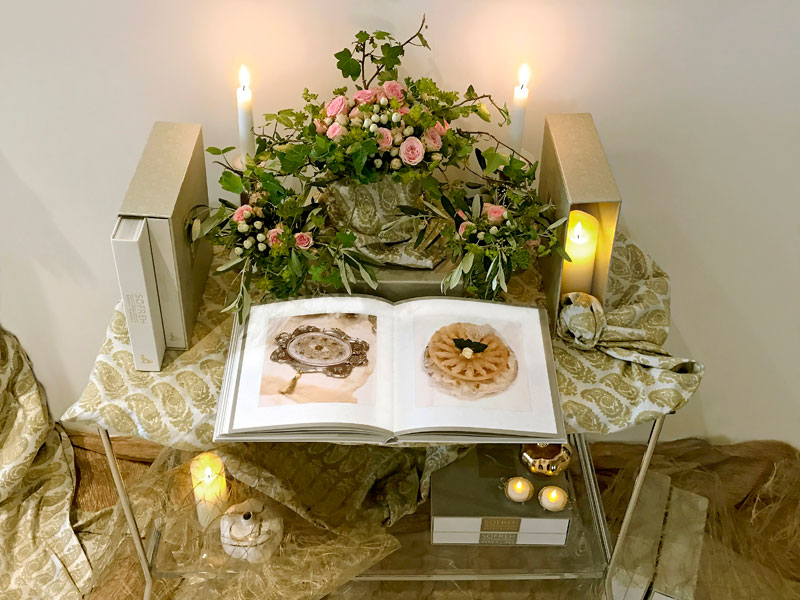
This composition, too, was designed to suggest SOFREH as a wedding gift. It incorporates several volumes of the book, and is inspired by the traditions of the Persian marriage sofreh (sofreh-ye aqd). The inclusion of delicate bouquets of spray roses and foliage and lengths of fine textiles echo the sofreh-ye aqd. In this arrangement, one of the books showcases a double-page spread of a silver platter of decorated esfand (seeds of rue) and kaseh nabat (crystal sugar in the form of a bowl) from an elaborate sofreh-ye aqd, entitled “Antique Lace”, especially staged for photography.
Tip Top Roses
As discussed in SOFREH: The Art of Persian Celebration, the marriage sofreh (sofreh-ye aqd) takes “its cue from the sofreh-ye haft sinn”. The two sofrehs share many symbolic elements, such as a mirror and candelabra. Nowadays, germinated seeds (sabzeh), which are the essence of the Nowruz festival and an important part of the sofreh-ye Nowruz (haft sinn), are usually only included in the sofreh-ye haft sinn. However, they also used to be part of the sofreh-ye aqd. Therefore, in the sofreh designed for July 2025, a block of germinated wheat takes a prominent position.
The creation of this simple yet original sofreh was inspired by a bouquet of spectacular roses, known as Tip Top, and trailing branches of Eucalyptus stuartiana.
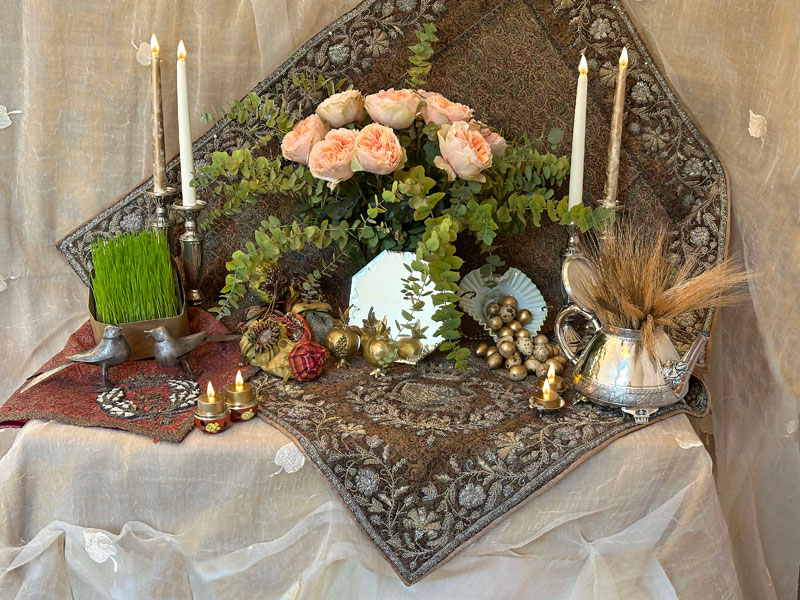
This is the overall view of the sofreh. A sheer textile with leaf motifs forms the backdrop, overlayed by two lengths of elaborately embroidered antique Persian textiles, known as termeh. In tune with past practices, a block of germinated seeds (sabzeh) enlivens and brightens the left corner of the sofreh. Many of the symbolic elements of the Persian marriage sofreh (sofreh-ye aqd), namely a mirror, flames, sheaves of wheat, decorated eggs and sculptured birds and pomegranates, are on display.
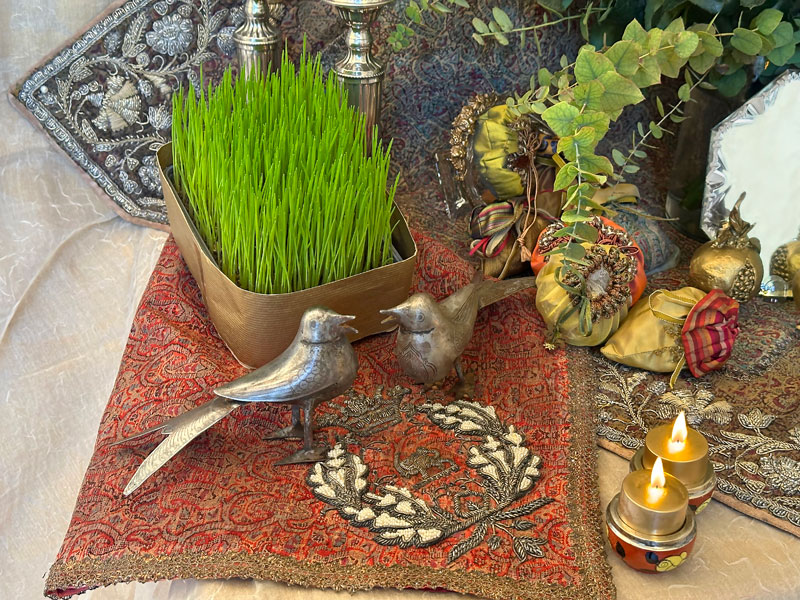
This is the left corner of the sofreh. Unlike usual current practices, a block of germinated wheat (sabzeh) is included in this charming sofreh-ye aqd. Sabzeh is such a bright, fresh and green addition to any sofreh. A pair of stylized birds represents the newlyweds. The lovely length of red termeh, with its intricate embroidered crest, crown and the “lion and sun” emblem, creates a delightful contrast with the green shoots of the sabzeh. Flames of a pair of tea lights softly illuminate this intricate ensemble.
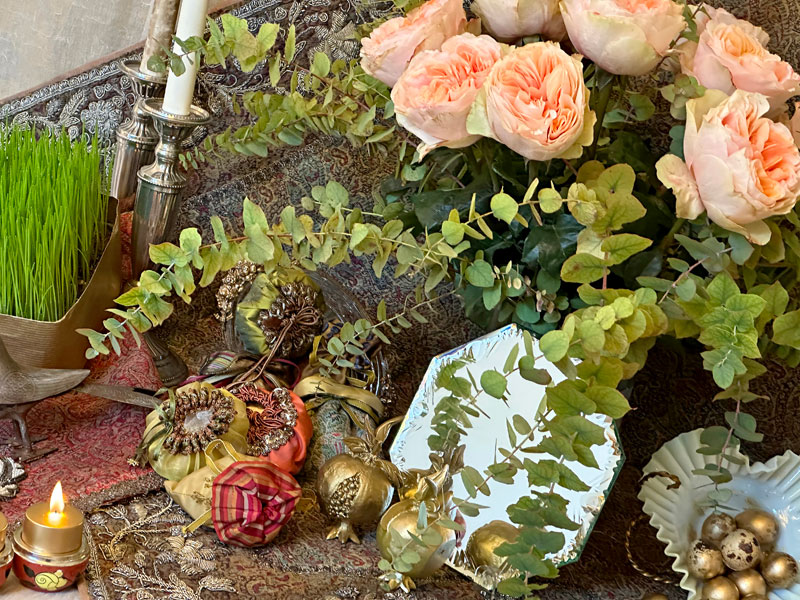
This image focuses on the hanging branches of the lovely Eucalyptus stuartiana and their reflection in the mirror. This particular type of Eucalyptus has a heavenly light green/yellow hue, which enhances the beauty of this delightful sofreh. A few bonbonnières in the Persian spirit, in soft tones of green and orange, cascade out of an antique vessel, complementing the colour scheme of the sofreh. Sculptured gold-tinted pomegranates are placed in front of the mirror.
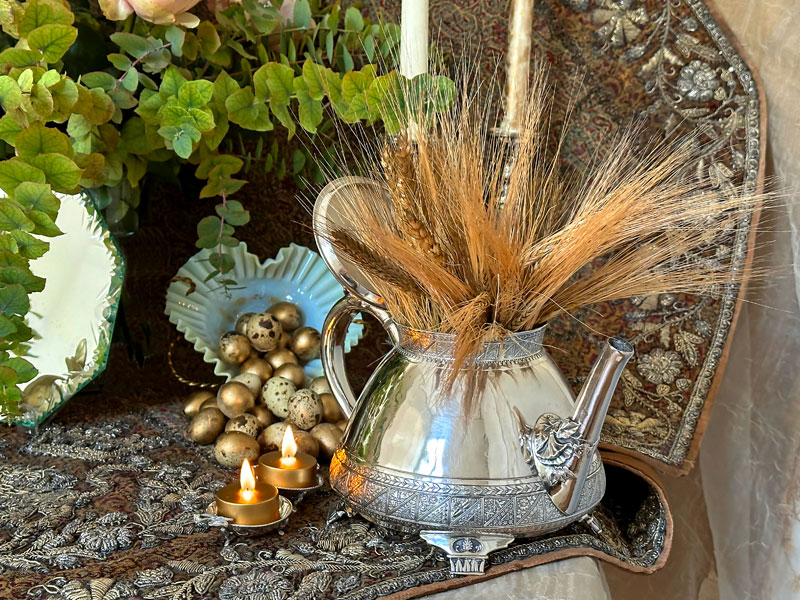
This is the right corner of the sofreh. Sheaves of natural and lightly gold-tinted wheat, a symbol of blessing and abundance (barekat), are presented in an attractive antique silver-plated teapot. Natural and gold-tinted quail eggs spill out of a beautiful antique ivory opaline dish onto the termeh. A pair of tea lights, presented in delicate antique silver holders, softly illuminates this section, while the termeh’s elaborate metallic embroidery adds texture and sparkle to this corner.
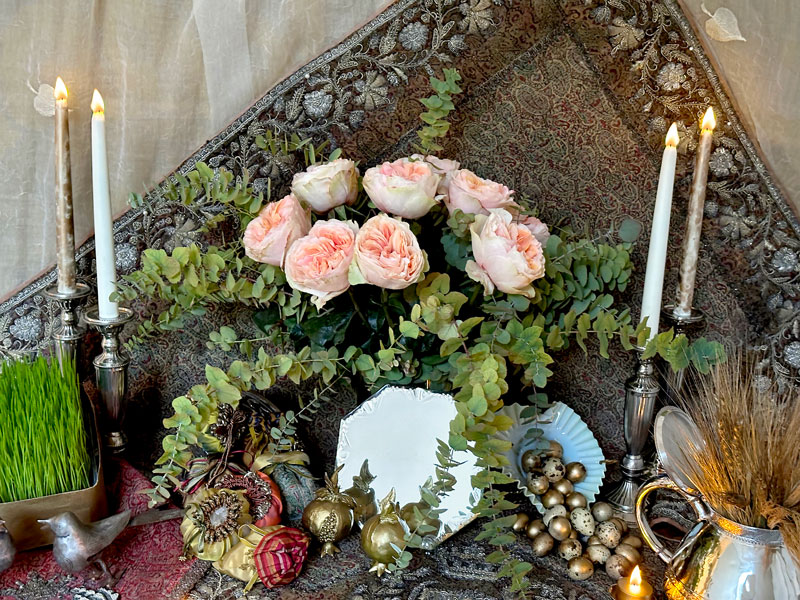
This is the heart of the sofreh. The familiar notion of ayeneh sham’dan (a mirror and candelabra), which is an essential part of any sofreh-ye aqd, is clearly presented here, though the format of the composition is not entirely conventional. The bouquet of roses against the backdrop of the elaborately embroidered termeh looks truly spectacular, and the reflection of the hanging Eucalyptus and the sculptured gold-tinted pomegranates in the mirror is utterly enchanting.
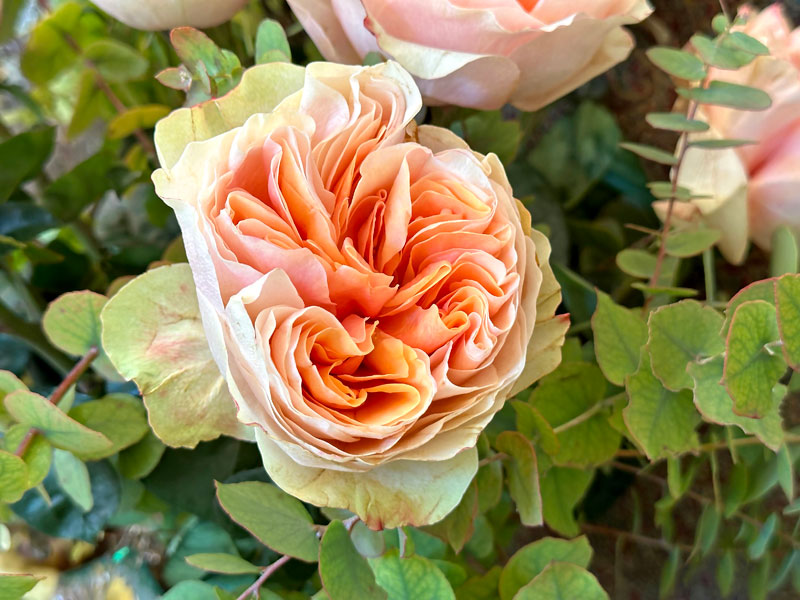
This is a close-up of one of the roses in the bouquet. These subtly fragrant “garden-like” roses with layered petals are so dazzling that they merit this close-up of a single flower. The petals are in different tones of peach with subtle pastel green edges. These splendid roses truly shine next to the leaves of Eucalyptus stuartiana, in pistachio green, with a pale orange fringe. Apple-scented gum or Apple box are among the common names of Eucalyptus stuartiana.
Basket of Flowers
The intricate basket of flowers, embroidered on a length of Persian antique textile (termeh), inspired the creation of this detailed Persian marriage sofreh—sofreh-ye aqd.
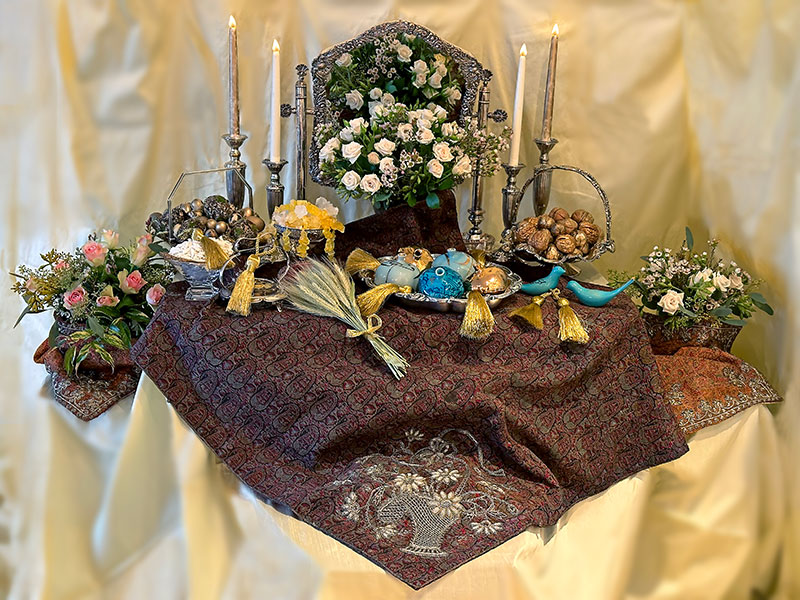
This is the overall view of the sofreh, which includes a rich selection of the symbolic elements of the sofreh-ye aqd. To replicate the intricate basket motif, decorated eggs and gold-tinted nuts, both symbols of fertility, and gilded coins are presented in elegant antique silver-plated baskets. Ceramic pomegranates and birds, a sheaf of wheat, Persian sugared almonds and crystal sugar are on display. An ornate antique silver-plated mirror and candelabra take centre stage. Bouquets of delicate roses and soft foliage, fine antique Persian textiles and gold tassels enhance the beauty of the sofreh.
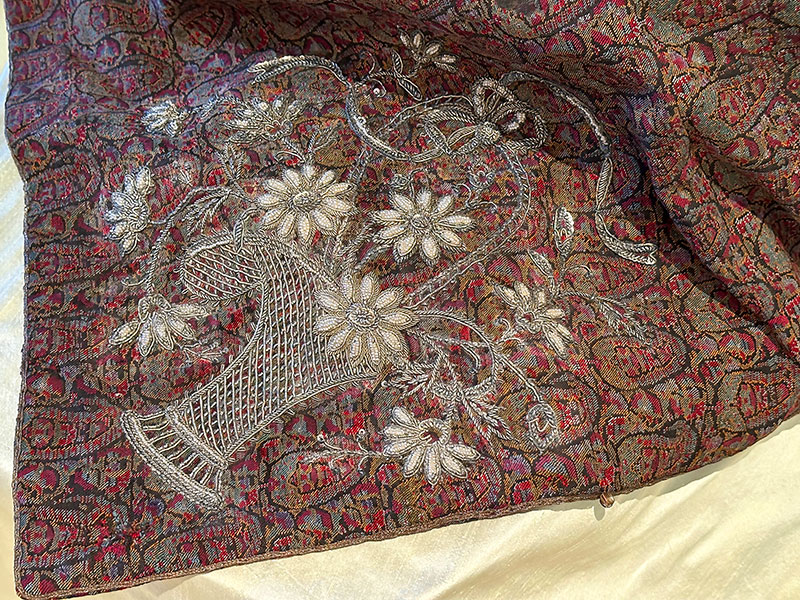
This is a close-up of the basket of flowers, foliage and tendrils intricately embroidered on this length of early 20th-century Persian textile, probably from Kerman or Yazd, known as termeh. The production of these termehs, which are integral to the marriage and Nowruz sofrehs, continues in Iran to this day. Often passed down as heirlooms, these exquisite handmade textiles carry joyful sentiments. This delicate basket and the bouquet of flowers are embroidered with fine metallic threads and seed-pearls.The movement of the branches and the outline of the basket complement each other.
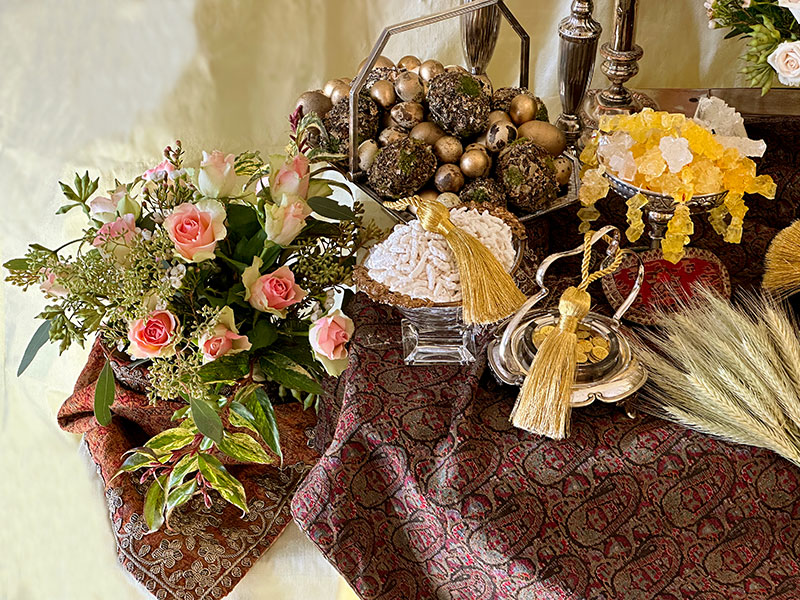
This is the left side of the sofreh. To replicate the basket design, antique silver-plated baskets of tastefully decorated eggs and gilded coins (sekkeh), symbols of fertility and wealth respectively, are on display. Persian sugared almonds (noql) and crystal sugar (nabat), symbolizing sweetness and harmony, are presented in attractive antique vessels. A bouquet of soft miniature roses and fine foliage brighten and enhance the beauty of this section.
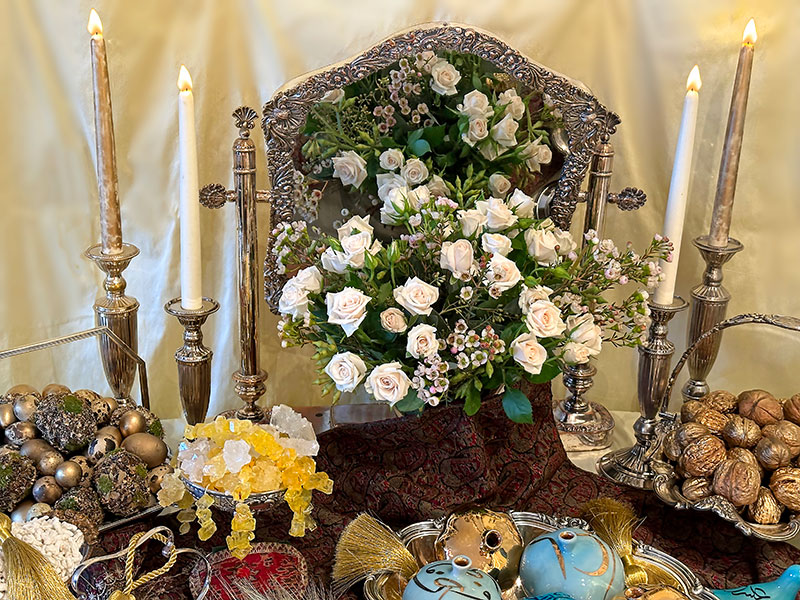
This is the heart of the sofreh. An impressive bouquet of delicate cream spray roses and wax flower sits in front of the mirror, and its reflection makes for a delightful backdrop. Two pairs of antique silver-plated candelabra complete the ceremonial presentation of a “mirror and candelabra” (ayeneh sham'dan), which is an important component of any sofreh, symbolizing reflection and light. The hanging segments of nabat are nicely visible.
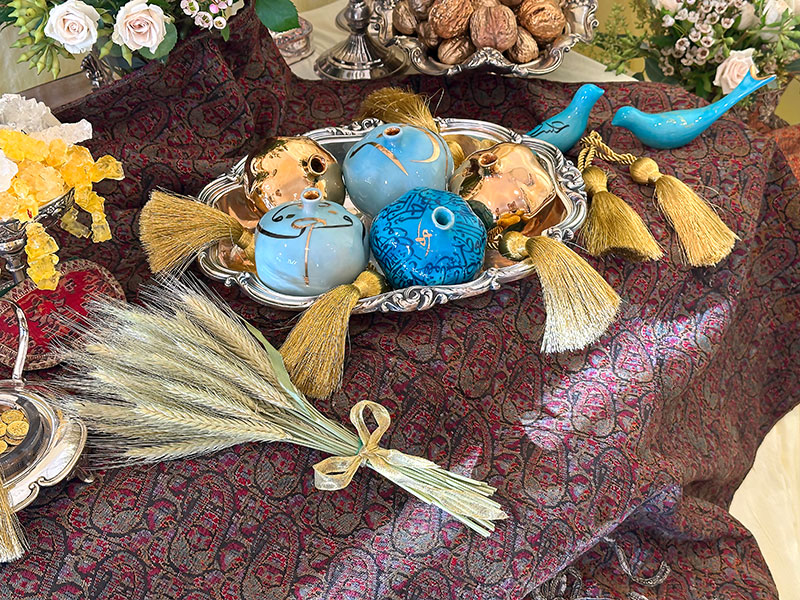
This is a close-up of an antique silver-plated container of ceramic pomegranates, in blue and metallic-gold tones. These delightful pomegranates are the work of the Iranian/Canadian artist, Keyvan Fehri. A pair of ceramic birds represents the married couple and its Persian blue colour complements the ensemble of the ceramic pomegranates, a symbol of fertility. Fine metallic-gold tassels add glow and shine to this section, and enhance its beauty. A sheaf of wheat indicates blessing and abundance (barekat).
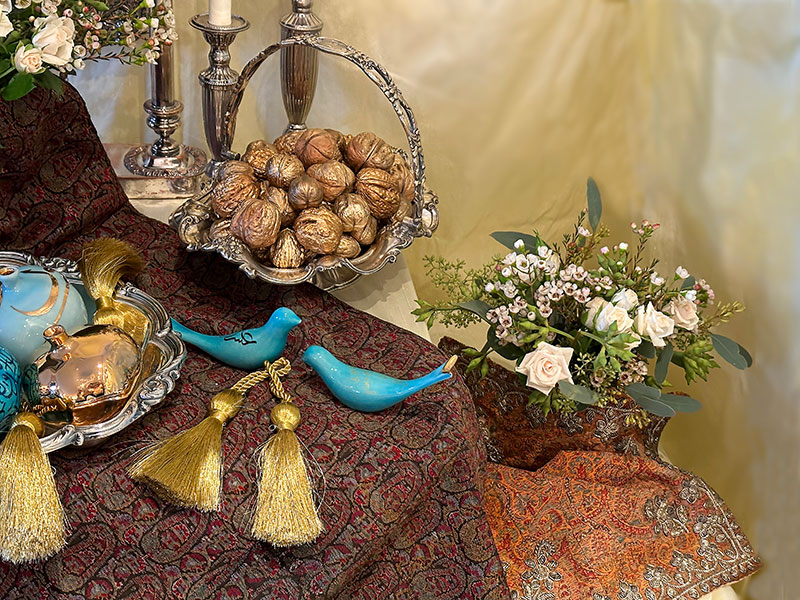
This is the right corner of the sofreh. An attractive antique silver-plated basket complements the basket design of the embroidery and holds large gold-finish nuts, a symbol of fertility. The Persian blue ceramic birds, representing the married couple, and a pair of fine metallic-gold tassels are visible in the foreground. A miniature bouquet of cream spray roses, wax flower and foliage, elegantly wrapped in a length of intricately-embroidered termeh, is placed in the far right corner and enhances the beauty of this section.
Nowruz & Easter
This original Persian blue sofreh was designed with inspirations from the sofreh-ye Nowruz and the traditions of Easter. The arrangement, which is set up at descending levels on lengths of fine antique and contemporary metallic-gold textiles, includes several of the symbolic elements of the sofreh-ye Nowruz and the traditions of Easter.
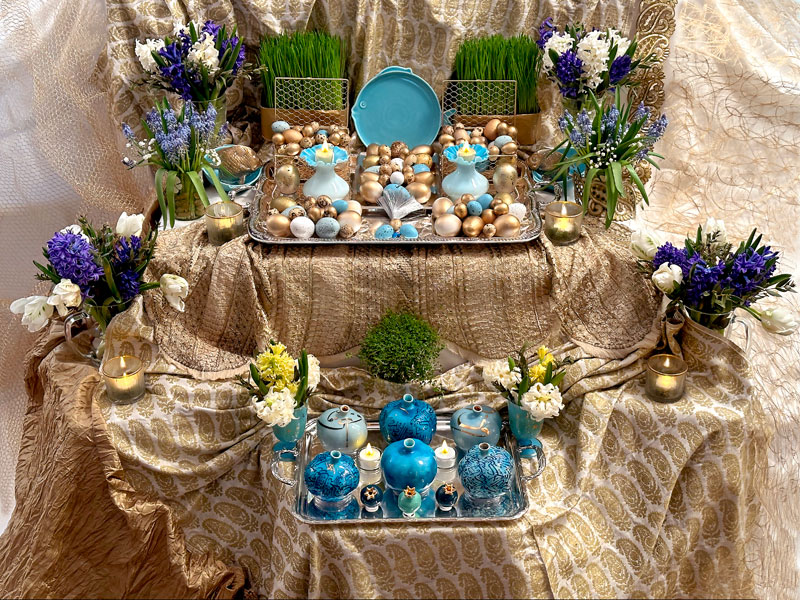
This is the overall view of the sofreh. A ceramic blue dish in the form of a fish, together with an impressive platter of decorated eggs, take centre stage, while other representations of fish in the form of containers and sculptures are on display. An attractive selection of ceramic pomegranates in shades of blue is presented, as are miniature bouquets of predominantly blue spring flowers, germinated seeds and a pot of Soleirolia soleirolii, commonly known as the “mind-your-own-business plant”. This novel sofreh is softly illuminated by the flames of several tea lights.
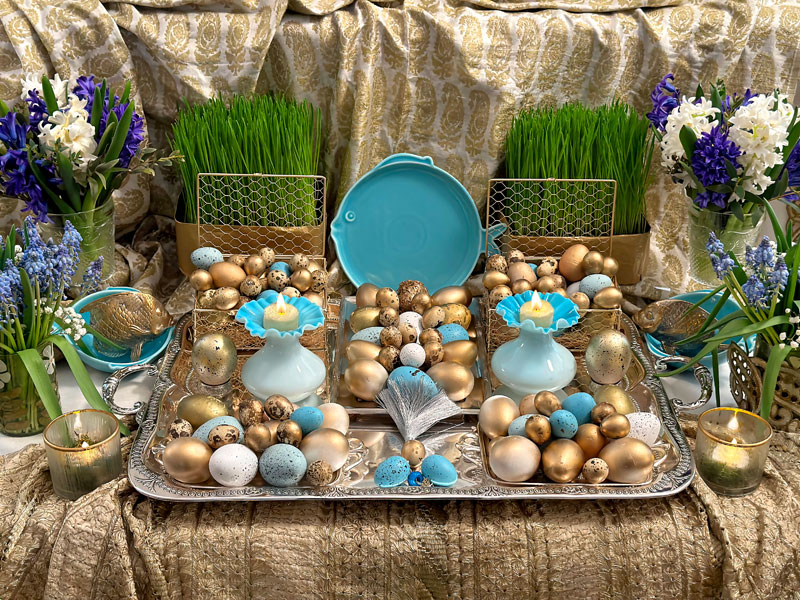
This is the heart of the sofreh. The focus of this image is the impressive platter of coloured eggs presented in various attractive containers. A lovely blue dish in the shape of a fish is placed between the boxes of decorated eggs and blocks of germinated wheat. A pair of fish statuettes, set in ceramic bowls in the form of a fish, is on display. A fine metallic-silver tassel brushes against the central container of eggs. Two pairs of tea lights—in elegant blue opaline and gold-rimmed clear glass holders, respectively—softly illuminate this exquisite and intricate composition.
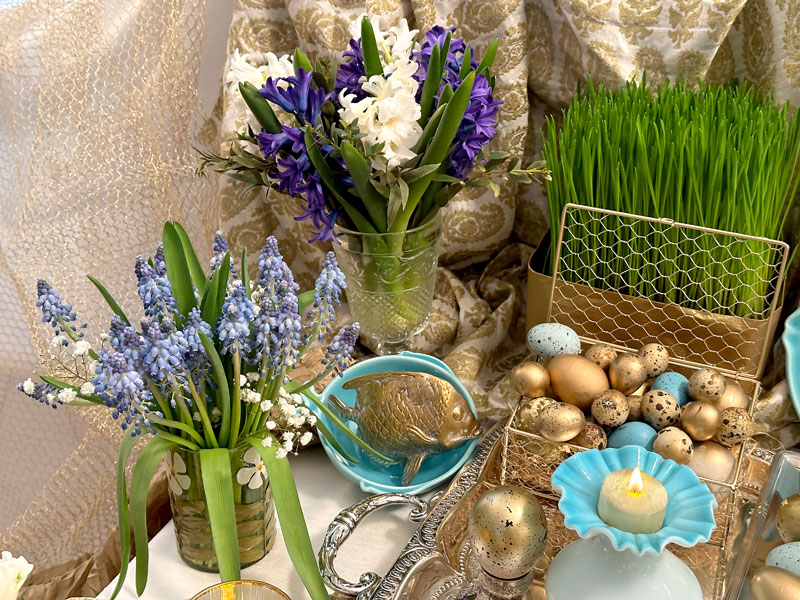
This is the left corner of the sofreh. The focus of the image is the two bouquets of spring flowers, namely white and striking blue hyacinths mixed with foliage, as well as Muscari and baby’s breath (Gypsophila). Decorated hen and quail eggs are presented in a box made of gold open mesh and are illuminated by the flame of a tea light in an attractive blue opaline holder. A bloc of germinated wheat is placed behind the open box of eggs. A fish statuette, set in a ceramic bowl in the form of a fish, is on display.
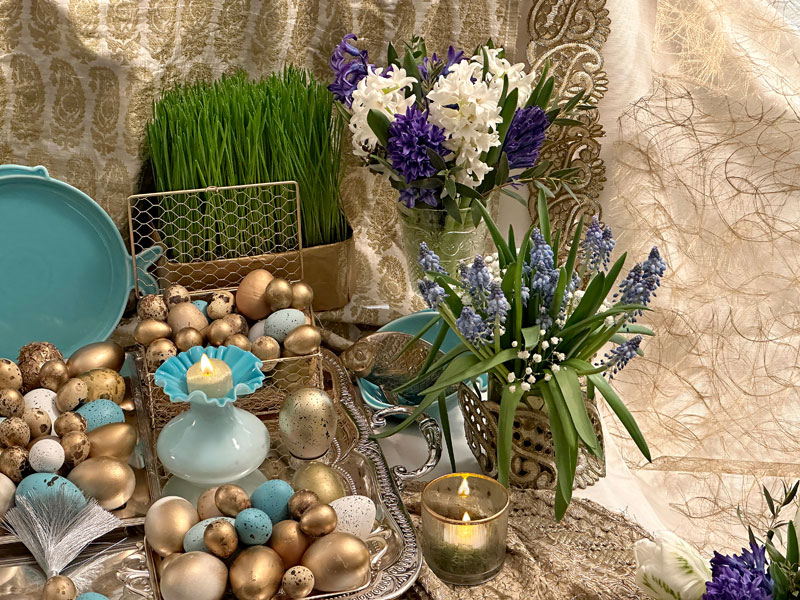
This is the right corner of the sofreh. The focus of the image is the two bouquets of spring flowers, namely white and striking blue hyacinths mixed with foliage, as well as Muscari and baby’s breath (Gypsophila). Decorated hen and quail eggs, presented in a box made of gold open mesh and on a small tray, are illuminated by the flames of tea lights in attractive holders. A bloc of germinated wheat is placed behind the open box of eggs. A fish statuette, set in a ceramic bowl in the form of a fish, is on display.
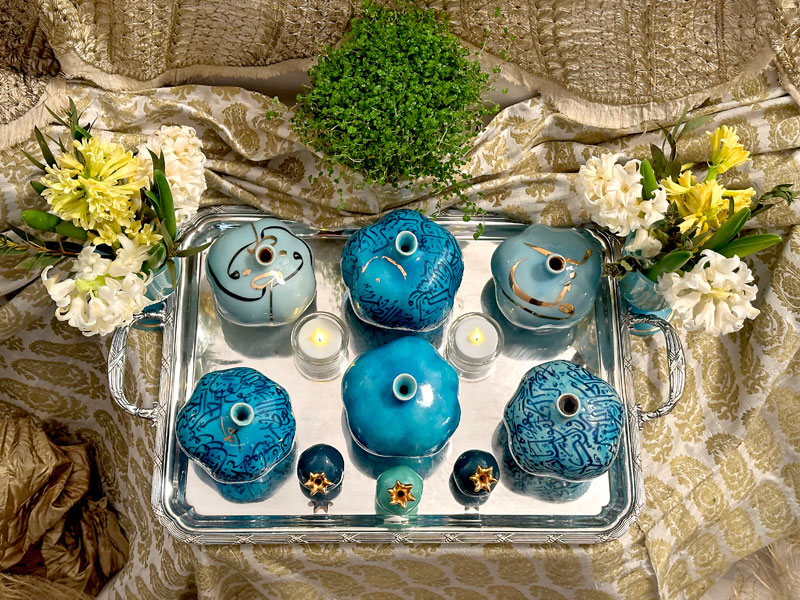
This is the front section of the sofreh. A shiny silver-plated tray acts as a mirror and holds ceramic pomegranates of different sizes and in different shades of blue. Flames of a pair of tea lights illuminate this section, which includes a pot of Soleirolia soleirolii and a pair of tiny bouquets of hyacinths in white and yellow. The fine draped antique and contemporary textiles enhance the beauty of this section.
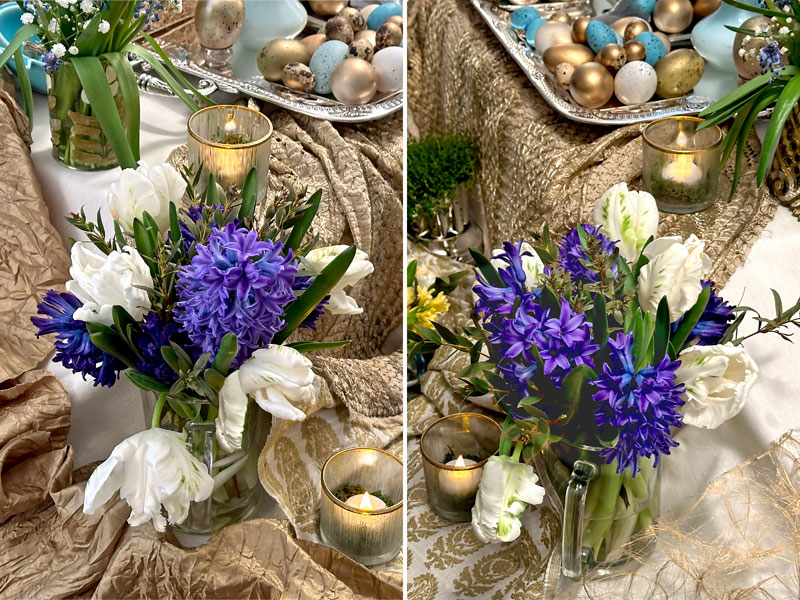
These are the miniature bouquets of amazing white parrot tulips, striking blue hyacinths and foliage, which are placed at mid-level on this descending sofreh. Elegantly draped contemporary and antique Indian, and fine contemporary European textiles in various tones of metallic gold set off the delicate bouquets, while flames of the tea lights in attractive gold-rimmed glass holders illuminate these flowers.
Sofreh-ye Haft sinn, February 2025
In February 2025, in preparation for Nowruz, this fresh-looking compact sofreh was designed to welcome spring and bid farewell to winter. The sofreh includes seven (haft) symbolic elements starting with the letter “s” (sinn)—hence the term “haft sinn”.
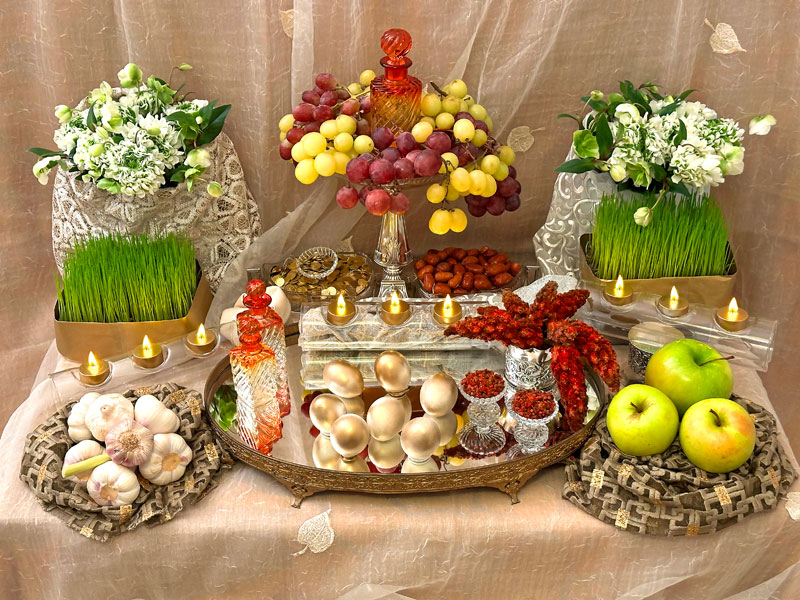
This is the overall view of the sofreh-ye haft sinn, which is created against a backdrop of a lovely muted-gold silk, covered with a fine transparent ivory silk, with leaf motifs. The backdrop makes for a harmonious and serene setting. Sabzeh (germinated seeds), sir (garlic), serkeh (vinegar), senjed (jujube fruit, or Russian olive), sekkeh (gilded coins), somaq (sumac) and sib (apple) are on display, as well as a mirror, flames, decorated eggs and bouquets of flowers. The symbolic significance of all these items is once again discussed on this page.
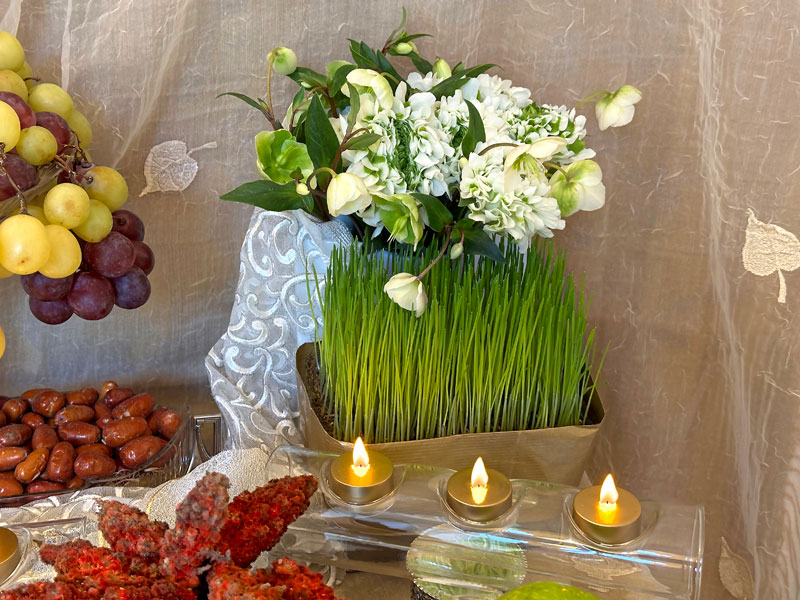
This is a close-up of one of the identical bouquets placed on either side of the sofreh-ye haft sinn. Flowers herald the renewal of nature and lend beauty to the sofreh. The delicate bouquets are made of ivory and green Pompon Igloo ranunculi and Helleborus niger, and their vases are elegantly wrapped in lace-like fine textiles. The block of germinated wheat (sabzeh), the essence of this spring festival, is placed in front of the vase to enhance the beauty of the bouquet. The flames of the tea lights, placed in a simple glass holder, illuminate this section.
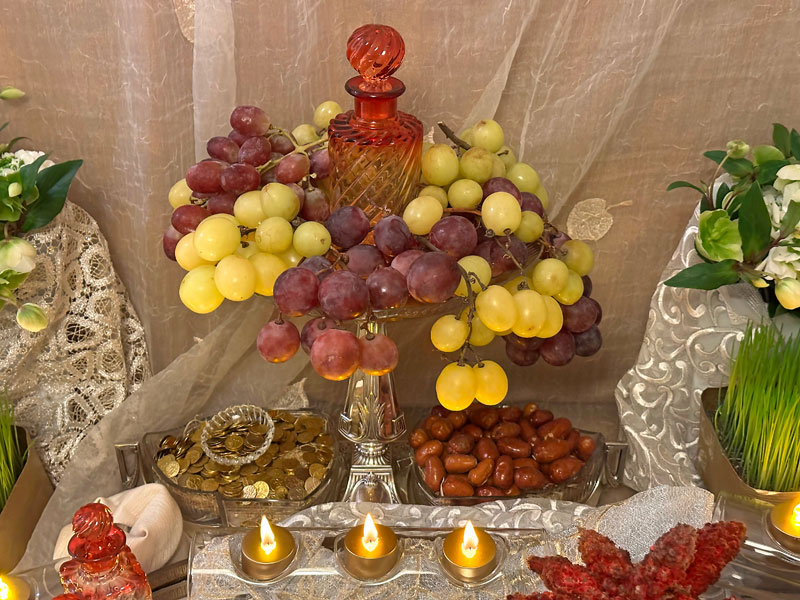
This is the heart of the sofreh-ye haft sinn. An antique flask of vinegar (serkeh), embellished with gracefully hanging bunches of green and red grapes, represents one of the seven symbolic elements of the sofreh-ye haft sinn. Serkeh symbolizes patience and is cherished for its medicinal values too. The elegant antique crystal and silver-plated vessel also showcases gilded coins (sekkeh), a symbol of wealth and prosperity, and jujube fruit, sometimes known as Russian olive (senjed), a symbol of love and rebirth. This central section is illuminated with the flames of three tea lights, presented in a simple glass holder, embellished with a length of fine lace-like fabric.
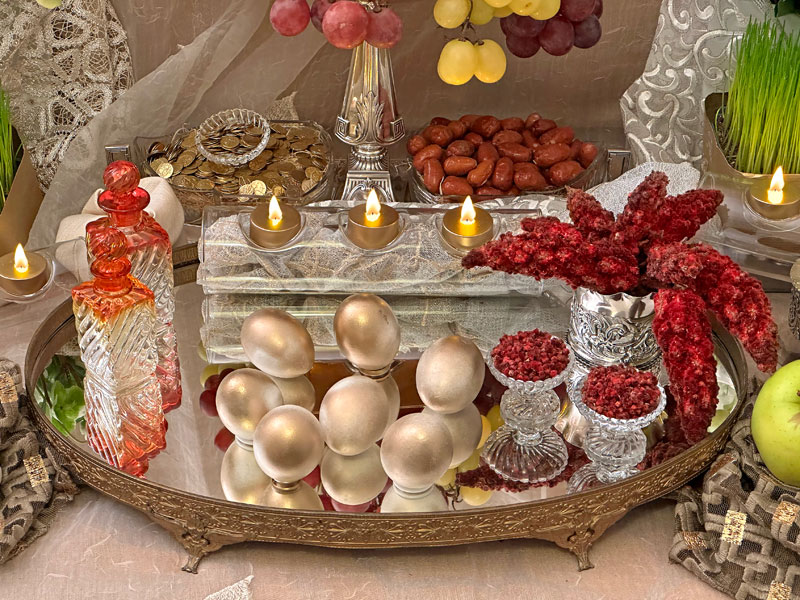
This is the front section of the sofreh-ye haft sinn. Two additional antique flasks of vinegar (serkeh), sit atop an antique gold-framed mirrored tray. Branches and segments of sumac (somaq), a symbol of plenty, growth, peace and harmony, are presented in antique containers and their reflection in the mirror (ayeneh), a symbol of light and reflection, is truly enchanting. Seven subtly gold-tinted eggs, symbols of fertility, are placed on the mirror. It is believed that when the old year turns into the new (sal tahvil), the eggs on the mirror tremble. This front section is softly illuminated with the flames of the same tea lights, that can be seen in the image on the left.
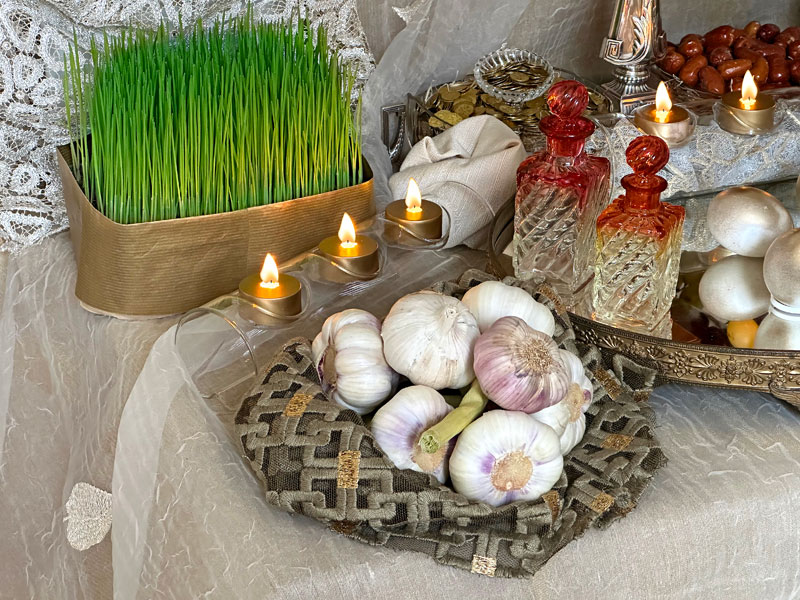
This is the left corner of the sofreh-ye haft sinn, which creates an elegant symmetry with the right corner. The focus of the image is the seven fresh garlic bulbs, placed on a bed of draped lace-like fine textile with metallic-gold accents. Garlic (sir) is valued for its medicinal and evil-averting faculties. The beauty of this mini composition is enhanced by a block of germinated wheat (sabzeh)—the essence of this spring festival and a symbol of rebirth and growth. This corner is softly illuminated with the flames of three tea lights placed in a simple glass holder.
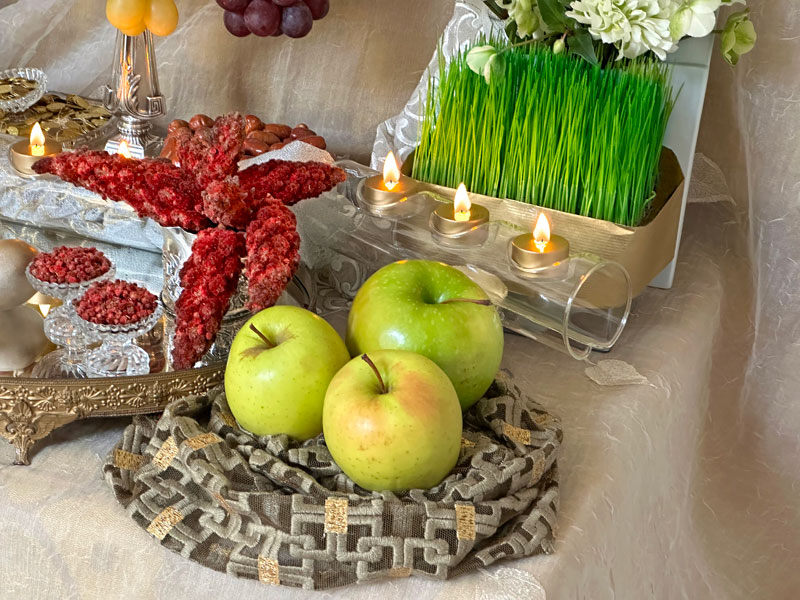
This is the right corner of the sofreh-ye haft sinn. The focus of the image is the large, splendid, shiny green apples (sib), symbols of health and fertility, once again placed on a bed of draped lace-like fine textile with metallic-gold accents. Also visible in this image are branches and segments of sumac (somaq). The backdrop of this mini composition is another block of sabzeh—the essence of this spring festival and a symbol of rebirth and growth. This corner, too, is softly illuminated with the flames of three tea lights placed in another simple glass holder.
 Handbags
Handbags
Apart from their conventional use, some handbags make for fascinating containers. In this contemporary interpretation of past practices, an original marriage sofreh (sofreh-ye aqd) was designed, incorporating handbags as containers for some of the symbolic elements of the sofreh. A combination of vintage and new bags, in different materials, have been included.
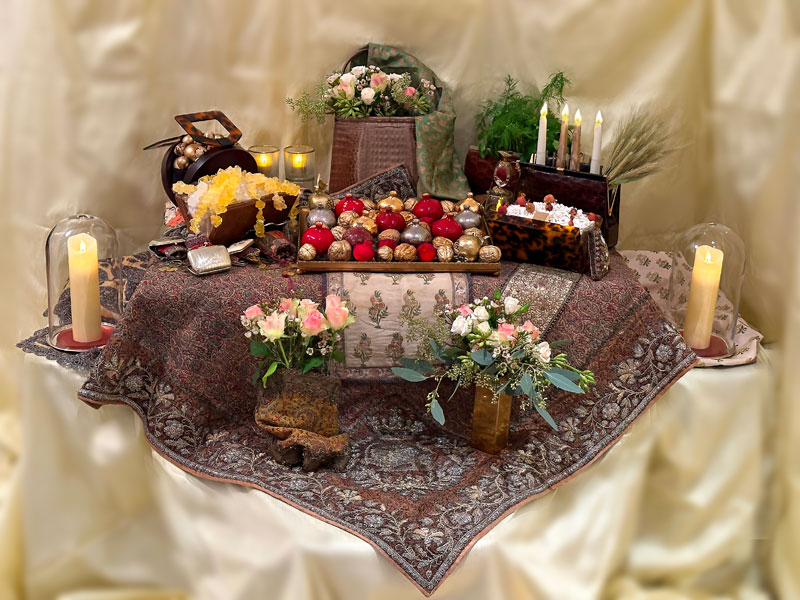
This is the overall view of the original sofreh which is arranged on a length of antique Persian textile (termeh) in subtle shades of yellow, boasting a recently restored, intricately embroidered border with metallic threads. It incorporates an antique miniature mirrored jug of Persian rosewater (golab), candles, tea lights, a sheaf of wheat, fruits, nuts, flowers, herbs, gilded coins (sekkeh), Persian sugared almonds (noql) and crystal sugar (nabat). In the Persian tradition noql o nabat are synonymous with joy and celebrations, which makes them a valuable part of the ceremonial sofrehs.
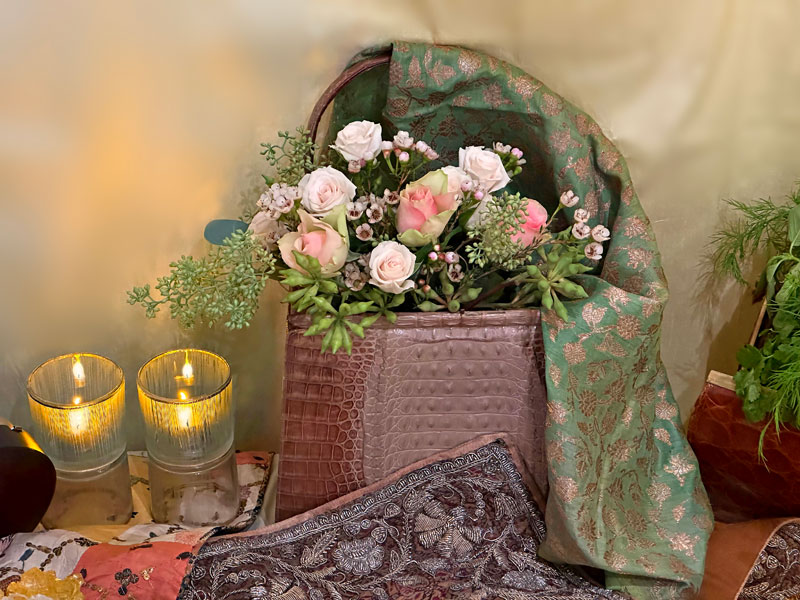
The focus of this image is the central part of the sofreh. This lovely vintage handbag houses a charming bouquet of small and spray roses in pastel shades, and elegant foliage, namely Eucalyptus robusta, Eucalyptus populus and wax flowers (Ella). An exquisite length of antique Persian silk brocade gracefully hangs over one side of the handbag. The intricately embroidered corner of the termeh, leaning against the vintage handbag, enhances the beauty of this central section. Flames of a pair of tea lights placed in attractive gold-rimmed glass holders illuminate the section.
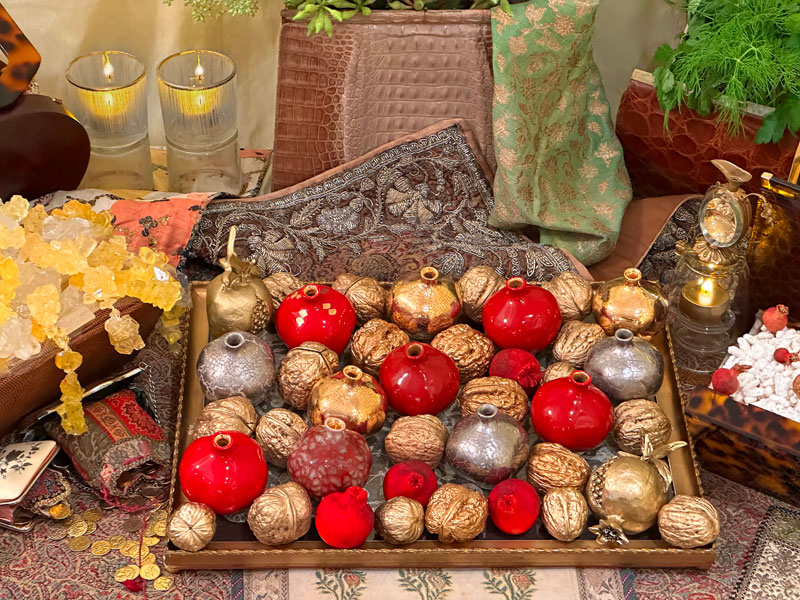
At the heart of the sofreh sits a delightful tray of symbols of fertility. The antique gold-framed tray presents miniature sculptured pomegranates in red and metallic silver and gold, largely by the Iranian/Canadian artist, Keyvan Fehri (@keyvanfehri), as well as ample gold-tinted walnuts. The backdrop to the tray, a corner of the intricately embroidered antique Persian textile, known as termeh, and a section of the antique Persian silk brocade add a certain panache to the heart of this original sofreh. Flames of tea lights illuminate this charming composition.

This is the front section of the sofreh. Two bouquets of small roses, spray roses, wax flowers (Ella), Eucalyptus populus and Eucalyptus robusta against the backdrop of the tray of sculptured pomegranates and decorated walnuts, as well as various antique Persian textiles adorn this section. The left bouquet is wrapped in a length of a subtle yellow antique Persian textile, known as termeh, showcasing paisley motifs and an intricate metallic border. In the centre the antique Persian silk fragment in soft tones, with metallic-gold threads, boasts a charming boteh design.
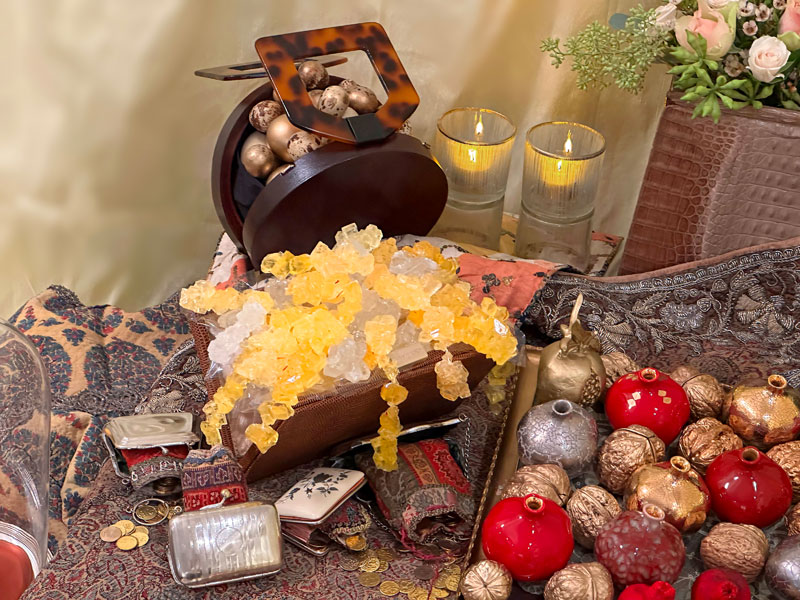
This is the left corner of the sofreh. An original handbag made of wood with an imitation tortoiseshell handle houses a variety of gold-tinted eggs, a symbol of fertility. The speckled finish of the quail eggs complements the pattern of the tortoiseshell handle. An elegant leather clutch bag contains a delightful display of translucent crystal sugar, a symbol of sweetness and harmony, in pastel tones. Gilded coins, a symbol of wealth and prosperity, pour over the surface of the sofreh, out of antique silver-plated and enamelled purses and pouches, made of fragments of antique Persian textiles. A pair of flames, placed inside elegant gold-rimmed glass holders, softly illuminates this section.
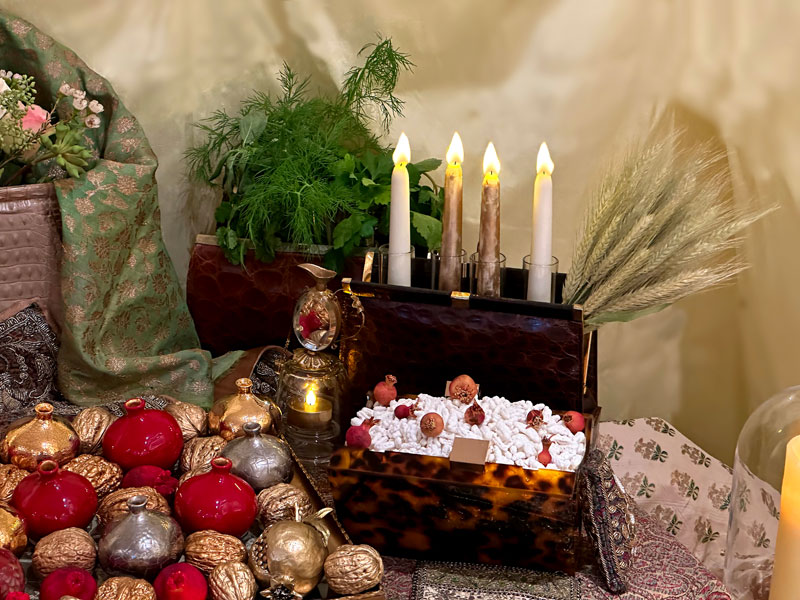
This is the right corner of the sofreh. The vintage handbag right at the back holds a variety of fragrant herbs, which are regularly part of the sofreh-ye aqd. Herbs, usually accompanied by Persian cheese augur happiness and good fortune to the newlyweds. Another vintage handbag houses candles and a sheaf of wheat, a symbol of blessing and abundance (barekat). The imitation tortoiseshell clutch bag showcases noql (a symbol of sweetness and harmony), embellished with miniature ornamental pomegranates. To perfume the air an antique miniature jug of rosewater, presenting a suggestion of a mirror is on display. Several flames illuminate this exquisitely rich corner.
Shab-e Yalda, Winter Solstice 2024
The posts of December 2024 present two compact sofrehs, which include various symbols of the traditions of Shab-e Yalda, the winter solstice, which is the longest night of the year. It is the eve of 1 Dey in the Persian calendar, corresponding to 21 December. The feast of Yalda originates in the pre-Islamic period and is associated with agriculture. The divan-e Hafez (works of 14th-century Persian poet, Hafez) to recite poetry, and red fruits—watermelons and pomegranates—are important parts of this celebration, heralding the crimson hues of sunrise after absolute darkness, and the promise of longer days ahead. It is the celebration of the passing of darkness and the rebirth of the sun. Interestingly, Shab-e Yalda is only about one minute longer than the preceding night. In the Persian tradition people get together, tea, sweets, nuts and fruits are served, and stories and poetry are recited, and fortunes are told, to get through the darkest and longest night of the year, when it is believed that demons are most active.
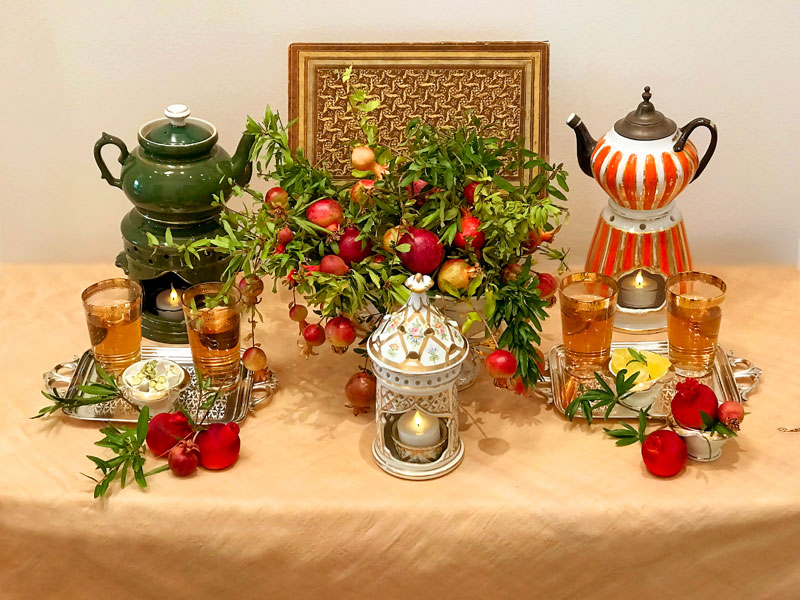
This is the overall view of the first compact sofreh. The jewel-like arrangement was inspired by an ample bunch of ornamental pomegranates. Two French antique tisanières replace the traditional samovar to prepare tea, served with sweets. An antique intricate holder takes centre stage and the tea light flame it holds softly illuminates the sofreh. A volume of the divan-e Hafez with an attractive antique binding is on display.

The focus of this image is the ample bunch of absolutely divine ornamental pomegranates, which inspired the creation of this sofreh for the celebrations of Shab-e Yalda. Ornamental pomegranates are not readily available but are invaluable for decorating miniature sofrehs. The intricate lid of the French antique porcelain tea light holder enhances the beauty of the bouquet of the ornamental pomegranates.
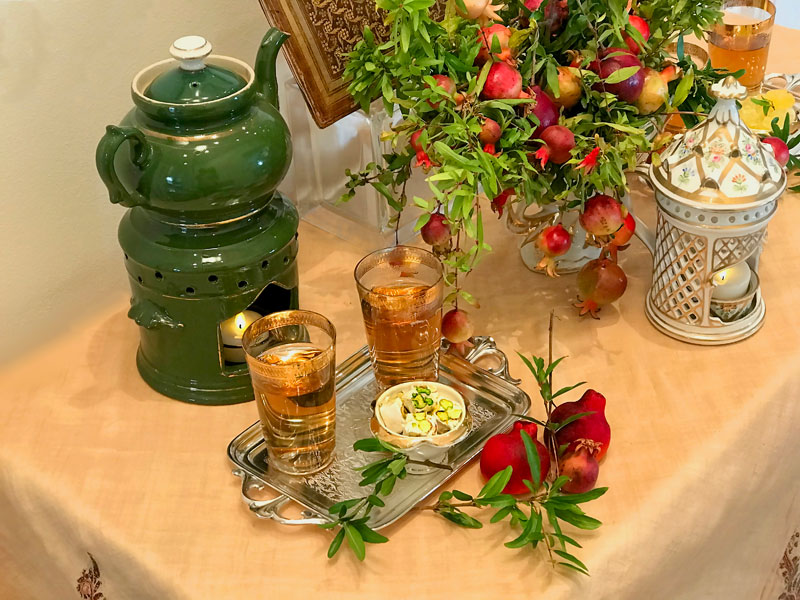
This image focuses on the left side of the sofreh for the celebrations of Shab-e Yalda. An attractive, olive-green French antique porcelain tisanière takes the place of the traditional samovar. During the celebrations, tea is served. Here, gold-rimmed glasses of tea together with Persian pistachio nougats (gaz), placed on a miniature antique tray, are on display. This section is illuminated with the flame of the tisanière’s burner, and embellished with delicate pomegranate sprigs and sculptured and ornamental pomegranates.
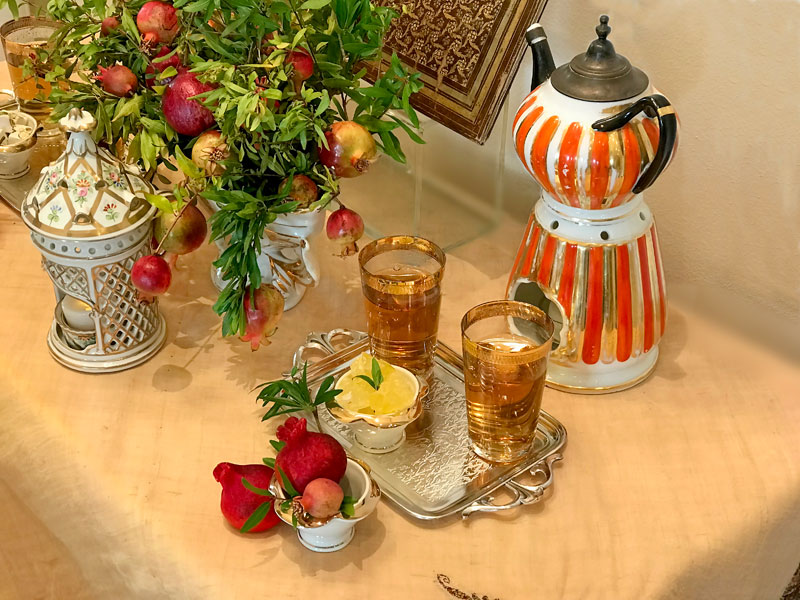
This image focuses on the right side of the sofreh for the celebrations of Shab-e Yalda. Another French antique porcelain tisanière takes the place of the samovar. During the celebrations, tea is served. Here, gold-rimmed glasses of tea together with Persian crystal sugar (nabat), placed on a miniature antique tray, are on display. This section, too, is embellished with pomegranate sprigs and miniature sculptured and ornamental pomegranates, and the flame of the tisanière’s burner nicely reflects in one of the tea glasses.
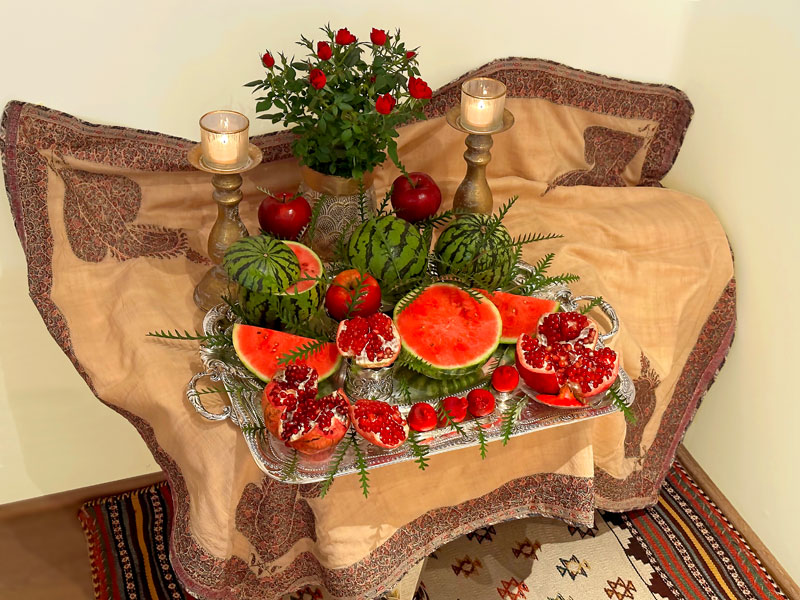
This second compact sofreh re-emphasizes the importance of the shades of red for the celebrations of Shab-e Yalda. It includes a pot of red miniature roses and an attractive display of red fruits, presented on an antique silver-plated tray atop an antique Persian textile in silk, with traditional motifs and border. The arrangement sits on an antique Afshar kilim and is softly illuminated with the flames of a pair of tea lights, presented in attractive glass holders.
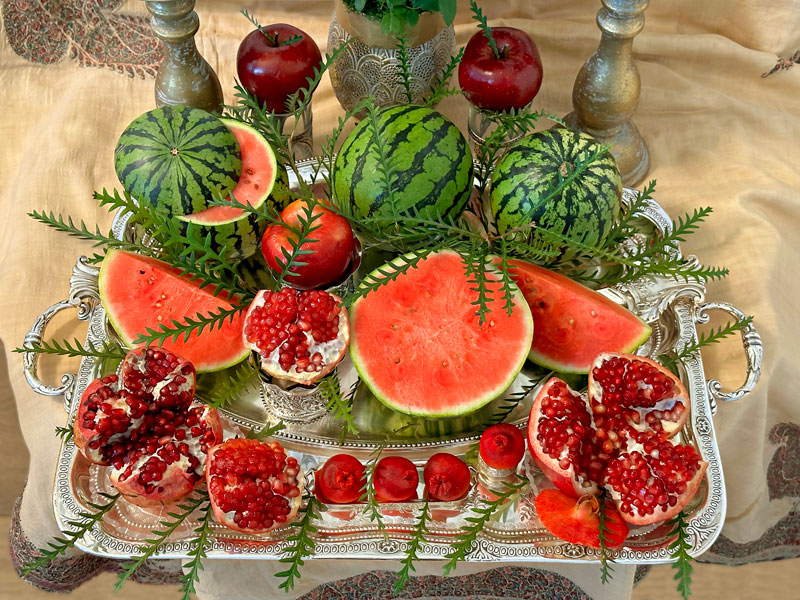
The focus of this image is the impressive display of red fruits which sits at the heart of the sofreh for the celebrations of Shab-e Yalda. Red fruits are important components of the traditions of Shab-e Yalda, heralding the crimson hues of sunrise after absolute darkness, and the promise of longer days ahead. Shiny red apples, miniature whole and cut watermelons, sculptured and fresh open pomegranates, all embellished with sprigs of foliage, are on display.
Echoes of Persian Sofrehs, November 2024
For November 2024 two compact arrangements, which allude to Persian sofrehs, were designed. The first arrangement has a muted-gold backdrop, whereas the second one boasts a vibrant colour scheme.

This is the left corner of the first sofreh. An original antique decorative object graces this corner, comprising a bronze frame holding a mirror, an opaline vase showcasing ornamental pomegranates and sprigs of ivy, and a miniature vessel, which holds the gilded coins. The reflection of the flame of the pillar candle and its holder in the mirror is enchanting. A pair of stylized ceramic birds represents the married couple.
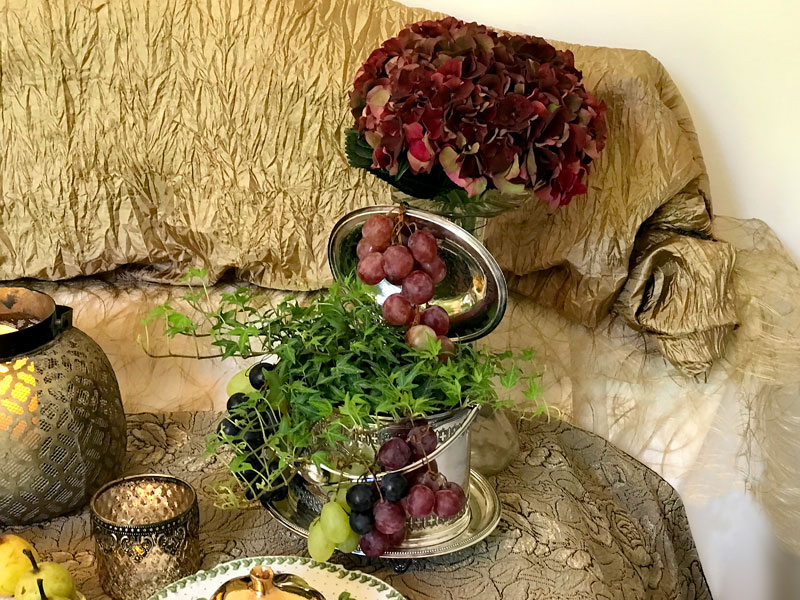
This is the right corner of the first sofreh. An antique silver-plated biscuit barrel holds a delightful type of trailing ivy with delicate leaves, and several varieties and shades of grapes gracefully hang from the biscuit barrel's lid and handle. A single, oversized deep-red hydrangea complements the red tones of the grapes. The rays of light emanating from the central candle and tea light softly illuminate this corner.
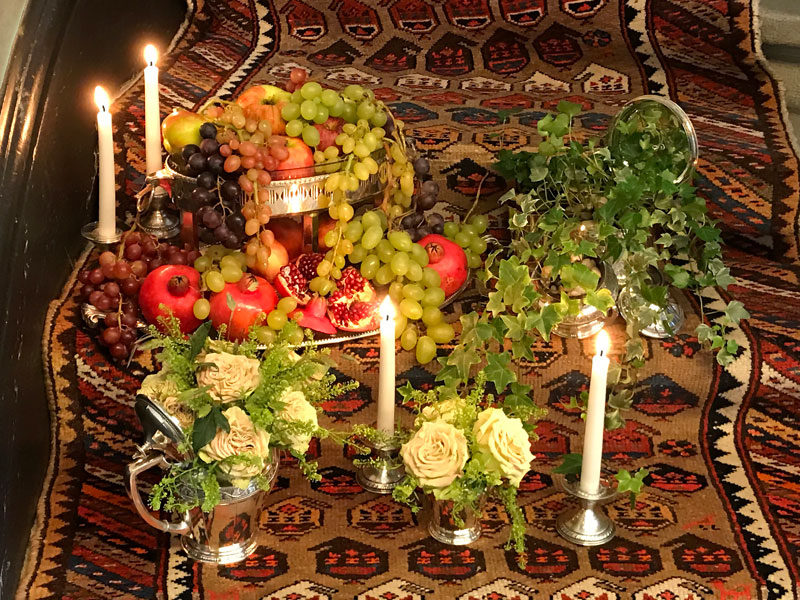
This is the overall view of the second arrangement, which boasts a vibrant colour scheme. An antique Persian tribal rug with a stylized paisley (boteh) design covers the staircase, the backdrop to this original arrangement. To bring light into the short and dark days of November, this sofreh includes an impressive display of colourful fruits. Antique silver-plated containers house pots of trailing ivy and bouquets of roses and fine foliage. The composition is softly illuminated with two pairs of candles.

This is the focal point of the second sofreh. An impressive display of colourful autumnal fruits, showcased in an elegant two-tiered antique silver-plated and crystal vessel and on an antique silver-plated tray, includes a spectacular variety of gracefully hanging grapes in different colours. Shiny whole and open pomegranates and a variety of apples are on display. These latter fruits are both symbols of life and fertility. A pair of candles softly illuminates this striking and colourful fruit arrangement.
Sofreh & Staircase
In September 2024, once again, the staircase of a late 19th-century building acts as a backdrop to two arrangements, which allude to a Persian marriage sofreh (sofreh-ye aqd). Two impressive, almost identical, bouquets of mainly Pompon ranunculi and foliage, inspired their creation. However, they have very different appearances and spirits, due to their contrasting colour schemes.
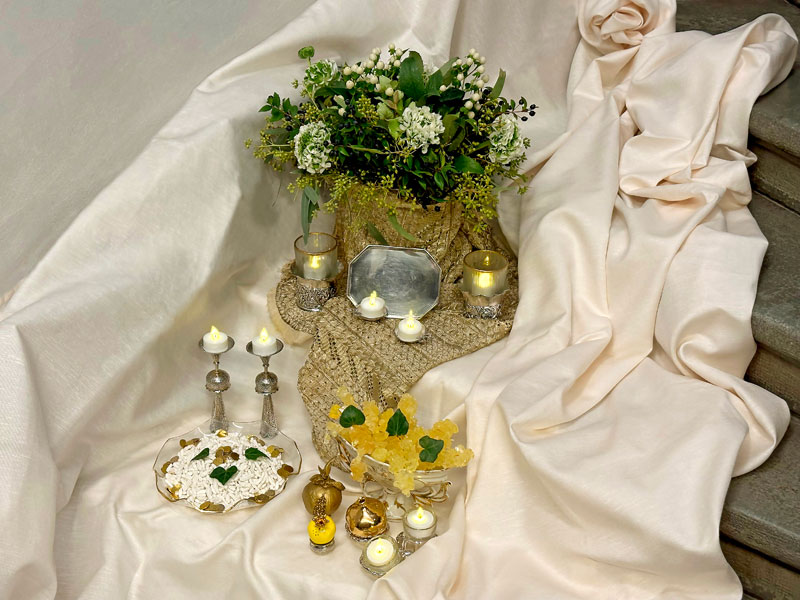
This is the overall view of the first sofreh-ye aqd, which has a soft and subtle colour scheme, showcasing ivory and muted-gold tones. The compact sofreh includes several of the symbolic elements of the sofreh-ye aqd, namely a mirror (a symbol of light and reflection), a number of tea lights (presented in a variety of elegant holders), Persian sugared almonds (noql), crystal sugar (nabat), gilded coins (sekkeh), and sculptured pomegranates (a symbol of fertility).
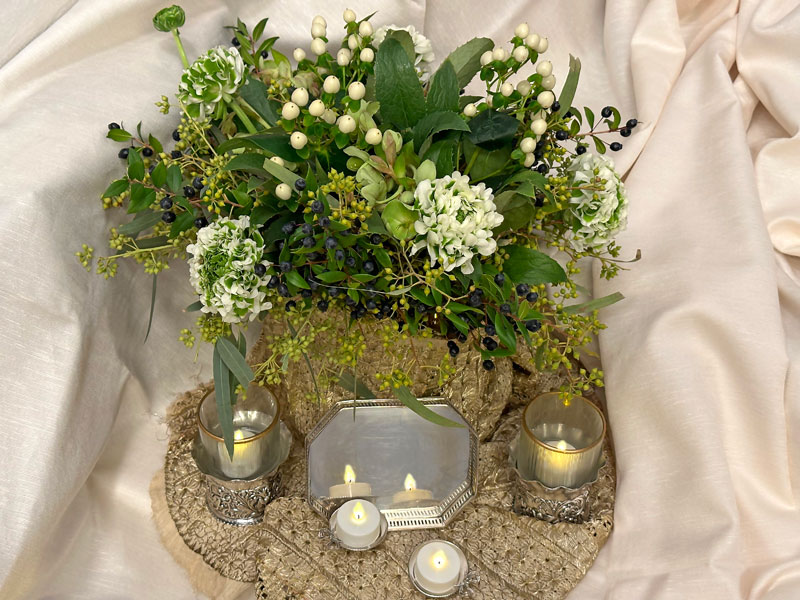
This is the heart of the sofreh, inspired by this splendid bouquet of Pompon Igloo ranunculi, Coco Uno Hypericums, Helleborus argutifolius, Eucalyptus exotica and Myrtus, elegantly wrapped in a length of antique Indian silk with metallic-gold threads. This central section is illuminated with the flames of two pairs of tea lights, placed in elegant holders. A miniature silver-plated tray acts as a mirror, showcasing the reflections of the two central flames.
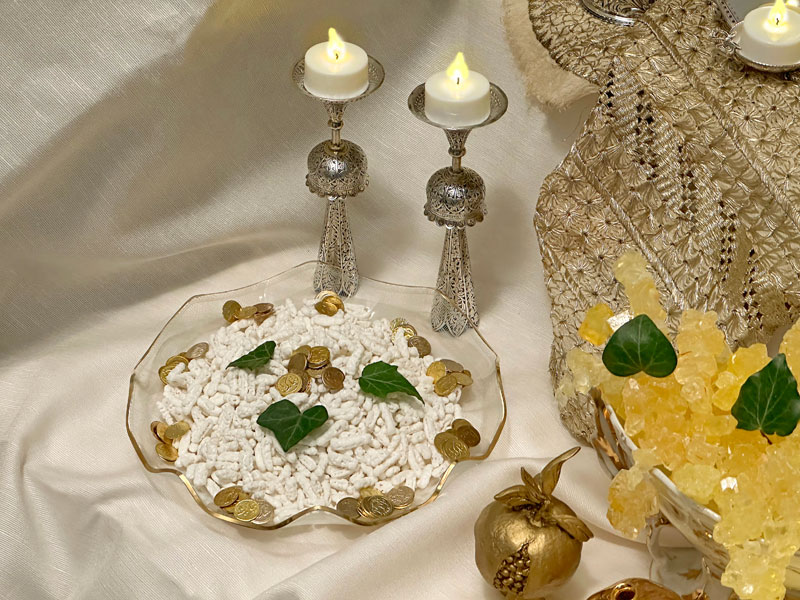
This is the left side of the sofreh. A delicate, gold-rimmed antique glass vessel contains the Persian sugared almonds (noql), a symbol of sweetness and harmony, and gilded coins, a symbol of wealth and prosperity. To this beautiful white and gold is added a touch of green, thanks to a few ivy leaves. A pair of tea lights, presented in delicate antique Persian silver holders, softly illuminates this section, which includes a segment of the antique Indian silk.
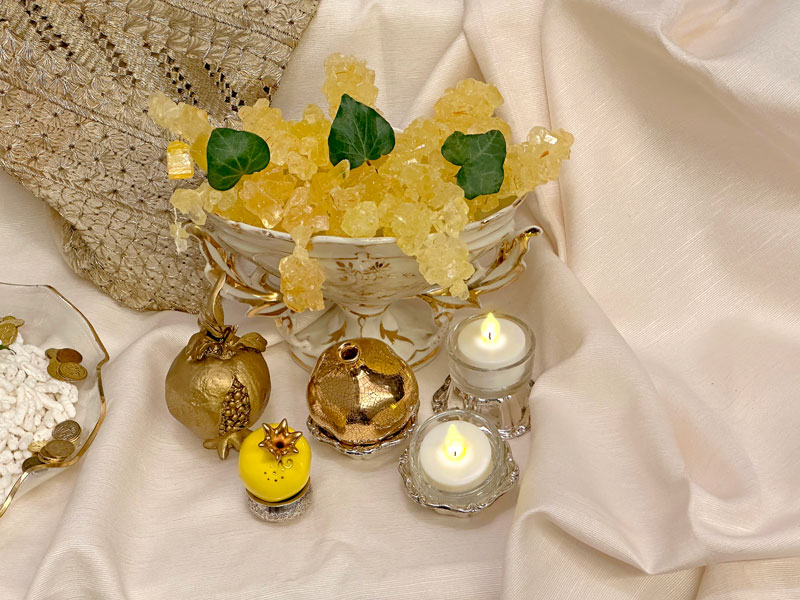
This is the right side of the sofreh-ye aqd. An antique, shapely white and gold porcelain vessel contains segments of crystal sugar (shakheh nabat), which like noql is a symbol of sweetness and harmony. Three examples of sculptured miniature pomegranates, a symbol of fertility, are on display. This section is embellished with delicate leaves of trailing ivy, and softly illuminated with a pair of tea lights, presented in miniature antique silver holders.
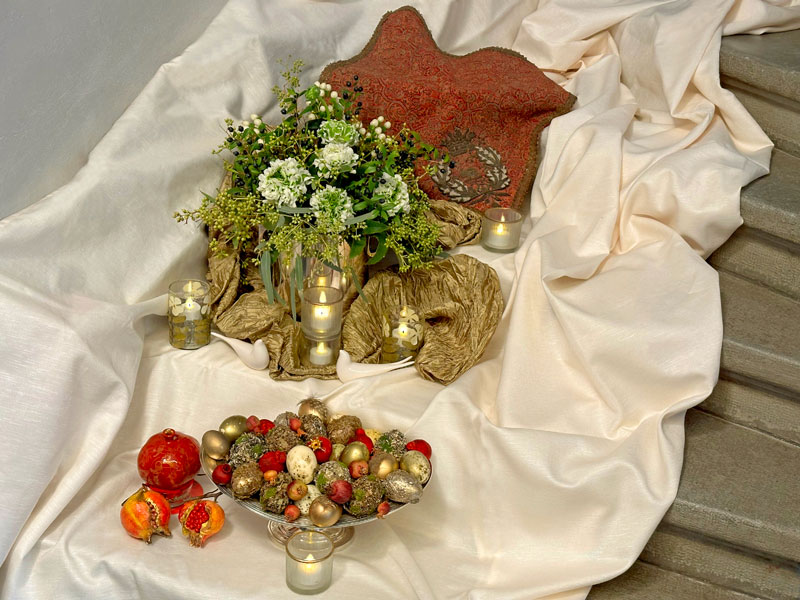
This is the overall view of the second sofreh-y aqd, which has a luminous and vibrant colour scheme, showcasing reds and soft gold tones. The compact sofreh includes several of the symbolic elements of the sofreh-ye aqd, namely tea lights (presented in elegant holders), decorated eggs and sculptured pomegranates which are symbols of fertility, and a pair of stylized ceramic birds, representing the married couple.
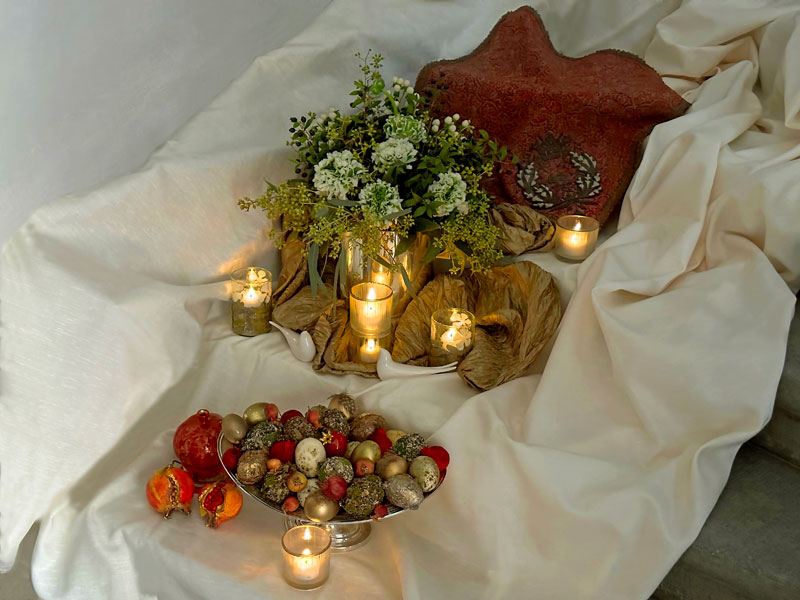
This is the overall view, taken at night, of the second sofreh, which has a luminous and vibrant colour scheme, showcasing reds and soft gold tones. The compact sofreh includes several of the symbolic elements of the sofreh-ye aqd, namely flames, decorated eggs, sculptured pomegranates and a pair of stylized ceramic birds. In the darkness of the night, the flames and their reflections create a magical ambiance.
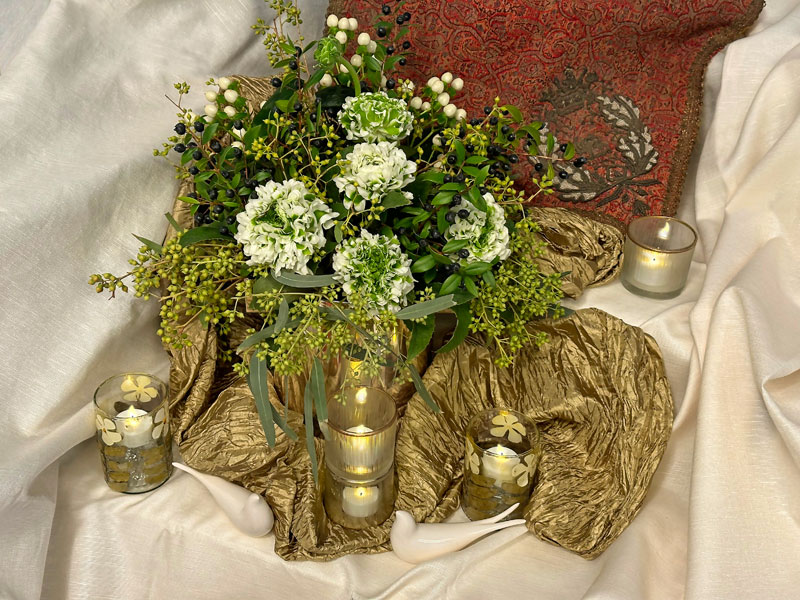
This is the heart of the second sofreh, inspired by this splendid bouquet of Pompon Igloo ranunculi, Coco Uno Hypericums, Eucalyptus exotica and Myrtus, arranged in a simple silver-plated vase, which also acts as a mirror. A length of fine ruched gold textile is elegantly woven around this section. The bouquet has a completely different appearance against a backdrop of a length of red antique Persian textile. This central section is softly illuminated with the flames of several tea lights, some of which are gently reflected in the vase.
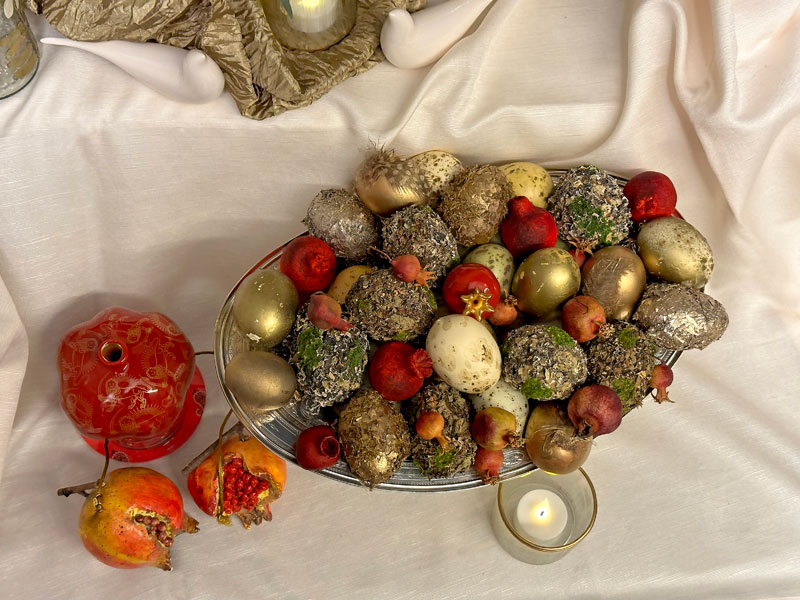
This is the lower part of the sofreh-ye aqd. An antique silver vessel contains a variety of tastefully decorated eggs in gold and green tones, and dried ornamental and miniature sculptured pomegranates. The beauty of the ensemble is enhanced by the bright red ceramic pomegranate, which is the work of Keyvan Fehri, and two sculptured open pomegranates, revealing the pomegranate seeds. A tea light, presented in an elegant holder, illuminates this colourful and vibrant section. Both eggs and pomegranates are symbols of fertility.
Echoes of Sofreh-ye aqd, August 2024
For August 2024 two contrasting arrangements, echoing the Persian marriage sofreh (sofreh-ye aqd), were designed. The first sofreh, which features fine antique lace, is harmonious and has a subtle and soft colour scheme. The second sofreh, which showcases antique Persian textiles, is intense and vibrant, and features the “lion and sun” (“shir o khorshid”) emblem on several of its components.
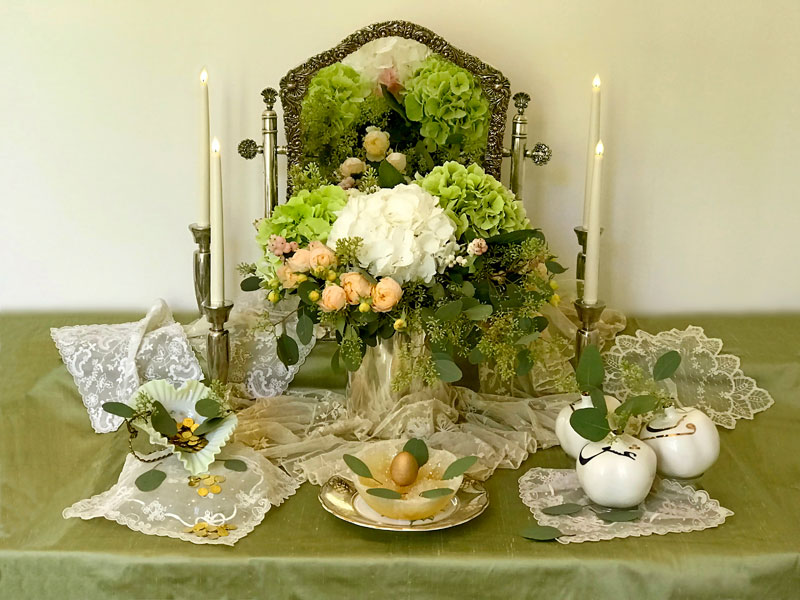
This is the overall view of the first sofreh, which was inspired by the juxtaposition of a bouquet of pastel hydrangeas, roses and foliage, and fine antique lace. It includes a few of the symbolic elements of the sofreh-ye aqd, namely a mirror, candelabra, gilded coins, crystal sugar, sculptured pomegranates and a single gold-tinted egg. The sofreh is embellished with sprigs of Eucalyptus populus and illuminated with two pairs of candles.
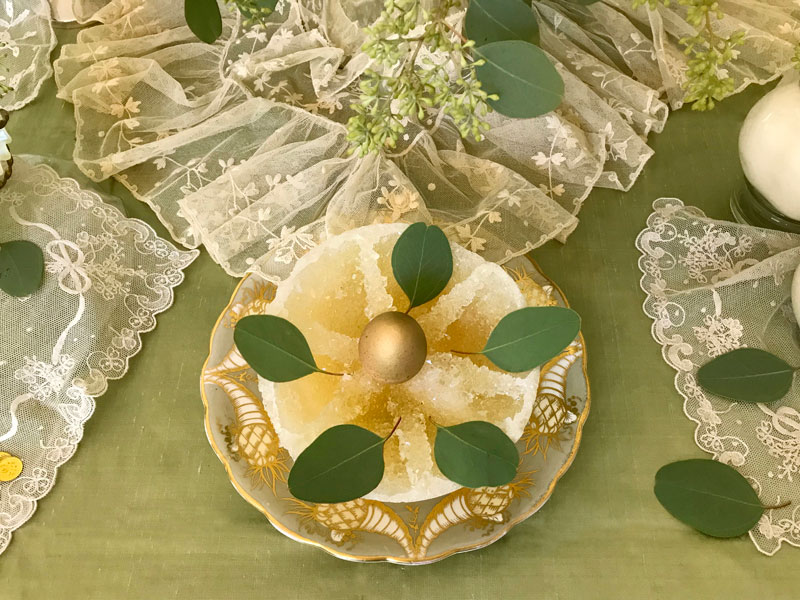
This central section of the sofreh-ye aqd focuses on an attractive antique plate showcasing crystal sugar in the form of a bowl (kaseh nabat) and decorated with a single gold-tinted egg. Crystal sugar is a symbol of sweetness and harmony, and eggs represent fertility. This miniature composition of kaseh nabat and fine antique lace, embellished with sprigs and leaves of Eucalyptus populus, is exquisite in its simplicity and harmony.
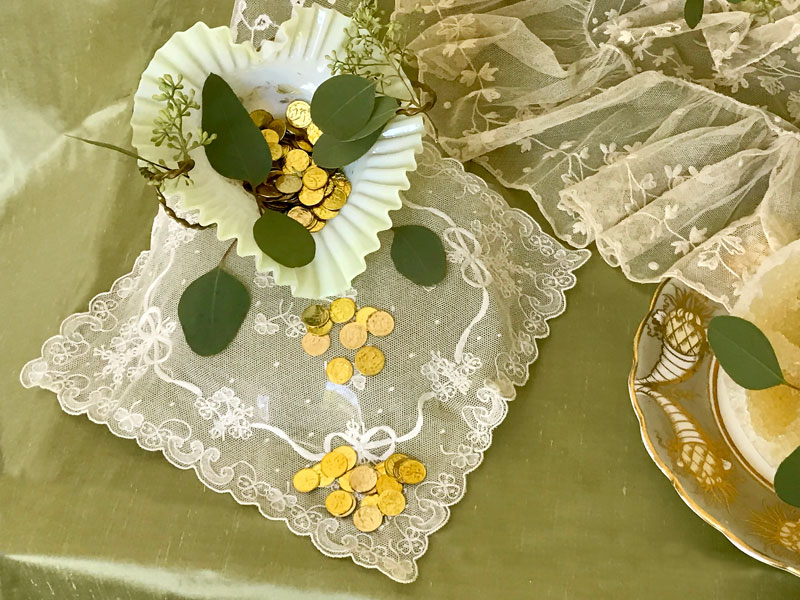
This corner of the sofreh focuses on an antique opaline vessel of gilded coins, a symbol of prosperity. The coins are inscribed with “mobarak bad”, which translates as “congratulations”. The combination of antique lace, the ruffled edge of the opaline container and the shine and glow of the gilded coins is delightful. This section is embellished with sprigs and leaves of Eucalyptus populus.
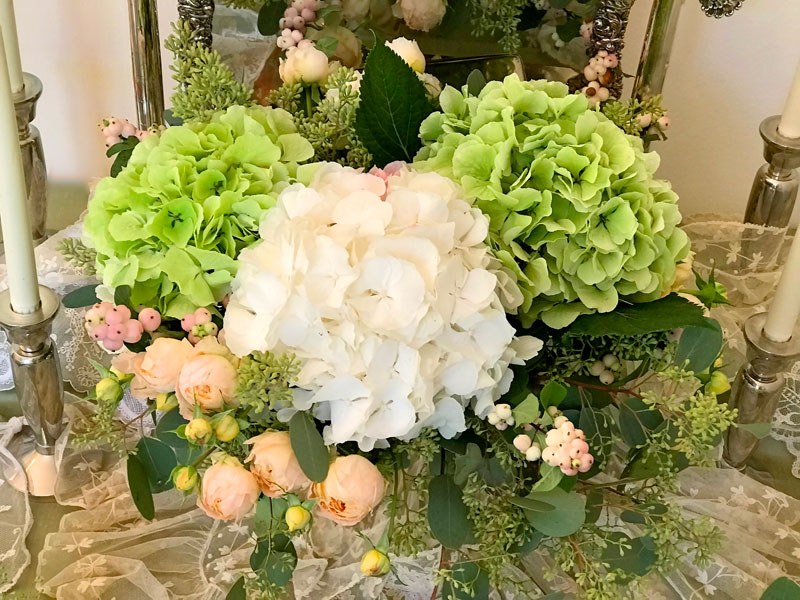
At the heart of the sofreh-ye aqd sits this spectacular pastel bouquet of White Verena and Verena Classic hydrangeas, delicate Princess Aiko (Beloved), which are Japanese spray roses bred for the Empress, Symphoricarpos (snowberries) and Eucalyptus populus. The reflection of the bouquet in the mirror, and its placement on lengths of fine antique lace in soft ivory shades, create an exquisite ensemble.
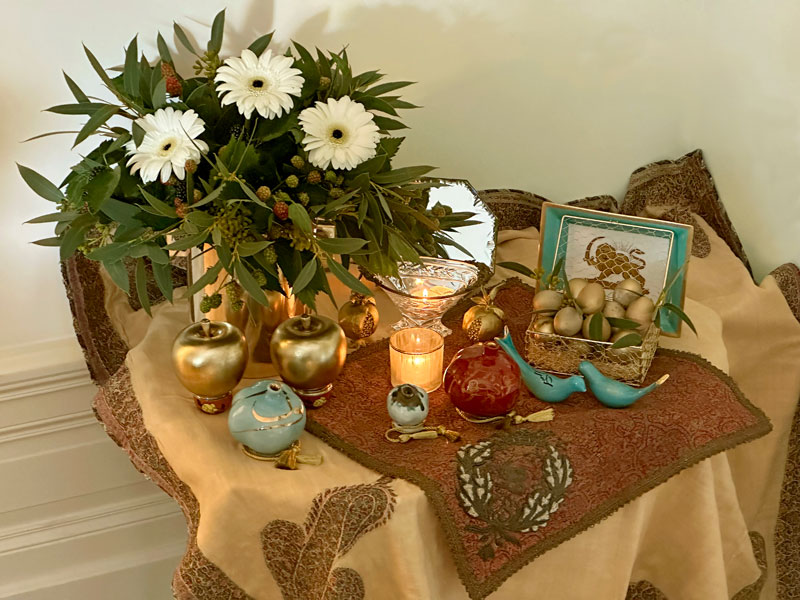
This is the overall view of the second sofreh, which was inspired by a spectacular bouquet of special and interesting foliage and just three gerberas. This sofreh also includes several of the symbolic elements of the sofreh-ye aqd. A mirror, tea lights, sculptured apples, pomegranates and birds, as well as decorated eggs, all presented on antique Persian textiles, are on display. The significant “lion and sun” (“shir o khorshid”) emblem appears on several components of this lavish sofreh.
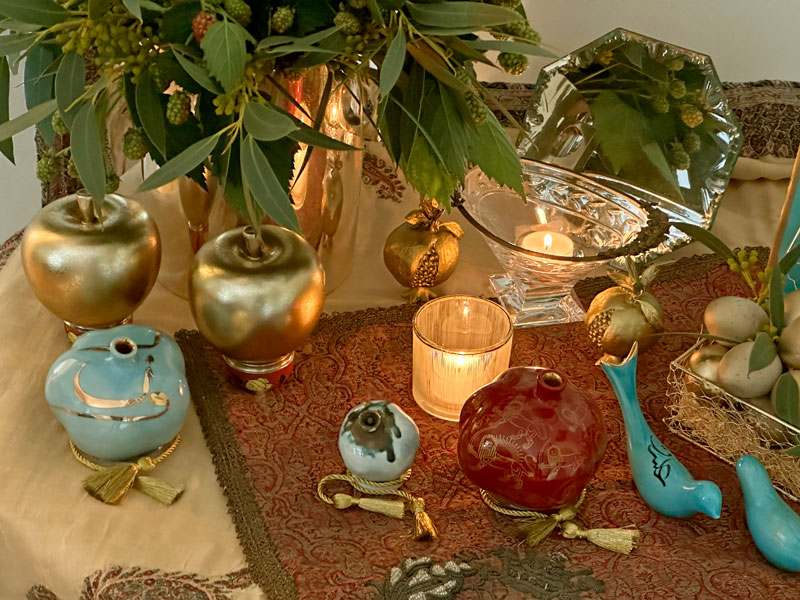
This corner of the sofreh-ye aqd focuses on stylized, gold-finish sculptured apples and sculptured whole and gold-finish open pomegranates—both of which are symbols of fertility. A Venetian mirror and just two tea lights presented in elegant holders are on display. Two layers of antique Persian textiles offer a rich and opulent backdrop. In this section, which is embellished with fine gold tassels, there are stunning reflections of the foliage in the mirror and the tea lights in the silver-plated vase.
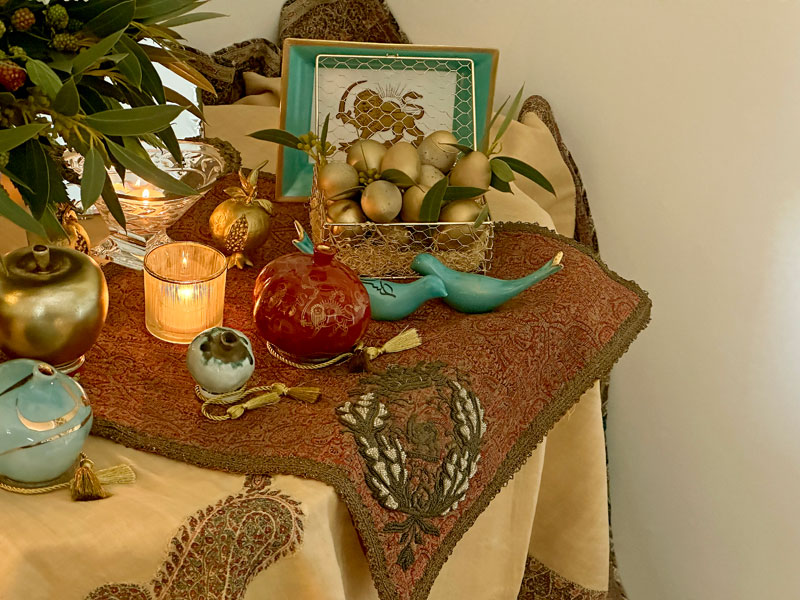
This corner of the sofreh-ye aqd showcases a delicate open box, containing gold-tinted eggs, a symbol of fertility. A pair of stylized ceramic birds represents the couple. The section is made very distinctive by the “lion and sun” (“shir o khorshid”) emblem, with its many significations in the Persian history and culture. The emblem is featured in the centre of a hand-painted porcelain container with a gold and turquoise border, on a red ceramic pomegranate, and on an antique Persian textile, known as termeh. Flames of tea lights subtly illuminate this section.
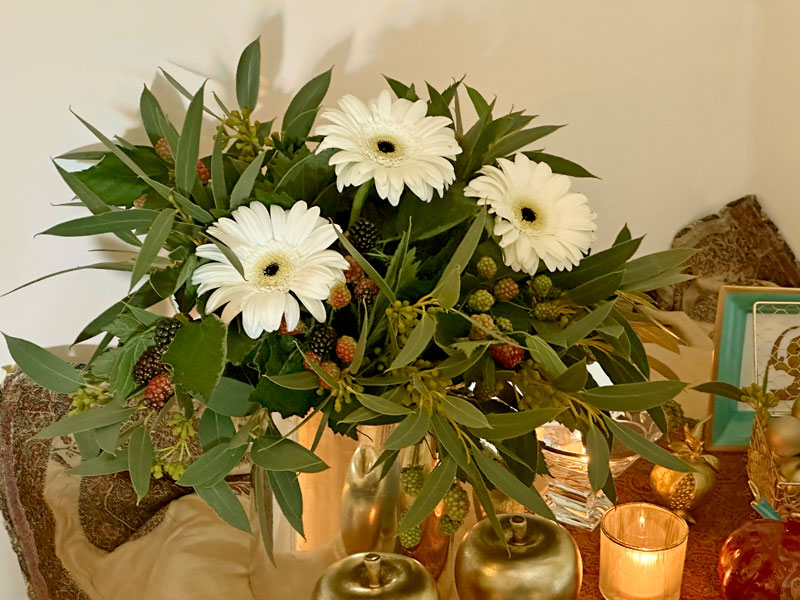
This spectacular bouquet of interesting and distinctive foliage, namely Eucalyptus dominichina and a type of thornless Rubus (blackberry), which is in the rose family, and just three truly striking cream gerberas with black pistils was the inspiration for creating this enchanting sofreh-ye aqd. The alluring colour scheme of the bouquet complements the tones and shades of the layers of fine antique Persian textiles and various symbolic elements presented on the sofreh, which are softly illuminated with the flames of a single pair of tea lights, placed in elegant holders.
Sofreh-ye aqd Highlights, June 2024
For the wedding season of 2024, a selection of elaborate marriage sofrehs (sofreh-ye aqd) either featured in the book SOFREH: The Art of Persian Celebration or on its social media pages and this website is being presented. Eight different designs of sofreh, with varying styles and energies, are shown. They are intended to provide a wide range of ideas and concepts.
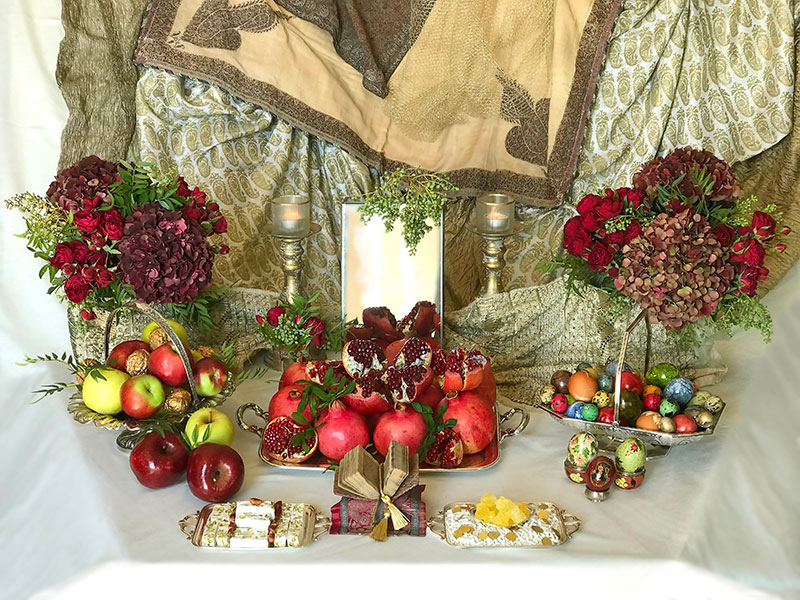
This first sofreh, entitled “Sofreh-ye aqd & Shab-e Yalda”, was inspired by the traditions of the winter solstice (Shab-e Yalda)—around 21 December. Pomegranates are important components of the customs of Shab-e Yalda. The striking sofreh was featured on the social media of the book and this website in December 2022. To learn more about this sofreh and see the close-up of its sections and details, please go to the NEWS & EVENTS page, and to order a copy of the book go to THE BOOK page.
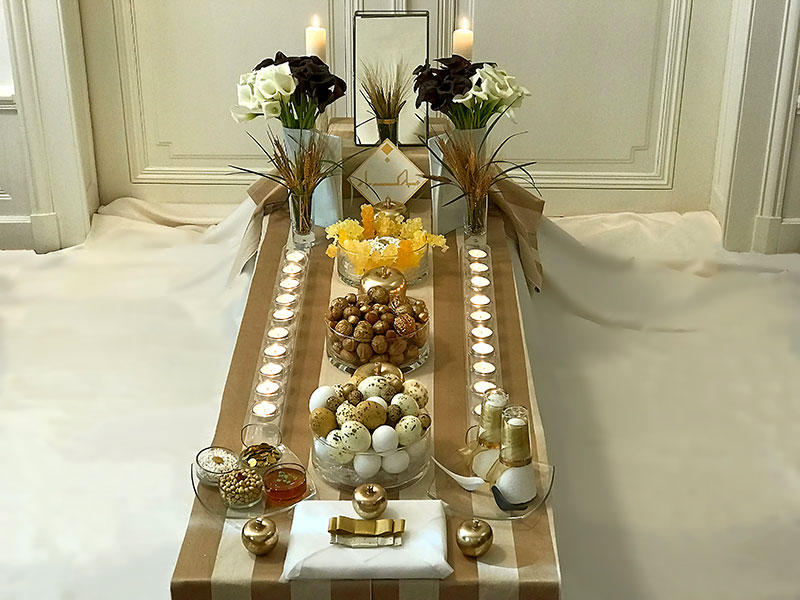
This second sofreh, which was featured on the social media of the book and this website in June/July 2022, was inspired by the “Gold and Glass” sofreh, staged for photography in Vancouver, Canada in 2002, and included in the book. Both creations showcase an effective fusion of tradition and modernity. To learn more about this sofreh and see the close-up of its sections and details, please go to the NEWS & EVENTS page, and to order a copy of the book go to THE BOOK page.
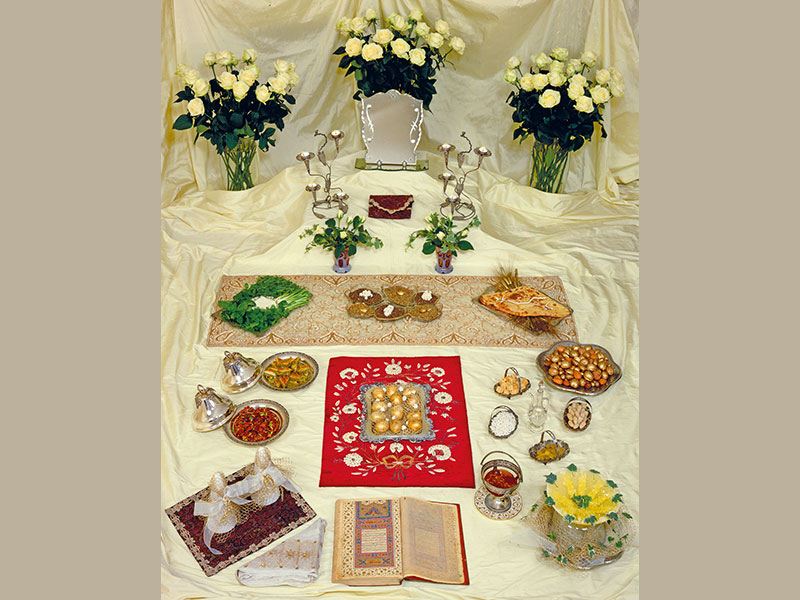
This third sofreh, entitled “Ivory Roses, Red Velvet”, was staged for photography in 2001, and is featured in the book. Its overall aspect is soft and harmonious, with a prominent contrasting feature of a length of bright red antique velvet, embroidered with embossed flowers and gold threads. To learn more about this sofreh and see the close-up of its sections and details, please go to THE BOOK page to order a copy of the book, which also includes many other sofrehs.
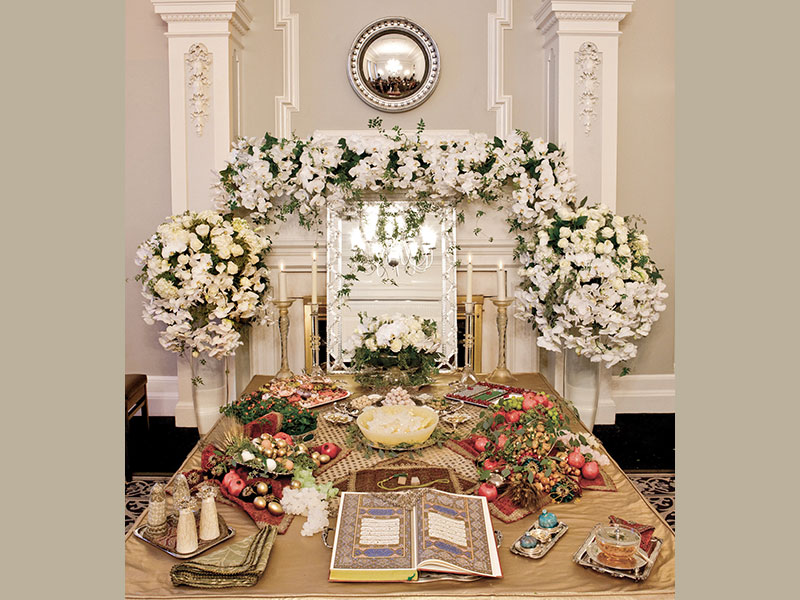
This fourth sofreh, entitled “Still Life”, was designed for a wedding in October 2011 in Vancouver, Canada, and is featured in the book. The title was given to the sofreh because of the two compositions of textiles, pomegranates, eggs, nuts, wheat, foliage etc. created on either side of the sofreh. To learn more about this sofreh and see the close-up of its sections and details, please go to THE BOOK page to order a copy of the book, which also includes many other sofrehs.
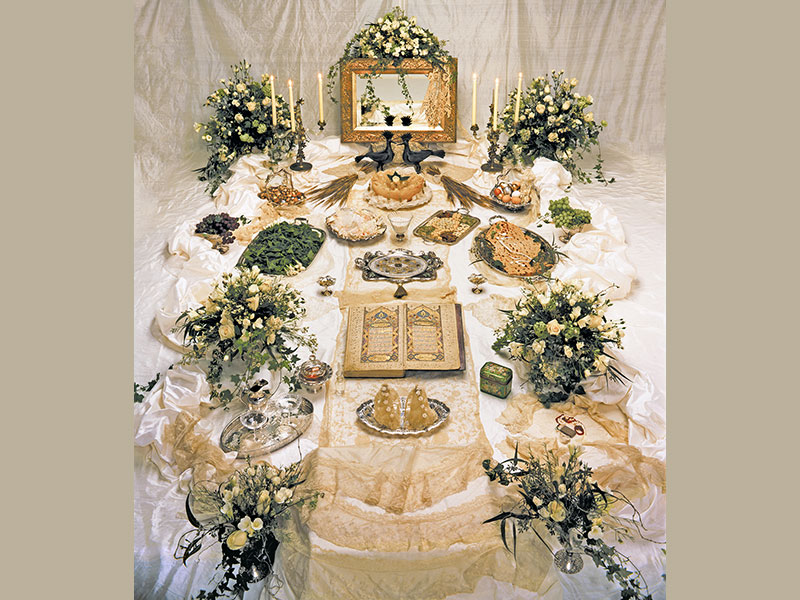
This fifth sofreh, entitled “Antique Lace”, was staged for photography in 2002, and is featured in the book. This is a serene and “fairy-tale like” arrangement, richly embellished with lengths of antique lace and multiple bouquets of white and cream flowers and variegated foliage. The floral displays complement the intricacy of the delicate antique lace. To learn more about this sofreh and see the close-up of its sections and details, please go to THE BOOK page to order a copy of the book, which also includes many other sofrehs.
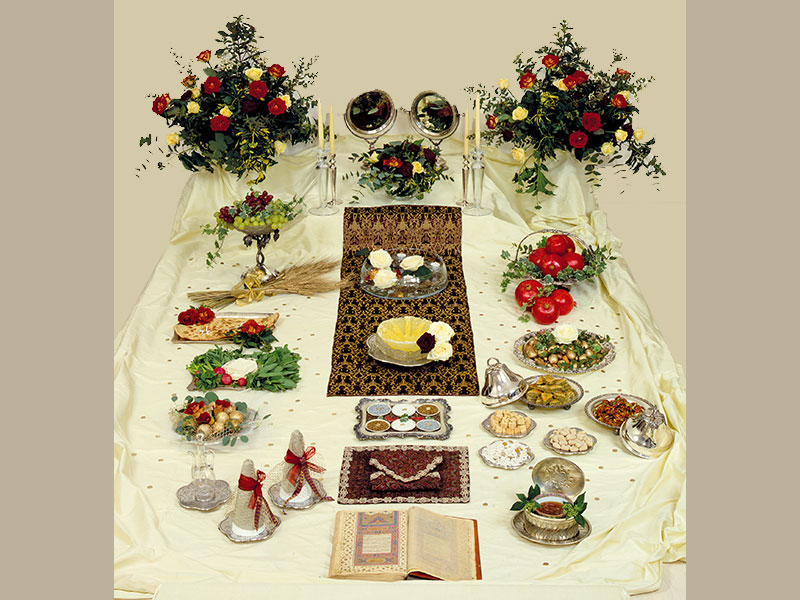
This sixth sofreh, entitled “Double Reflection, Red and Gold Velvet”, was staged for photography in 2001, and is featured in the book. Unusually, the sofreh includes a pair of mirrors and its distinguishing feature is the 19th-century Qajar cut and voided figural silk velvet runner. The beauty of pomegranates and grapes is fully exploited here. To learn more about this sofreh and see the close-up of its sections and details, please go to THE BOOK page to order a copy of the book, which also includes many other sofrehs.
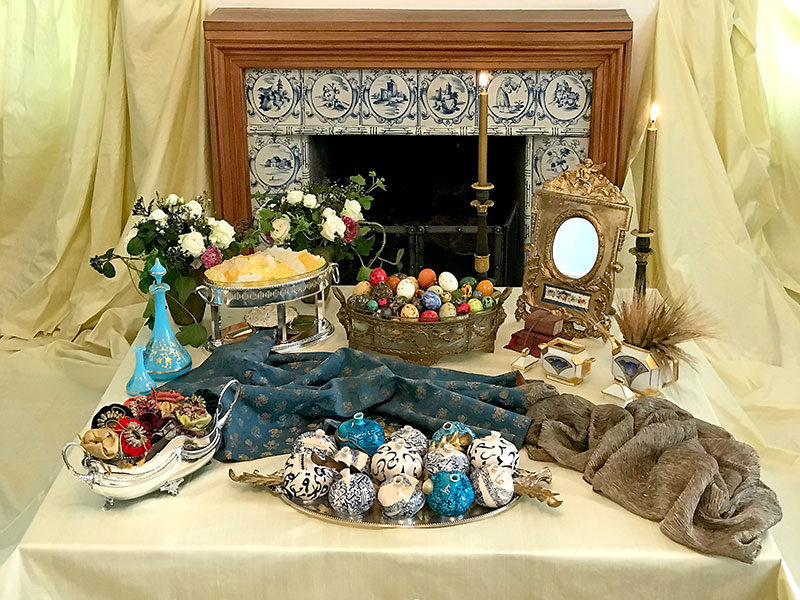
This seventh sofreh, entitled “Blue White Gold”, was featured on the social media of the book and this website in June 2021. Its distinguishing feature is the exquisite antique Persian brocade in blue and gold, elegantly draped and presented in front of a blue and white mantelpiece. To learn more about this sofreh and see the close-up of its sections and details, please scroll down this page to “Blue White Gold", and to order a copy of the book go to THE BOOK page.
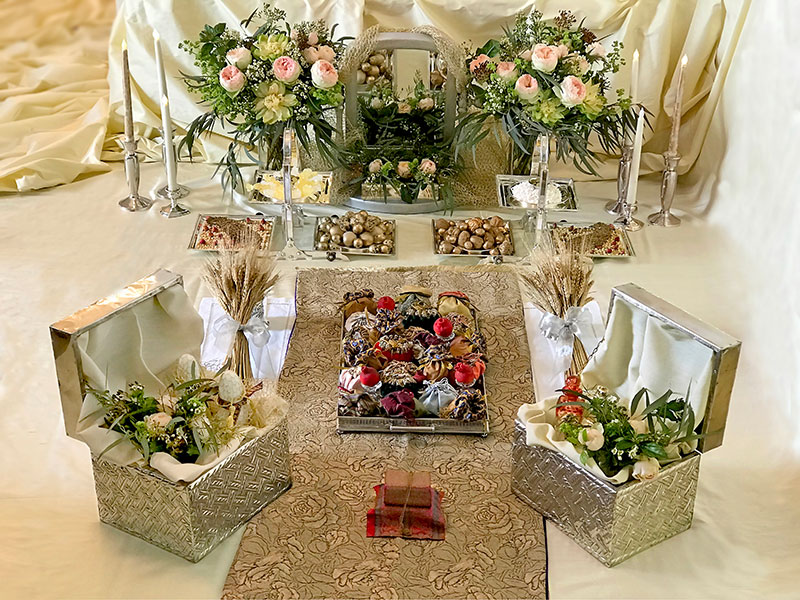
This last sofreh, which was featured on the social media of the book and this website in June/July 2023, includes a variety of original features, namely silver-plated cake stands and boxes to showcase the symbolic elements of the sofreh. The bouquets of unusual roses are incredibly impressive. To learn more about this sofreh and see the close-up of its sections and details, please go to the NEWS & EVENTS page, and to order a copy of the book go to THE BOOK page.
Boteroesque Hydrangeas
This intricate arrangement in shades of blue and gold, which was inspired by a splendid bouquet of Boteroesque hydrangeas and foliage, echoes a Persian marriage sofreh (sofreh-ye aqd). The sofreh is created against a backdrop of an exquisite antique Persian brocade in blue and gold.
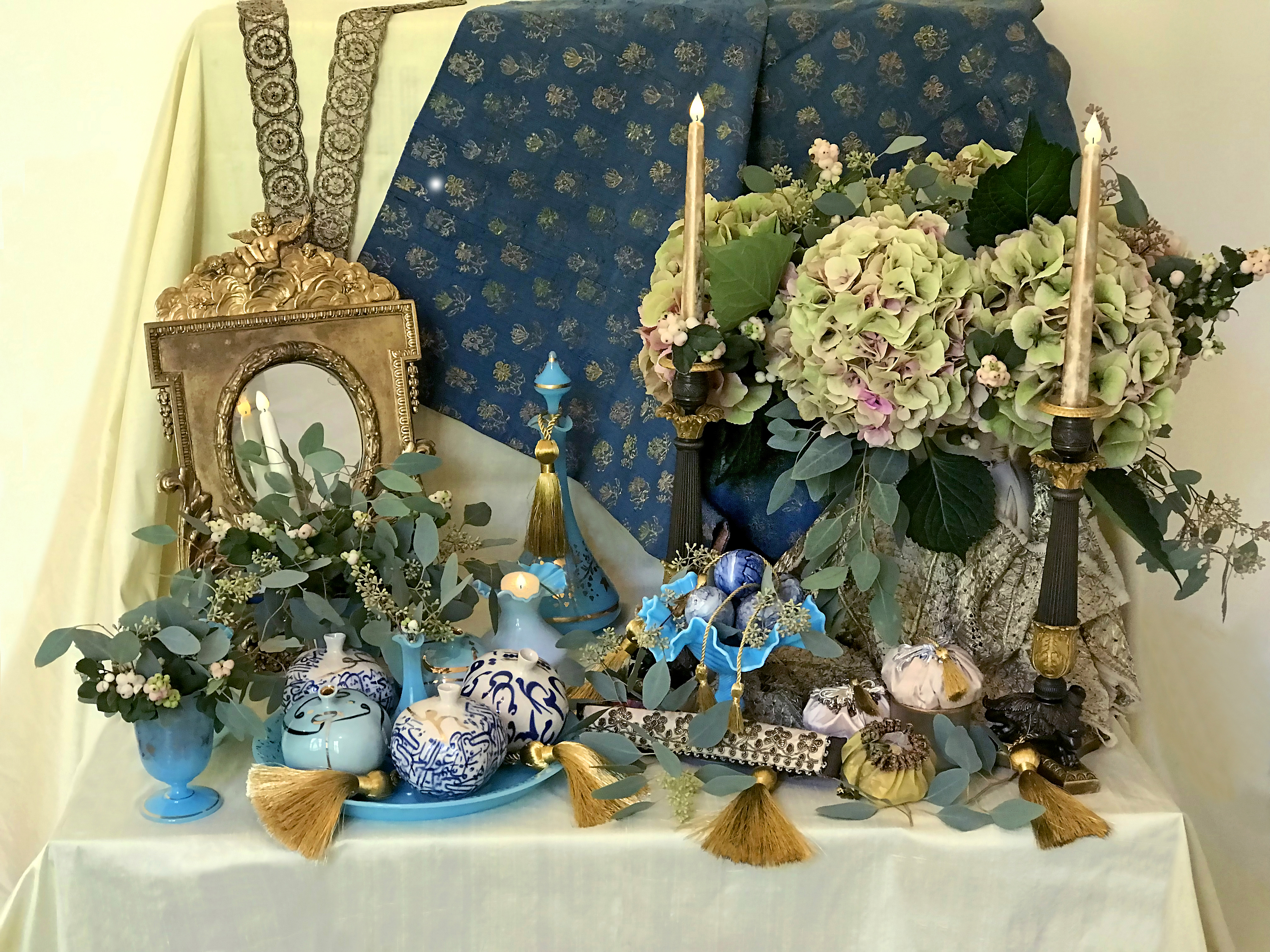
This is the overall view of the sofreh which includes some of the symbolic elements of the sofreh-ye aqd, namely a mirror, candelabra, pomegranates, decorated eggs, flasks of rosewater and handmade bonbonnières in the Persian spirit. The sofreh showcases bouquets of Eucalyptus populus and snowberries, is illuminated with several flames and is embellished with fine gold trims and tassels and sprigs of Eucalyptus populus.
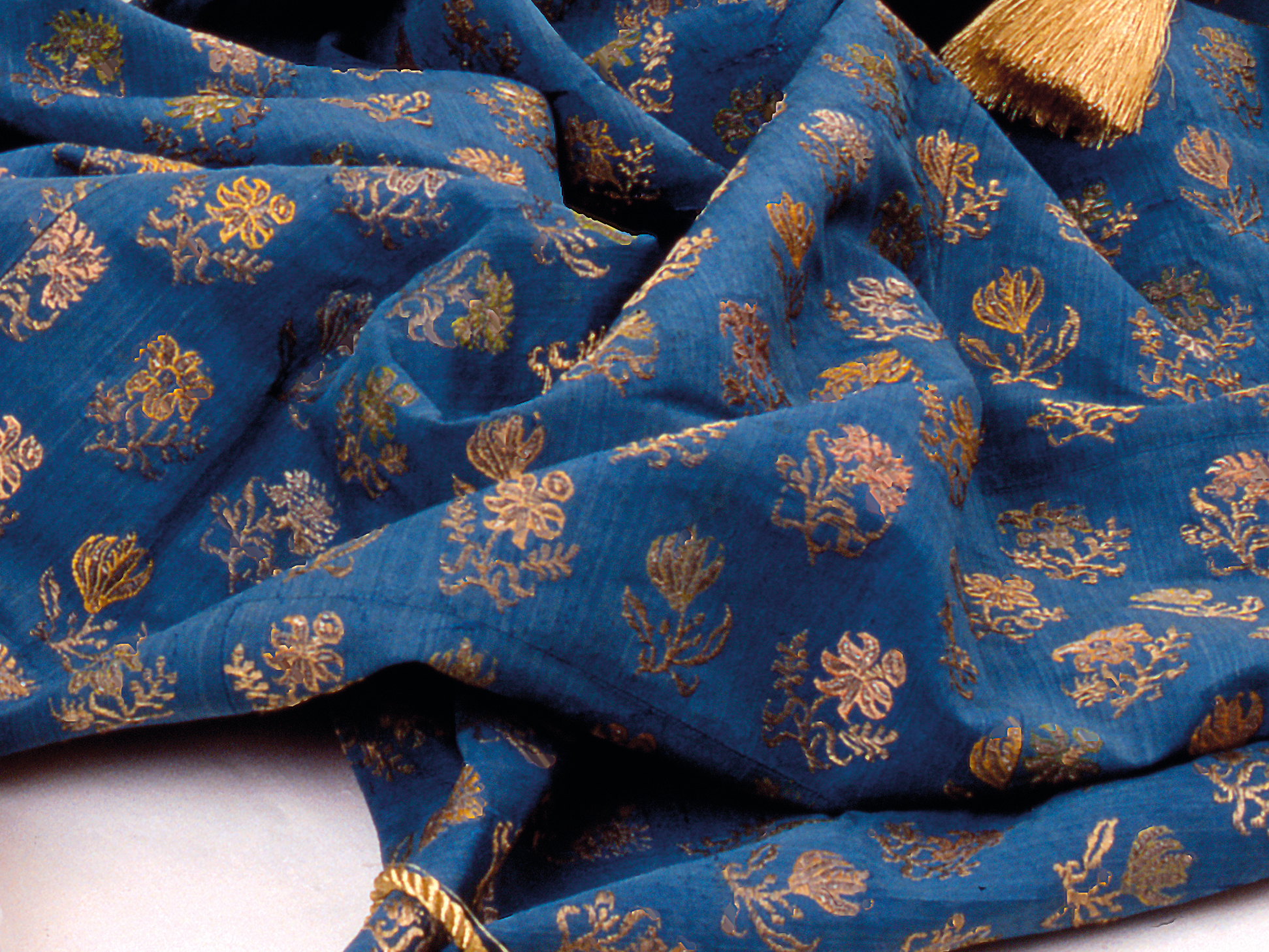
This sublime length of blue and gold antique Persian silk brocade appears in the book, in the "Blue and Gold” haft sinn, as well as in a few of the sofrehs designed after the book’s publication that have been posted on the book’s social media pages and this page and the News & Events page of the website. This opulent textile with metallic floral motifs makes for an elegant backdrop for this elaborate blue-and gold-themed sofreh.
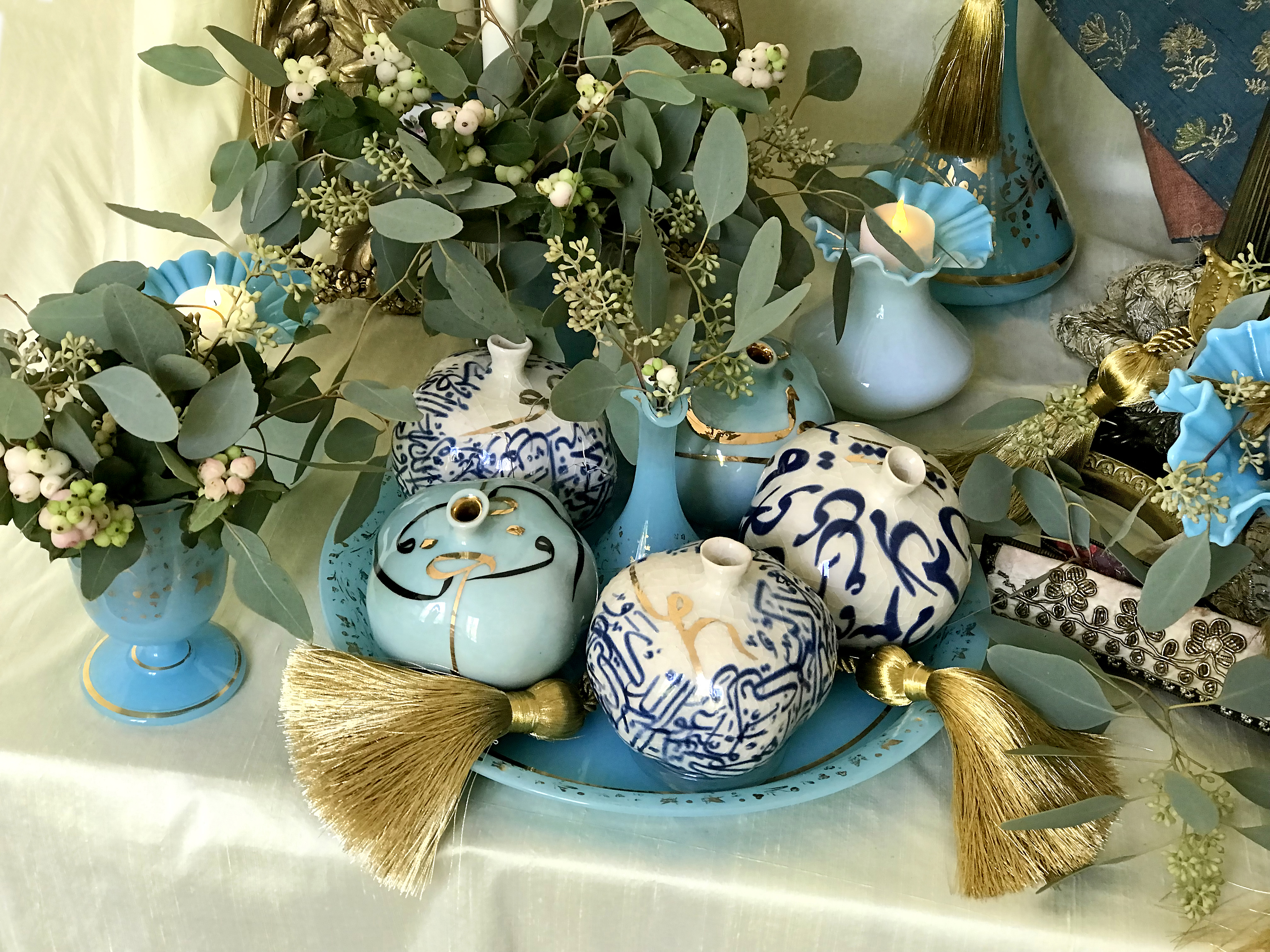
This is a corner of the sofreh-ye aqd. The focus of the image is on ceramic pomegranates (a symbol of fertility) in gold, blue and white tones, and a miniature flask of Persian rosewater (golab) to perfume the air. All the vessels included are blue opaline. This section, decorated with elegant bouquets of Eucalyptus populus and snowberries (Symphoricarpos), is embellished with fine gold tassels and illuminated with the flames of a pair of tea lights.
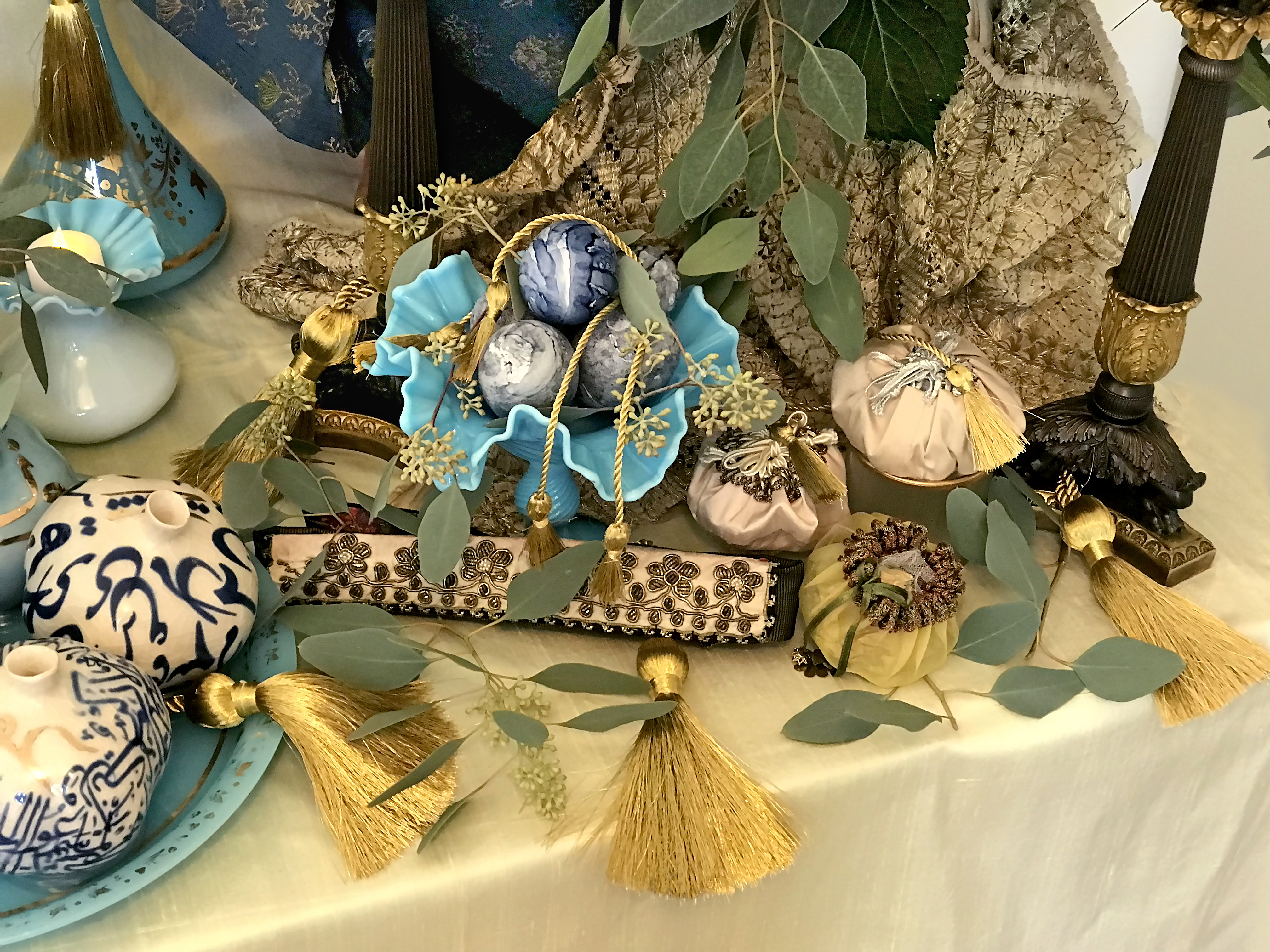
This is the front section of the sofreh. It showcases an elegant blue opaline vessel of blue-painted eggs (a symbol of fertility), and handmade bonbonnières with intricate trims, in the Persian spirit. This section, which is arranged against a backdrop of a length of draped antique Indian ivory and gold textile, is embellished with sprigs of Eucalyptus populus, fine gold tassels and a length of antique Persian embroidered trim with metallic threads, showcasing floral motifs.
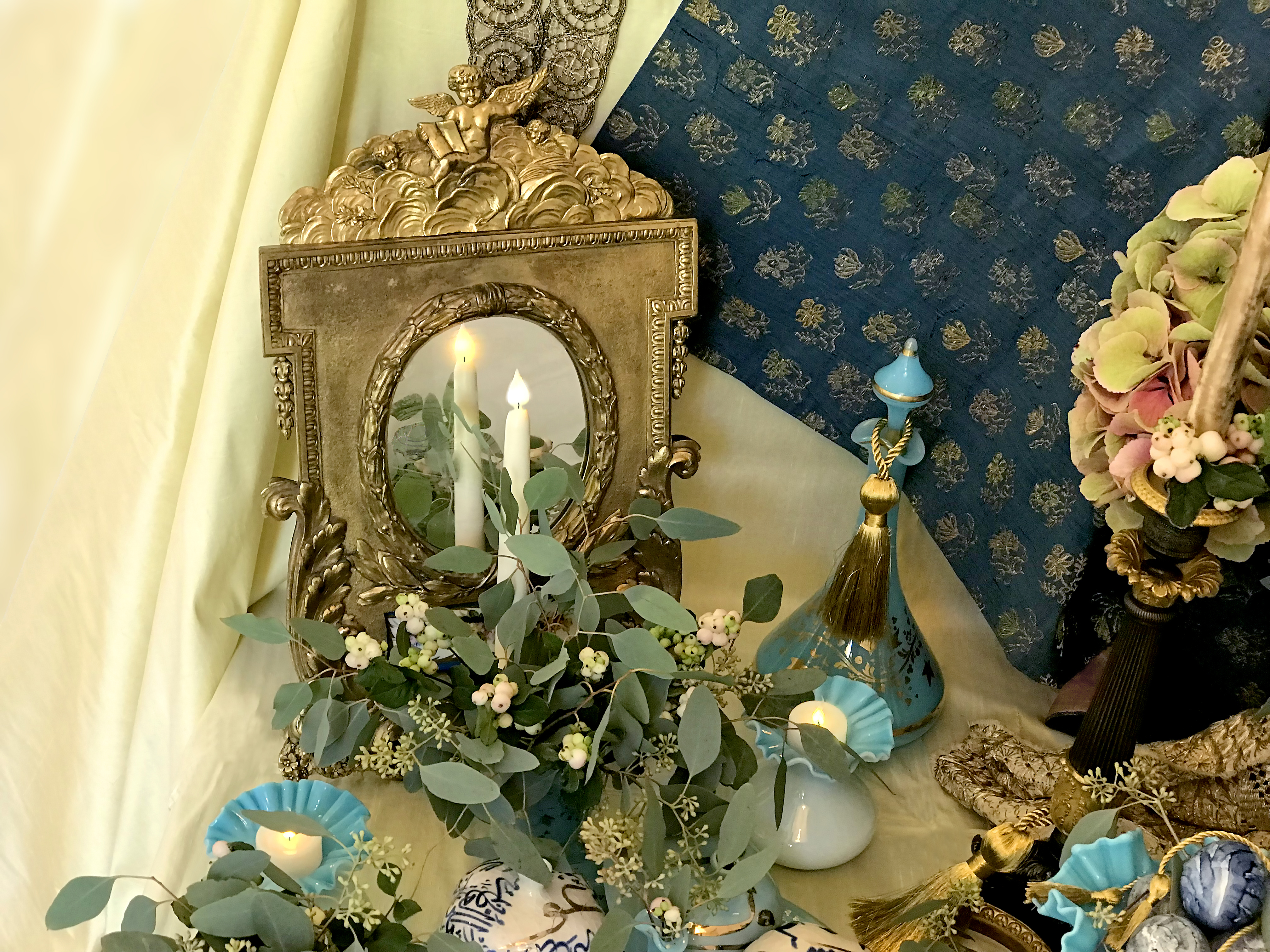
This lovely antique French mirror (ayeneh), a symbol of light and reflection, sits in the opposite corner to the bouquet of Boteroesque hydrangeas and foliage. A flame and miniature bouquets of Eucalyptus populus and snowberries are placed in front of the mirror. Their reflections, and the feeling emanating from them, are enchanting. A blue and gold antique opaline flask of rosewater, embellished with a fine gold tassel, perfumes the air. The exquisite antique Persian brocade is visible in the background.
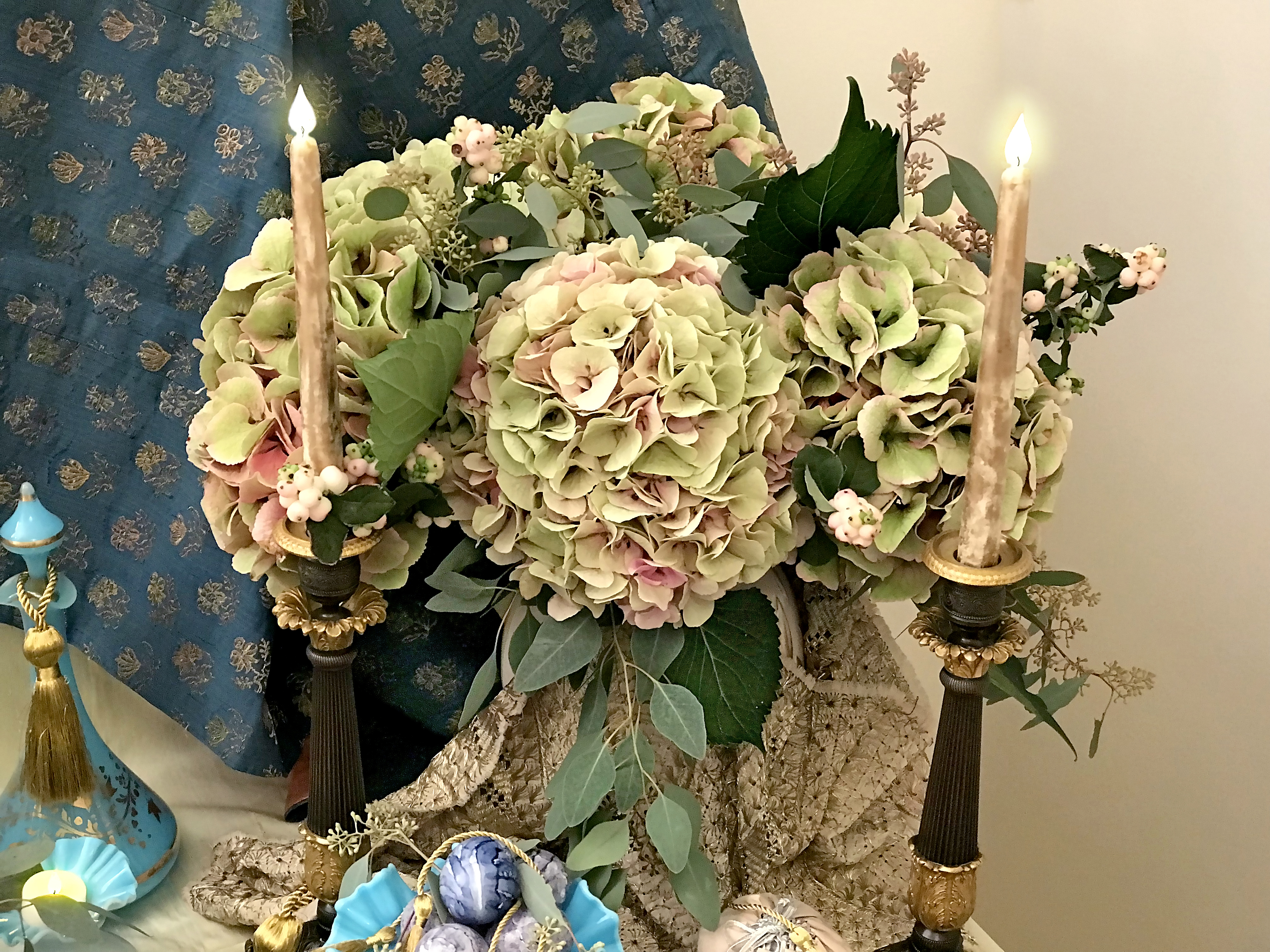
This impressive bouquet of Boteroesque hydrangeas in pastel tones of green and pink (known as Royal Love Classic), Eucalyptus populus and snowberries (Symphoricarpos) inspired the creation of this blue and gold sofreh-ye aqd. The spectacular bouquet is placed in a corner of the sofreh against the backdrop of the length of antique Persian brocade and is illuminated by the flames of a pair of candles. The large vase is elegantly draped with a length of antique Indian textile in ivory and gold.
Secret Garden Roses, April 2024
The incredible, open and ample Secret Garden roses were the inspiration for creating this soft arrangement, which alludes to a Persian marriage sofreh (sofreh-ye aqd), on and around an antique marble mantelpiece.
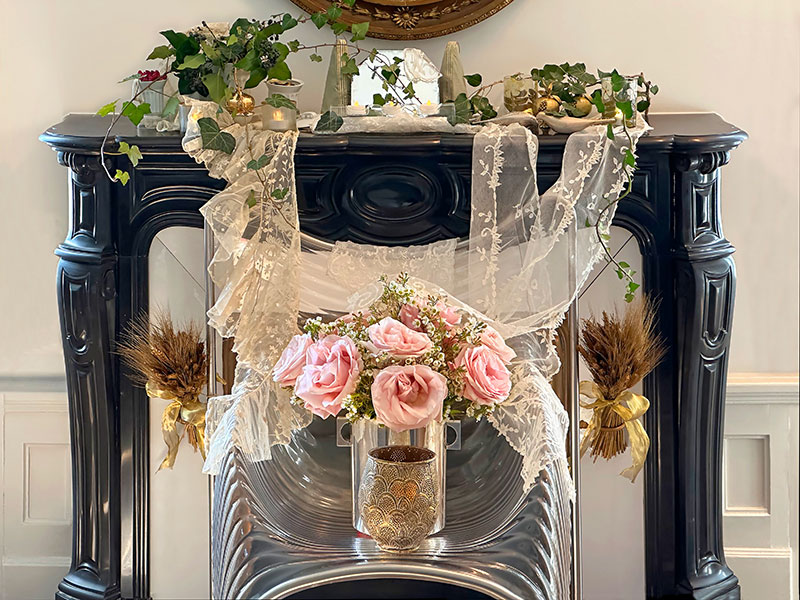
The compact sofreh includes some of the symbolic elements of the sofreh-ye aqd, namely a mirror (representing light and reflection), decorated sugarloaves (symbolizing sweetness and harmony), gilded coins (representing wealth and prosperity), sheaves of wheat (a symbol of blessing and abundance), rosebuds (to add colour and beauty), statuettes of birds (representing the couple) and pomegranates (a symbol of fertility). The sofreh is embellished with lengths of fine antique lace and branches of berried and trailing ivy and is illuminated with several flames.
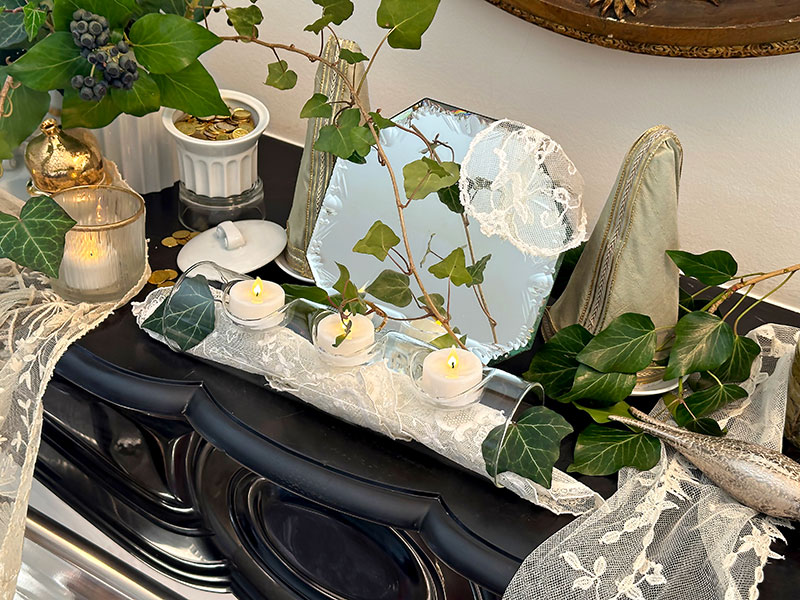
At the heart of the sofreh sits a Venetian mirror, flanked by a pair of sugarloaves, covered with green silk and fine gold ribbons. This central section is embellished with lengths of fine antique ivory lace and trailing ivy and is illuminated with the flames of several tea lights, the reflection of which in the mirror is remarkable. Decorated sugarloaves (kalleh qand) are an important part of the Persian marriage ceremony (aqd), and to this day grinding them over the heads of the newlyweds, to shower them with sweetness, is an enduring and popular practice and tradition.
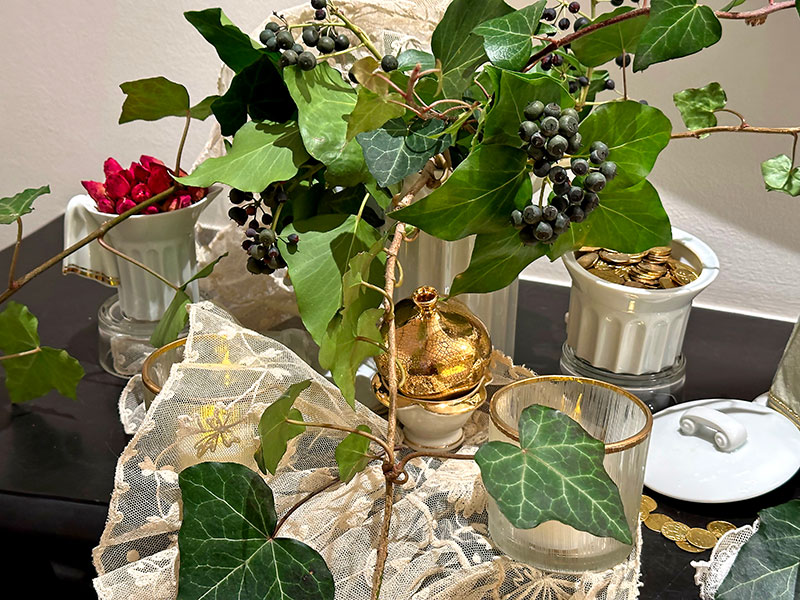
This is the left corner of the sofreh. The image focuses on attractive vessels of gilded coins (a symbol of wealth and prosperity), dried rosebuds, which add beauty and colour to the sofreh, a bouquet of berried and trailing ivies, and a miniature gold-finish ceramic pomegranate, a symbol of fertility. Lengths of fine antique lace and flames of tea lights embellish and illuminate this corner.
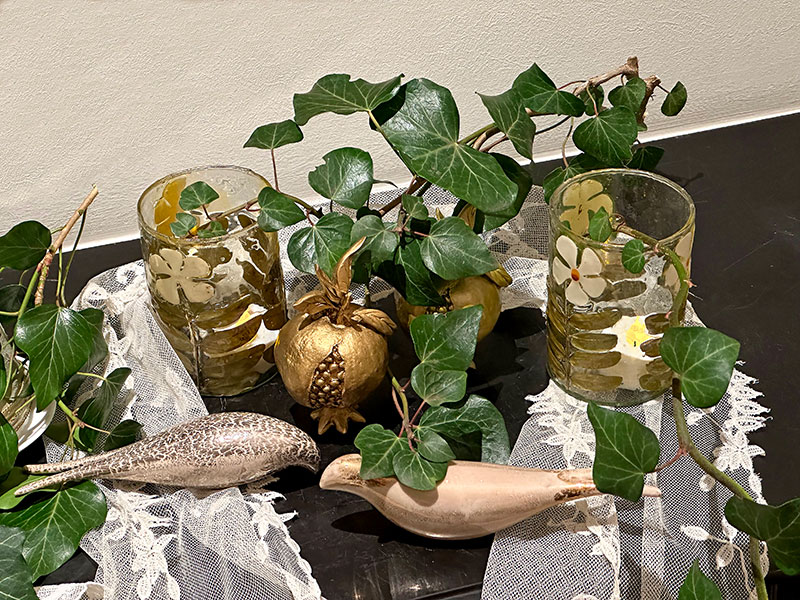
This is the right corner of the sofreh. A pair of stylized ceramic birds represents the married couple and augur good fortune. Gold-finish sculptured open pomegranates represent fertility. This section, too, is embellished with lengths of fine antique lace and branches of ivy, and interest is added by a pair of attractive tea light holders, with floral motifs, containing flames that provide illumination.
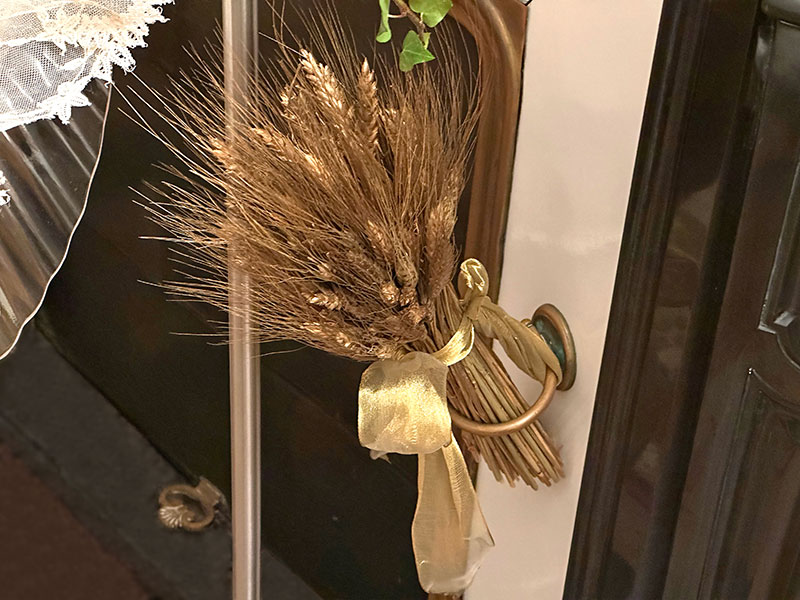
This is one of the sheaves of wheat presented on either side of the sofreh. Wheat is an important part of the ofreh-ye aqd, and this subtly gold-tinted bouquet is hand-tied with a fine gold ribbon. Like bread, which is of great importance in the Persian culture, sheaves of wheat represent blessing and abundance (barekat).
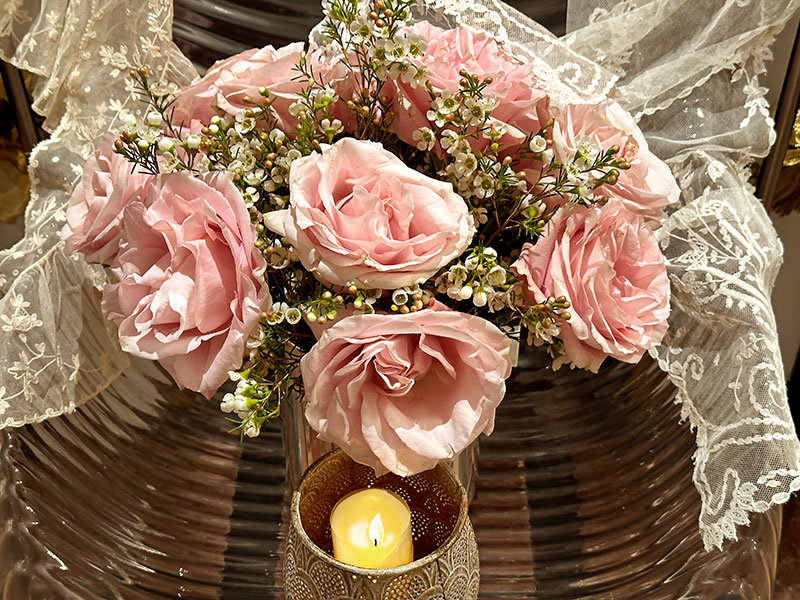
This is the impressive bouquet of Secret Garden roses and wax flower that inspired the creation of the sofreh. The fine, papery petals of the roses complement the lengths of fine antique ivory lace. The bouquet sits on a contemporary armchair designed by Ron Arad. The flame of a single candle radiates a warm golden glow.
Echoes of Sofreh-ye aqd, February 2024
For February 2024, two compact arrangements, which allude to a Persian marriage sofreh (sofreh-ye aqd), were designed. The first sofreh has a muted-gold colour scheme and the second one has a green theme.
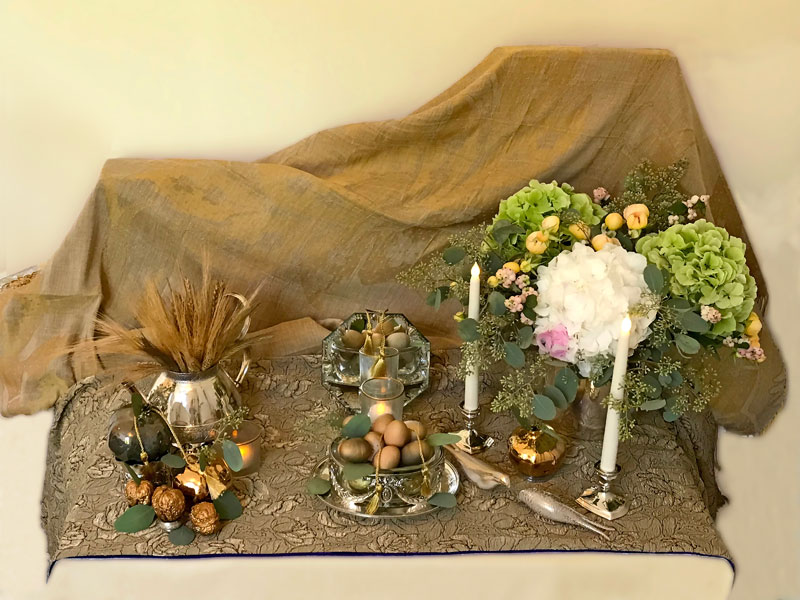
This is the overall view of the first sofreh with a muted-gold colour scheme. An impressive bouquet of hydrangeas, spray roses and foliage takes up a corner of the arrangement. A few of the symbolic elements of the sofreh-ye aqd, namely a mirror, sheaves of wheat, gold-tinted walnuts and eggs, sculptured pomegranates and birds are on display. The compact sofreh is embellished with sprigs of fragrant Eucalyptus and delicate gold tassels, and softly illuminated with flames of tea lights and candles.
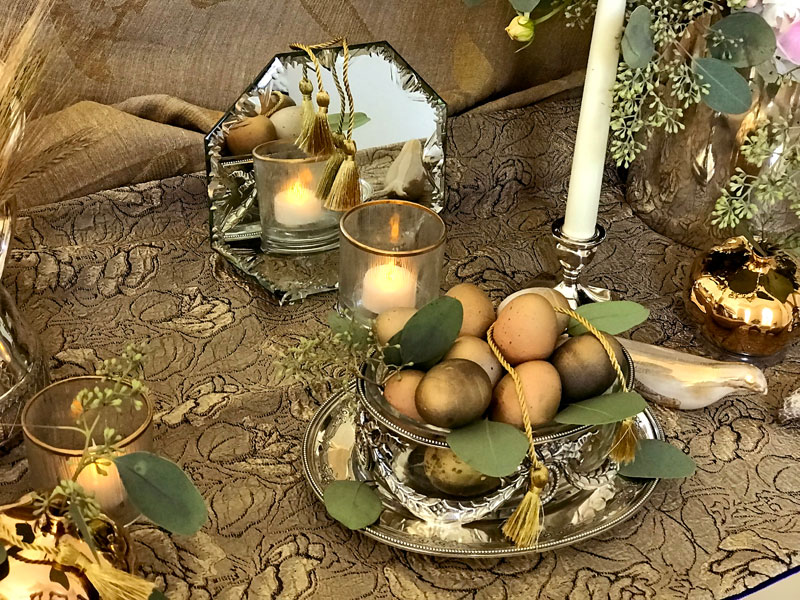
This is the heart of the first sofreh. An attractive, antique crystal and silver-plated vessel holds the gold-tinted eggs, embellished with gold tassels and sprigs of Eucalyptus. This section is illuminated with the flame of a single tea light. The reflection of these elements in the antique Venetian mirror, which itself is adorned with gold tassels, is dazzling. Eggs represent life and fertility and the mirror is a symbol of light and reflection. The embossed gold textile on the surface elevates this elegant sofreh.
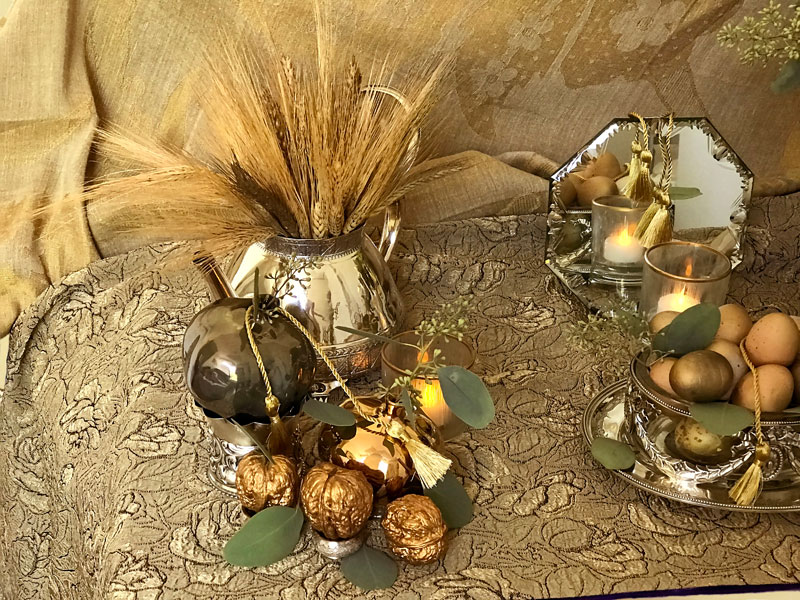
This is the left corner of the sofreh-ye aqd with a muted-gold colour scheme. Sheaves of wheat, a symbol of blessing and abundance (barekat), are presented in an attractive, antique silver-plated teapot. Two ceramic pomegranates in metallic silver and gold, as well as three impressively large gold-tinted walnuts, both symbols of fertility and embellished with sprigs of fragrant Eucalyptus and delicate gold tassels, are on display. This corner is softly illuminated with a glowing tea light.
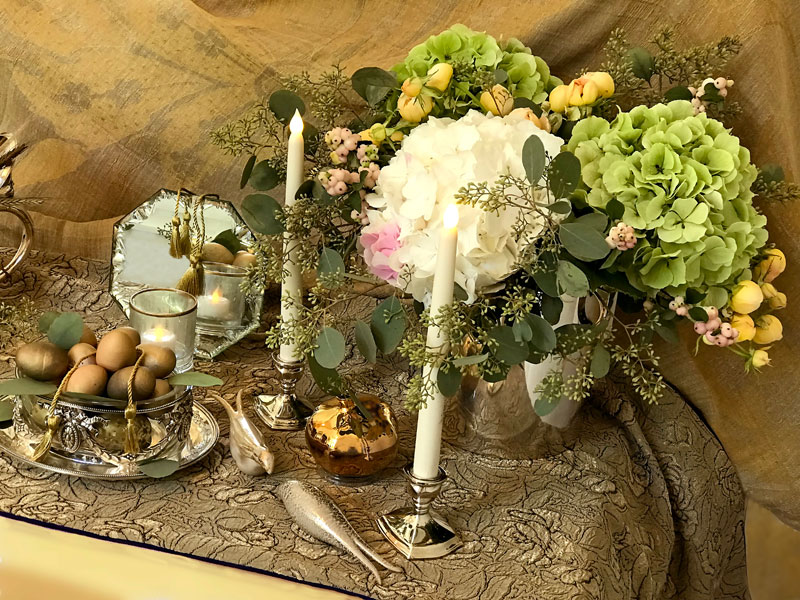
This elaborate floral display sits on the right corner of the first sofreh. The spectacular white and green hydrangeas are known as White Verena and Verena Classic, respectively. The spray roses are called Princess Aiko, the berries are known as snowberries (Symphoricarpos), and the foliage is Eucalyptus populus. The bouquet is softly illuminated with the flames of two candles, and a pair of stylized, gold- and silver-finish ceramic birds represents the couple and augurs good fortune.
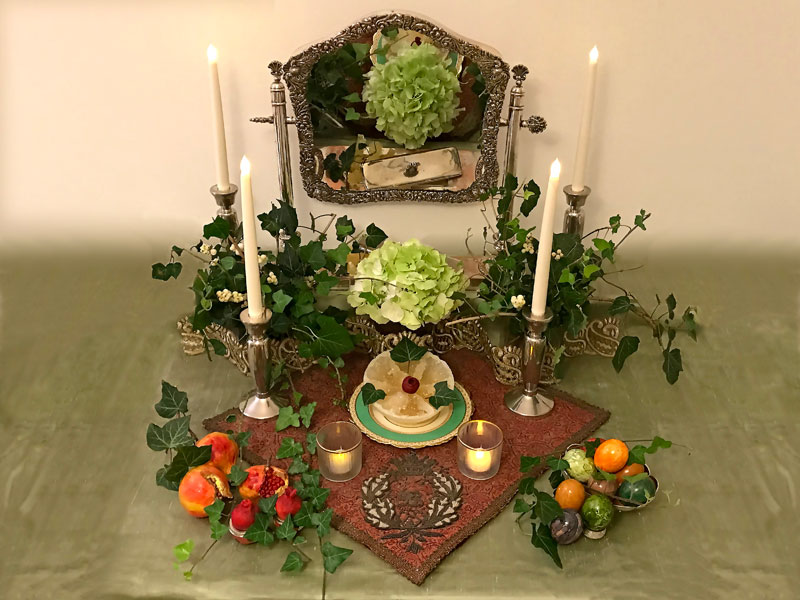
This is the overall view of the second sofreh, which has a green colour scheme. A single green hydrangea, flanked by two vases of foliage, take centre stage. A few of the symbolic elements of the sofreh-ye aqd, namely an antique silver-plated mirror, crystal sugar, sculptured pomegranates and coloured eggs, are on display. The compact sofreh, which is softly illuminated with flames of tea lights and candles, showcases a length of antique Persian embroidered textile, known as termeh, and is embellished with graceful sprigs of trailing ivy.
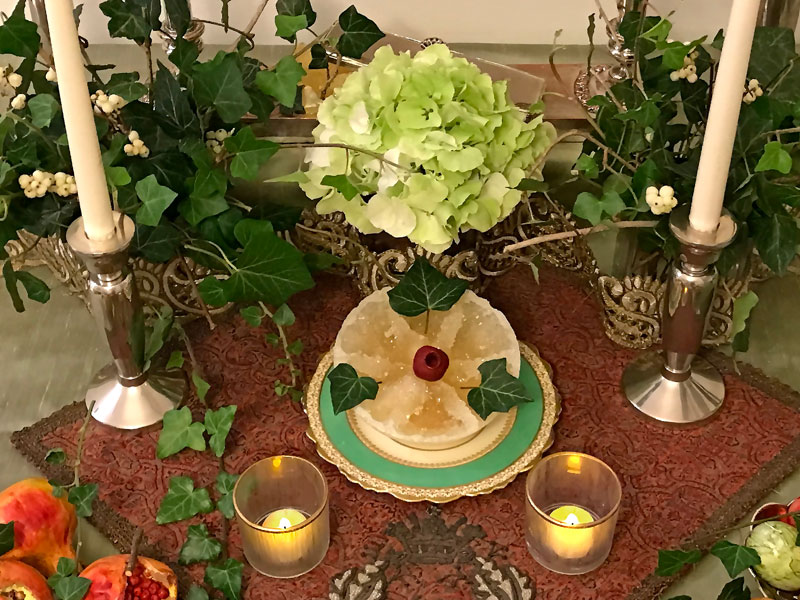
This is the view from above of the second sofreh-ye aqd with a green theme. The single Verena Classic hydrangea complements the green and gold-rimmed plate of crystal sugar, in the form of a bowl (kaseh nabat). Crystal sugar, a symbol of sweetness and harmony, presented in this form, is an important symbolic element of the sofreh-ye aqd. Kaseh nabat is illuminated with flames of tea lights and is embellished with a single miniature sculptured pomegranate and ivy leaves. Bouquets of trailing ivy and snowberries adorn this section.
Echoes of Sofreh-ye aqd, January 2024
This delightful arrangement, which echoes a Persian marriage sofreh (sofreh-ye aqd), was inspired by these elegant, handmade bonbonnières in the Persian spirit, designed for a recent real-life marriage ceremony.
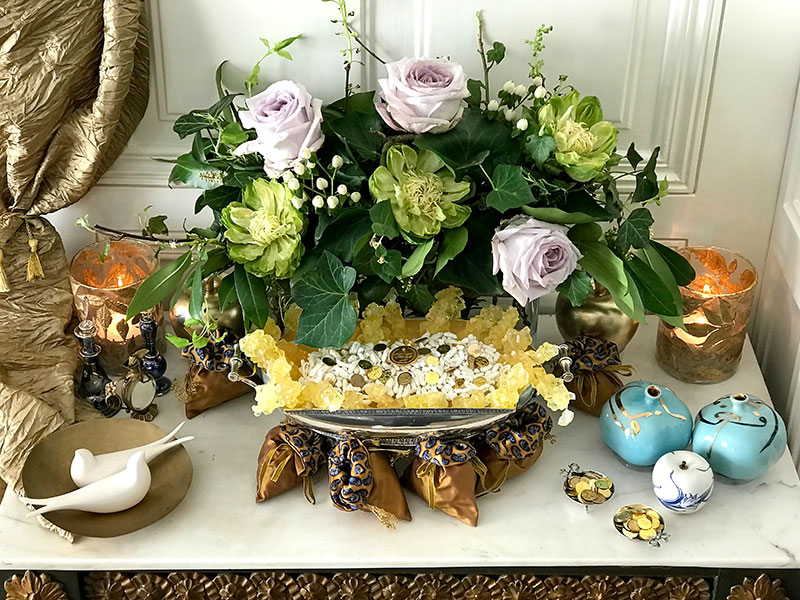
This is the overall view of the sofreh. An impressive bouquet of roses (Veggie and Andrea) and foliage (Hypericum and mainly ivy), as well as an antique silver-plated container of Persian sugared almonds (noql), crystal sugar (nabat) and gilded coins (sekkeh), take centre stage. Several other symbolic elements of the sofreh-ye aqd, namely flasks of Persian rosewater (golab), a pair of ceramic birds, and sculptured apples and pomegranates, are on display. This heavenly arrangement is embellished with a length of fine gold textile and subtly illuminated with a pair of tea lights, presented in attractive holders.
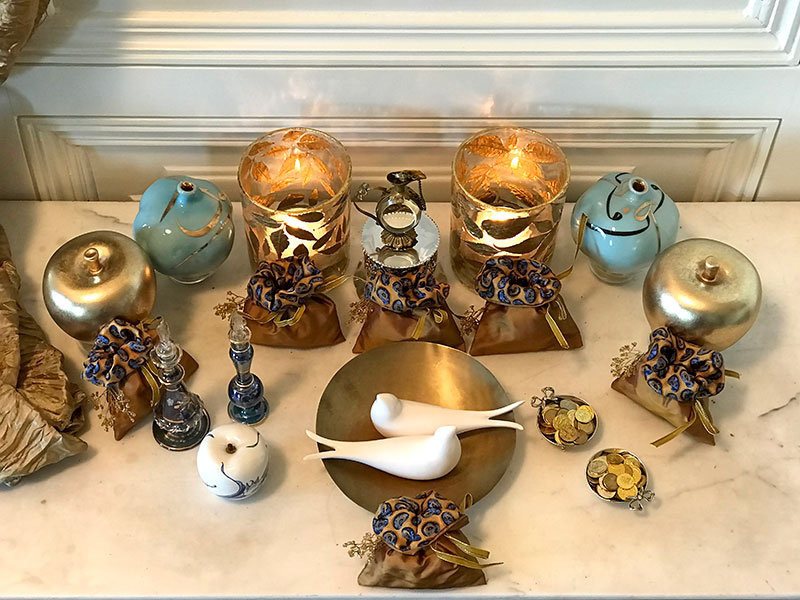
To offer variety and to better showcase the details of the sofreh, the smaller symbolic elements have been rearranged here. The lovely antique miniature mirrored jug of rosewater takes centre stage, flanked by a pair of attractive tea light holders, which subtly illuminates the arrangement. Two more antique glass flasks in blue and gold contain rosewater to perfume the air. Sculptured apples and pomegranates, symbols of life and fertility, as well as gilded coins, a symbol of wealth and prosperity, are on display. A pair of stylized ceramic birds represents the married couple. The elegant bonbonnières are clearly displayed.
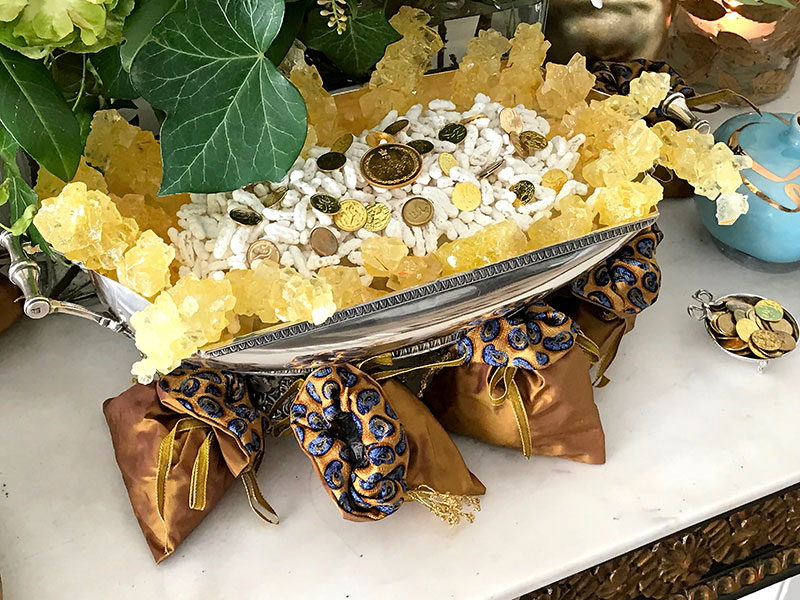
This elegant, antique silver-plated container of Persian sugared almonds (noql), crystal sugar (nabat), speckled with gilded coins and embellished with a single gold coin (sekkeh), is placed at the heart of the sofreh. Sugared almonds and crystal sugar are symbols of sweetness and harmony, while coins represent wealth and prosperity. The elegant handmade bonbonnièrs are placed neatly at the foot of the container.
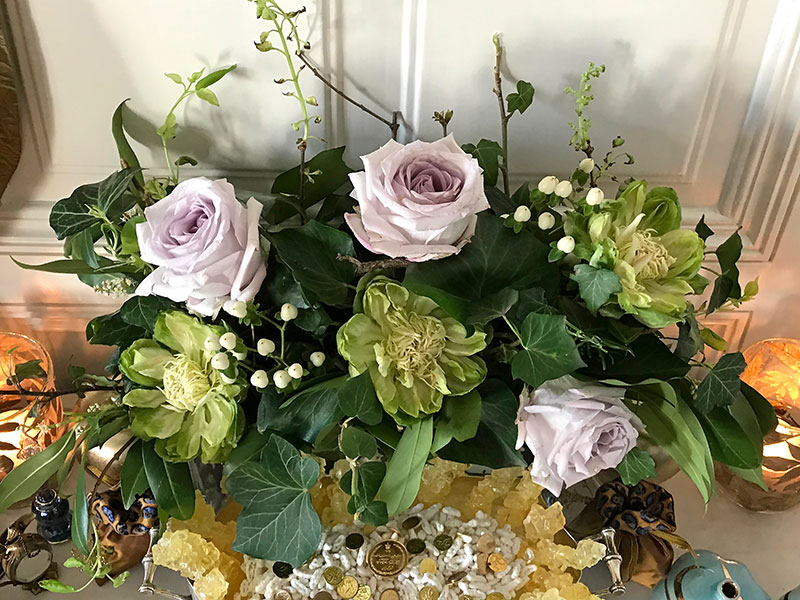
This lovely, soft bouquet of roses, known as Veggie and Andrea, mixed with Coco Uno Hypericums and foliage, mainly ivies, takes centre stage in the sofreh. The pale green Veggie and the dusty purple Andrea roses, together with the off-white Hypericums, make for an elegant and soft colour scheme. The bouquet is subtly illuminated by the glow of the flames of the tea lights, creating a serene ambience.
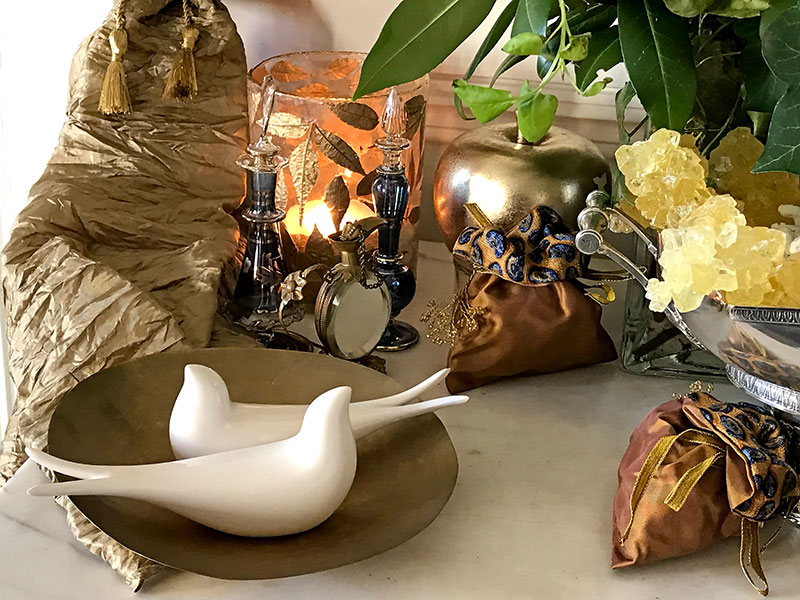
This is the left corner of the sofreh. The graceful ceramic birds represent the couple, as well as heralding good fortune. Three antique miniature flasks contain rosewater to perfume the air. The mirrored jug mimics the notion of a life-size mirror, which is a vital part of any sofreh-ye aqd. A gold-finished sculptured apple symbolizes life and fertility. Two of the bonbonnières, which are made of gold silk and boast a paisley pattern, are neatly displayed. The flame of one of the tea lights emanates a warm golden glow.
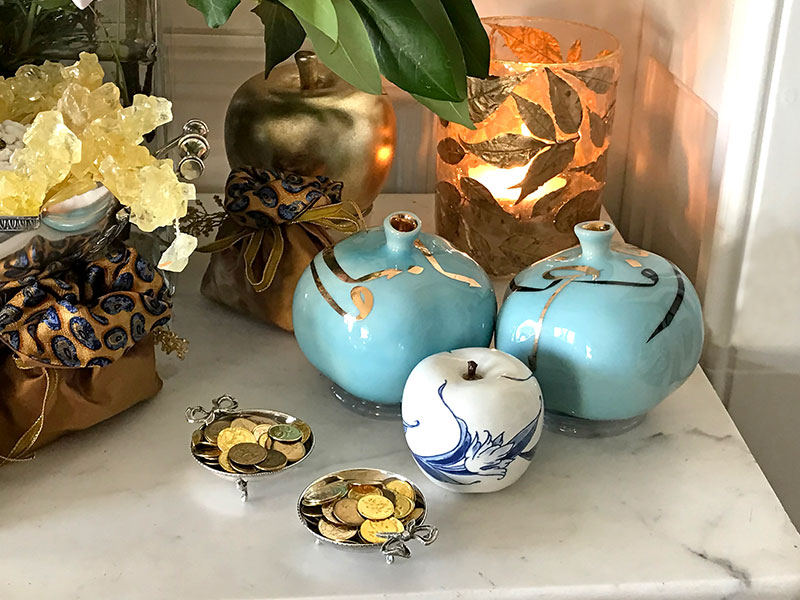
This is the right corner of the recently posted sofreh. A pair of ceramic pomegranates by Keyvan Fehri, a gold-finished sculptured apple and a blue and white sculptured apple symbolize life and fertility. A pair of antique, miniature silver vessels contains gilded coins (sekkeh). Two bonbonnières, which are made of gold silk and boast a paisley pattern (boteh) in blue, complementing the blue colour scheme of the sofreh, are neatly displayed. The flame of one of the tea lights radiates a warm golden glow.
Shab-e Yalda, Winter Solstice 2023
The posts of December 2023 present miniature sofrehs, which include various symbols of the traditions of Shab‑e Yalda, the winter solstice, which is the longest night of the year. It is the eve of 1 Dey in the Persian calendar, corresponding to 21 December. The feast of Yalda originates in the pre-Islamic period and is associated with agriculture. Red fruits, especially watermelons and pomegranates, are important components of this celebration, heralding the crimson hues of sunrise after absolute darkness, and the promise of longer days ahead. It is the celebration of the passing of darkness and the rebirth of the sun. In the Persian tradition, people get together, tea, sweets, nuts and fruits are served, stories and poetry are recited, and fortunes are told, to get through the darkest and longest night of the year, when it is believed that demons are most active.
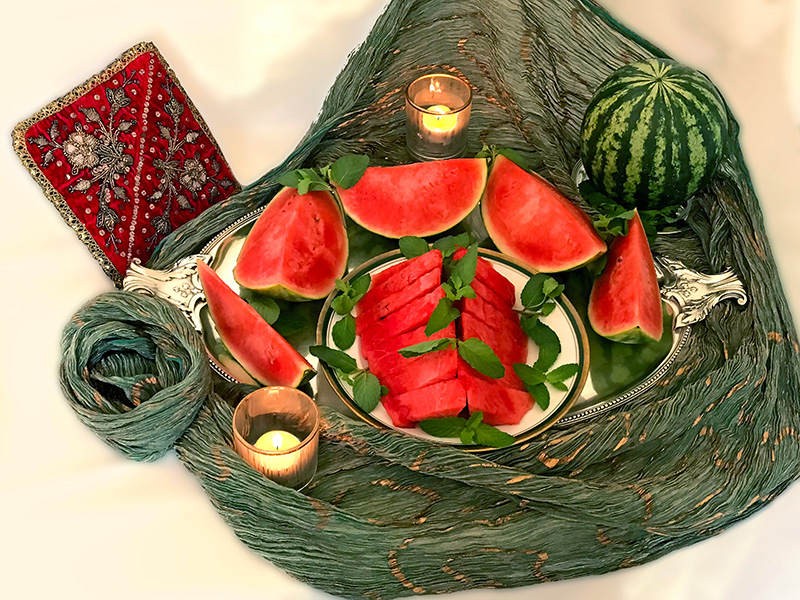
The focus of this image is a miniature sofreh presenting cut and whole watermelons, embellished with fragrant leaves of mint. The arrangement, which is softly illuminated with a pair of flames, is put together on a length of ruched green Indian textile with gold accents. A lovely antique piece of bright red velvet, embroidered with metallic threads, seed-pearls and sequins, brightens this radiant sofreh.
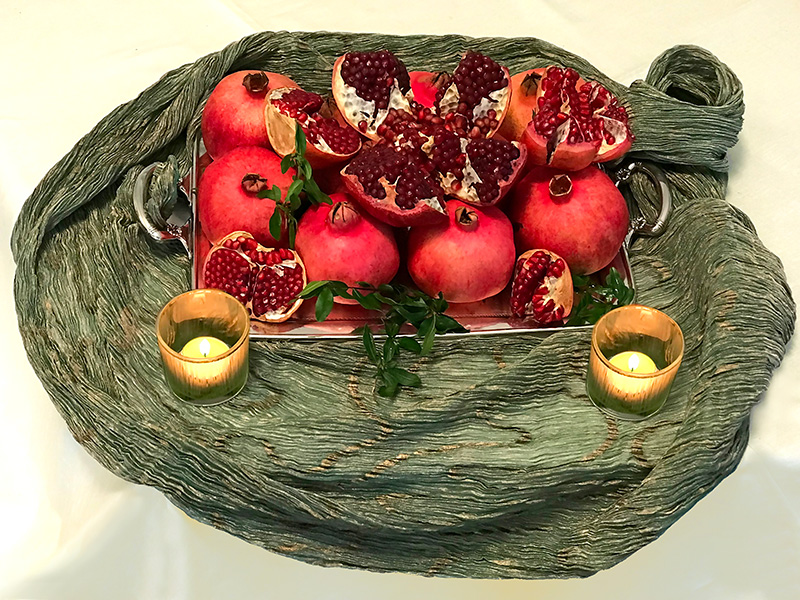
The focus of this image is a miniature sofreh presenting open and whole pomegranates, embellished with pomegranate sprigs. The exposed deep-red seeds of the opened fruits are truly dazzling. The arrangement, which is softly illuminated with a pair of flames, is put together on a length of green ruched Indian textile with gold accents. A corner of the textile has been shaped into an elegant rosette.
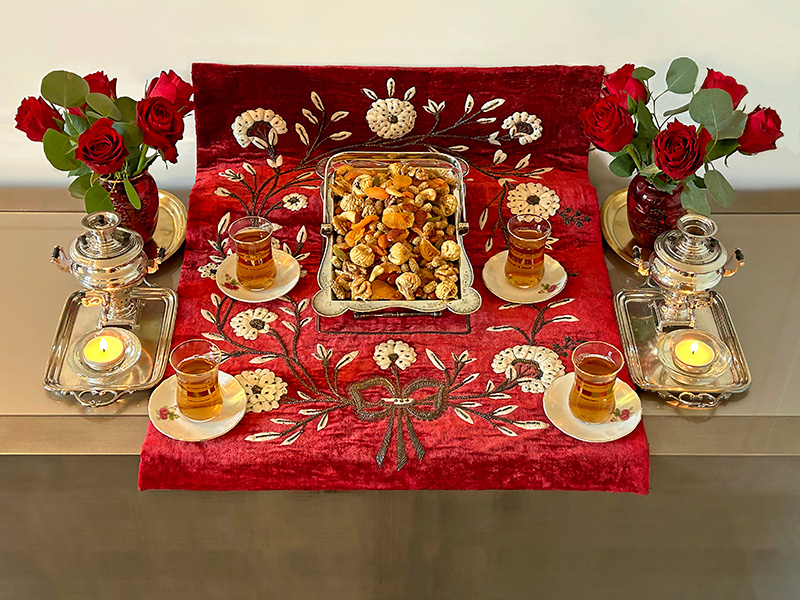
This delightful antique embroidered red velvet, which also appears in the book, SOFREH: The Art of Persian Celebration, makes for a striking and ornamental backdrop for two miniature sofrehs for the nightlong celebrations of Shab-e Yalda. In both cases the arrangement includes traditional glasses of tea and a pair of miniature samovars, echoing the ritual of serving tea. The sofrehs are softly illuminated with flames of a pair of tea lights and embellished with a pair of miniature bouquets of deep-red roses and foliage. Here, a beautiful container of sumptuous dried fruits and nuts (ajil-e moshkel gosha), which is believed to resolve difficulties and is an important part of the traditions of Shab-e Yalda, takes centre stage.
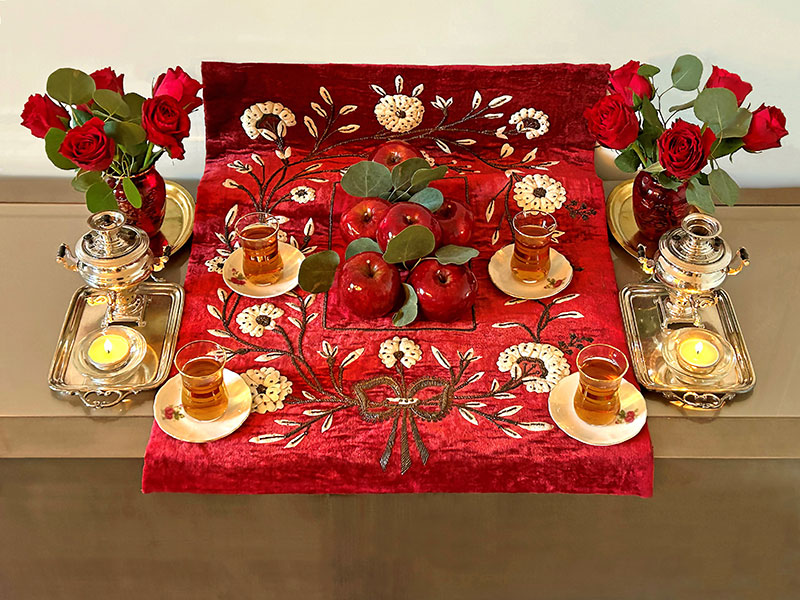
This delightful antique embroidered red velvet, which also appears in the book, SOFREH: The Art of Persian Celebration, makes for a striking backdrop for two miniature sofrehs for the nightlong celebrations of Shab-e Yalda. In both cases the arrangement includes traditional glasses of tea and a pair of miniature samovars, echoing the ritual of serving tea from a life-size samovar. The sofrehs are softly illuminated with flames of a pair of tea lights and embellished with a pair of miniature bouquets of deep-red roses and foliage. Here, shiny, bright deep-red apples, embellished with sprigs of fragrant Eucalyptus, replace the container of dried fruits and nuts, further emphasizing the red colour scheme.
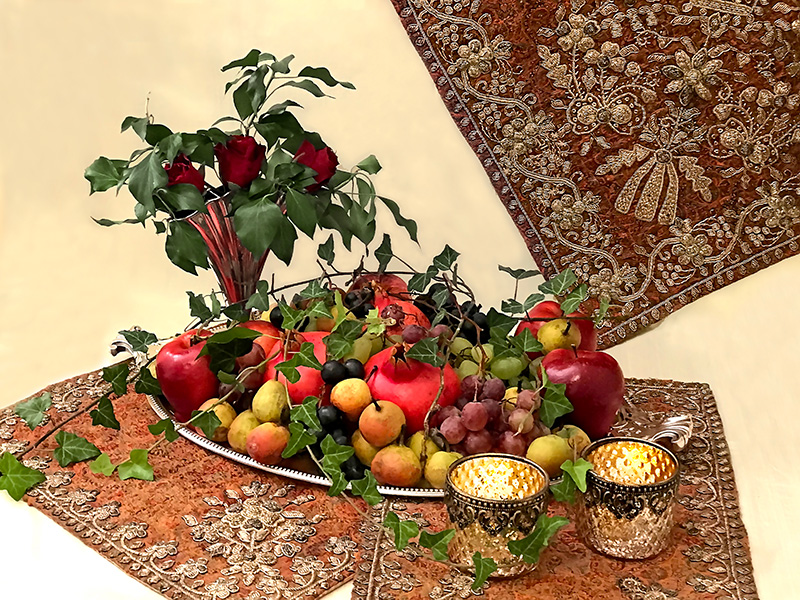
Fruit is very much part of the Persian eating traditions, and like on many other occasions it is served during the nightlong celebrations of Shab-e Yalda. This delightful miniature sofreh focuses on an antique silver-plated tray of a mixture of fruit, including pomegranates, red apples and grapes, which are softly illuminated with a pair of flames. Lengths of fine antique embroidered Persian textiles (termeh), branches of trailing ivy and deep-red roses and foliage, presented in an original vase, embellish this pleasant arrangement.
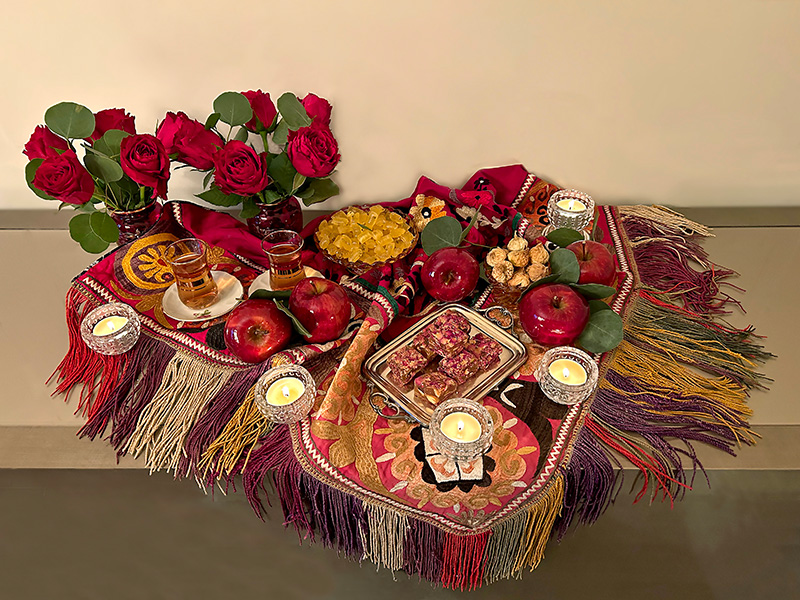
This miniature sofreh is arranged on a delightful length of suzani with a stunning, colourful fringe. It focuses on the custom of serving tea with sweets during the celebrations of Shab-e Yalda, throughout the longest and darkest night of the year. Dried figs, traditional Persian candies known as abnabat qeichi (scissor candies) and sweets decorated with rose petals are on display. Bright deep-red apples shine in this sofreh, which is softly illuminated with flames and embellished with a pair of bouquets of deep-red roses and foliage.
Autumnal Sofreh, November 2023
This year, for the November arrangement echoing a marriage sofreh (sofreh-ye aqd), the autumnal and harvest theme, presented in October, has been continued. The highlight of this sofreh is the exquisite yellow/orange antique Persian textile, known as termeh, with an intricately embroidered border and a “lion and sun” emblem on view in one corner, as well as an original mirror, framed with sheaves of wheat.
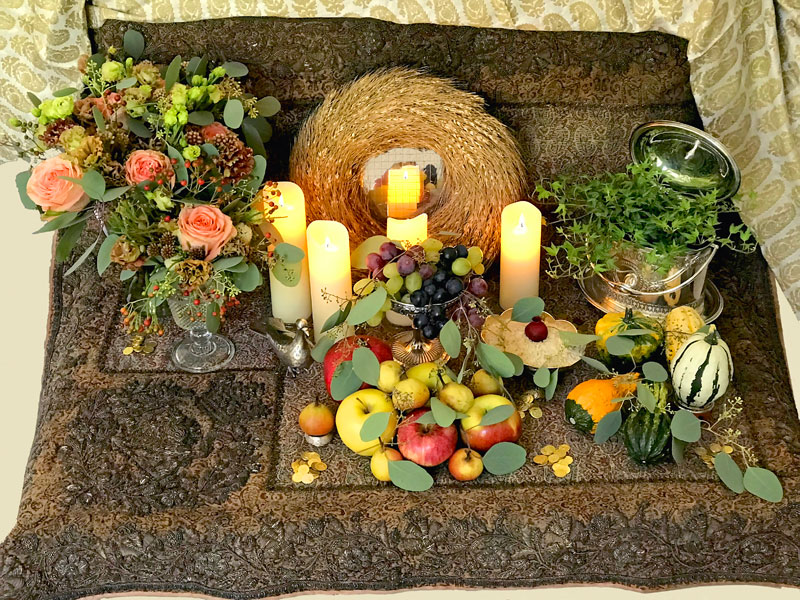
This is the overall view of the unconventional autumnal sofreh-ye aqd. The heart of the composition is decorated with a variety of autumnal fruit. Bouquets of flowers (Country Home roses and Lisianthus Terracotta) and foliage in subtle autumnal tones brighten the sofreh. Unusually, as it is a sofreh presented close to Halloween, a touch of the spirit of that tradition is on display. Several pillar candles illuminate this distinctive and creative composition.
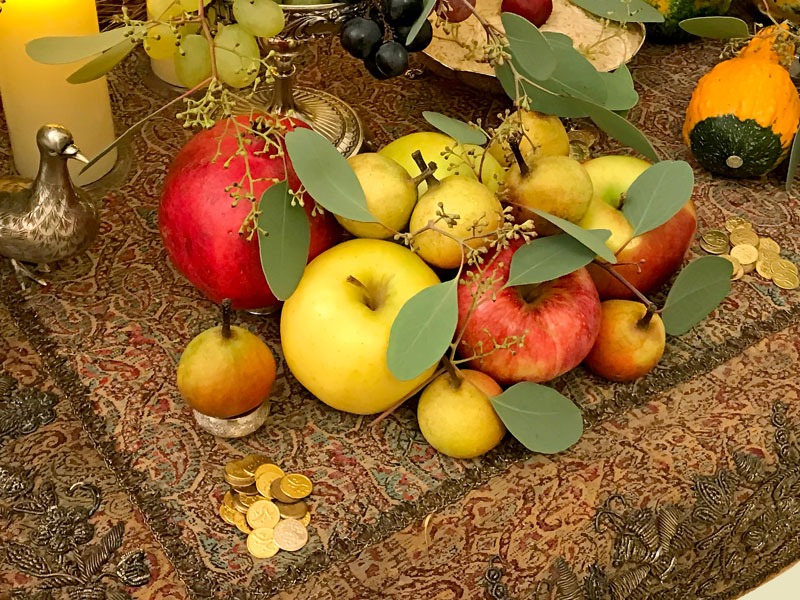
This is the lower central part of the sofreh-ye aqd. It is decorated with a variety of seasonal fruit, namely apples, miniature pears and a single pomegranate. Apples and pomegranates, which are among the divine fruits (miveh-ye beheshti), symbolize life and fertility. This miniature composition is embellished with sprigs of fragrant Eucalyptus. Small piles of gilded coins (sekkeh), a symbol of wealth and prosperity, are scattered around the sofreh.
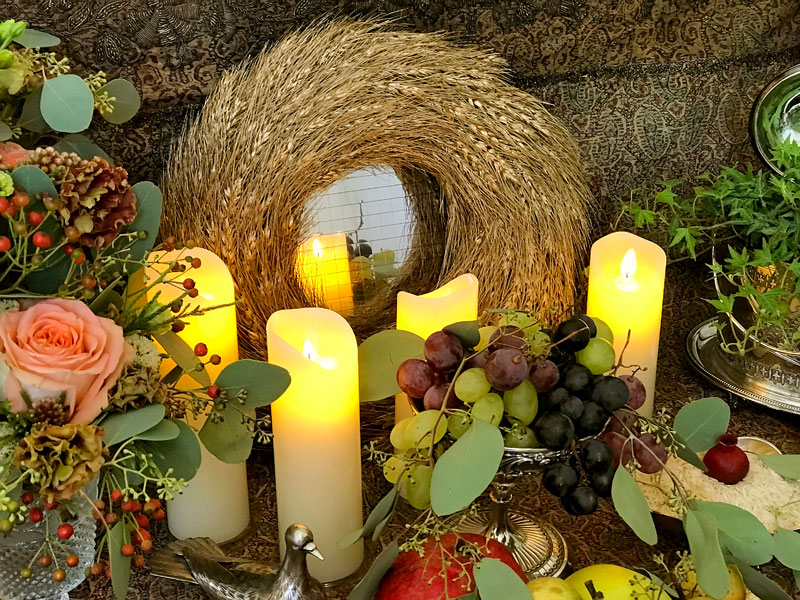
This is the heart of the sofreh-ye aqd. The composition boasts an unusual mirror mosaic framed with sheaves of wheat, a symbol of blessing and abundance (barekat). Sheaves of wheat not only herald the harvest season, but are often part of the sofreh-ye aqd. This central section is decorated with grapes of different colours, which are in season. They are presented in an antique silver compote dish and embellished with sprigs of fragrant Eucalyptus. The flames of the pillar candles, coupled with the reflection of one of them in the mirror, provide a delightful illumination.
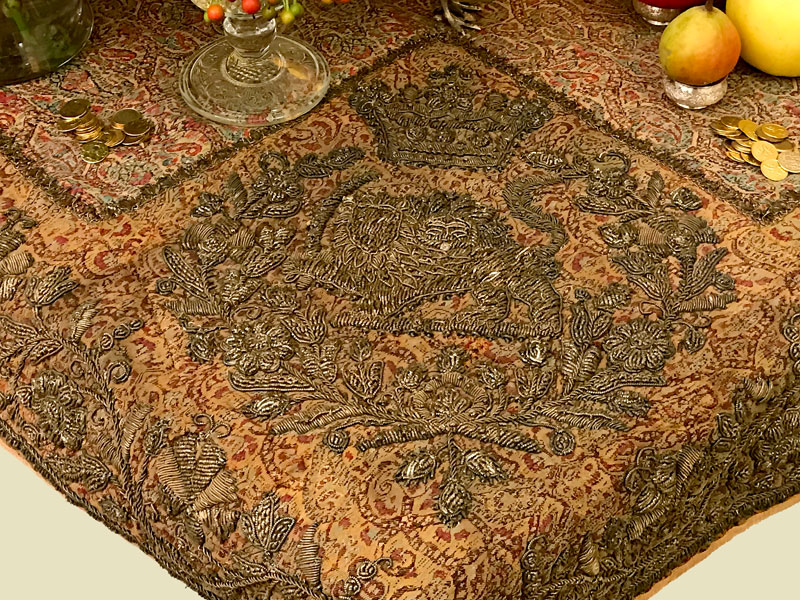
This is a close-up of the exquisite early 20th-century Persian textile (termeh), probably from Kerman, the highlight of the sofreh-ye aqd. The focus of the image is the intricately embroidered "lion and sun" ("shir o khorshid") motif with metallic threads. The emblem is enhanced with a crown, flowers and tendrils. In the Persian tradition the "lion and sun" motif has many narrated meanings, which have evolved over the years. Describing and summarizing its significance and evolution in this brief caption would not do justice to its influence, prominence and history.
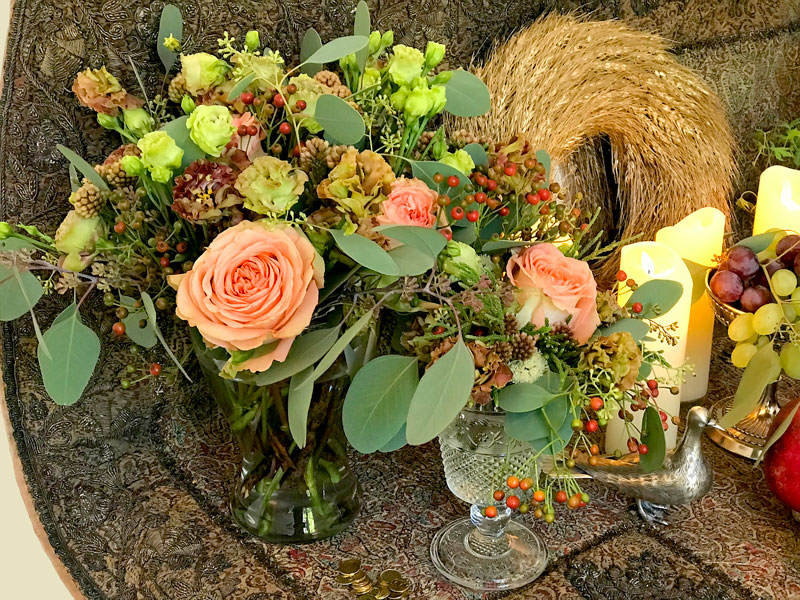
This is the left side of the sofreh-ye aqd. The harmonious bouquets in subtle autumnal tones of orange and terracotta, softly illuminated with flames, are made up of Country Home roses, Lisianthus Terracotta, Brunia fragarioides, Eucalyptus populus and the fruit of Rosa multiflora (rose hips). The subtle colour scheme nicely echoes the shades of autumn and the harvest season. An antique Russian silver bird statuette augurs good fortune. One of the several small piles of gilded coins (sekkeh), a symbol of wealth and prosperity, is visible in this image.
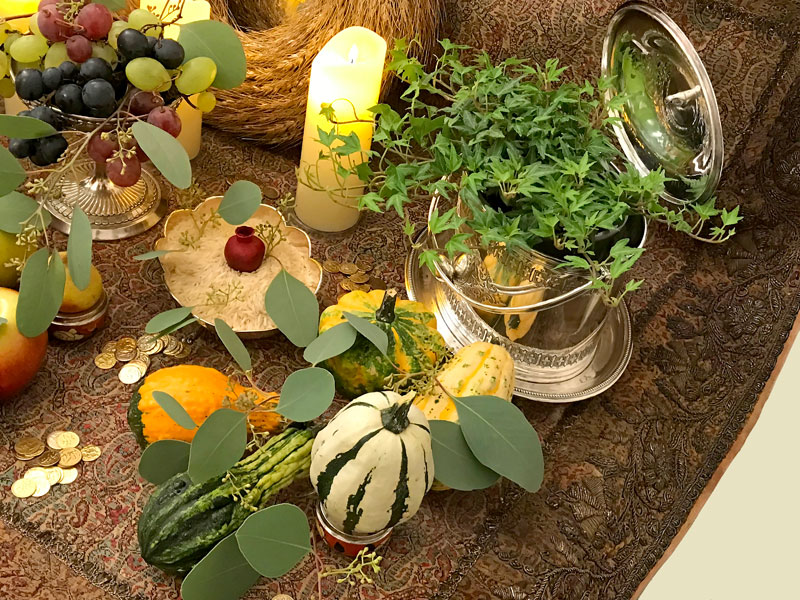
This is the right side of the sofreh-ye aqd. The corner is embellished with sprigs of Eucalyptus and a softly illuminated pot of delicate trailing ivy. Rice, which is harvested in autumn, is also a symbol of blessing and abundance, and often included in the sofrehs for Nowruz and aqd. Here it is embellished with a single sculpted miniature pomegranate. Inspired by the traditions of Halloween, this unconventional sofreh includes decorative pumpkins, which speak to the harvest season, as well as complementing the colour scheme of this autumnal sofreh.
Aqd & Mehregan, October 2023
This autumn, to pay homage to Jashn-e Mehregan and the harvest season, an autumnal composition, which echoes a Persian marriage sofreh (sofreh-ye aqd), was created.
The festival of Mehregan (8-13 October), which is an Iranian pre-Islamic festival, is associated with harvest. To learn more, please scroll down to Jashn-e Mehregan, October 2022.
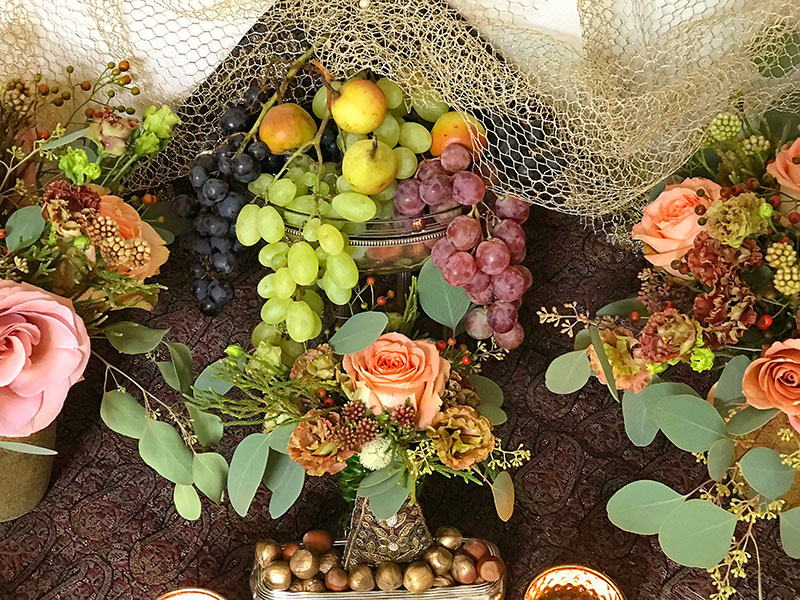
This is the heart of the autumnal sofreh-ye aqd. It includes miniature pears and grapes of different colours, which are in season. The backdrop is a length of draped fine gold open mesh. The fruit is elegantly arranged in an antique compote dish to highlight the beauty of the bunches of trailing grapes. A miniature bouquet of flowers and foliage in subtle autumnal shades takes centre stage, next to an embroidered pouch of gilded coins. Natural and decorated nuts, a symbol of fertility, are also on display.
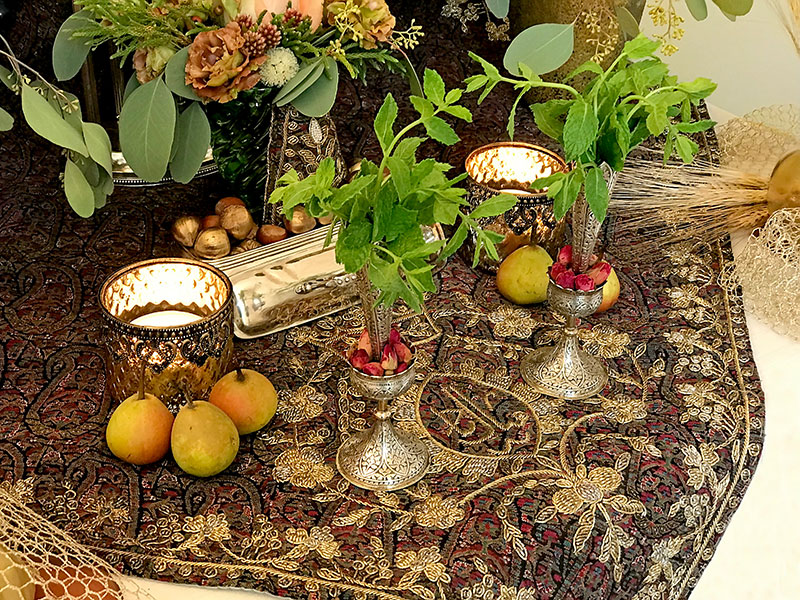
This image focuses on the lower central part of the sofreh-ye aqd. The antique Persian textile, known as termeh, is embroidered with metallic threads. The ornamental motifs are floral with leaves and tendrils, together with a stylized Persian inscription, "mobarak bad", meaning congratulations. A pair of antique Persian silver vases holds bunches of fresh and fragrant herbs, and dried miniature roses. The lid of the antique silver box containing the nuts alludes to a mirror, a symbol of light and reflection.
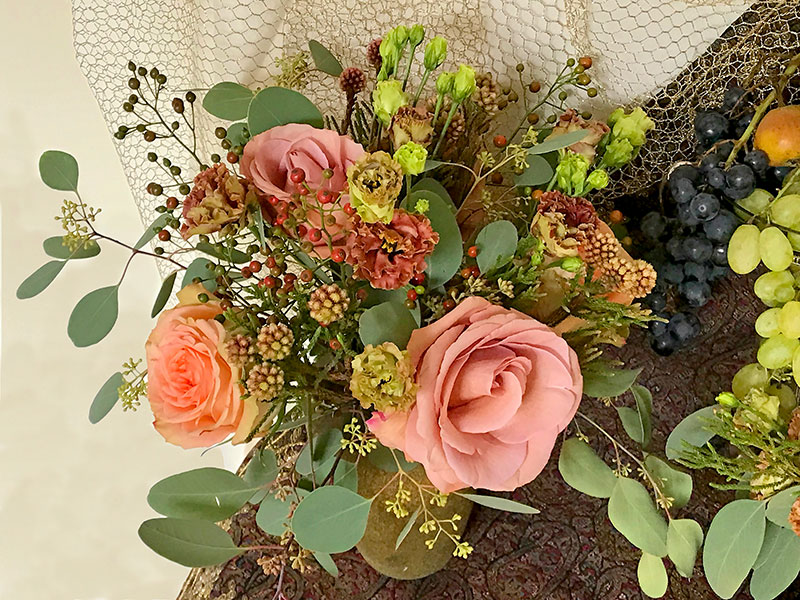
This pleasant bouquet in subtle autumnal tones is displayed on the left side of the sofreh-ye aqd. The harmonious bouquet is made of Moab and Country Home roses, Lisianthus Terracotta, Brunia fragarioides, Eucalyptus populus and the fruit of Rosa multiflora (rose hips). This bouquet nicely highlights the smoked orange Moab roses.
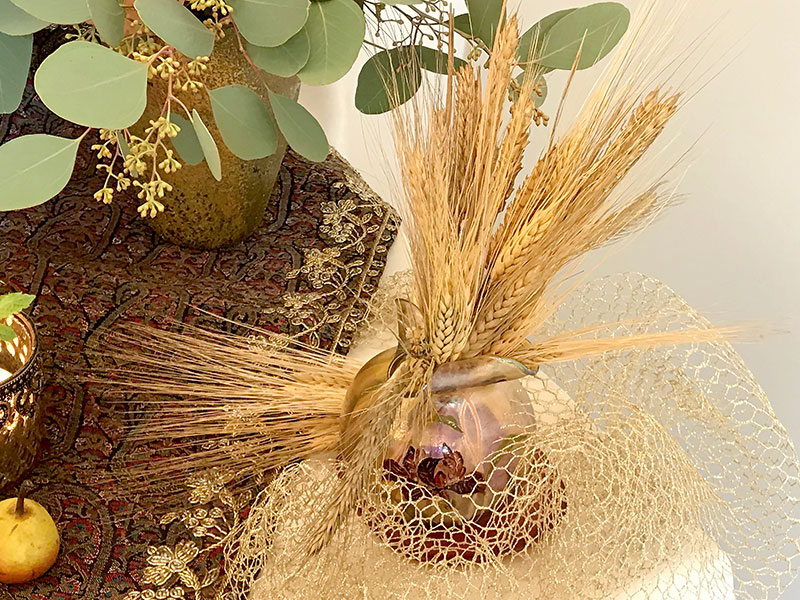
This intricate composition of sheaves of wheat, presented in and around an attractive antique vase and partially enveloped in a length of fine gold open mesh, is displayed in a corner of the sofreh-ye aqd. Sheaves of wheat, which are often included in the sofreh-ye aqd as a symbol of blessing and abundance (barekat), herald the harvest season.
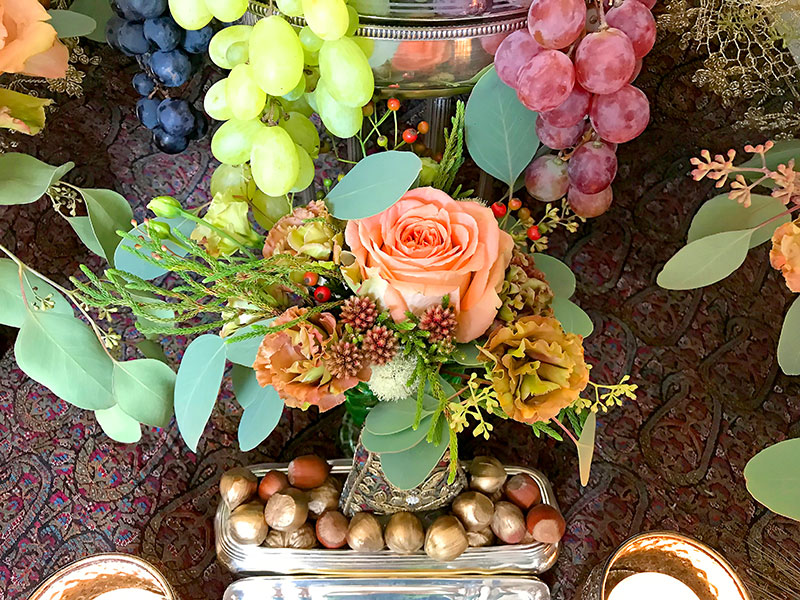
This is the close-up of the delicate miniature bouquet placed at the heart of the sofreh-ye aqd. A single Country Home rose, Lisianthus Terracotta, Brunia fragarioides, Eucalyptus populus and rose hips make up this dainty arrangement. The colour of the grapes hanging above the bouquet complements its soft and subtle autumnal tones.
Traditional Versus Contemporary
This enchanting set-up arranged on a modern, tiered Perspex console table echoes a Persian marriage sofreh (sofreh-ye aqd). The composition nicely incorporates the contrasting traditional and contemporary spirits.
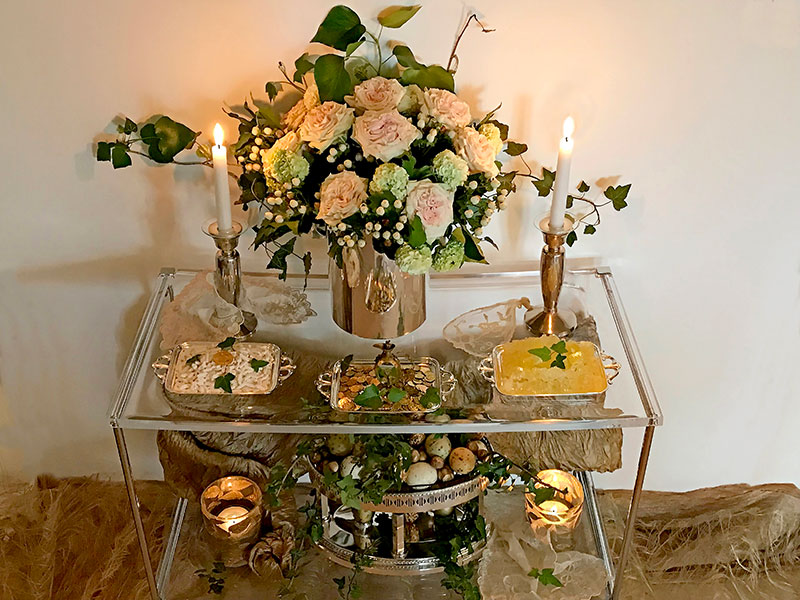
This is the overall view of the arrangement. An impressive bouquet of Country Secret roses and elegant foliage, flanked by a pair of candelabra, takes centre stage. Many of the symbolic elements of the sofreh-ye aqd, namely decorated eggs, gold-tinted nuts, Persian sugared almonds, crystal sugar, gilded coins and rosewater, are on display in attractive containers.

This elegant, two-tiered antique silver-plated and crystal vessel contains decorated eggs and nuts and is placed on the lower level of the console table. Both eggs and nuts, which are embellished with sprigs of trailing ivy, are symbols of fertility. The two-tiered container, placed against the backdrop of a fine gold textile, complements the two-tiered Perspex console table.
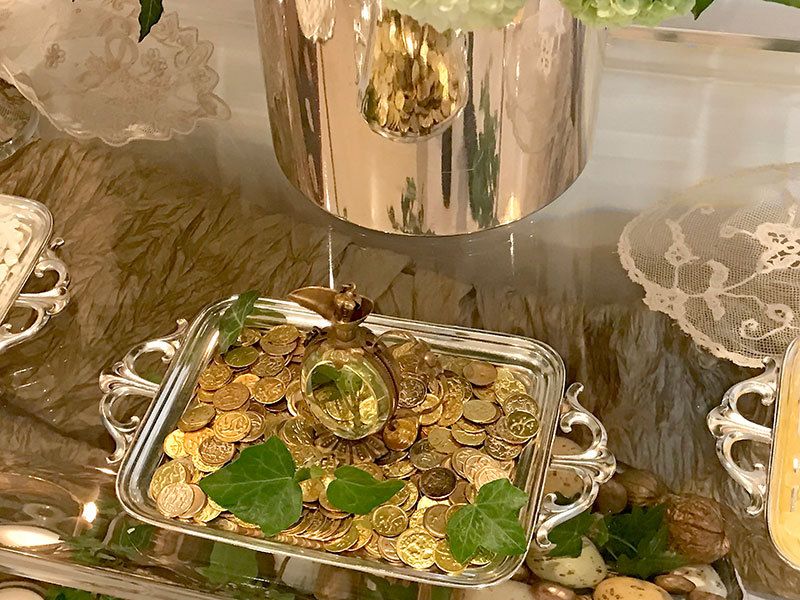
This charming mini composition of gilded coins is embellished with ivy leaves and a miniature, mirrored jug of Persian rosewater. The mirror represents light and reflection. The shiny gilded coins (sekkeh), with the Persian inscription mobarak bad, meaning congratulations, symbolize wealth and prosperity, and the rosewater (golab) perfumes the air.
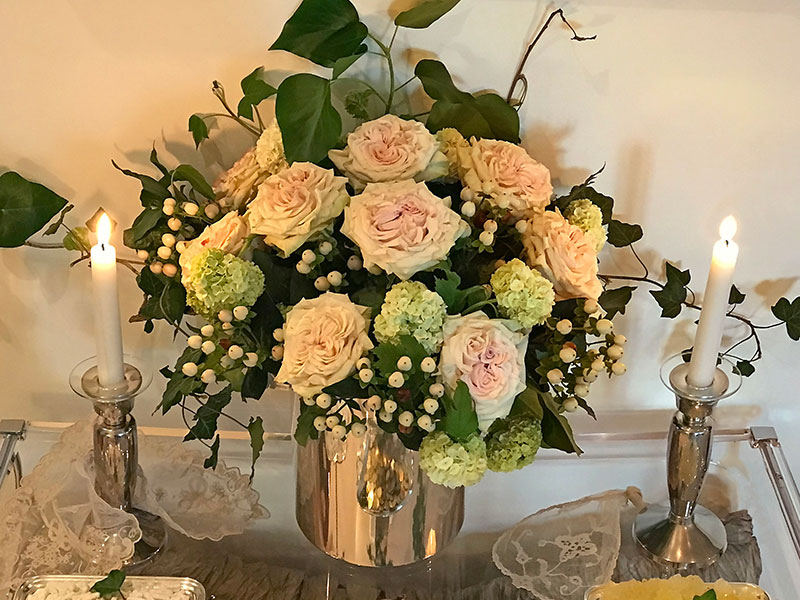
This impressive bouquet of Country Secret roses, Viburnum opulus (Guelder rose), Hypericum and ivy takes centre stage. The colour scheme is pastel and soft tones, which complements the lengths of fine lace and textile included in the sofreh. A dazzling reflection of the gilded coins can be seen in the vase. This section is softly illuminated with flames.
 Apple (Sib)
Apple (Sib)
In the Persian tradition, apples (sib) are among the divine fruits (miveh-ye beheshti) and are a symbol of life and fertility. This original composition, arranged on the staircase of a late 19th-century property, which alludes to a Persian sofreh, is inspired by an assortment of apples, which are always included in the Nowruz sofreh (sofreh-ye haft sinn) and are often part of the Persian marriage sofreh (sofreh-ye aqd).
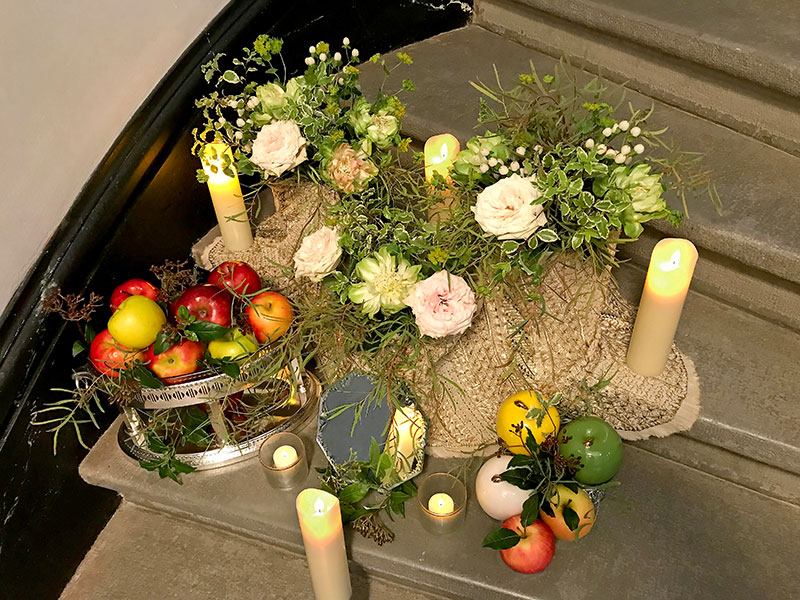
This is the overall view of the sofreh. The arrangement is realized on three levels, with three bouquets of exquisite, open roses and fine, hanging foliage. An antique Venetian mirror and a pair of elegant tea lights take centre stage. This unconventional sofreh is softly illuminated with the flames of pillar candles and tea lights, and adorned with a length of antique Indian textile in muted gold.
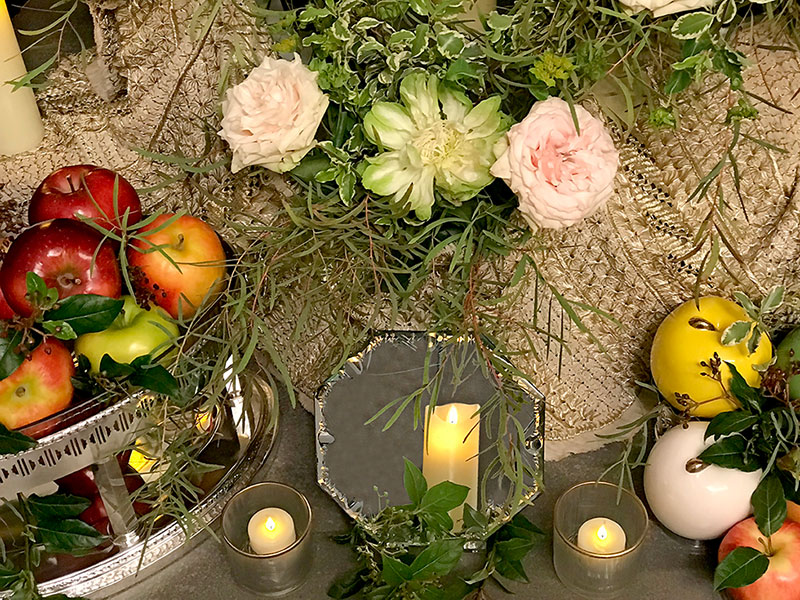
This is the heart of the sofreh. The flame of one of the pillar candles and the lovely sprigs of fine foliage are reflected in the antique Venetian mirror. The central bouquet of open roses and foliage hangs over the backdrop of the antique Indian textile. This section is softly illuminated with the flames of a pair of tea lights, placed in elegant gold-rimmed holders, and the central pillar candle.

These dazzling apples inspired the creation of this sofreh. The assortment includes a variety of shiny apples, namely Red Delicious, Pink Lady, Jazz, Gala, Golden Delicious and Delblush, elegantly arranged in an antique crystal and silver-plated container, embellished with fine, hanging foliage. This corner is softly illuminated with flames and the reflection of the pillar candle in the mirror is charming.
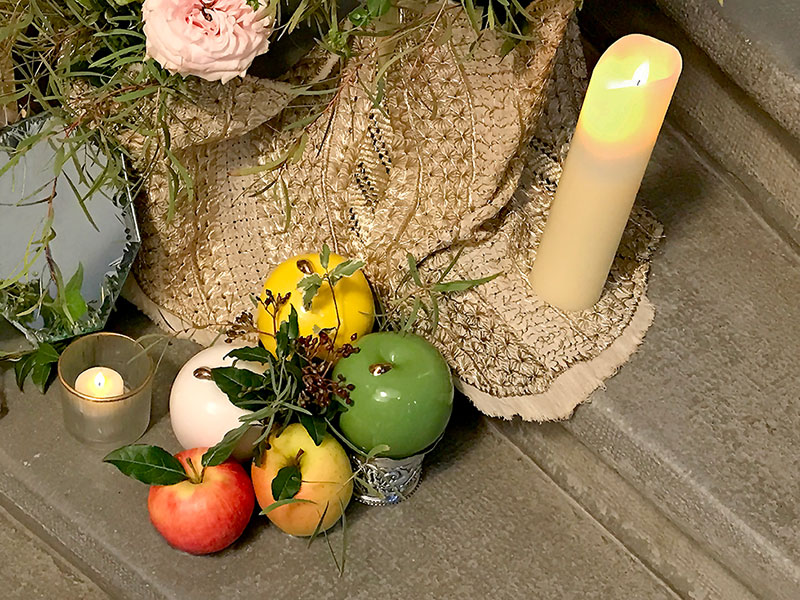
This is the right corner of the sofreh. This section showcases a selection of different colours of ceramic and fresh Gala and Delblush apples. Apples signify growth and rebirth, and are a symbol of fertility. The juxtaposition of the fine antique Indian textile and the rough surface of the stone staircase creates an appealing contrast. This section is softly illuminated with the flames of a pillar candle and a tea light.
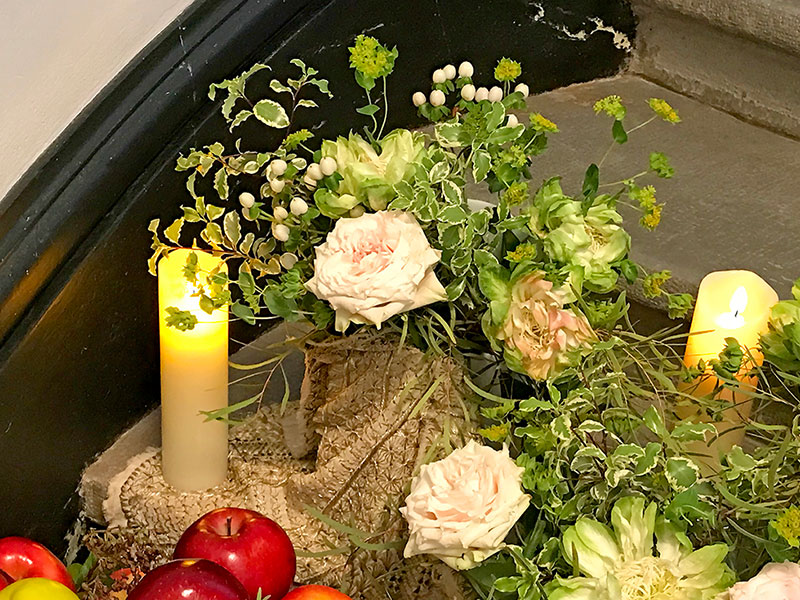
This delightful, harmonious bouquet sits on the left side of the sofreh. The elegant bouquet is made of open Country Secret and Veggie roses, Hypericum, Alchamilla mollis, Eucalyptus nicholii and Pittosporum nigra. Two pillar candles illuminate this corner, which is draped with a length of antique Indian textile in muted gold.
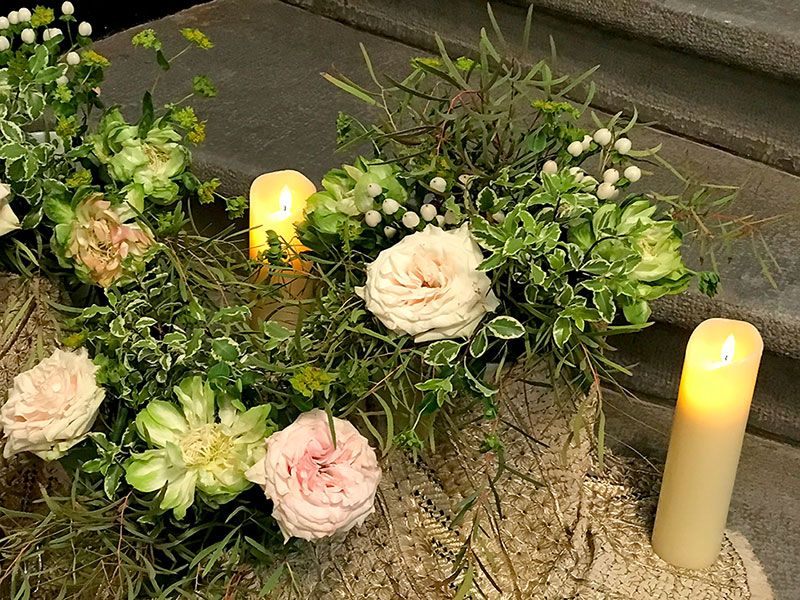
This delightful, harmonious bouquet sits on the right side of the sofreh. The elegant bouquet is made of open Country Secret and Veggie roses, Hypericum, Alchamilla mollis, Eucalyptus nicholii and Pittosporum nigra. Two pillar candles illuminate this corner, which is draped with a length of antique Indian textile in muted gold.
Ivory & Gold
This soft composition in ivory and gold includes many of the symbolic elements of the Persian marriage sofreh (sofreh-ye aqd).
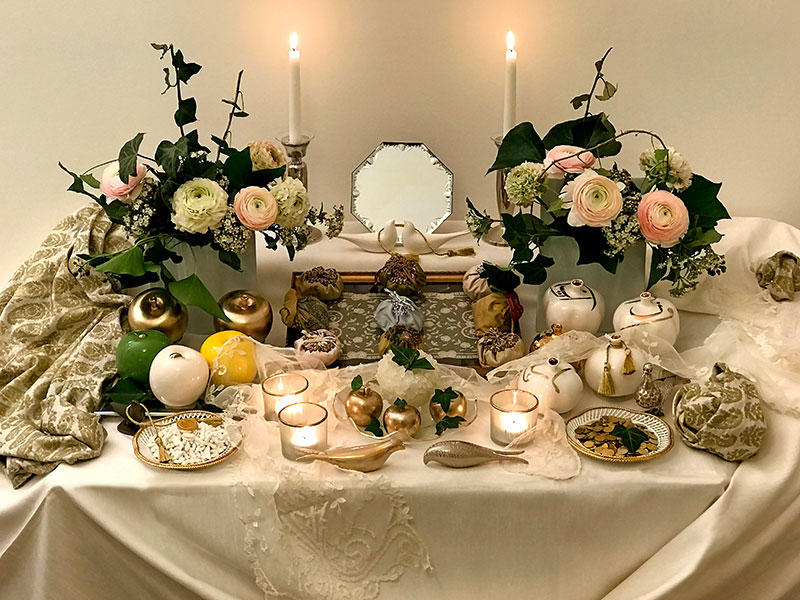
This is the overall view of the soft sofreh in ivory and gold. A mirror and candelabra (ayeneh sham'dan), symbols of reflection and light, together with a pair of bouquets of ranunculi in pastel shades, take centre stage. Two pairs of bird statuettes represent the bride and the groom, and the other bird statuettes herald good fortune. Crystal sugar, Persian sugared almonds, gilded coins, sculptured apples and pomegranates are all on display. Lengths of antique lace and Indian silk enhance the beauty of this sofreh.
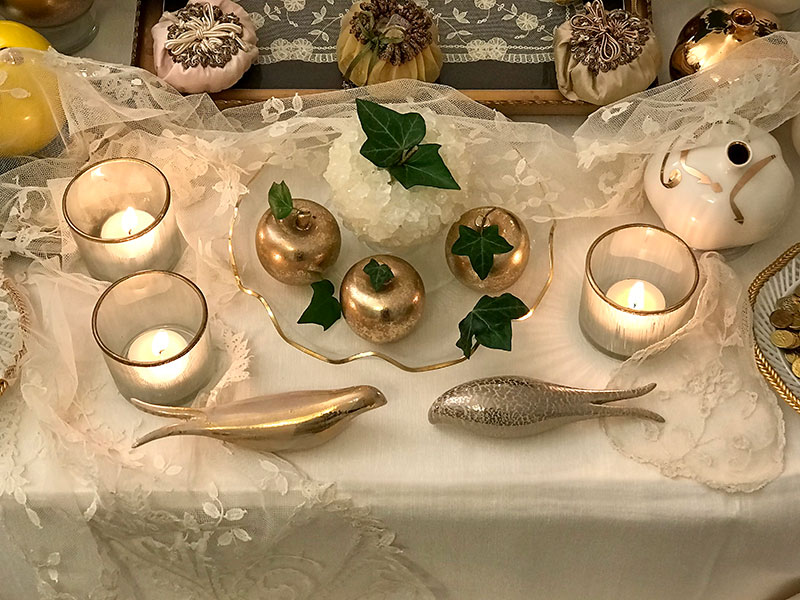
This delicate miniature ensemble sits in the centre of this soft marriage sofreh in ivory and gold. The crystal sugar (nabat), which is sculpted in the form of an apple, is presented in a fine glass vessel and is surrounded by miniature gold-finish sculptured apples. The arrangement is partially enveloped with fine antique lace and embellished with leaves of ivy. A pair of fine stylized gold- and silver-finish ceramic birds represents the couple. This central section is softly illuminated with the flames of tea lights.
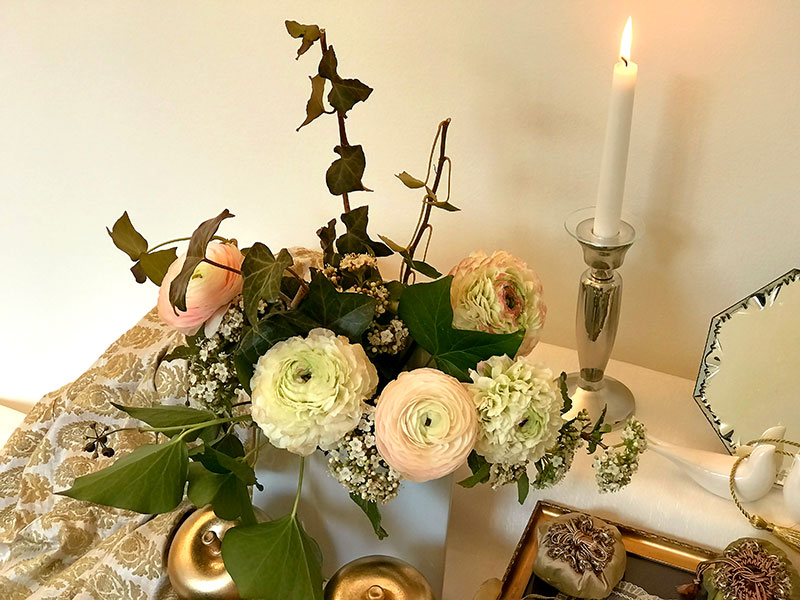
This is one of a pair of the bouquets with two different types of silky pastel ranunculi, known as Hanoi and Pompon (Pom Pom), alongside Viburnum tinus and varieties of ivy, which is placed on the left side of the sofreh. It is nicely presented against a backdrop partially composed of elegantly draped Indian silk with gold paisley motifs. The bouquet is softly illuminated with a single flame.
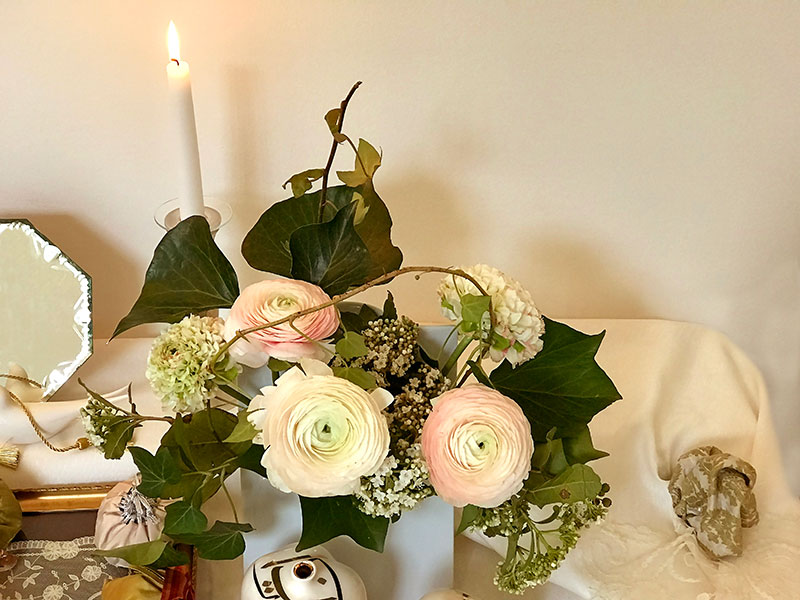
This is the other one of a pair of the bouquets with two types of silky pastel ranunculi, known as Hanoi and Pompon (Pom Pom), alongside Viburnum tinus and varieties of ivy, which is placed on the right side of the sofreh. To create a balance and repeat the design of the paisley motif, a nicely shaped sample of Indian silk is displayed in this corner, which is softly illuminated with a single flame.
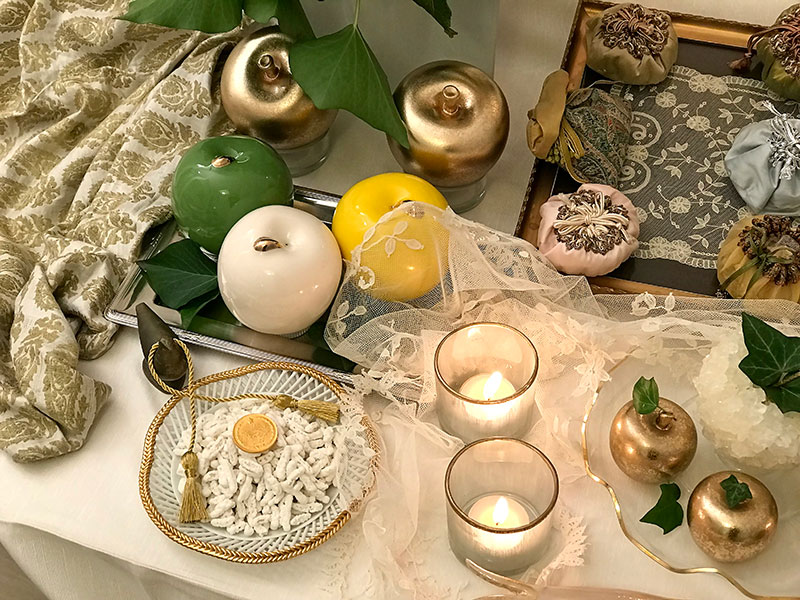
This is the left corner of the sofreh. A selection of sculptured apples, a symbol of life and fertility, adorn this corner. Persian sugared almonds (noql), a symbol of sweetness and harmony, are presented in an attractive vessel and embellished with fine gold tassels and a single gold coin. An antique bronze miniature bird statuette heralds good fortune. A few bonbonnières in soft tones are displayed on a platter lined with a piece of antique lace. This corner, which is softly illuminated with flames, is adorned with elegantly draped lengths of fine Indian silk with paisley motifs, and delicate antique lace.
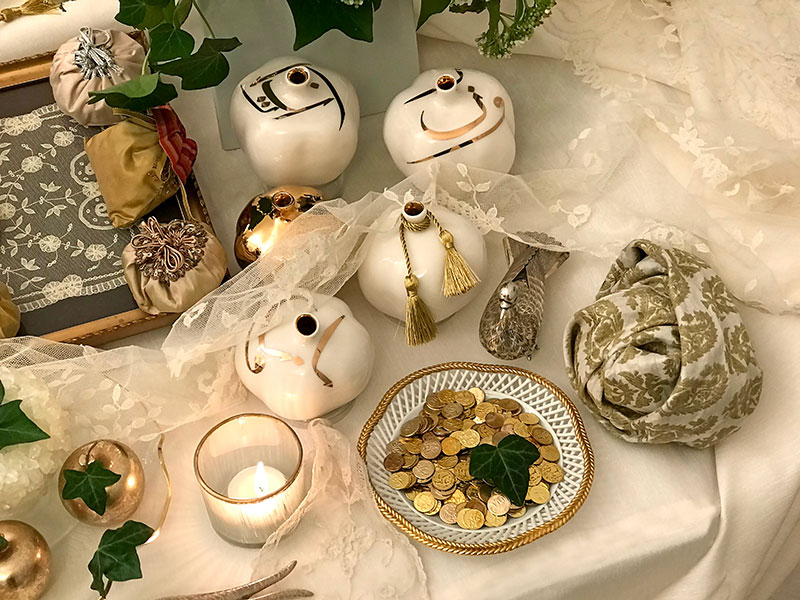
This is the right corner of the sofreh. A length of fine antique lace, woven around a selection of ceramic pomegranates, a symbol of life and fertility, adorns this corner. Gilded coins (sekkeh), a symbol of wealth and prosperity, are presented in an attractive vessel and embellished with a single leaf of ivy. An antique Russian silver bird statuette augurs good fortune. A few bonbonnières in soft tones are displayed on a platter lined with a piece of antique lace. A sample of nicely shaped Indian silk with paisley motifs embellishes this corner, which is softly illuminated with a single flame.
Echoes of Sofreh-ye aqd, May 2023
This soft and serene arrangement, which echoes a Persian marriage sofreh (sofreh-ye aqd), is created on and around lengths of fine antique ivory lace, complemented by light and feathery off-white peonies and embellished with sprigs of soft foliage. The emphasis is on a shiny, silky and subtle appearance.

This is the overall view of the Persian marriage sofreh (sofreh-ye aqd), which includes some of its symbolic elements, namely a mirror and candelabra (symbols of reflection and light), decorated eggs, gilded coins, sugared almonds, sculptured pomegranates and two bird statuettes which personify the couple.
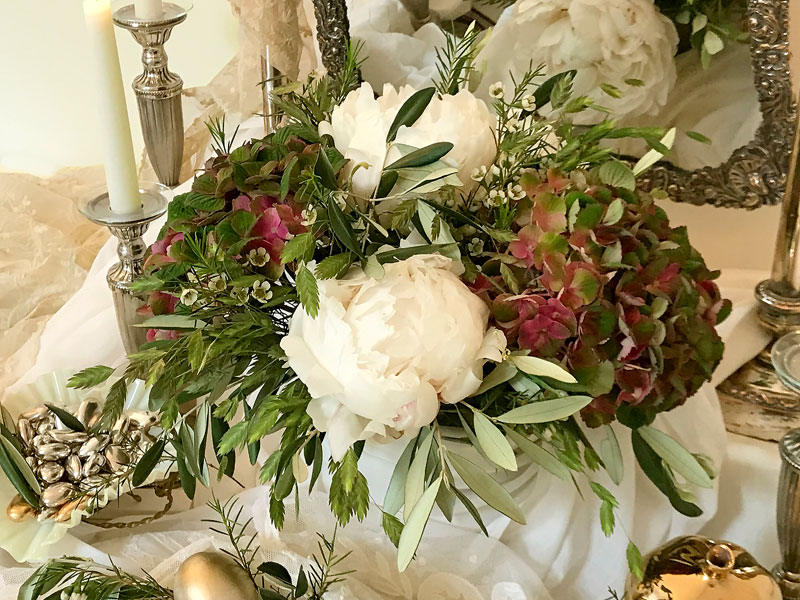
This delightful bouquet is placed at the heart of the soft and serene arrangement. It includes smoked red/pink/green hydrangeas, ivory peonies, wax flower and fine, graceful foliage. The bouquet is softly illuminated with flames and its reflection in the antique silver-plated mirror is simply stunning.
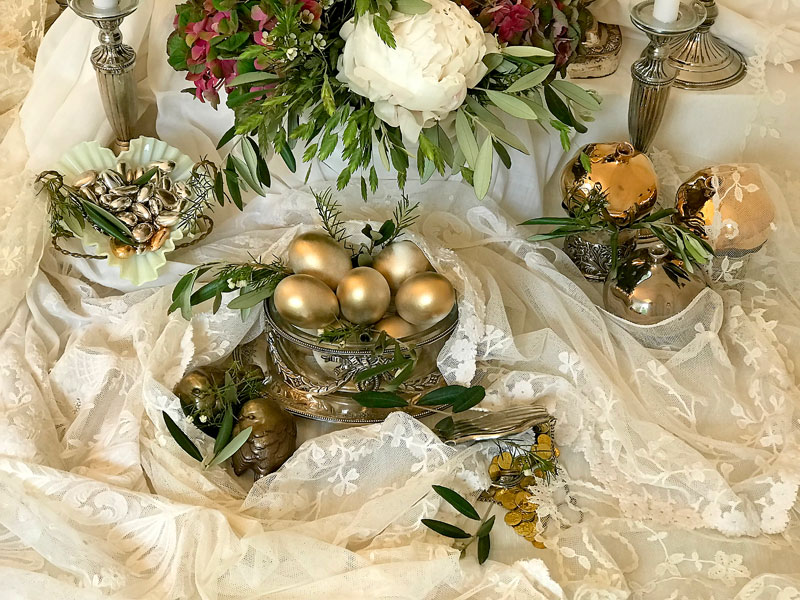
This is the central section of the sofreh. An antique vessel contains silver- and gold-finish sugared almonds. The ceramic pomegranates in a similar finish complement the arrangement. Gold-painted eggs are placed next to a pair of sculptured birds. Gilded coins pour out of an antique silver-plated purse. The arrangement is enhanced by the draped lengths of antique ivory lace and embellished with sprigs of foliage.

This image focuses on the gold-finish eggs, which are a symbol of life and fertility, presented in a crystal and silver-plated antique vessel. Two sculptured antique-gold-finish birds personify the couple. Gilded coins, which pour out of an antique silver-plated purse, are a symbol of wealth and prosperity. All the elements are softly draped in fine antique lace and embellished with sprigs of delicate foliage.
Echoes of Sofreh-ye aqd, April 2023
This harmonious, compact yet dazzling arrangement, which was inspired by the bouquets of ranunculi, anemones and Viburnum opulus, alludes to a Persian marriage sofreh (sofreh-ye aqd).
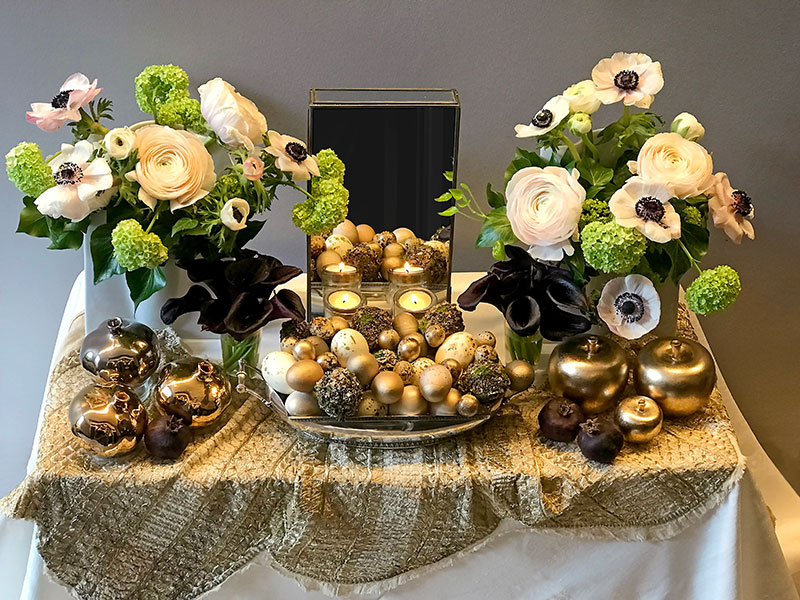
This is the overall view of the Persian marriage sofreh (sofreh-ye aqd) which includes a simple rectangular mirror, an impressive container of elegantly decorated eggs, a few vividly finished sculptured apples and pomegranates, as well as dried miniature pomegranates in a deep-burgundy tone. The sofreh is softly illuminated with the flames of a pair of tea lights. A length of antique ivory and metallic-gold Indian textile enriches the arrangement.
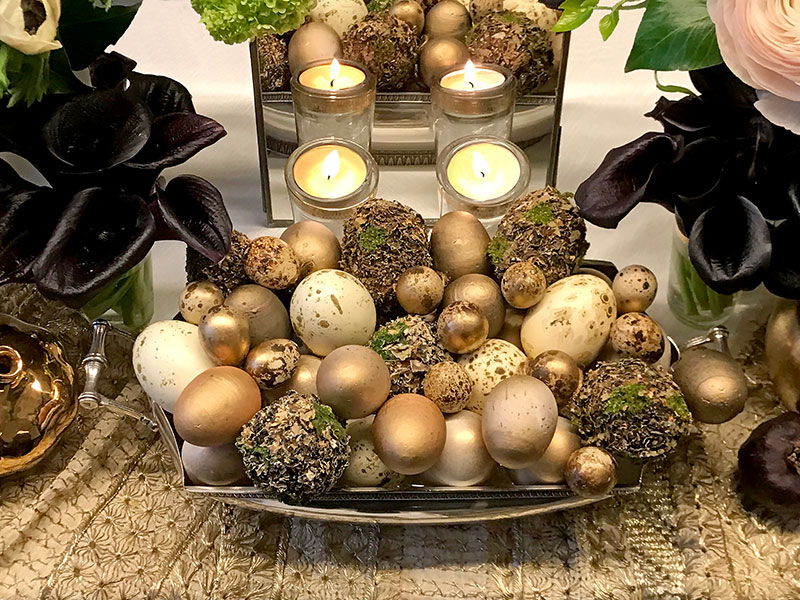
This is the heart of the sofreh. The focus of the image is on a selection of softly decorated eggs in subtle, neutral and gold tones. Eggs, which are a symbol of life and fertility, are often included in sofrehs for both marriage and for Nowruz. A pair of tea lights is presented in delicate gold-rimmed tea light holders. Their flames softly illuminate this section and their reflection in the mirror against the background of the decorated eggs is delightful.
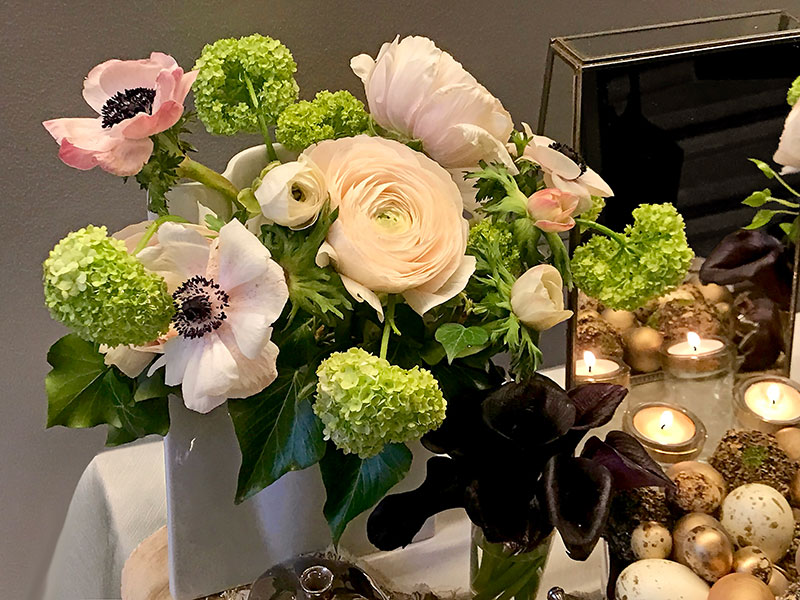
This is one of a pair of bouquets that inspired the creation of this Persian marriage sofreh. The bouquet is made of Hanoi ranunculi, anemones in pastel tones and Viburnum opulus. The black centres of the soft anemones are complemented by the miniature bouquet of Cantor black calla lilies, displayed below the larger bouquet.
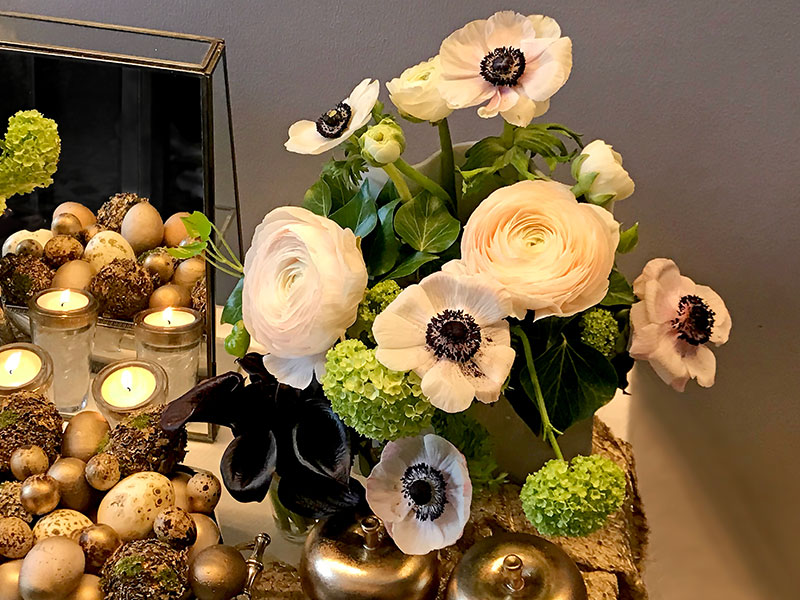
This is the other of a pair of bouquets that inspired the creation of this Persian marriage sofreh. This bouquet, too, is made of Hanoi ranunculi, anemones in pastel tones and Viburnum opulus. The black centres of the soft anemones are complemented by the miniature bouquet of Cantor black calla lilies, displayed below the larger bouquet.
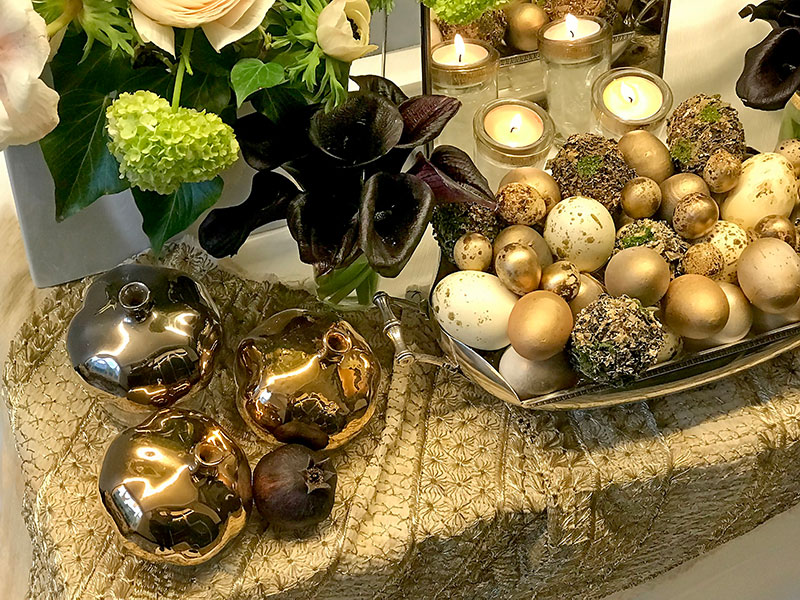
This is one corner of the sofreh. The focus of this image is the highly glazed ceramic pomegranates in metallic gold and silver, displayed on a length of antique Indian textile and next to a miniature dried pomegranate and a tiny bouquet of Cantor black calla lilies. Pomegranates, which are a symbol of fertility, are often included in sofrehs for both marriage and for Nowruz.
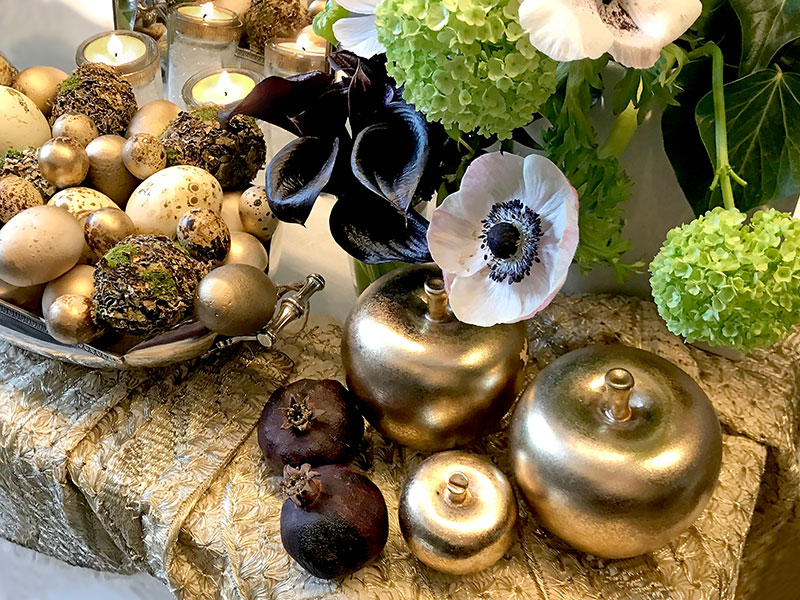
This is the other corner of the sofreh. The focus of this image is the stylized sculpted gold-finish apples and miniature dried pomegranates. The beauty of this corner is enhanced by the Cantor black calla lilies and open pastel anemone with a black centre. Apples, like pomegranates, are one the divine fruits (miveh-ye beheshti) and are a symbol of life and fertility.
Bejewelled Sofreh
Many Persian emblems and symbolic elements of the Persian sofreh appear in items of jewellery. This most original “bejewelled sofreh” is dedicated to showcasing this kind of jewellery.
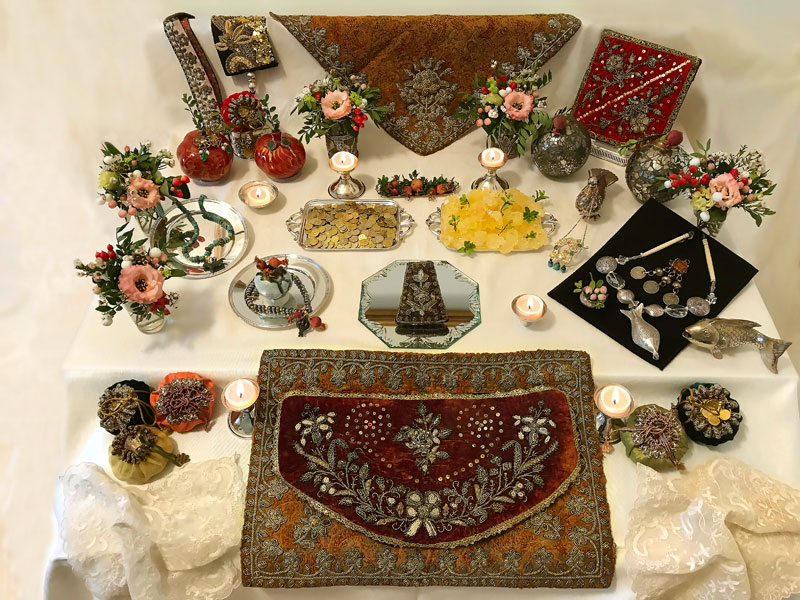
This is the overall view of the "bejewelled sofreh". Apart from the distinct jewellery, some intricate embroidery and jewel-like symbolic elements of the Persian sofreh (e.g. gilded coins and crystal sugar) are on display. A daintily embroidered antique pouch, placed on an antique Venetian mirror, takes centre stage. This delicate sofreh is embellished with miniature bouquets of flowers and foliage, and colourful pouches, which could hold the bride’s make-up, or gilded coins and Persian sugared almonds. The sofreh is softly illuminated with multiple flames.
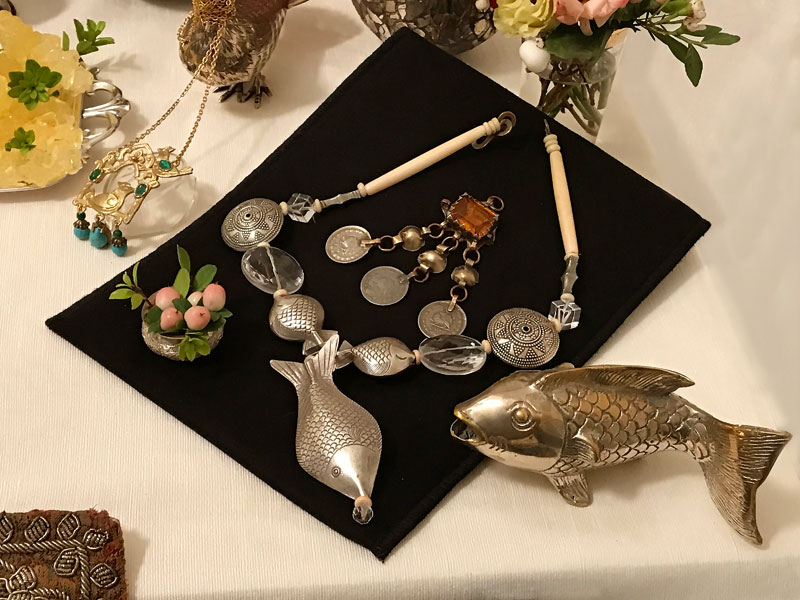
The focus of this image is the section that showcases an elegant necklace made of antique beads and statuettes of fish. To magnify the symbolic significance of the fish, which is included in the sofreh for Nowruz (sofreh-ye haft sinn), a sculptured fish is on display too. This corner also includes a silver pendant with Persian coins. The miniature composition is embellished with berries of Hypericum and delicate foliage. In the Persian tradition, fish is a symbol of plenitude and blessing, among other virtues, and coins signify wealth and prosperity.
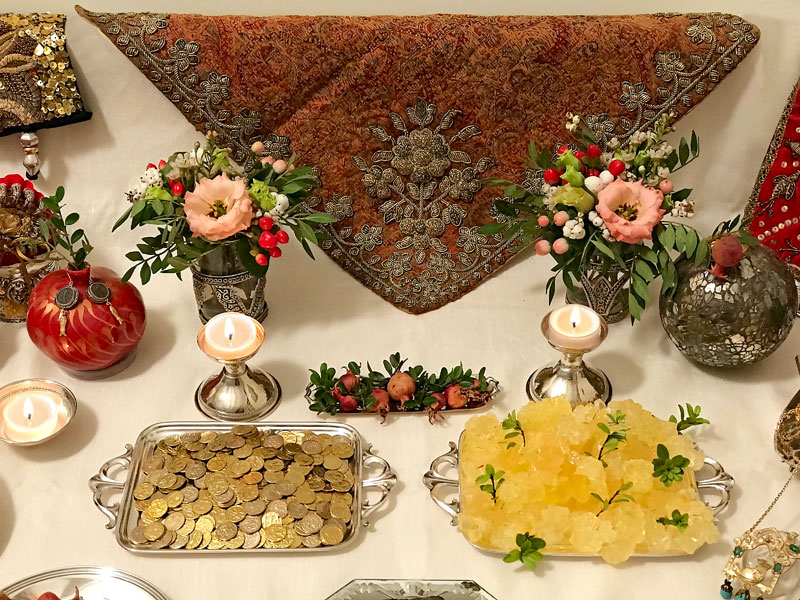
This is the heart of the "bejewelled sofreh". It showcases an intricately embroidered antique Persian textile, known as termeh, and a pair of small trays containing gilded coins (sekkeh, a symbol of wealth and prosperity) and crystal sugar (nabat, a symbol of sweetness and harmony). Both the gilded coins and crystal sugar possess a jewel-like quality. A miniature tray of ornamental pomegranates and foliage is placed between a pair of bouquets made of foliage, sprigs of berried plants (Hypericum and snowberries), dainty flowers and buds (Lisianthus and wax flower), which complement the beads and stones of the creative jewellery. A pair of flames softly illuminates the heart of the sofreh.
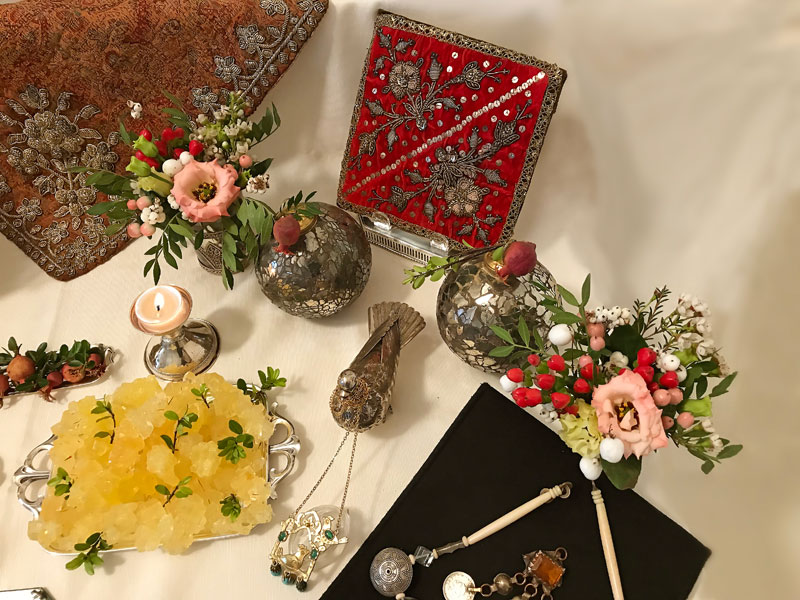
This corner of the sofreh focuses on a lovely antique piece of bright red velvet embroidered with metallic threads, seed-pearls and sequins. A pair of mirrored balls, embellished with ornamental pomegranates and foliage, symbolizes light and reflection—mirrors are always part of the Persian sofrehs for marriage and Nowruz. Sculptured birds are often included in the Persian marriage sofreh (sofreh-ye aqd). Here a charming necklace featuring birds, designed by Samira Vaziri (@samiravaziri_collections) and an antique Russian silver bird are on display. This corner, too, is embellished with delicate bouquets of flowers and foliage, and softly illuminated with a single flame.
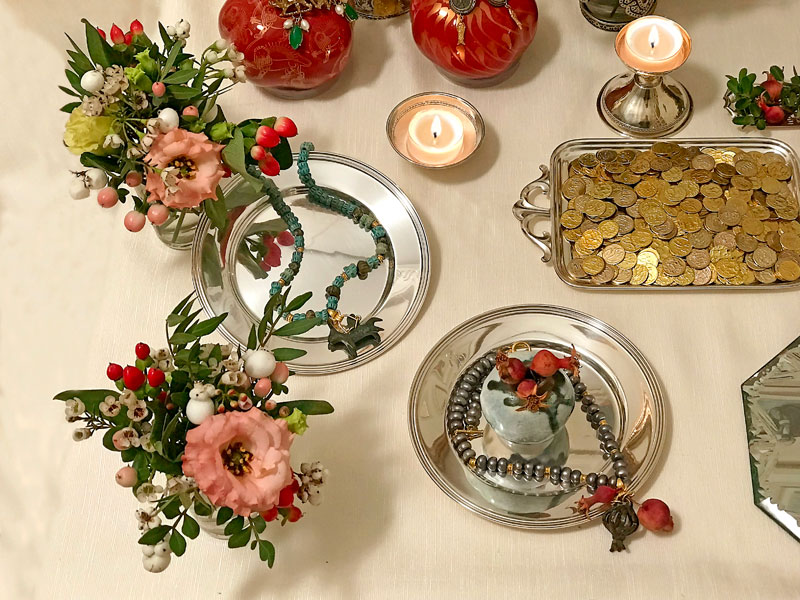
This section of the "bejewelled sofreh" is dedicated to two original and artistic Persian necklaces, designed by Lida Rafii, which are displayed on a pair of small plates. One necklace features a pendant of an ancient Luristan bronze animal figurine, hung on a string of new gold beads and ancient Achaemenid beads in turquoise shades. This colour is very much part of the Persian tradition—in design and especially in architecture. The other necklace showcases an ancient Luristan bronze pendant in the form of a pomegranate (a symbol of fertility and often part of the Persian sofreh), dangling from a string of sea pearls and gold beads. A delicate sculptured pomegranate in various shades of blue, by Raaz Pottery, London (@raazpottery), is on display, and this miniature arrangement is embellished with ornamental pomegranates.

The focus of this image is a section of the "bejewelled sofreh", which showcases two very different pairs of handmade earrings, displayed on ceramic pomegranates designed by Keyvan Fehri (www.keyvanfehri.com). The first earrings, by Samira Vaziri, feature a crown and a "lion and sun" emblem, which carry important significance in the Persian culture. The second earrings, designed by Lida Rafii, feature ancient gold sculptured fish and silver coins of Elymais. The gold depictions on the pomegranates ("lion and sun", and fish) complement the design of the earrings. This section is embellished with a delicate bouquet of flowers and foliage, embroidered ribbons and a bright red velvet pouch, which may contain the bride’s make-up, or coins and Persian sugared almonds (noql), a symbol of sweetness and harmony.
Yalda and Christmas, January 2023
In 2022, around the winter solstice (Shab-e Yalda) on 21 December and Christmas, an original compact sofreh, inspired by the traditions of both celebrations, was created and presented on the social media pages of SOFREH. The arrangement showcases some customary elements from the sofrehs for Shab-e Yalda (e.g. samovar, red fruits) and Christmas decorations (e.g. Christmas foliage and lights). To read more about Shab-e Yalda please scroll down to Shab-e Yalda, Winter Solstice, December 2021.
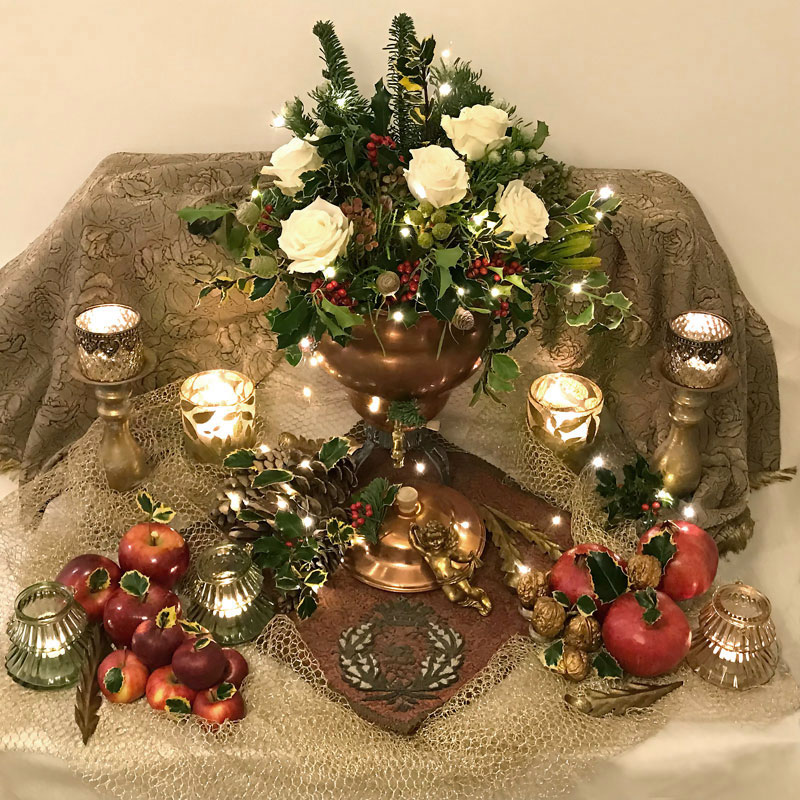
This is the overall view of the innovative sofreh, which includes an impressive bouquet of Christmas foliage and white roses embellished with Christmas lights and presented in a samovar. A gold-finish statuette of an angel, gold-painted walnuts, pine cones, sprigs of fir and leaves and sprigs of holly all echo the traditions of Christmas. Red fruits, especially pomegranates, are an important component of the sofrehs for Shab-e Yalda, which often include antique Persian textiles too. Lengths of metallic-gold textile and open mesh enliven this sofreh. Red apples and numerous flames, which are part of the decorations of both traditions, are also featured.
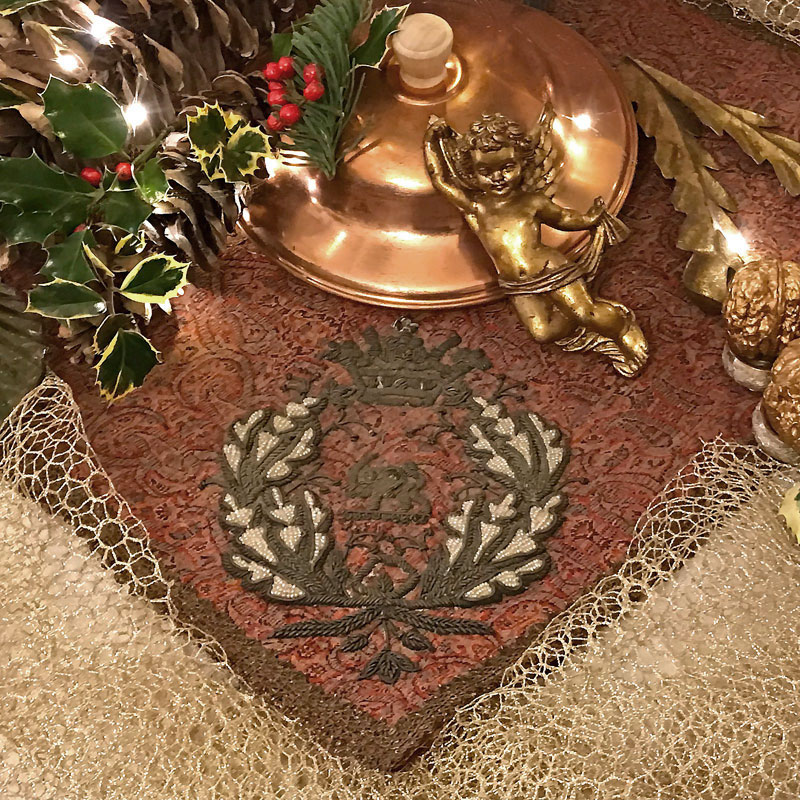
Persian textiles, especially fine antique ones that have been handed down by previous generations, are often included in sofrehs for any occasion. The focus of this image is the finely embroidered length of an antique Persian textile, known as termeh. Metallic threads and seed-pearls are employed to create lovely tendrils, as well as a crown and a "lion and sun" emblem, which have important significance in the Persian culture. The juxtaposition of the gold-finish angel, which is often included in Christmas decorations, and the embroidered termeh, which is usually part of the sofrehs for Shab-e Yalda, creates an unusual combination.
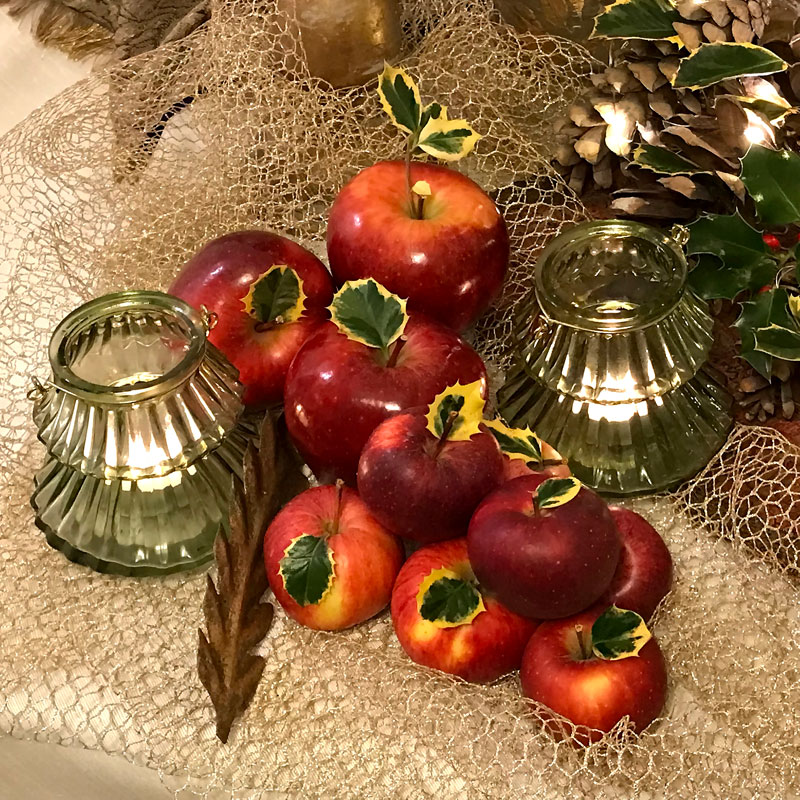
The focus of this image is a selection of shiny red apples in various sizes, embellished with sprigs and leaves of variegated holly and softly illuminated with flames of tea lights, placed inside charming holders shaped like Christmas trees. Red fruits are an important part of the sofrehs for Shab-e Yalda, and red apples and, of course, holly are often included in Christmas decorations.
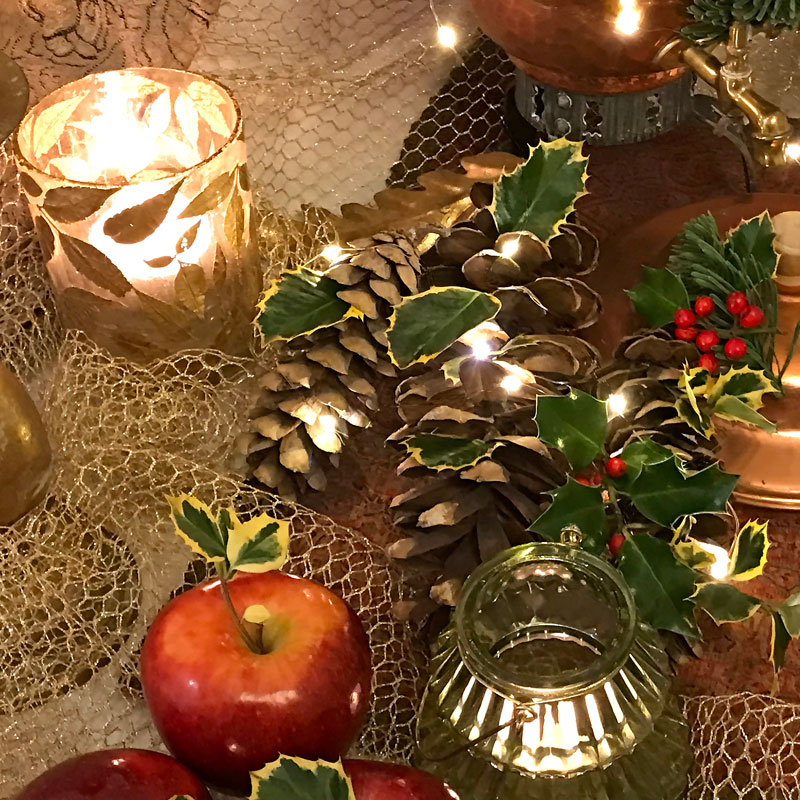
The focus of this image is a selection of oversized pine cones, embellished with sprigs and leaves of berried and variegated holly. This corner is softly illuminated with miniature Christmas lights and flames of tea lights, placed inside elegant holders. Pine cones and holly are often included in Christmas decorations, while flames are part of the decorations of both traditions.

The focus of this image is the bouquet of Christmas foliage embellished with miniature Christmas lights. The arrangement mainly includes sprigs of fir (Abies) and varieties of berried holly (Ilex), including the variegated type. The full white roses are known as Playa Bianca. The arrangement is placed inside a European copper samovar. Samovars are often included in the sofrehs for Shab-e Yalda to serve tea during the long night of getting together, reciting poetry and celebrating. Flames below the bouquet provide a soft illumination.
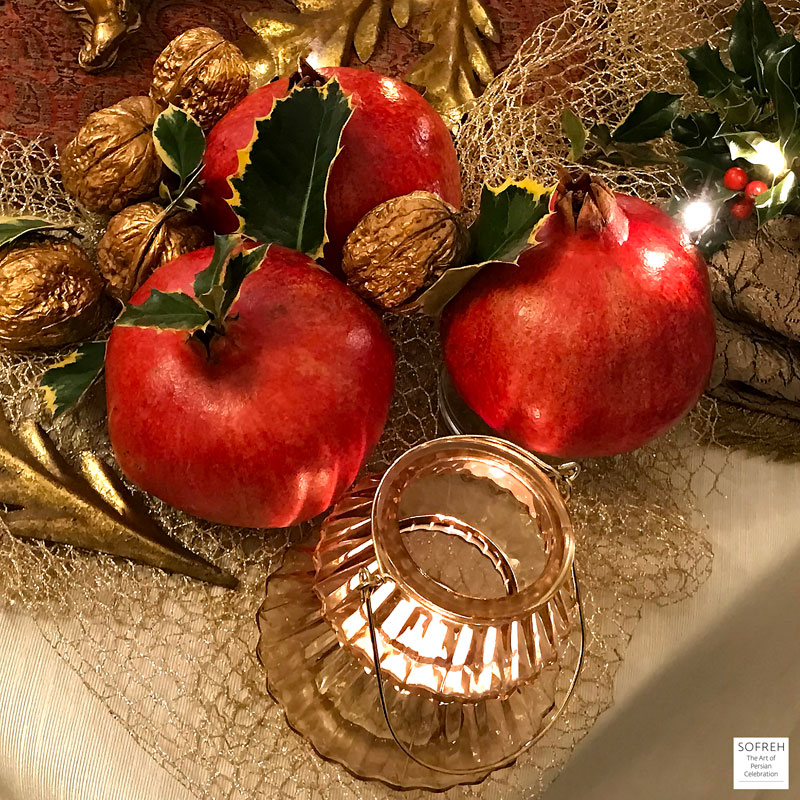
The focus of this image is a group of oversized shiny pomegranates and gold-finish walnuts, embellished with sprigs and leaves of variegated holly and Christmas lights, and softly illuminated with the flame of a single tea light, placed in an elegant, Christmas tree-shaped holder. Red fruits, especially pomegranates, are an important part of the sofrehs for Shab-e Yalda and decorated walnuts are often included in Christmas decorations. The muted-gold, open mesh, woven around the elements, enhances the beauty of this section.
Echoes of Sofreh-ye aqd, November 2022
This delightful serene arrangement, which was inspired by the impressive bouquet of hydrangeas, snowberries and foliage placed at the heart of the display, alludes to a Persian marriage sofreh (sofreh-ye aqd). It includes some of the symbolic elements of the marriage sofreh.
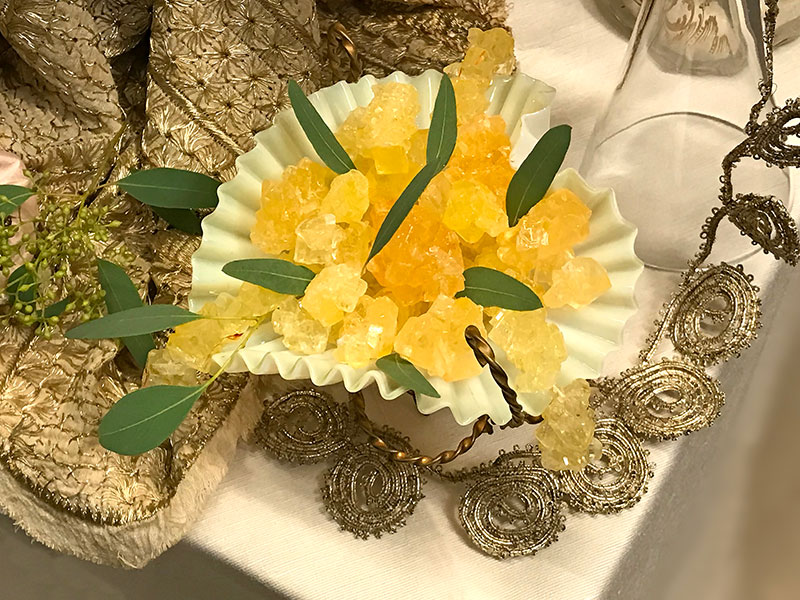
The focus of this image is the delicate, antique opaline container of jewel-like pieces of crystal sugar (nabat), which is a symbol of sweetness and harmony. Here it is embellished with the delicate and fragrant leaves of Eucalyptus. The fine antique textile and trim enhance the beauty of this corner.
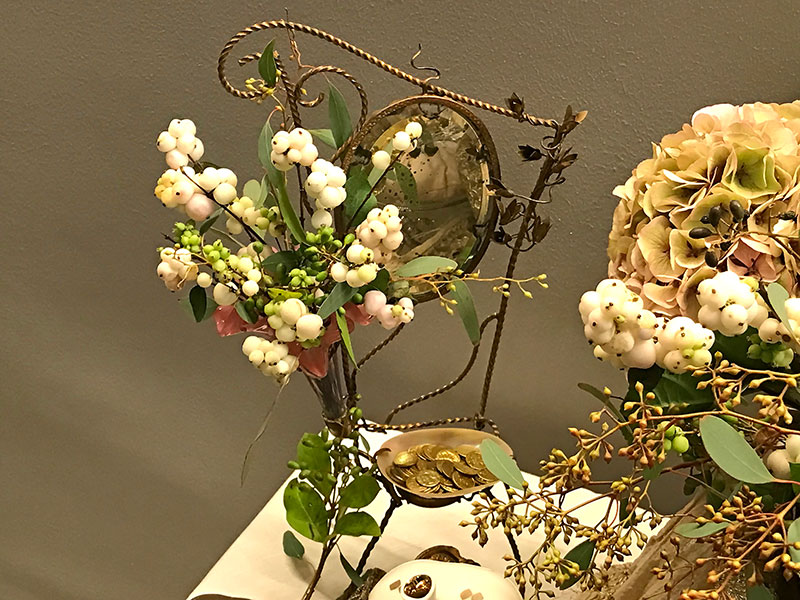
This distinctive antique mirror stand with a pink opaline vase contains a delicate bouquet made of the foliage that is included in the principal bouquet of flowers of the sofreh. Snowberries brighten up this November marriage sofreh (sofreh-ye aqd). The delicate vessel on the bottom of the stand showcases gilded coins (sekkeh), a symbol of wealth and prosperity.
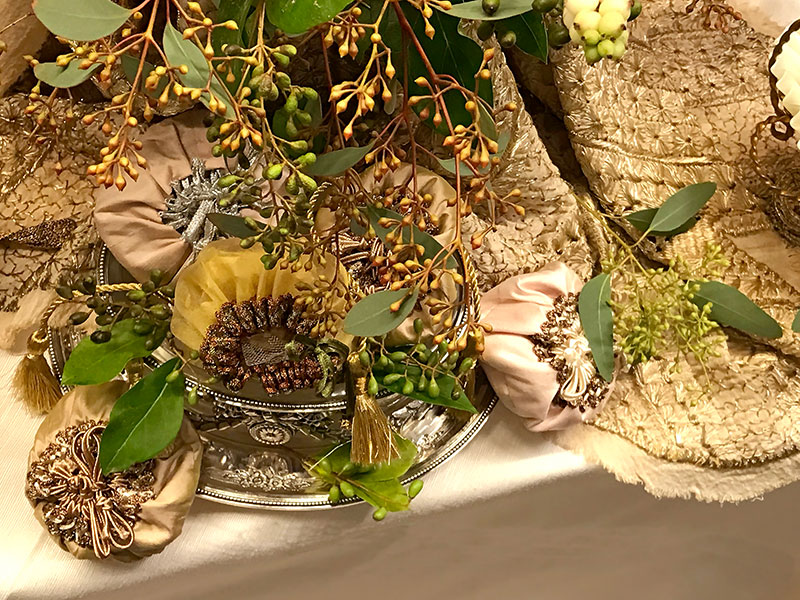
This small selection of bonbonnières in pastel shades, tastefully created in the Persian spirit, are displayed at the front of the sofreh. They are beautifully presented against the background of a length of metallic gold and ivory antique Indian textile, in and around an antique crystal and silver-plated container, and are embellished with fine gold tassels and foliage.
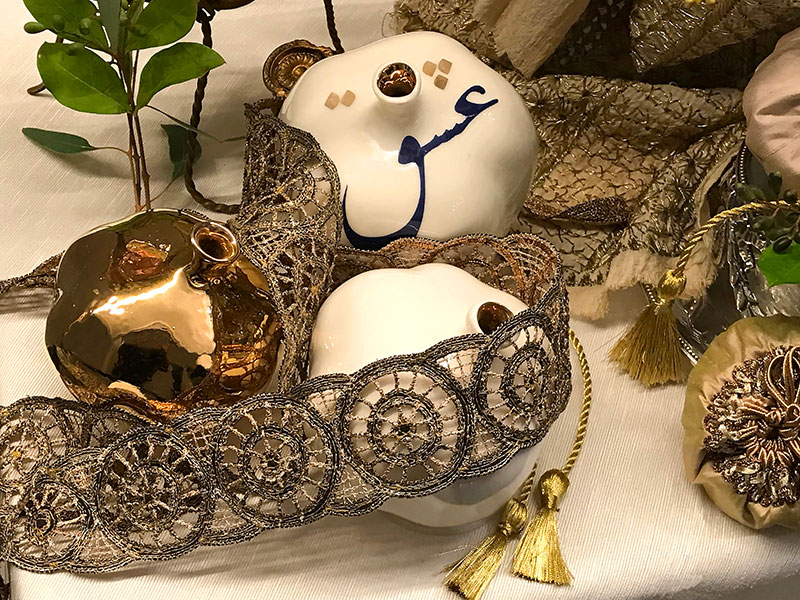
Pomegranates are a symbol of fertility in the Persian culture, as in many other traditions. These delightful ceramic pomegranates, one of which is inscribed with the word “love” (eshq) in Persian, are a fitting addition to this marriage sofreh. Lengths of decorative trim are elegantly woven around the highly glazed sculptured pomegranates.
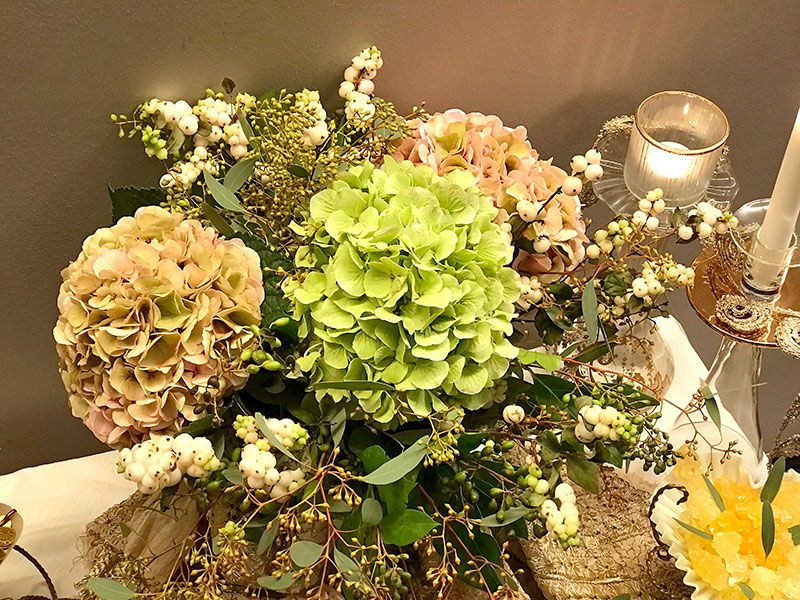
The inspiration for creating this marriage sofreh was this spectacular bouquet of My Vienna Classic and Verena Classic hydrangeas in pastel shades of pink and green, together with snowberries (Symphoricarpos), Eucalyptus populus and Ligustrum vulgare. The vase is elegantly draped in a length of fine antique Indian textile in ivory and metallic gold.
Jashn-e Mehregan
October 2022. Jashn-e Mehregan is an Iranian festival which is apparently dedicated to the god of Mithra (Mehr). See more on http://www.iranicaonline.org/articles/mehragan. Very briefly, in the Persian culture, Mehregan is believed to have the same significance as Nowruz, with Nowruz signalling the beginning of spring and Mehregan marking the arrival of autumn. The celebrations, which have their origins in the pre-Islamic period and are associated with agriculture and harvest, are usually held between 16 and 21 Mehr in the Persian calendar, which correspond to 8 and 13 October. Although in the past sofreh was part of the Mehregan customs, in modern times, it is not.
This year, to pay homage to Jashn-e Mehregan, two sofreh arrangements, which include a variety of apples, were created in autumnal shades. Both bring out the best of the beauty, tone and form of the apples which herald the harvest season. The details of each sofreh appear below the relevant overall image.

This first sofreh, created for Jashn-e Mehregan, which is softly illuminated with flames, features an oversized apple, as well as small ones. The unusually large apple is deliberately presented by itself in the centre in order to better emphasize its size. Bouquets of flowers and foliage are placed on lengths of draped yellow/orange antique Persian textile, known as termeh.
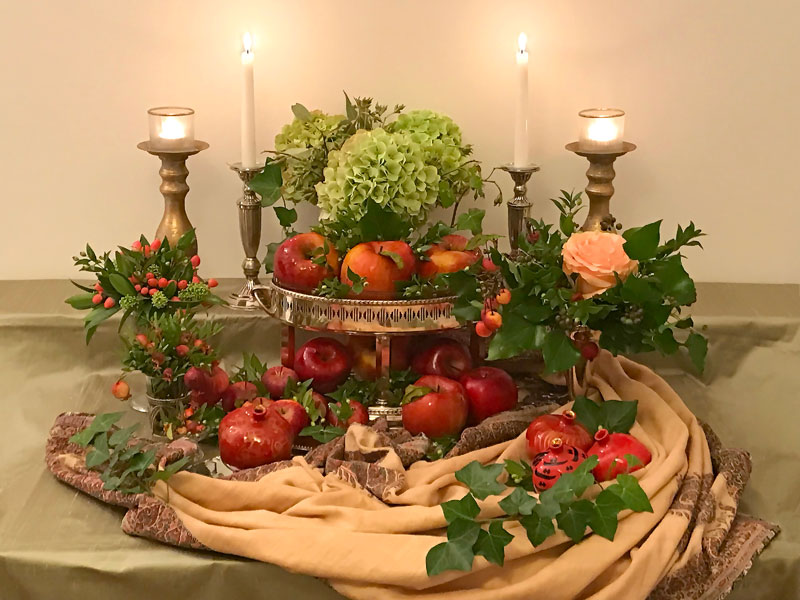
This second sofreh, created for Jashn-e Mehregan, showcases a variety of apples in a two-tiered, antique silver-plated vessel, which is placed against a bouquet of pale green hydrangeas and is illuminated with flames. More flowers and foliage, as well as fresh ornamental and ceramic pomegranates and a length of draped antique Persian silk, are part of this arrangement.
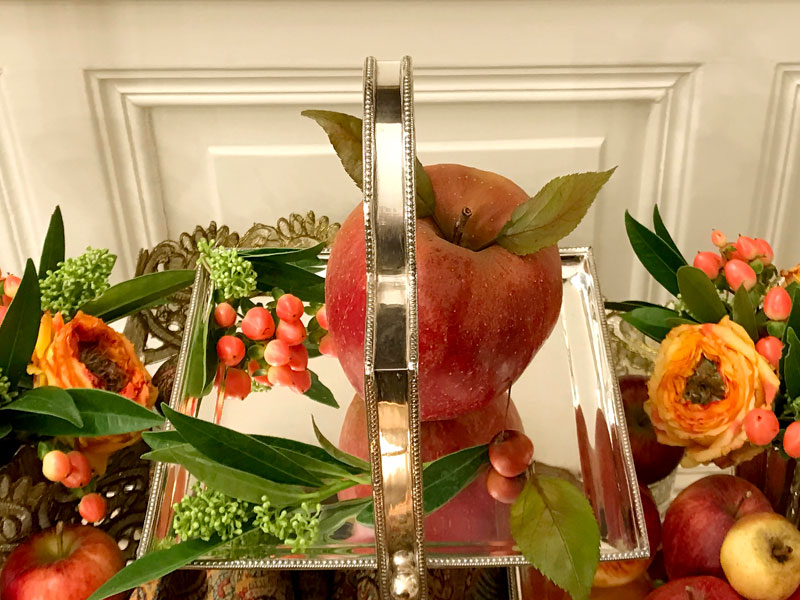
The focus of this image is the heart of the first sofreh. The sizeable apple is placed on the top tier of the sectional silver-plated receptacle. Apples, numbered among the divine fruits (miveh-ye beheshti), herald the harvest season. This central section is embellished with foliage and the reflection of the copious apple and the cuttings is particularly appealing.
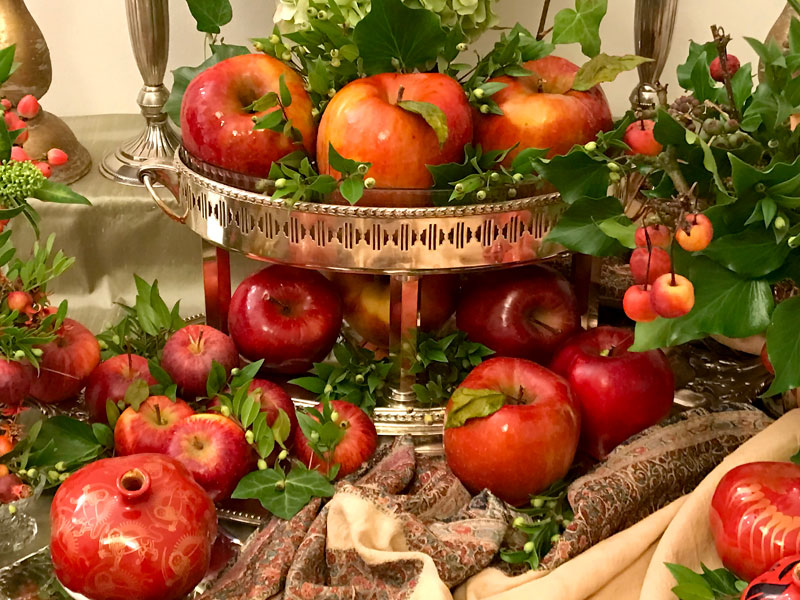
The focus of this image is the central section of the second sofreh. Unlike the heart of the first sofreh, which is fairly simple, the heart of the second sofreh is very elaborate. The two-tiered, antique silver-plated container showcases a variety of apples in different sizes, embellished with foliage. The folds of the draped antique Persian textile add an extra dimension.
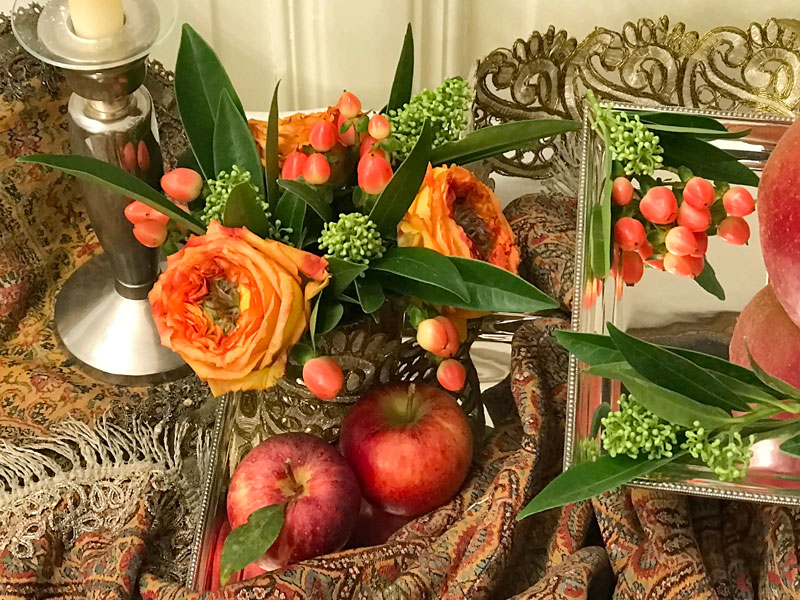
This is the left side of the first sofreh. Once again a dainty bouquet of deep-orange roses, known as Samoa, Skimmia and Hypericum, embellish this section. A pair of petite apples heralds the harvest season. This section nicely reveals the folds and movement of the draped lengths of termeh, together with a length of the trim.

This is the left side of the second sofreh. A bouquet of Hypericum, Skimmia and Ligustrum, and a bouquet of ornamental pomegranates and foliage, as well as a bright red ceramic pomegranate embellish this corner. Pomegranates, also numbered among the divine fruits (miveh-ye beheshti), herald the harvest season.
Echoes of Sofreh-ye aqd, September 2022
Anthuriums are not part of Persian traditions. However, this impressive, oversized single flower, known as Amigo, was the inspiration for creating this compact composition, which alludes to a Persian marriage sofreh (sofreh-ye aqd).
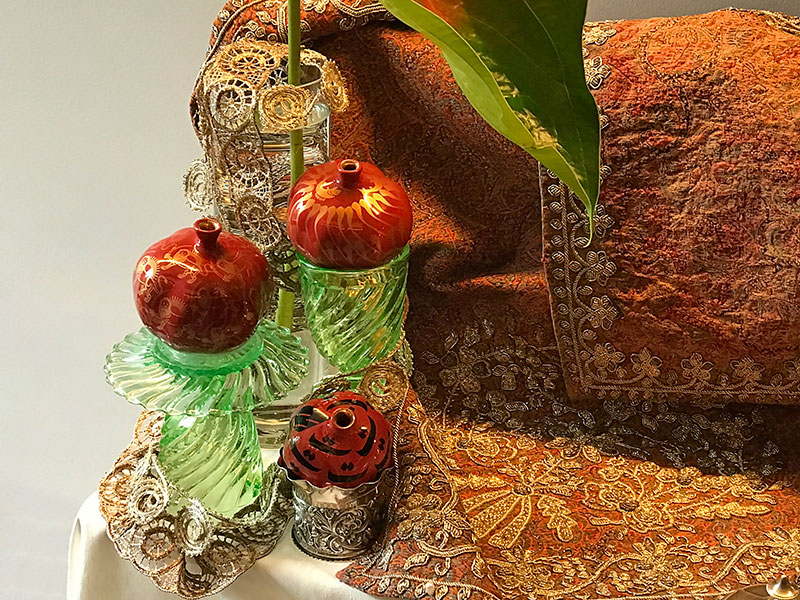
These shiny red ceramic pomegranates are primarily presented on top of Persian ribbed glass vessels. A length of antique Persian metallic trim is elegantly woven around the containers which showcase the pomegranates. The intricate gold embroideries on the lengths of termeh are clearly visible in this corner.
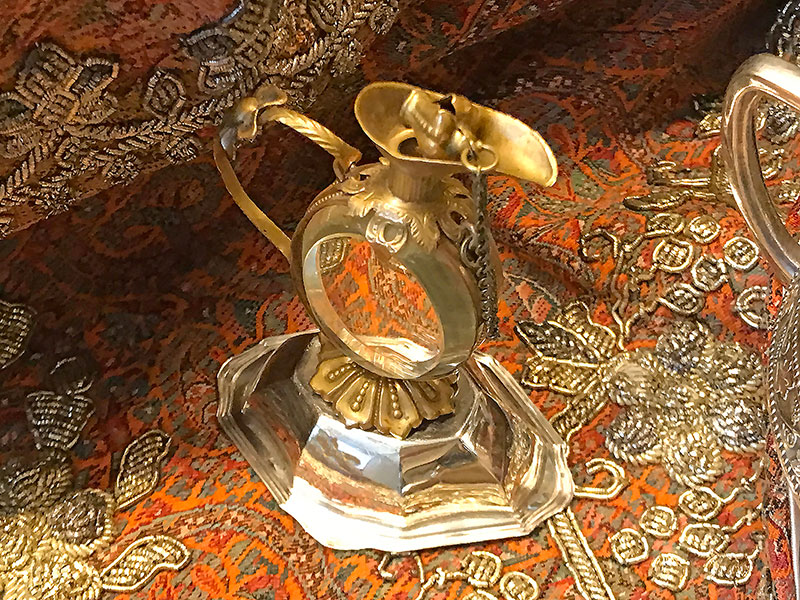
This exquisite antique miniature mirrored flask contains rosewater to perfume the air and has been elegantly placed on an antique miniature silver vessel. Rosewater (golab) is an important part of Persian culture and culinary tradition. Mirrors are a symbol of light and reflection and this delicate miniature jug has the hint of a mirror, which reflects the weaves of the termeh.
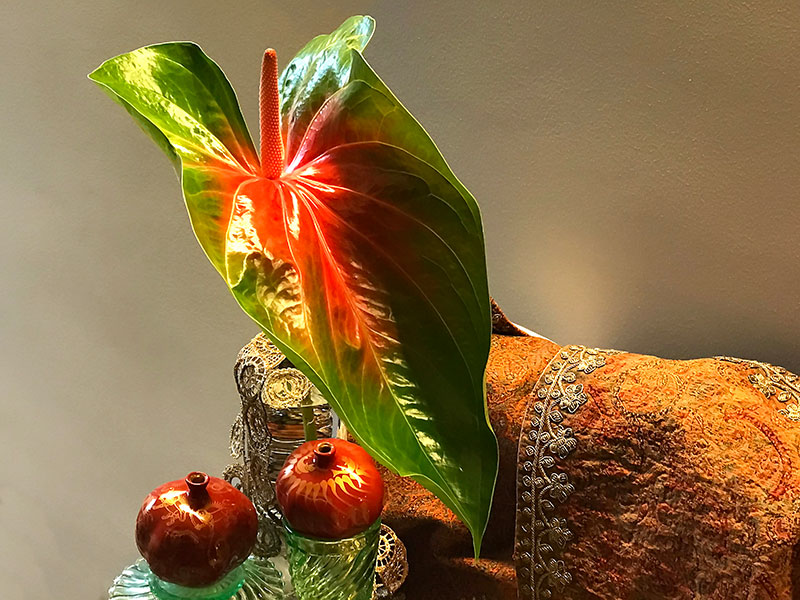
It is appropriate to end the presentation of the details of this compact marriage sofreh (sofreh-ye aqd) with the close-up of the impressive flower that inspired the design. This truly spectacular and unusually large anthurium in bright green and red, known as Amigo, perfectly complements the shiny red ceramic pomegranates presented on top of Persian green glass vessels.
Echoes of Sofreh-ye aqd, August 2022
This pleasant arrangement with a predominantly silver colour scheme alludes to a Persian marriage sofreh (sofreh-ye aqd). It includes a few of the symbolic elements of the sofreh.
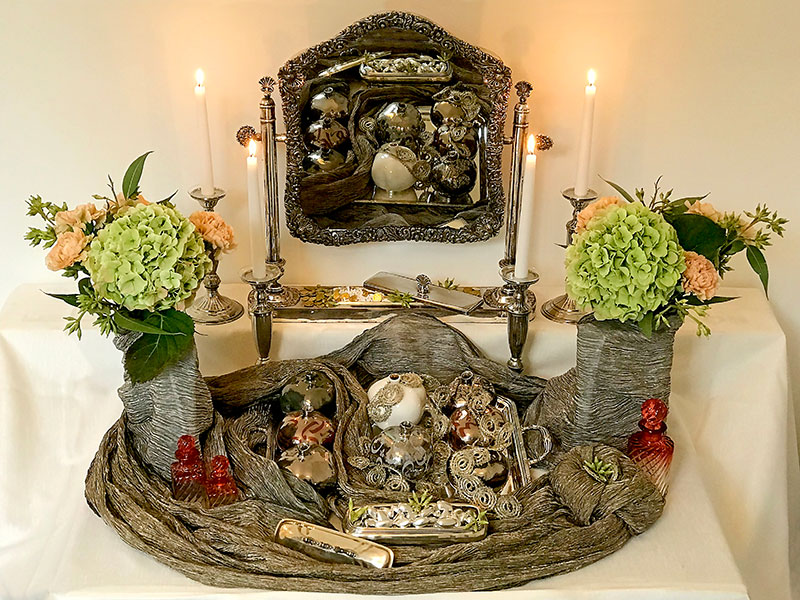
This is the overall view of the sofreh, which beautifully reveals the reflection of some of the symbolic elements in the antique silver-plated ornate mirror. A tray of brightly glazed ceramic pomegranates takes centre stage. This delightful sofreh showcases a pair of bouquets of hydrangeas, carnations and foliage, and is softly illuminated with flames.
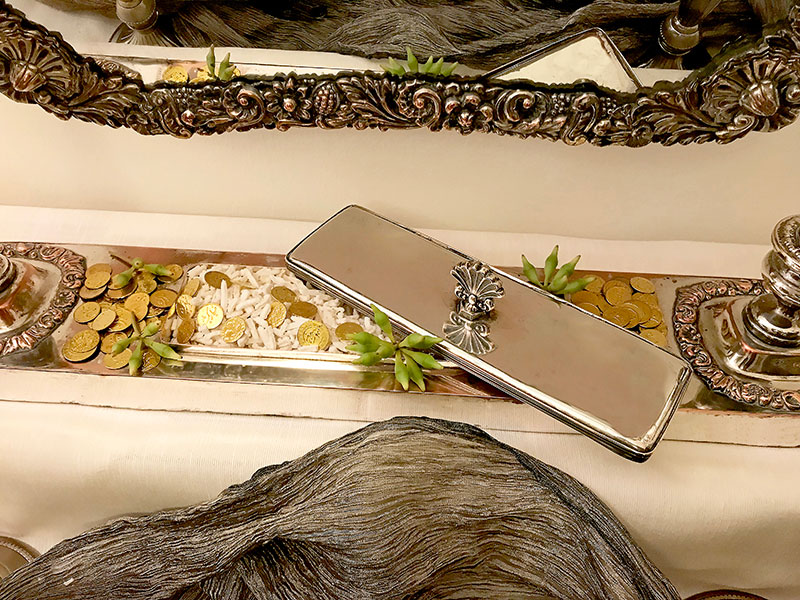
This section focuses on the box on the base of the mirror, which contains gilded coins (sekkeh) and Persian sugared almonds (noql), respectively symbols of wealth and prosperity, and sweetness and harmony. The gilded coins gently flow out of the box whose attractive lid with ornate knob is displayed at a slant. This section is embellished with buds of Eucalyptus robusta.
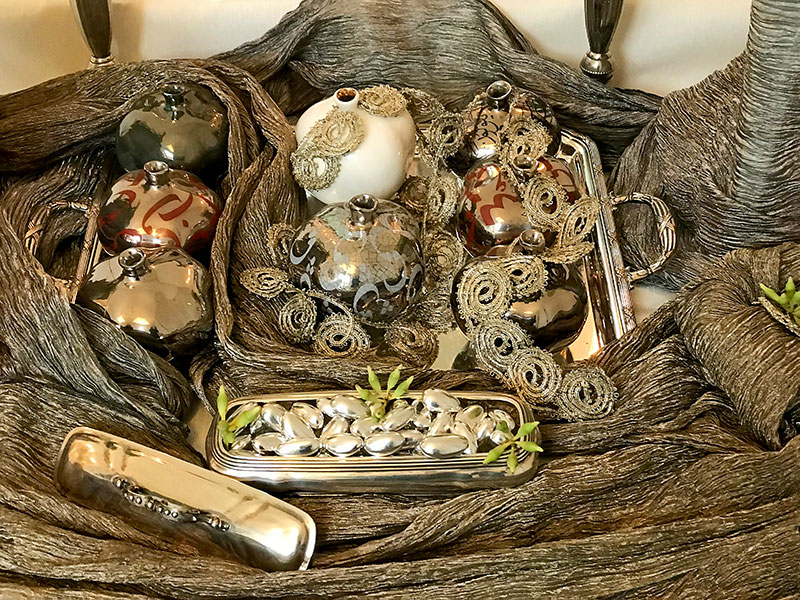
At the heart of the sofreh, delightful ceramic pomegranates, which are the work of the Iranian artist, Keyvan Fehri www.keyvanfehri.com, can be seen in white and silver tones, some embellished with Persian calligraphy. Lengths of silver- and gold-textured textiles, as well as antique Persian metallic-silver trims are elegantly draped around the pomegranates. An antique Russian silver box, with its attractive lid displayed at a slant next to it, contains silver-finish sugared almonds embellished with buds of Eucalyptus robusta.
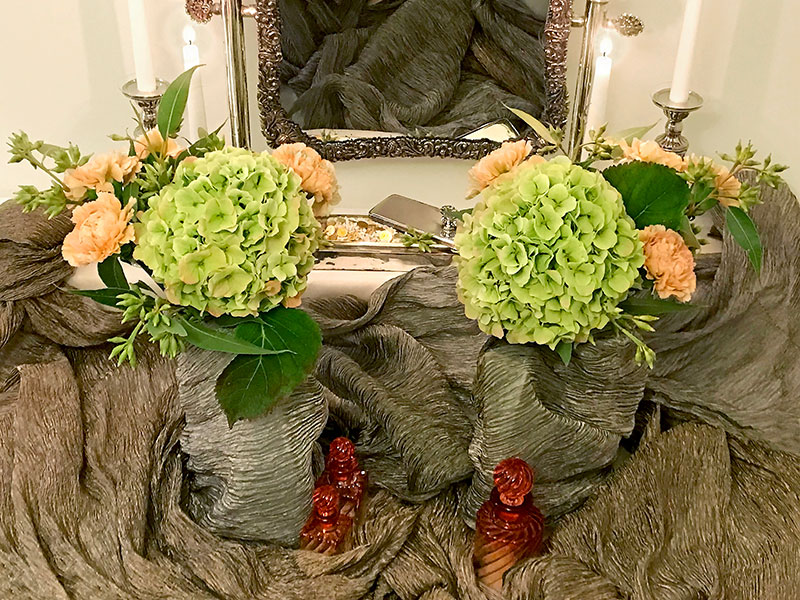
In order to better showcase the pair of soft bouquets of this marriage sofreh, the arrangement is altered here, and the bouquets are placed closer together. These two lovely bouquets of pastel green hydrangeas, Caramel carnations and Eucalyptus robusta, which are softly illuminated with flames, adorn and brighten the composition. Antique, shapely coloured-glass flasks contain rosewater (golab) to perfume the air. The movement of the gracefully draped textured textile and its reflection in the mirror are truly elegant.
Echoes of Sofreh-ye aqd, May 2022
During May 2022 three vivid arrangements were presented, which allude to a Persian marriage sofreh (sofreh-ye aqd). They were inspired by the striking bouquets of flowers, illuminated with flames.
Echoes of Sofreh-ye aqd, April 2022
During April 2022 two soft arrangements were presented, which allude to a Persian marriage sofreh (sofreh-ye aqd). The inspiration for both was the splendid bouquets of flowers and foliage, illuminated with flames.
Ornamental Pomegranates
This dainty arrangement was inspired by sprigs of fresh ornamental pomegranate, which are displayed on a Venetian-style mirror and in a miniature cup and saucer. It alludes to a Persian marriage sofreh (sofreh-ye aqd) and comprises pomegranate-shaped candles, mirrors, miniature vessels of rosewater (golab) to perfume the air, gilded coins (sekkeh, a symbol of wealth and prosperity), sugared almonds and crystal sugar (noql o nabat, which are symbols of sweetness and harmony).
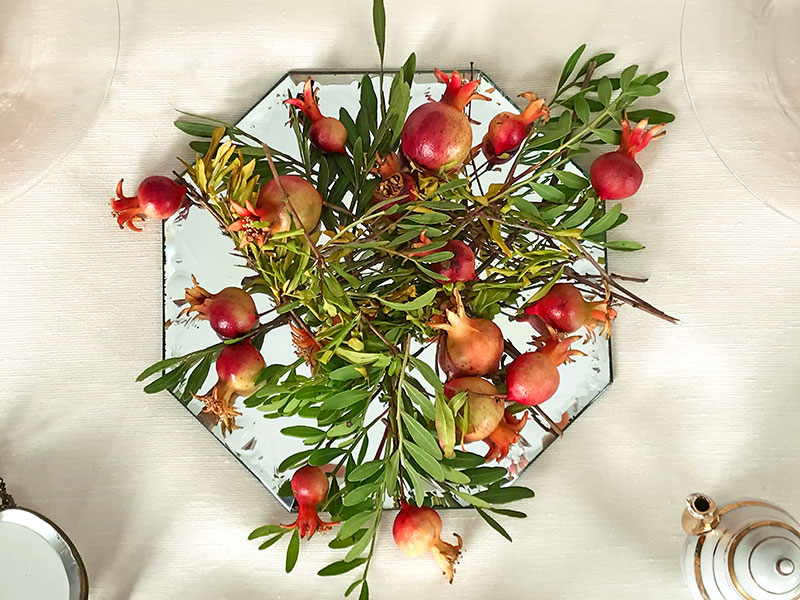
This is the heart of the sofreh. Sprigs of ornamental pomegranate are not easily available and are an invaluable addition to any sofreh. With their abundance of seeds, pomegranates are a symbol of fertility and a significant part of the Persian culture—in celebrations and cuisine. Mirrors are a symbol of reflection and light, and here the sprigs of pomegranate are displayed on a Venetian-style cut glass mirror.
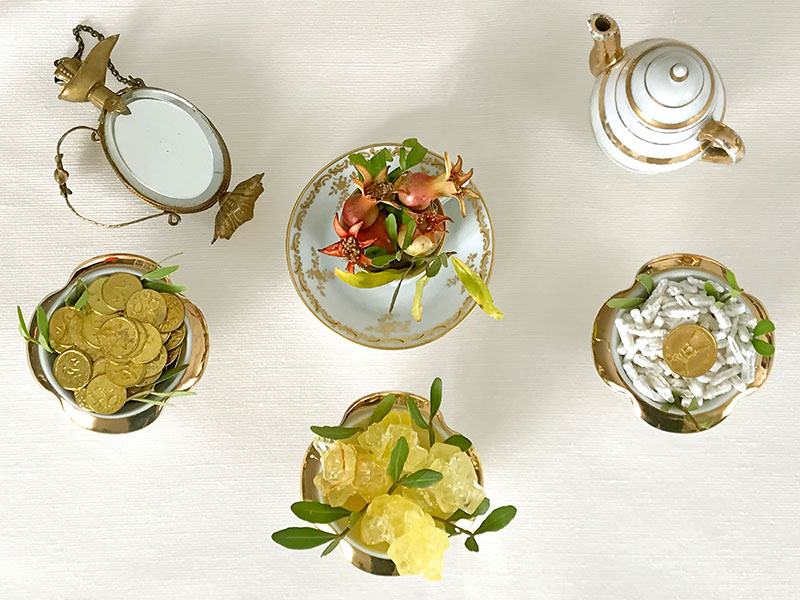
This is a birds-eye view of a section of the sofreh. The mirrored miniature urn and the white and gold teapot contain rosewater. The miniature cup and saucer showcase a few sprigs of the ornamental pomegranate. Three identical white and gold miniature vessels, which are adorned with ornamental pomegranate sprigs, contain gilded coins, crystal sugar and sugared almonds embellished with a gilded coin.
Shab-e Yalda, Winter Solstice
December 2021. Shab-e Yalda, the winter solstice, is the longest night of the year. It is the eve of 1 Dey in the Persian calendar, corresponding to 21 December. The feast of Yalda originates in the pre-Islamic period and is associated with agriculture. The divan-e Hafez (works of 14th-century Persian poet, Hafez) to recite poetry, and red fruits—watermelons and pomegranates—are important parts of this celebration, heralding the crimson hues of sunrise after absolute darkness, and the promise of longer days ahead. It is the celebration of the passing of darkness and the rebirth of the sun. Interestingly, Shab-e Yalda is only about one minute longer than the preceding night. In the Persian tradition people get together, tea, sweets, nuts and fruits are served, and stories and poetry are recited and fortunes are told, to get through the darkest and longest night of the year, when it is believed that demons are most active.

This is the overall view of the contemporary sofreh designed for Shab-e Yalda, with an array of elegantly draped, fine textiles as a backdrop. It includes an antique silver-plated European samovar and an antique ceramic teapot, dried fruit & nuts, sweets, fresh red fruits, flowers, flames and a tastefully bound and presented book of verse (divan-e Hafez).
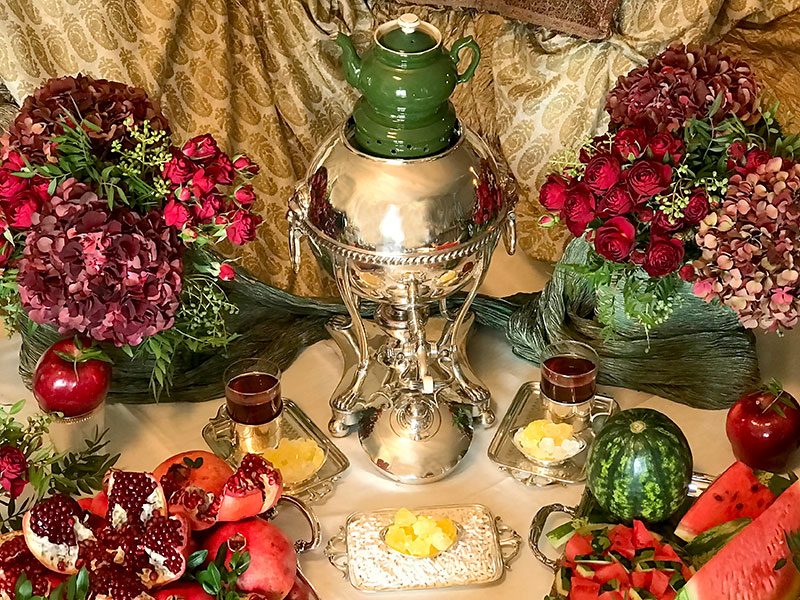
This is the heart of the sofreh for Shab-e Yalda. To serve tea for the occasion, the antique samovar and the green glazed ceramic teapot take centre stage. Nogl o nabat (Persian sugared almonds and crystal sugar), which are synonymous with festivities, are on display in exquisite antique vessels. The backdrop of draped silks enhances the beauty of the sofreh.
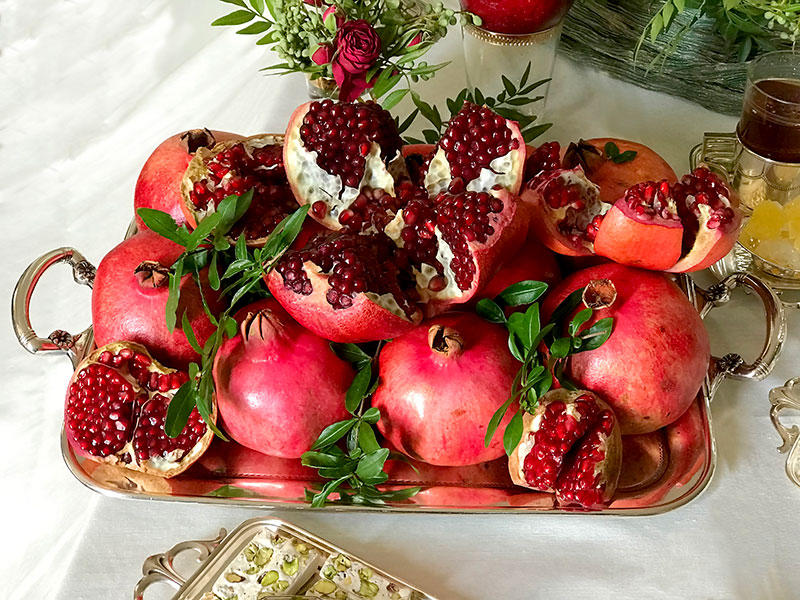
This section of the sofreh is dedicated to whole and opened pomegranates, embellished with pomegranate sprigs. The exposed deep-red seeds of the opened fruits are utterly dazzling. Red fruits are important components of this celebration, heralding the crimson hues of sunrise after absolute darkness, and the promise of longer days ahead.
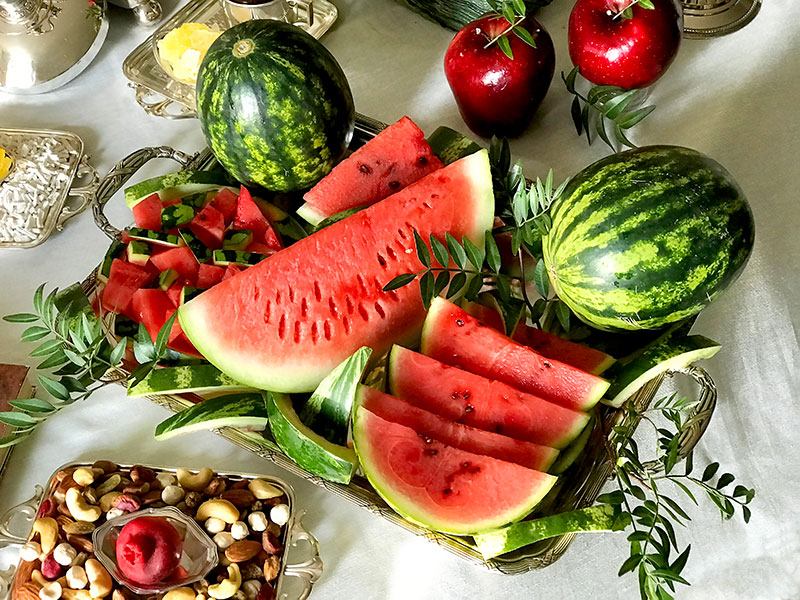
This section of the sofreh is dedicated to whole and cut watermelons embellished with foliage. The contrast of the bright red flesh and the variegated, shiny green skin of this fruit is truly striking. Red fruits are important components of this celebration, heralding the crimson hues of sunrise after absolute darkness, and the promise of longer days ahead.
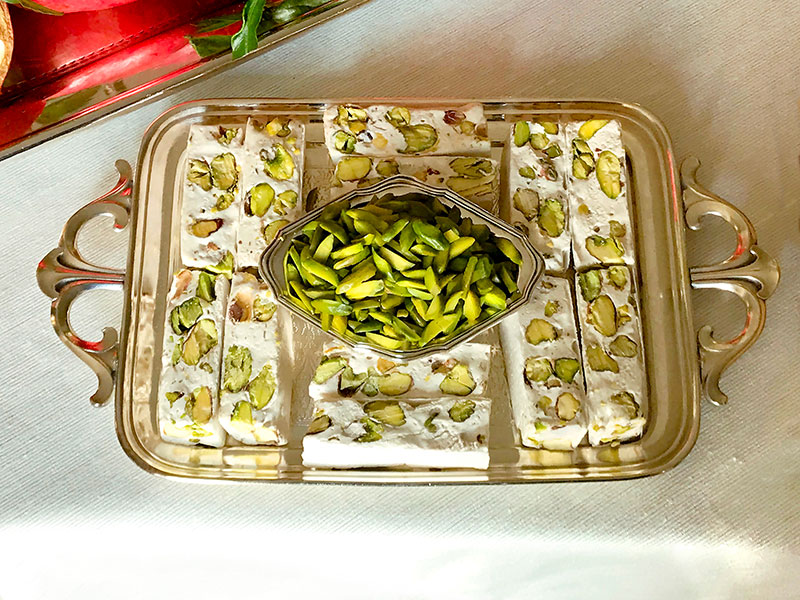
This is a delightful container of Persian nougat (gaz), which is decorated with vibrant green pistachios. Traditional sweets and pastries are usually served with tea during the celebrations of Shab-e Yalda, while verses from the divan-e Hafez are recited to get through the longest and darkest night of the year.
Sofreh & Hydrangeas
Hydrangeas are not part of Persian traditions, but have lent beauty to many of our contemporary sofrehs. They come in an unlimited variety of sensational shades. To break from tradition and pay tribute to this spectacular flower, images of a variety of hydrangeas, classified by colour schemes, were presented across November 2021. They were intended to bring light and life into the dark days of the month.
Jashn-e Mehregan
October 2021. Jashn-e Mehregan is an Iranian festival which is apparently dedicated to the god of Mithra (Mehr). See more on iranicaonline.org/articles/mehragan. Very briefly, in the Persian culture, Mehregan is believed to have the same significance as Nowruz, with Nowruz signalling the beginning of spring and Mehregan marking the arrival of autumn. The celebrations, which have their origins in the pre-Islamic period and are associated with agriculture and harvest, are usually held between 16 and 21 Mehr in the Persian calendar, which correspond to 8 and 13 October. Although in the past sofreh was part of the Mehregan customs, in modern times, it is not. This year, to mark the occasion and in pursuit of novelty, echoes of the customs of Mehregan are presented with an original and minimalist approach.
Sofa & Sofreh
The pandemic has put restrictions on marriage ceremonies, and has even condensed the Persian marriage sofreh! Many people have opted for celebrating at home, where space may be limited. Hence, this original composition was created on a small firm sofa, which is voluminously draped in ivory silk.
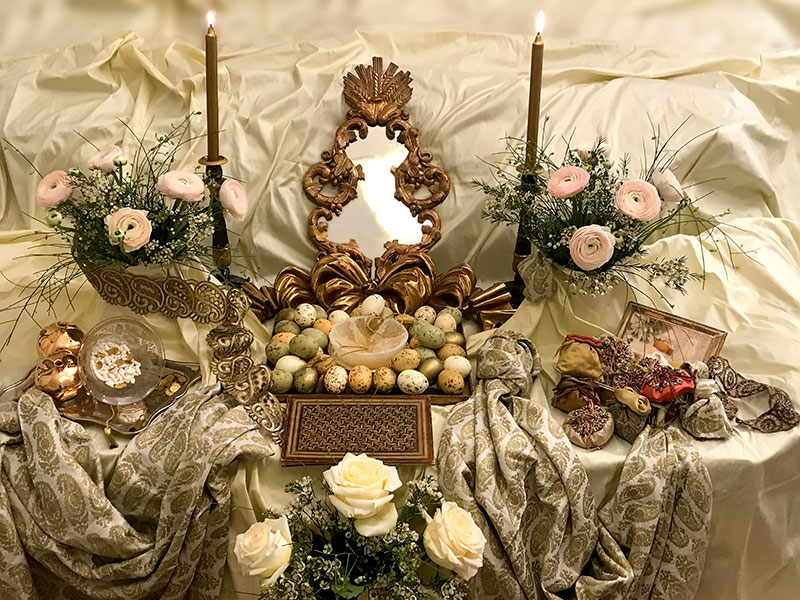
This is the overall view of this compact and innovative sofreh. It comprises most of the essential elements of the Persian marriage sofreh (sofreh-ye aqd)—a mirror, a pair of candelabra, the Qur’an, bouquets of flowers, crystal sugar, decorated eggs, Persian sugared almonds, gilded coins, pomegranates, bonbonnières—all embellished with lengths of fine paisley-design Indian silk and trim.
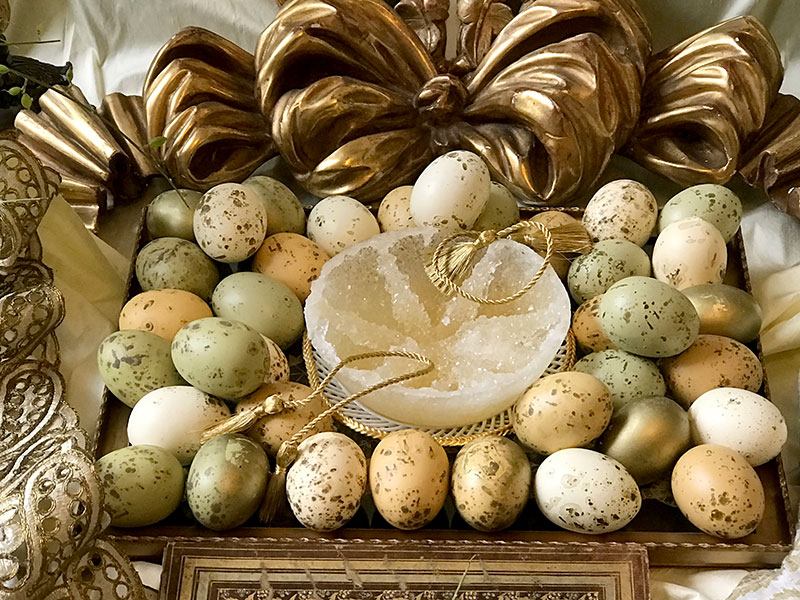
At the heart of the sofreh sits a bowl made of crystal sugar, placed on a plate with a lace-like border, which in turn sits on a tray of softly decorated eggs, a symbol of fertility. Kaseh nabat (crystal sugar, in the form of a bowl), is traditionally part of the Persian marriage sofreh, and is a symbol of sweetness and harmony. The composition of eggs and crystal sugar is embellished with fine gold tassels.
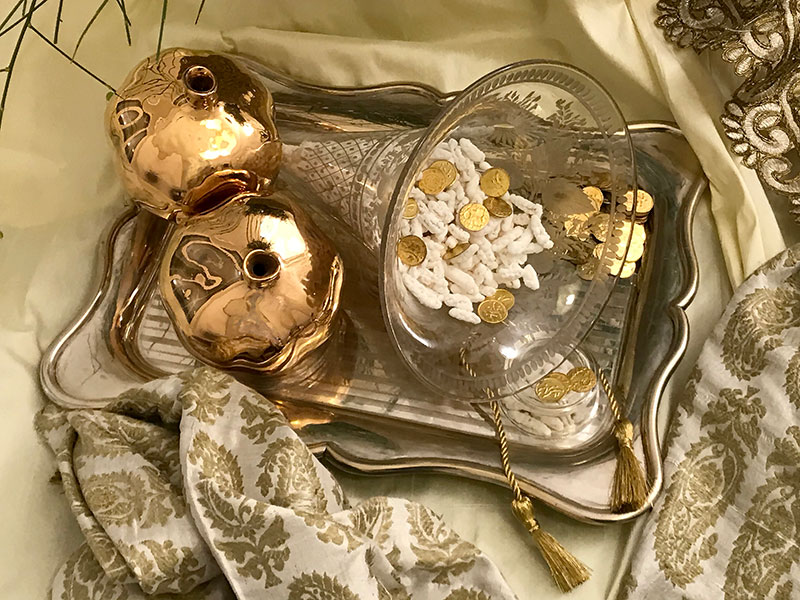
This delightful mini composition is arranged on a small antique silver-plated tray, presenting a pair of brightly glazed gold ceramic pomegranates (a symbol of fertility), and an antique crystal cone-shaped vessel, containing Persian sugared almonds and gilded coins. The tray is embellished with a length of draped Indian silk and fine gold tassels, as well as more sugared almonds and gilded coins, symbols of harmony and prosperity.

This is another mini composition, which is on the opposite side to the sugared almond and gilded coin mini composition. Colourful bonbonnières with intricate borders, in the Persian spirit, cascade out of an antique silver-plated box, embellished with lengths of draped Indian silk fabric and trim. Unusually, the lid, which boasts a muted-orange decorative knob, is displayed separately, and vertically.
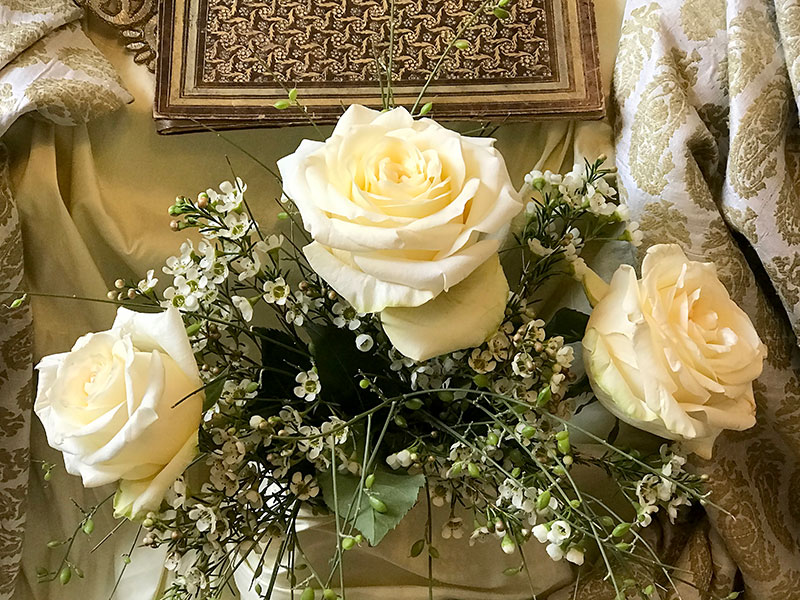
These soft and fragrant open Candlelight roses, wax flower and fine foliage are on display at a lower level in the forefront of the marriage sofreh (sofreh-ye aqd). With their soft cream/ivory shade, they perfectly complement the colour scheme of this original compact sofreh, with voluminously draped ivory silk as a backdrop, and embellished with lengths of paisley-design Indian silk fabric.

Persian sofrehs are customarily detailed and intricate. Hence, on this page their images are accompanied by descriptive captions. However, it is important not to lose sight of the aesthetic merits of individual natural elements. This delicate, fragrant and fully opened Candlelight rose, which is only a small part of the sofreh, perfumes the air, and, by itself, adds a sense of opulence to the sofreh.
Echoes of Sofreh-ye aqd, August 2021
During the month of August, more compact compositions, echoing the Persian marriage sofreh (sofreh-ye aqd), together with their details were presented. The emphasis was on soft, subtle and serene designs.
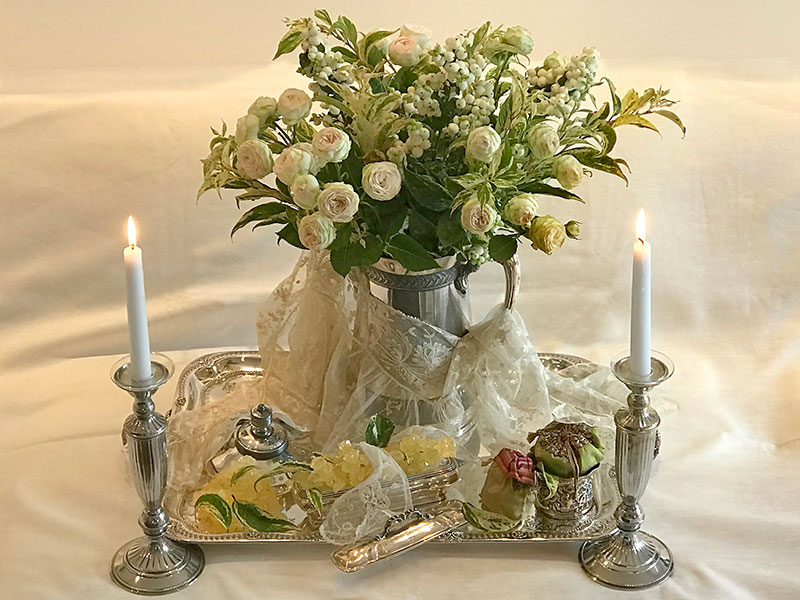
This remarkably peaceful arrangement is created on and around a large antique silver-plated tray. The lovely bouquet of spray roses and foliage takes centre stage. Crystal sugar and bonbonnières are presented in antique silver vessels. The arrangement is draped and embellished with lengths of fine antique lace and subtly illuminated with a pair of flames.
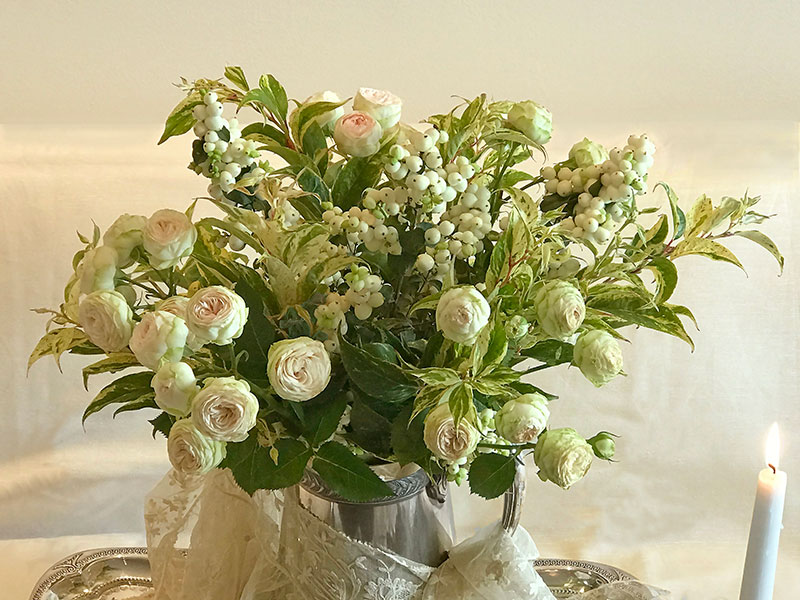
This is a close-up of the delicate bouquet at the heart of the arrangement. The sumptuously soft bouquet comprises Misty Trendsetter spray roses, snowberries (Symphoricarpos) and a variegated foliage, which is a variety of the Leucothoe plant. This particularly pleasant and elegant combination is most appropriate for any marriage ceremony.
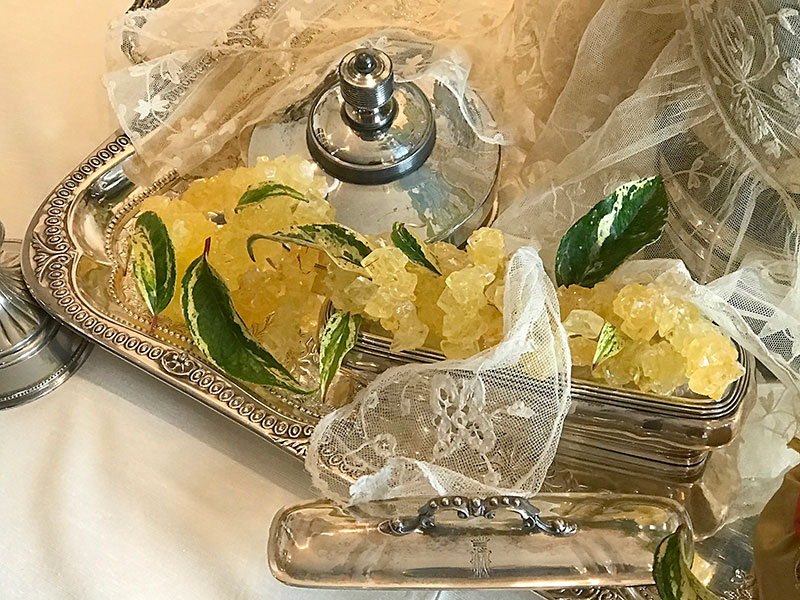
This corner of the sofreh is dedicated to crystal sugar (a symbol of sweetness and harmony) in gold tones, embellished with lengths of fine antique lace and leaves of the Leucothoe plant. The gold strips of the leaves subtly complement the crystal sugar. The lids of the urn and the vessel, respectively containing the bouquet and the crystal sugar, are neatly presented separately.
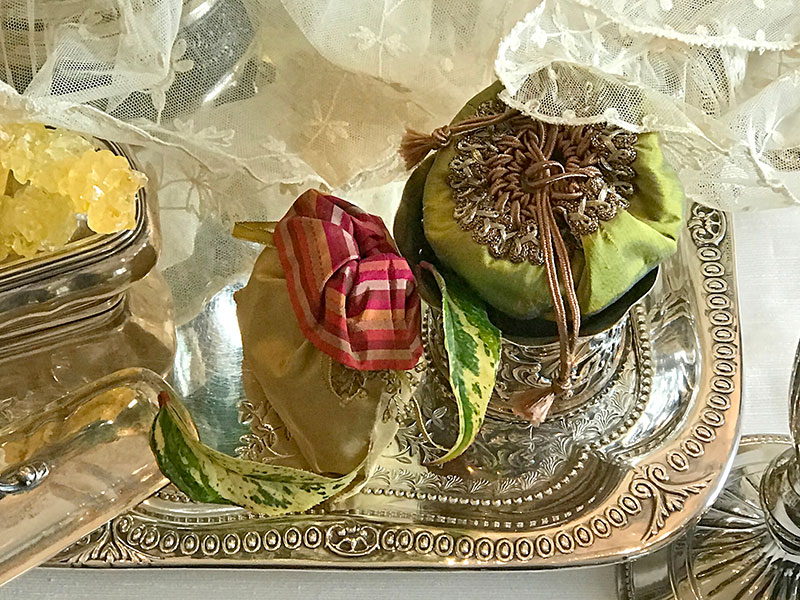
In this corner of the sofreh two handmade bonbonnières in the Persian spirit are on display. Their colour combination and their intricate trims complement the colour scheme and the design of the sofreh. The bonbonnières included in the Persian marriage sofreh usually contain gilded coins, a symbol of wealth and prosperity, and Persian sugared almonds, a symbol of sweetness and harmony.

Unconventionally, this simple and compact arrangement is created on a stainless steel surface. The impressive bouquet is presented in a silver-plated ice bucket flanked by a pair of simple candleholders. The backdrop is a shimmering silver textile embellished with a length of fine antique lace. On the surface, more lengths of draped fine antique lace are on display.
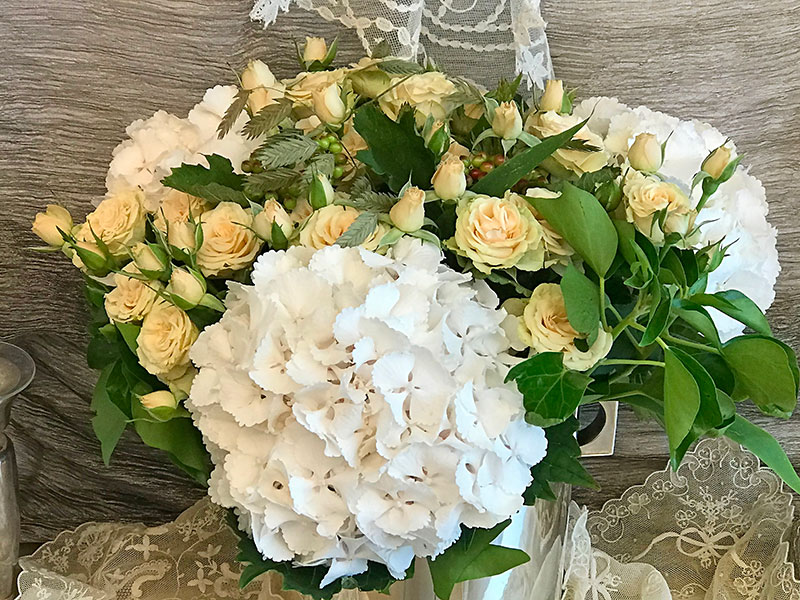
This stunning bouquet of Snow/White Ball hydrangeas, Jelena spray roses, ivy, Viburnum opulus and Chasmantium latifolium (woodoats) is at the heart of this compact arrangement. It stands out against the shimmering silver background textile and lengths of fine antique lace. This soft and elegant bouquet, too, beautifully lends itself to decorating any marriage ceremony.
Clematis & Ranunculi
This enchanting arrangement, which is inspired by a bouquet of clematis and ranunculi, alludes to a Persian marriage sofreh (sofreh-ye aqd). Lengths of exquisite antique Persian textile (termeh) in yellow tones, with intricate embroidery and borders, offer the perfect background and backdrop for this delightful sofreh.

This is the overall view of the sofreh. The soft bouquet of clematis and ranunculi takes centre stage. The composition of crystal sugar is reflected in the contemporary, angular mirror. A lovely antique vessel holds the sugared almonds and gilded coins. The sofreh is illuminated with several flames at different levels.

This is a close-up of the antique opaline vessel holding the Persian sugared almonds (noql) and gilded coins (sekkeh). Sugared almonds are a symbol of sweetness and harmony, while gilded coins represent wealth and prosperity. The dish creates a lovely contrast with the intricate termeh that it is placed on.
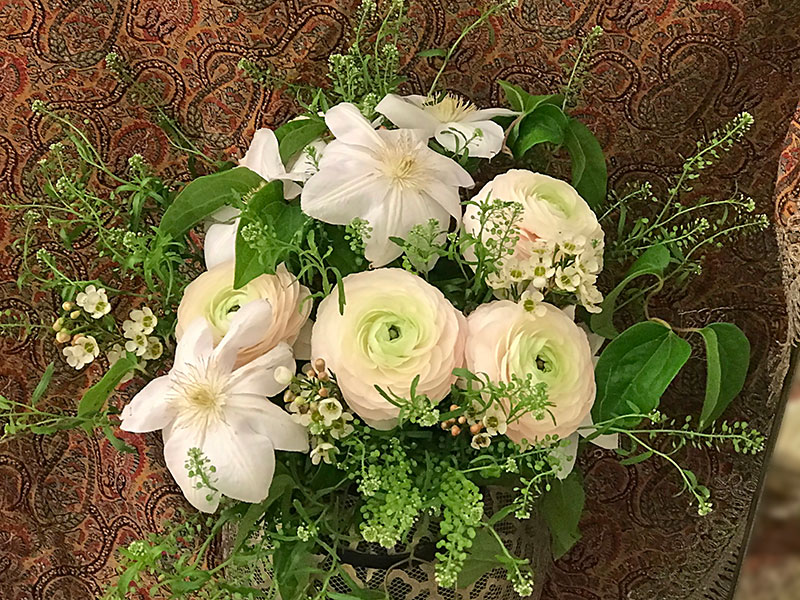
The focus of this image is the bouquet of Sevilla clematis, Hanoi ranunculus, wax flower and Lepidium. This light and airy bouquet in pastel tones stands out against the background of yellow termehs. Clematis is not frequently used in flower arrangements and its inclusion here, especially in combination with Hanoi ranunculi, brings an original touch to this pleasant and peaceful composition.
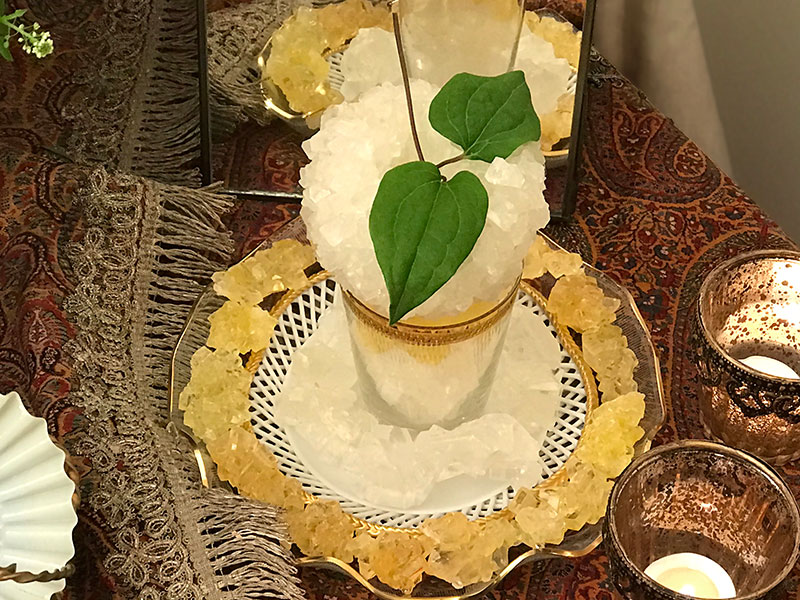
This mini composition of crystal sugar (nabat) in different shapes and shades is presented in refined vessels. The main cluster of translucent crystal sugar is in the shape of an apple, a heavenly fruit and a symbol of fertility. It is embellished with leaves of clematis. The crystal sugar composition, which is partially reflected in the mirror, also boasts a translucent gold shade. Crystal sugar, too, is a symbol of sweetness and harmony.
Kahala Roses
This soft and serene arrangement, which alludes to a Persian marriage sofreh (sofreh-ye aqd), is inspired by an ample and lavish bouquet of magnificent roses, known as Kahala, and fine foliage.
This striking, yet serene and soft Persian marriage sofreh (sofreh-ye aqd), arranged in front of a fireplace with blue and white ceramic tiles, complements that colour scheme. The predominant element is a length of exquisite antique Persian brocade in blue, with antique-gold accents.
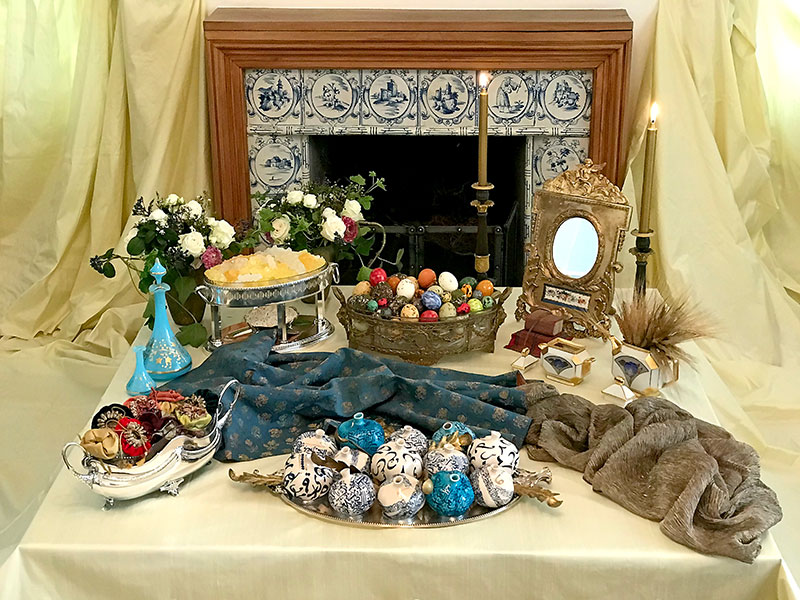
This is the overall view of the sofreh, with various containers and elements which reveal a touch of blue, often complemented with gold. The composition comprises the important symbolic elements of the sofreh-ye aqd—a mirror, candles, flowers, rosewater, Persian sugared almonds, crystal sugar, decorated eggs, wheat, gilded/gold coins, sculptured pomegranates, bonbonnières and elegantly draped textiles.
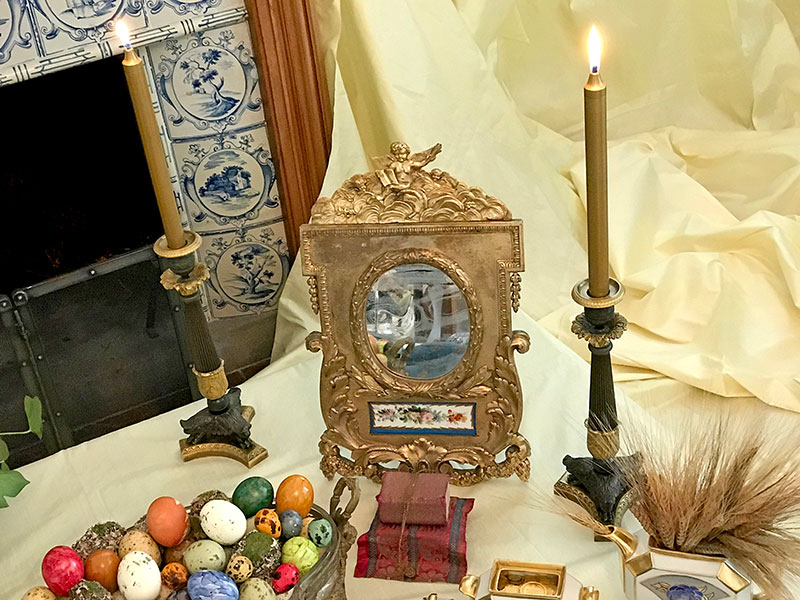
This is a close-up of an important section of this sofreh, comprising an antique French mirror (ayeneh) and a pair of empire-style candleholders (sham’dan). The mirror incorporates a lovely Sèvres porcelain panel with a blue and gold surround. An antique miniature Qur’an is displayed on top of its case and silk pouch, in front of the mirror. This image is a compelling example of ayeneh sham'dan and ayeneh Qura’n—revered symbols in the Persian culture.
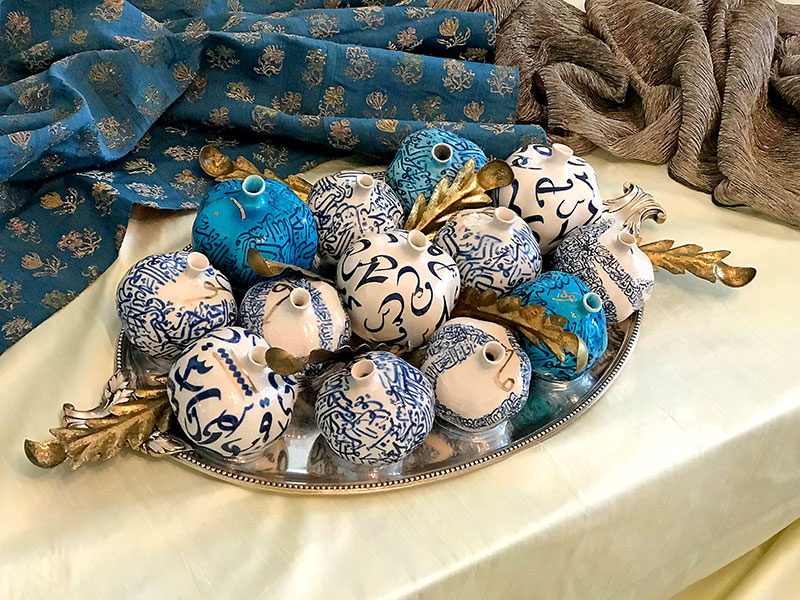
This is an impressive display of ceramic pomegranates in blue and white tones, created by the Iranian artist, Keyvan Fehri. The collection, together with the accents of antique-gilded leaves, is presented on an antique silver-plated tray and beautifully complements the antique Persian blue brocade with an antique-gold floral pattern. Pomegranates, which are symbols of fertility, are frequently included in the sofreh-ye aqd.
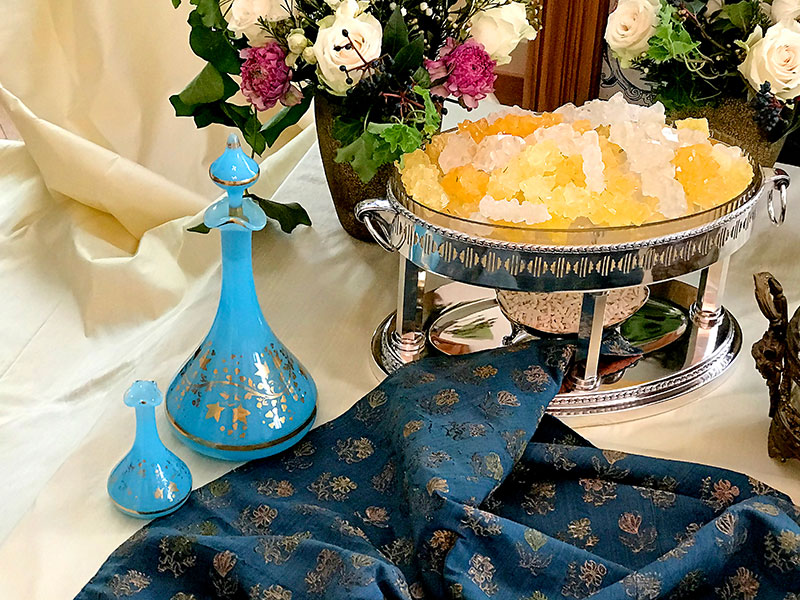
The focus of this image is the bright blue and gold antique opaline flasks of rosewater (golab) to perfume the air. They elegantly complement the antique Persian blue brocade, draped under and upon the two-tiered silver-plated and crystal container of various tones of crystal sugar. An antique silver vessel of sugared almonds (noql) is displayed below the crystal sugar (nabat). In the Persian culture "nogl o nabat" are synonymous with joy and celebrations.
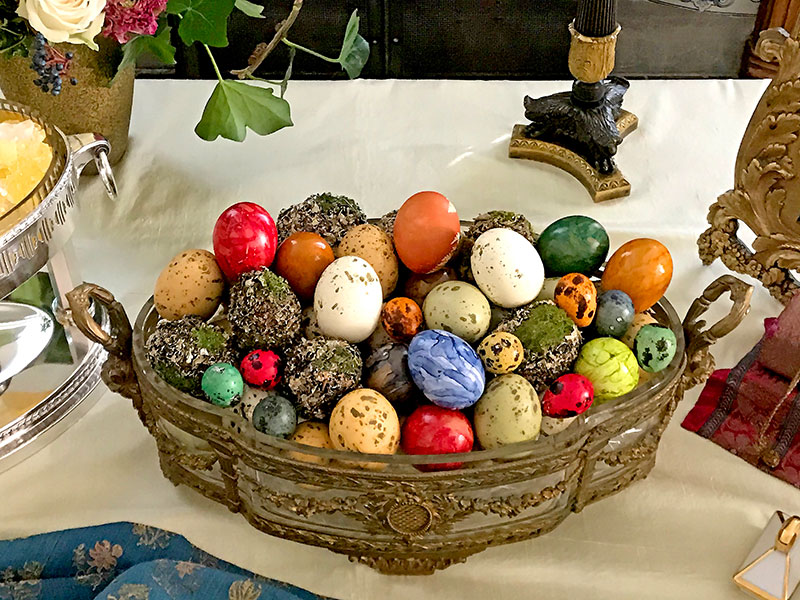
This is a close-up of the antique bronze and crystal container of decorated eggs. The turquoise- and blue-coloured eggs stand out and complement the predominantly blue and gold colour scheme of the sofreh. Eggs, like pomegranates, are a symbol of fertility and are regularly included in both sofreh-ye aqd and sofreh-ye Nowruz (haft sinn).
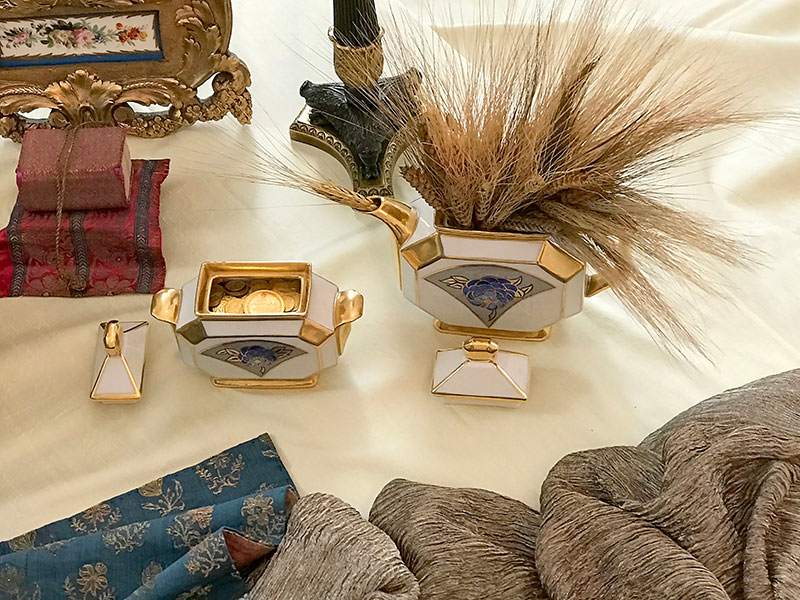
These two lovely porcelain pieces from an art deco tea set, with blue and gold embellishments, respectively contain sheaves of wheat (a symbol of blessing and abundance), and gilded and gold coins (a symbol of wealth and prosperity). The beautifully gilded, angular lids of the pieces, which are neatly displayed separately, add interest and brightness to this serene sofreh.
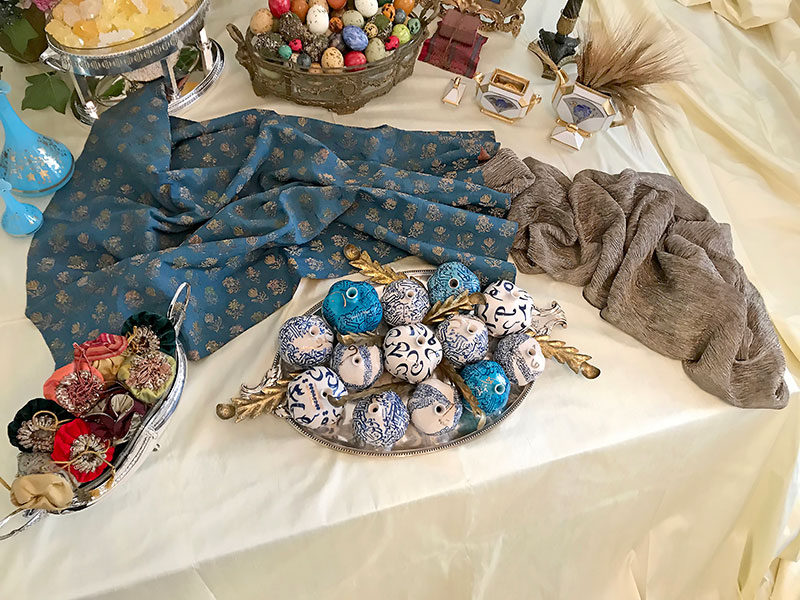
This image, taken from above, presents the ensemble of the draped antique Persian blue brocade and shimmering-silver textured textile. They are displayed next to the tray of blue and white pomegranates and an antique silver-plated and crystal container of a selection of bonbonnières made of silk, satin and velvet, with antique-gold metallic trims. This is an interesting and unusual view of the front of the “Blue White Gold” sofreh.
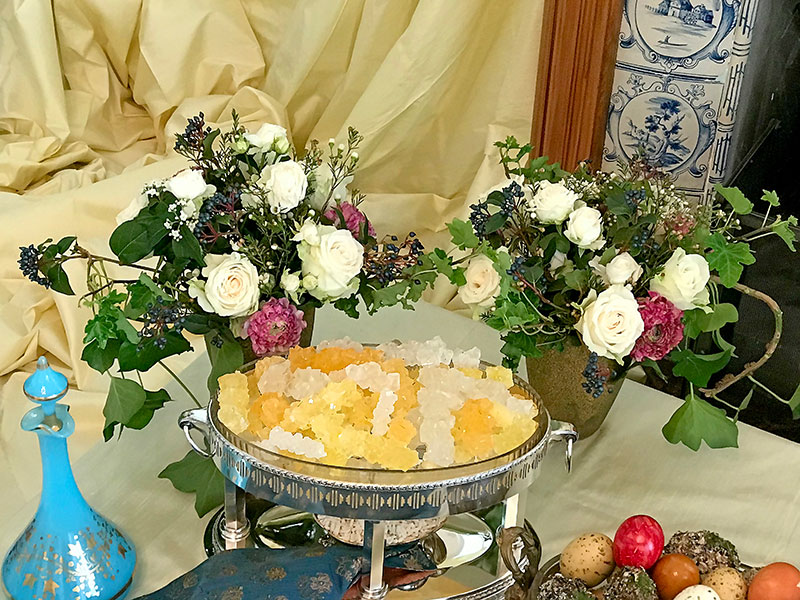
This images focuses on the pair of natural and graceful flower displays, which is unconventionally placed in the opposite corner to the traditional ensemble of the mirror and candleholders, known as ayeneh sham’dan in Persian. These two simple yet elegant bouquets, comprise white/cream roses, Pompon Mignon ranunculi, wax flowers, ivies and Viburnum tinus in bloom and with berries.
Echoes of Sofreh-ye aqd
Once again the wedding season is upon us. Throughout the month of May 2021 a variety of compact compositions were designed, echoing the Persian marriage sofreh (sofreh-ye aqd). In each case the sublime flowers, which take centre stage, have been the inspiration for creating the arrangements.
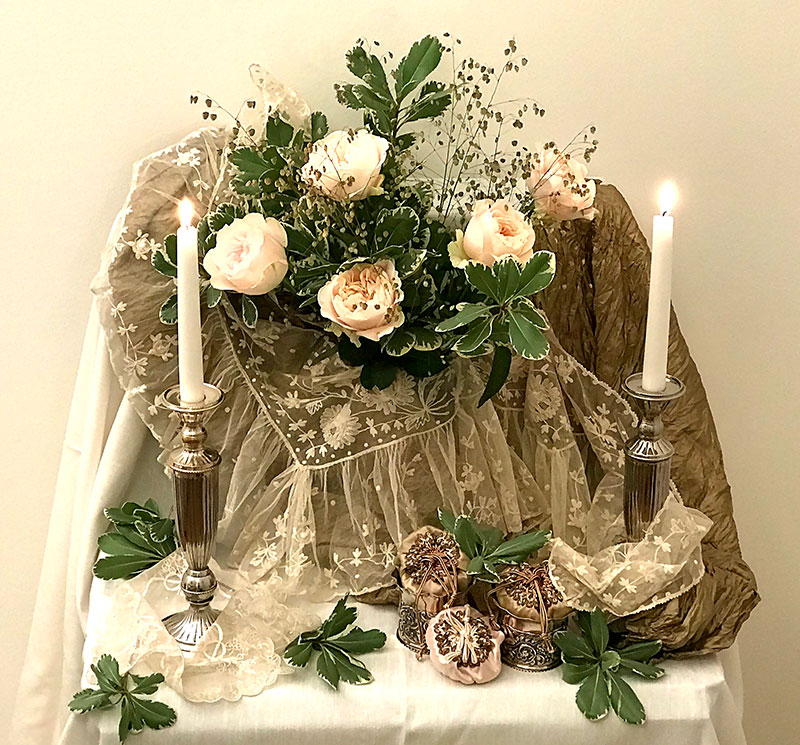
This soft composition is the first one of the “Echoes of Sofreh-ye aqd” group. It is inspired by a bouquet of Chiffon roses and foliage. The set-up is embellished with lengths of antique-gold silk textile and ivory antique lace. A few satin bonbonnières, in soft shades and in the Persian spirit, are on display. The arrangement is illuminated with a pair of flames and adorned with sprigs of foliage.
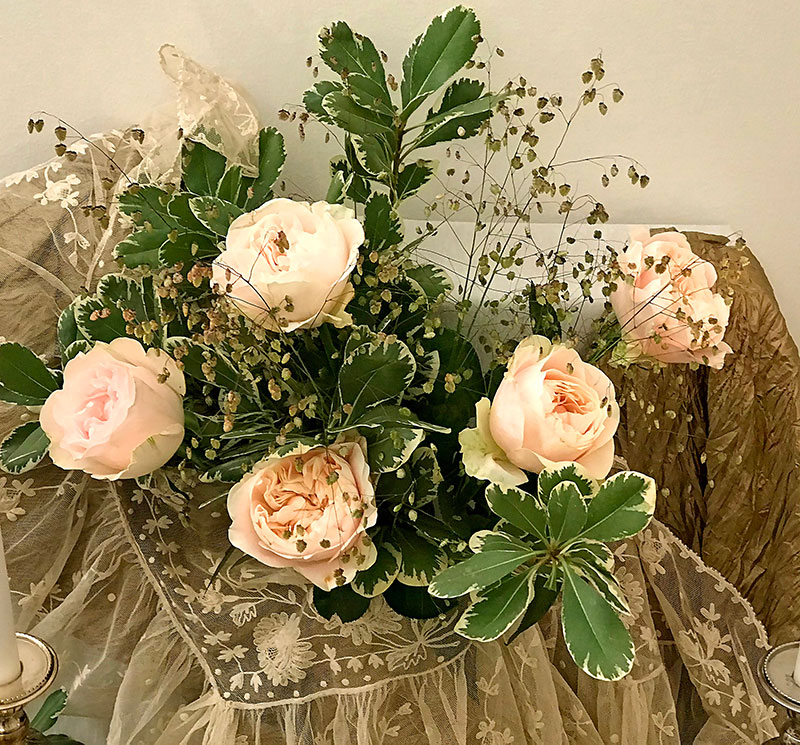
This is a close-up of the bouquet that inspired the creation of the first set-up in the “Echoes of Sofreh-ye aqd” series. The soft and subtle bouquet is composed of Chiffon roses in a pastel shade, variegated Pittosporum and a fine foliage, known as Briza media. The exquisite bouquet beautifully complements the fine textile and the delicate antique lace.

This original and minimal miniature arrangement is designed around a single spectacular white peony and sprigs of Viburnum tinus. The distinctive ivory candle complements the delicate petals of the peony. The set-up is created on an ivory silk background which is elegantly draped with a soft-gold open mesh. All elements are presented in an elegant silver-plated tray with a glass base.
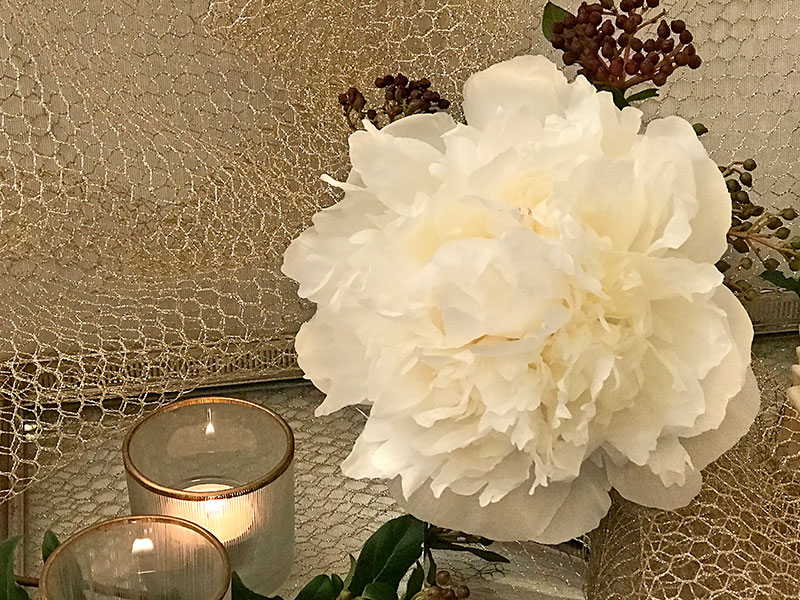
This is a close-up of the spectacular white peony that inspired the creation of the second arrangement in the “Echoes of Sofreh-ye aqd" group. The wine-coloured berries of Viburnum tinus create an interesting contrast with the white feathery flower. A pair of flames illuminates the petals of the peony, and the draped gold mesh shimmers in the background.
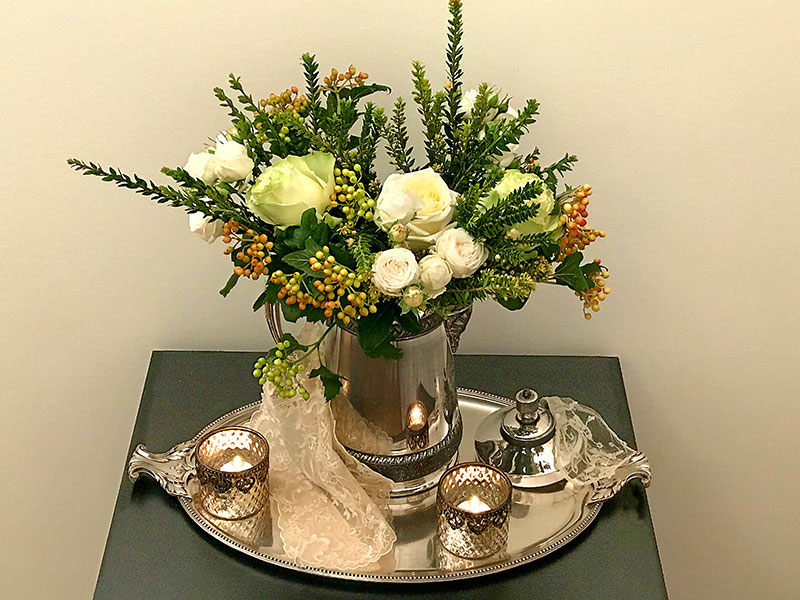
This neat and uncomplicated arrangement, created on an antique silver-plated tray, presents an impressive bouquet of a variety of roses and foliage. The flowers are arranged in an antique urn, with its lid displayed separately. The set-up is illuminated with a pair of flames and elegantly embellished with tiny pieces of fine antique lace.
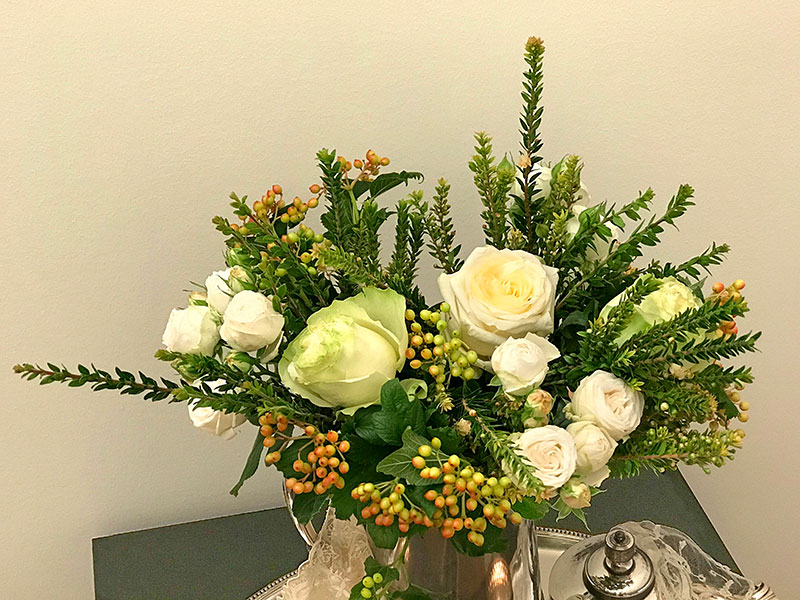
This is a close-up of the bouquet which takes centre stage in the third arrangement in this series. It is made of Miss Bombastic spray roses, and green Dynamic and cream Candlelight roses. The dominant foliage is Viburnum opulus with lovely blushed cream and green berries. The spiky, vibrant green foliage is known as Myrthus tarantina.

This pleasing ensemble, illuminated with flames at various levels, is the last set-up in this group. Its creation was inspired by an exquisite bouquet of Lorena Summerhouse roses. A single sculptured pomegranate, a symbol of fertility, is presented in an antique silver-plated container. A length of a subtle green textured textile with antique-gold accents is elegantly draped through the composition.

This is a close-up of the view from above the heart of the last arrangement in the “Echoes of Sofreh-ye aqd" series. The Lorena Summerhouse roses, which have an abundance of shapely buds and soft yet opulent flower heads, inspired the design. The delightful bouquet, which includes variegated Pittosporum and Lepidium, subtly shimmers in the candlelight.
Glorious Garlics
The humble garlic (sir, in Persian) is one of the symbolic elements included in the sofreh-ye Nowruz (haft sinn), which starts with the letter “s”. It is prized for its medicinal qualities, and is believed to have evil-averting powers. In the following compact arrangements, alluding to the sofreh-ye haft sinn, its aesthetic qualities have been wonderfully exploited.
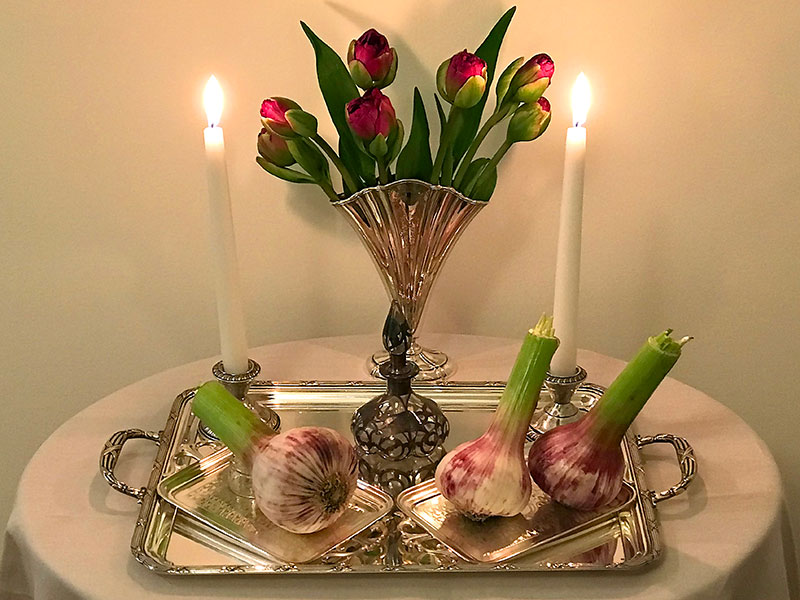
These glorious and ample bulbs of garlic were the inspiration for creating this compact arrangement. The simple and pure set-up includes a flask of vinegar (symbolizing patience), flames (representing light), and only three bulbs of garlic with streaks in shades of mauve, which complement the lovely tones of the deep-purple tulips (a symbol of beauty, signalling the arrival of spring). All these elements are presented in antique, mainly silver containers.
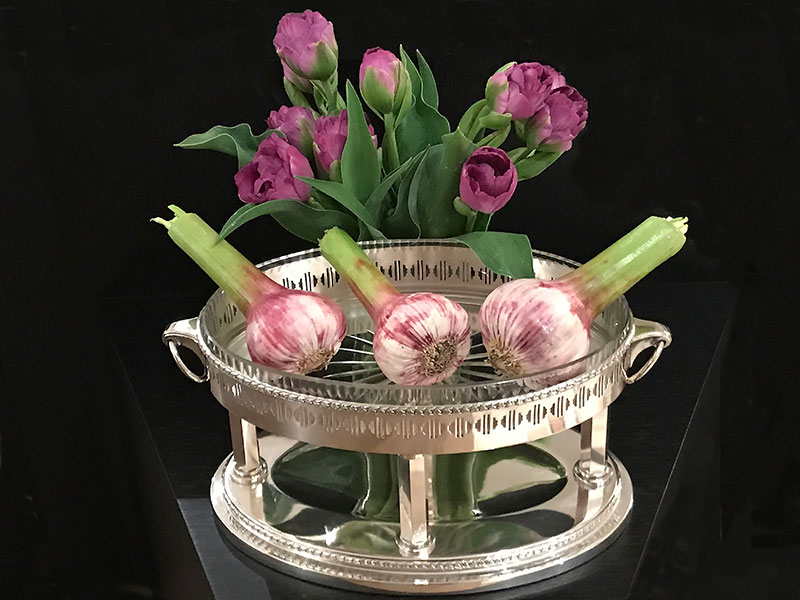
Another compact arrangement was also inspired by these glorious and ample bulbs of garlic. It is a simple composition incorporating an airy, light and natural bouquet of deep-purple tulips, which complements the mauve streaks of the three plump bulbs of garlic. Tulips represent beauty and the rebirth of nature at the beginning of spring. This petite composition is presented in an attractive, antique, silver-plated and crystal container.
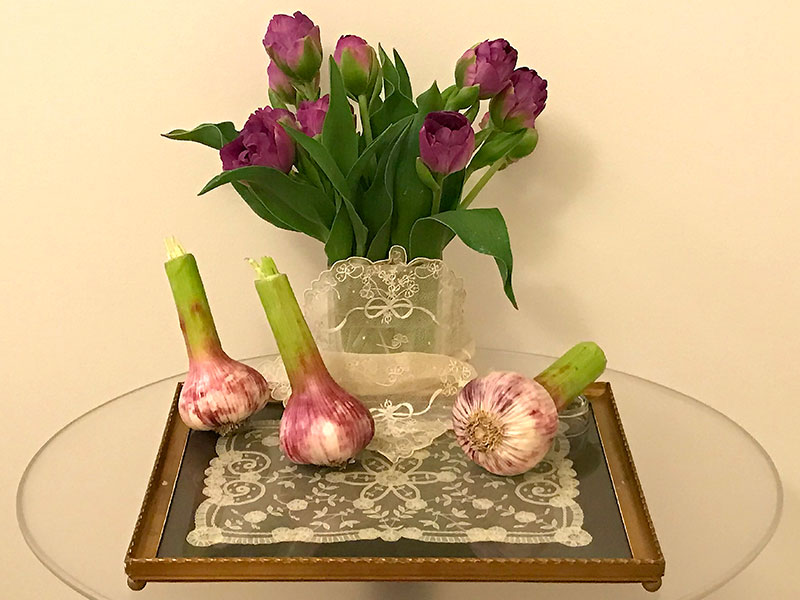
Once again these glorious and ample bulbs of garlic take centre stage in another compact arrangement. The lovely mauve streaks of the plump bulbs of garlic complement the deep-purple bouquet of tulips, representing beauty and signalling the beginning of spring. This simple composition is displayed on a glass-top table, and includes a platter with an antique lace base, as well as elegantly draped lengths of antique lace.
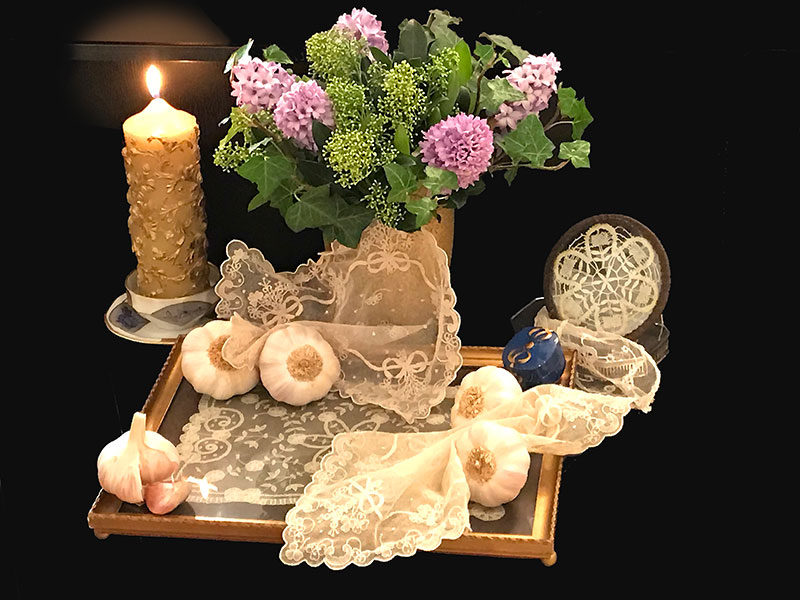
This is a variation on the last arrangement, which incorporates the same platter with an antique lace base. This set-up is embellished with several lengths and types of antique lace, and the pattern on the lace is repeated on the blue papier mâché box of gilded coins—a symbol of prosperity. A single flame depicts light. The delightful bouquet of purple hyacinths, Skimmia and ivy signals the arrival of spring. Bulbs of a different variety of garlic are on display.
Nowruz 1400 AS, 2021
In the Persian calendar, 20-21 March 2021 marks the beginning of a new century and a New Year, 1400 AS (anno shamsi) or SH (shamsi hejri). In the pursuit of variety, an informal and original sofreh, created by an Iranian artist in her home for Nowruz 1400, is being featured.
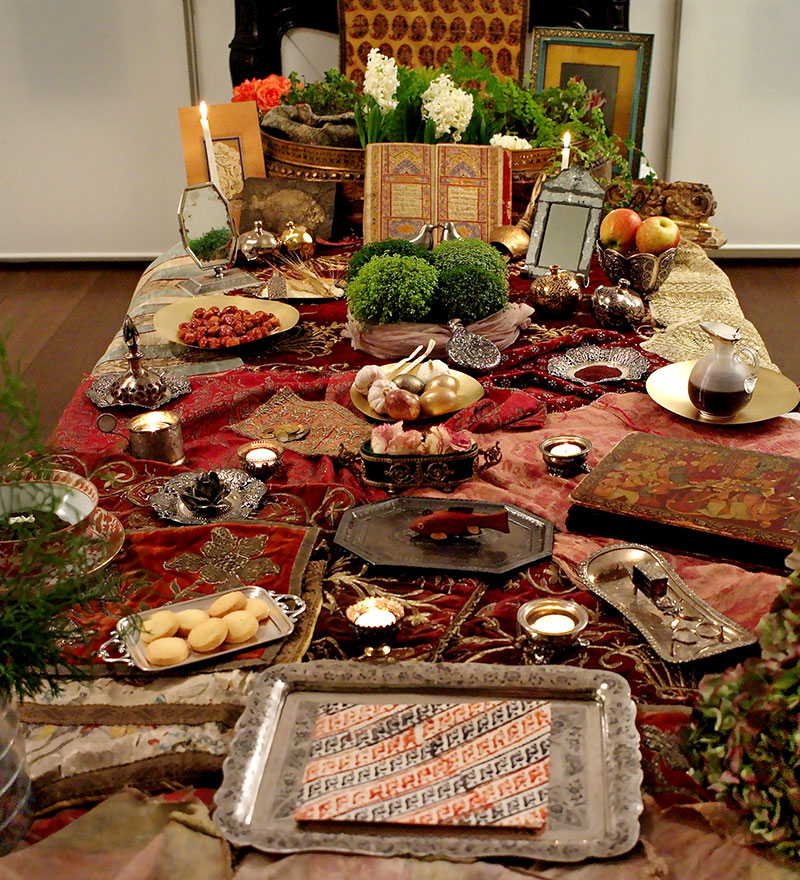
This overall view clearly reveals the emphasis on layering antique textiles and embroideries, which creates volume, depth and movement. A selection of original decorative objects and vessels enhance the beauty of the symbolic elements of the sofreh-ye Nowruz (haft sinn), including hyacinths, vegetation, apples, pomegranates, bulbs of garlic, decorated eggs, fish, vinegar, rosewater, sumac, mirrors, flames and a hand-written Qur’an.
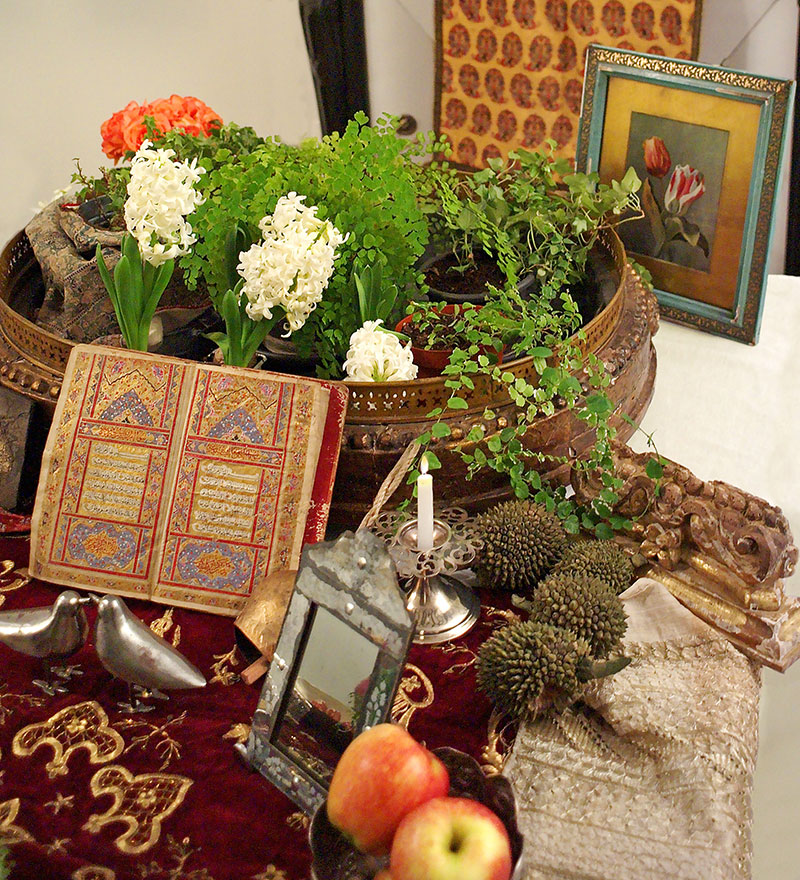
Hyacinths, which herald the beginning of spring, are usually included in the sofreh-ye haft sinn for their beauty and sweet fragrance. Their presentation in this section of the sofreh is reminiscent of a wild garden. In the background, the antique watercolour of another spring flower, tulips, is an appropriate addition to the sofreh. A delicate antique mirror, a symbol of light and reflection, is placed next to the apples, a symbol of heaven and fertility.
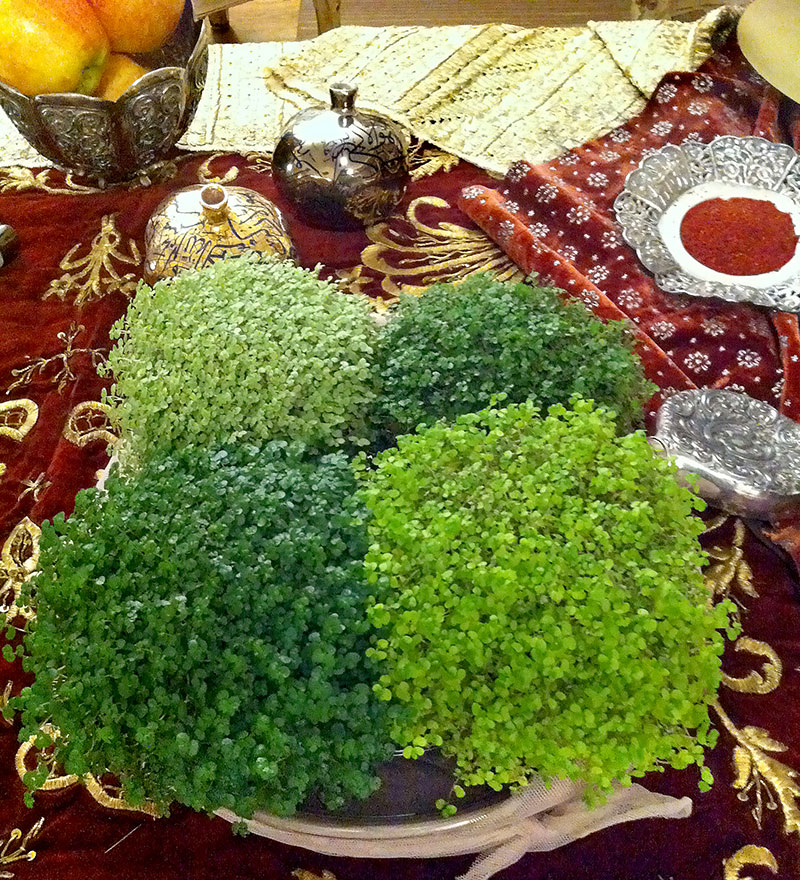
Vegetation and sprouts also herald the beginning of spring. In her casual sofreh, the Iranian artist has opted for the vivid green Soleirolia soleirolii (mind-your-own-business) as an interesting alternative for the germinated grains (sabzeh). A pair of sculptured pomegranates, an antique Persian silver dish containing sumac and a delicate antique silver flask of water, all displayed over antique textiles and embroideries, are part of this original sofreh.
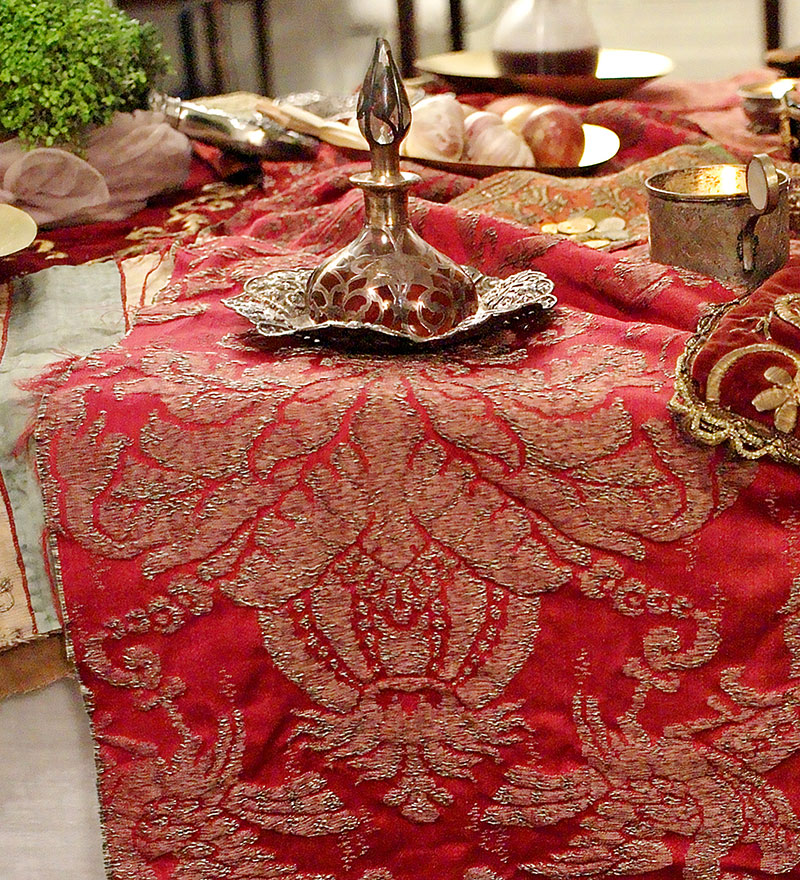
This artistic image, taken from an unusual angle, reveals a detail from this creative sofreh-ye haft sinn. It presents an exquisite antique flask in silver and crystal, which contains rosewater (golab) to perfume the air. It is elegantly placed inside an antique Persian silver saucer with a rippled edge. The rich, shimmering vintage damask textile enhances the beauty of this section.
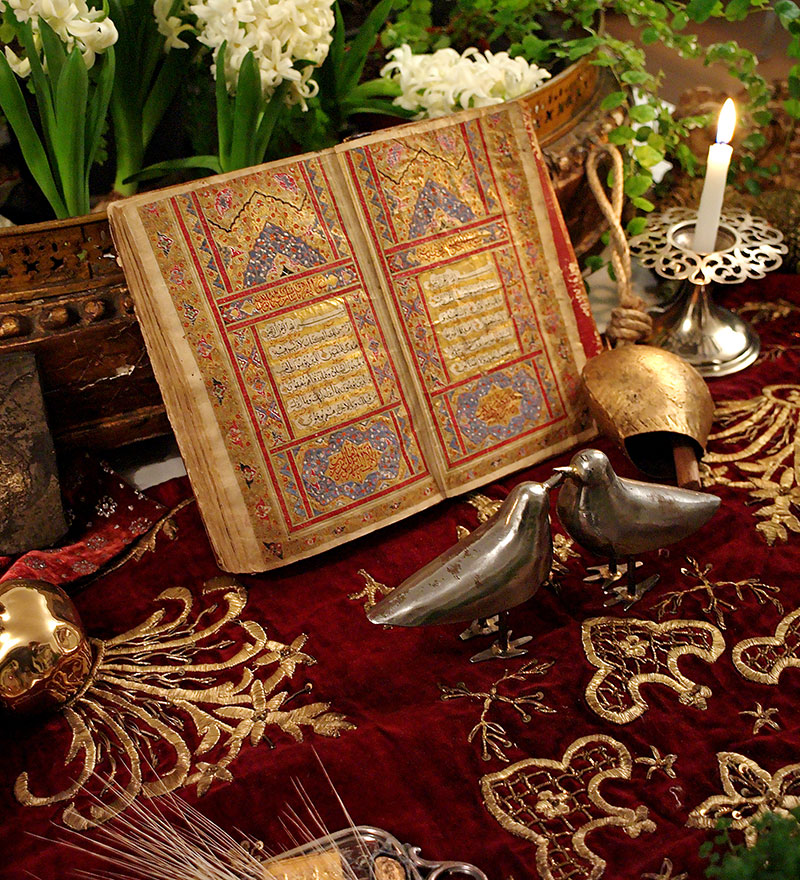
The focus of this image is the exquisite hand-written Qur’an, opened on an illuminated page and subtly lit with a single flame. A pair of Persian hand-crafted metal birds is included, as a symbol of good fortune, juxtaposed with a gold-finish bell. All the elements are displayed on a length of deep-red Ottoman velvet, embroidered with gold threads, which together with the sublime patina of the bell, complement the gilding of the illuminated Qur'an.
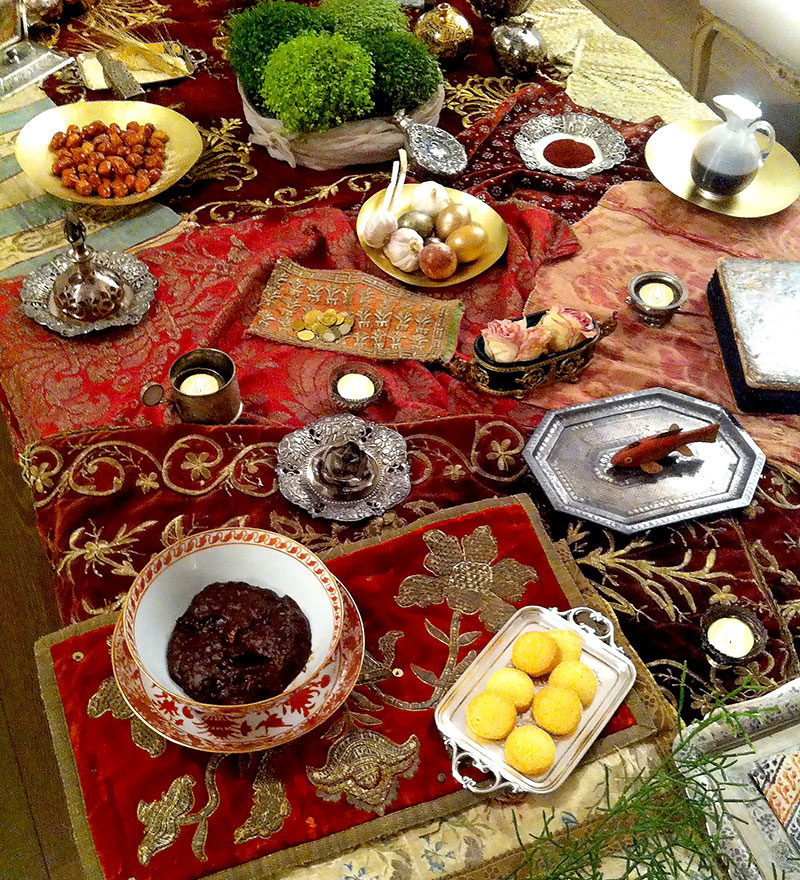
This is the heart of the sofreh, comprising vegetation, jujube fruit (senjed), sumac, vinegar, decorated eggs, bulbs of garlic, gilded coins, rosewater, a sculptured goldfish, pastries and an elegant antique Chinese bowl with matching plate, containing a sweet paste called samanu made of germinated wheat. Samanu, which is associated with fertility, is a traditional dish prepared exclusively by women on the eve of Nowruz. A few tea lights subtly illuminate this central section.
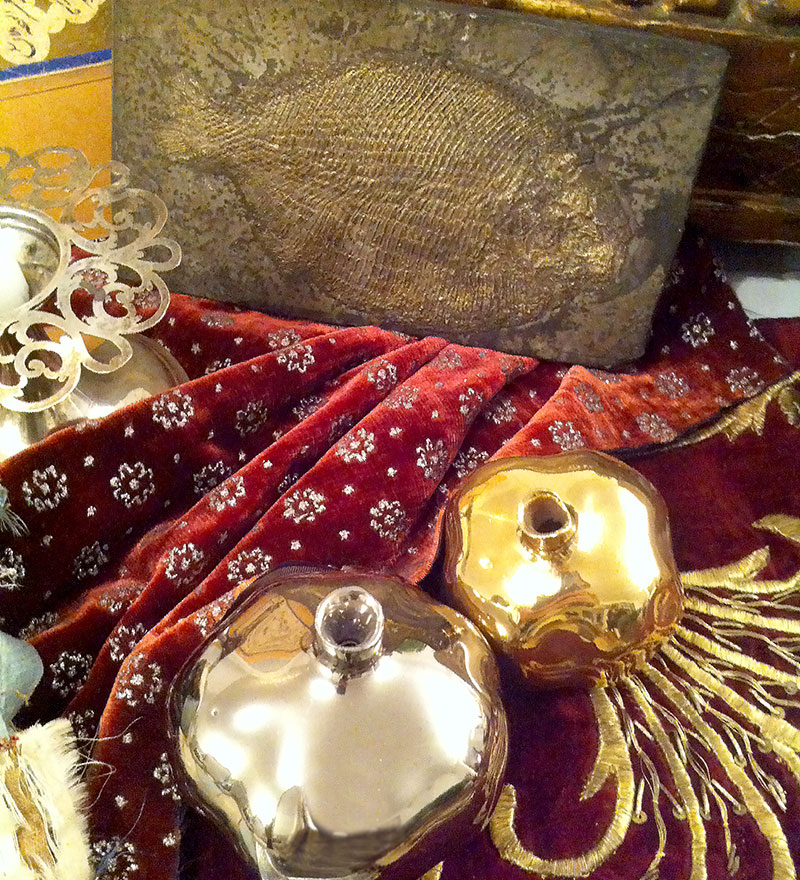
This image focuses on the exquisite plaque with the outline of a fossilized fish, which is softly gilded by the artist herself. It is another representation for goldfish, which are one of the symbolic elements of the sofreh-ye haft sinn. The plaque is displayed over a draped length of antique Persian embroidery, known as naqdeh duzi. The pair of gold and silver metallic-finish sculptured pomegranates beautifully complements the other gold- and silver-finish objects in the sofreh.
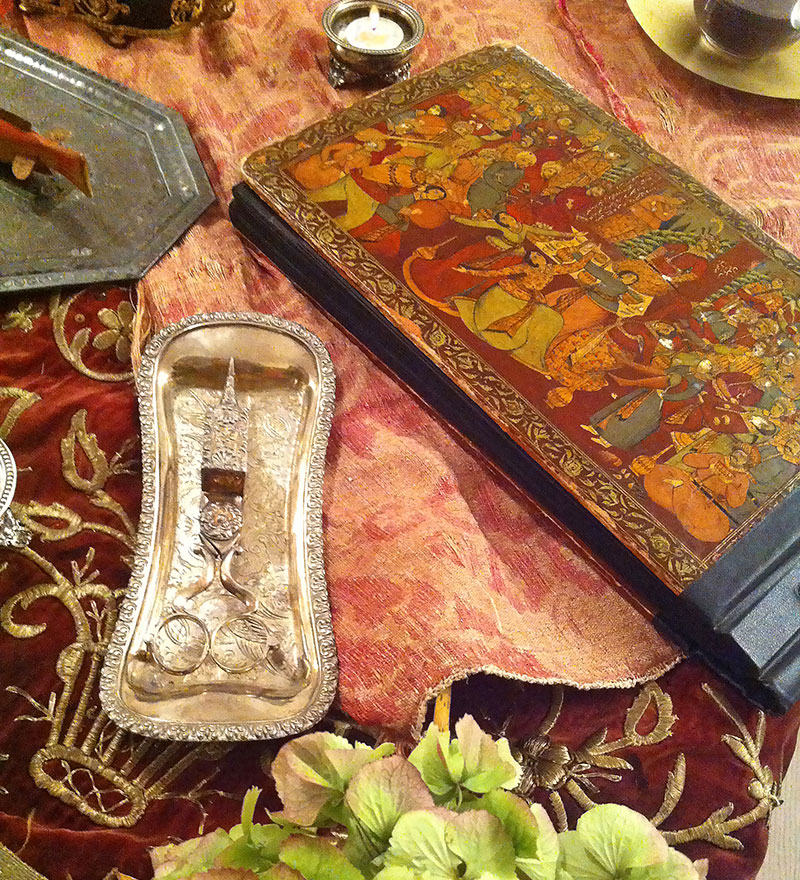
In the past, it was customary to include photos of deceased family members on the sofreh-ye haft sinn. This antique family photo album speaks to that tradition. Its refined papier mâché cover features a festive royal occasion with music, dancing, wining and dining, which is related to the Nowruz celebrations. A decorative, antique silver snuffer and wick trimmer adds to the appeal of this corner of this original sofreh, created by an Iranian artist.
Simple Ideas for Sofreh, 2021
The following two compact compositions, with two very different colour schemes, spirits and appearances, allude to a Persian marriage sofreh (sofreh-ye aqd) or Nowruz sofreh (sofreh-ye haft sinn).
Silver Wattle (Mimosa)
This first compact arrangement, with an unusual colour scheme, is inspired by a bouquet in silver, dusty pink and wine tones, which takes centre stage.
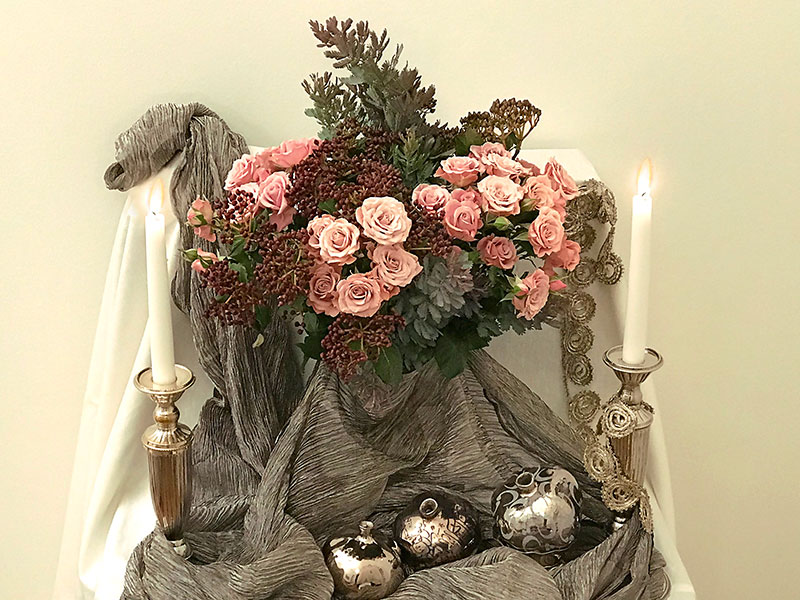
This is the overall view of the arrangement. The shiny silver-finish ceramic pomegranates (a symbol of fertility) complement the subtle silver tones of the foliage. The arrangement is draped with a length of shimmering-silver, textured textile, and a piece of intricate, antique silver-thread trim. A pair of flames illuminates and enhances the beauty of the ensemble.
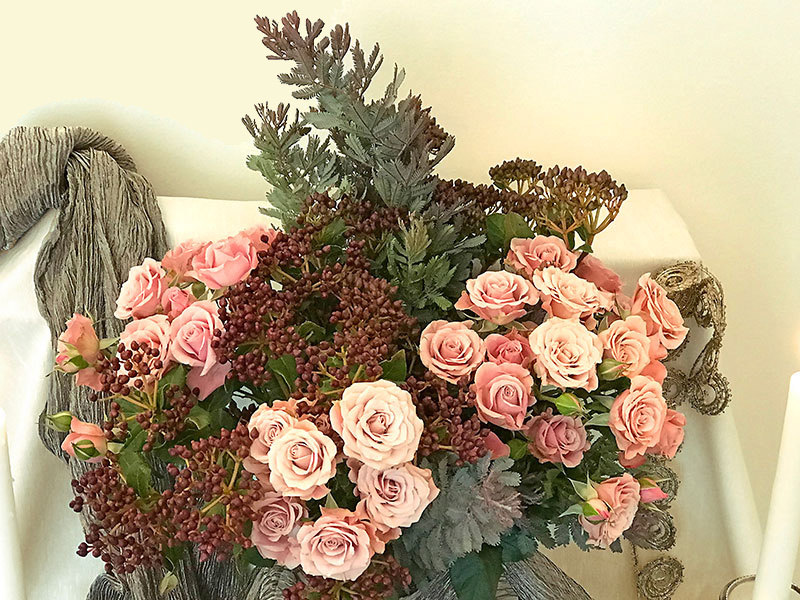
This is a close-up of the bouquet, placed at the heart of this compact arrangement. The fine silvery foliage with wine-coloured blush is known as Silver wattle (Mimosa) which compellingly complements the Viburnum tinus' wine-coloured berries. Various shades of the smoky pink Furusato spray roses soften and lighten up the bouquet and the sofreh.
Hydrangea & Termeh
This second compact arrangement is inspired by an outstanding, ample bouquet of hydrangeas in subtle tones, which is displayed in one corner.

This is the overall view of the arrangement, exploiting the beauty of a piece of draped antique Persian textile (termeh), with an intricate silver-thread border and fringe. An impressive bouquet of hydrangeas is on display, and the arrangement is illuminated by a single decorated candle. A tilted antique crystal cone-shaped vessel, containing sugared almonds, is on view. A length of intricate, antique silver-thread trim embellishes the sofreh.
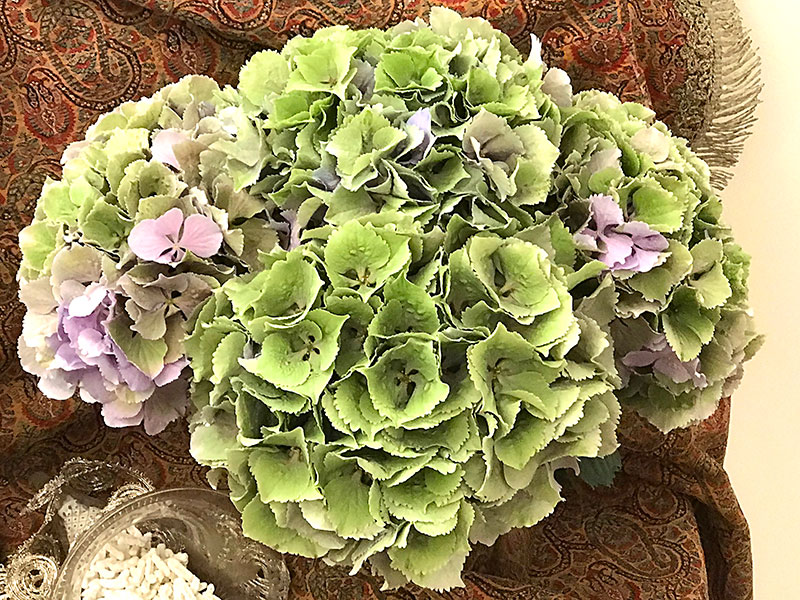
This is a close-up of the focal point of the arrangement. The spectacular bouquet of hydrangeas in tones of mauve and green clearly stands out. Not only are the flower heads monumental, but the florets are also very distinctive, well-formed and opulent. The smoky shades of mauve and green create a pleasing contrast with the muted yellow and orange tones of the background antique Persian textile, known as termeh.
Bridal Flow Rose
This luminous yet serene arrangement, which was inspired by Bridal Flow spray roses and presented in art deco containers, alludes to a Persian marriage sofreh, sofreh-ye aqd.

This silky bouquet of Bridal Flow spray roses, Pittosporum variegata, Lepidium, asparagus fern and ivy is presented in a silver-plated art deco vase and is placed at the heart of the marriage sofreh. The oversized rosette made of off-white silk complements the shape and shade of the Bridal Flow roses.
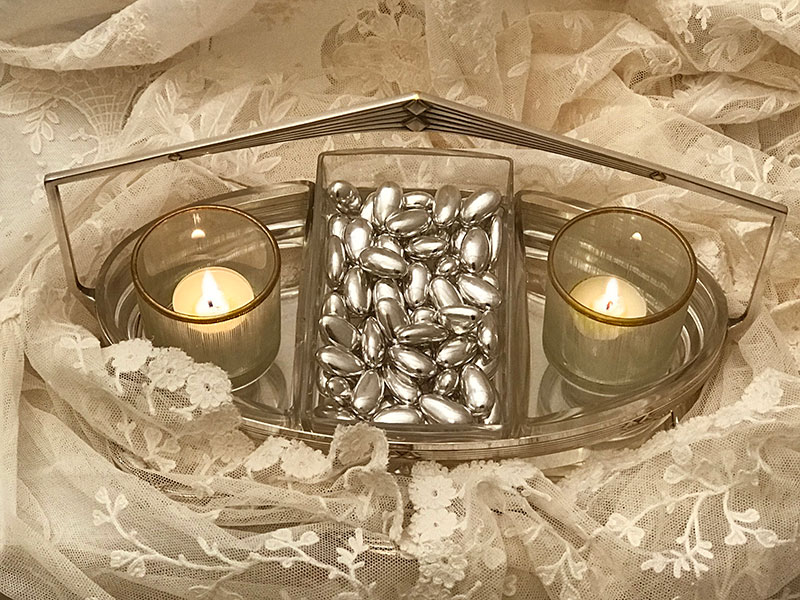
The focus of this image is the delightful silver-plated and crystal art deco container which holds shiny silver-finish sugared almonds, a symbol of sweetness and harmony. This radiant central section is illuminated with a pair of flames, presented in attractive gold-rimmed tea light holders. In this original marriage sofreh a length of antique lace is elegantly draped around the distinctive, shapely container.

The focus of this image is an open art deco box of decorated eggs, a symbol of fertility. A delicate pouch, made of antique Persian textile (termeh) and embroidered with silver threads and seed-pearls with a floral design, is on display. This exquisite bag either holds gilded coins, a symbol of prosperity, or it encases the bride’s cosmetics. This section is subtly illuminated with flames and draped with lengths of antique lace.
Snowball Hydrangea
These two compact compositions, with two different colour schemes, which echo the Persian marriage sofreh (sofreh-ye aqd) were inspired by a single stunning, splendid and superabundant hydrangea, known as Snowball.
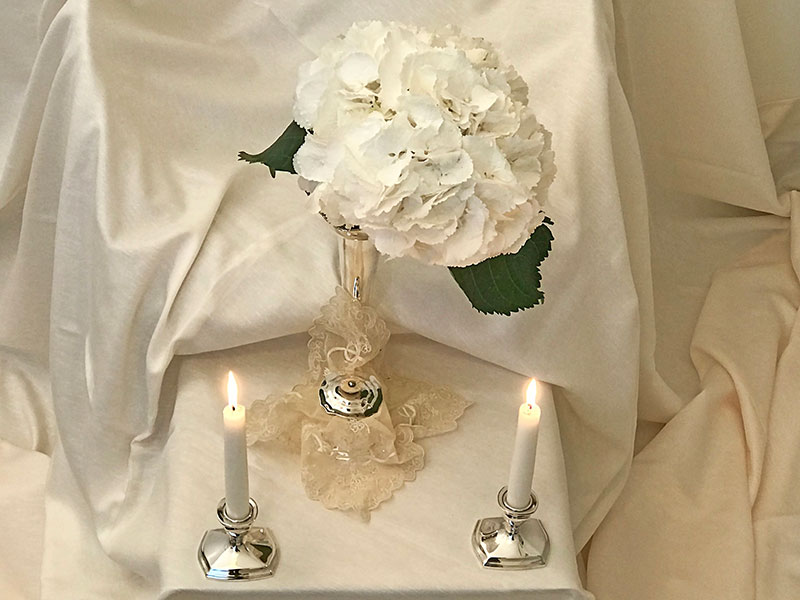
This is the first and simpler compact composition, inspired by the Snowball hydrangea. It is a subtle and soft "white-on-white" arrangement created on a generous length of ivory silk and illuminated by a pair of flames. A length of intricate, antique lace emerges from a delicate silver-plated box, which could contain appropriate symbolic elements of the marriage sofreh, such as sugared almonds (noql), a symbol of sweetness and harmony.
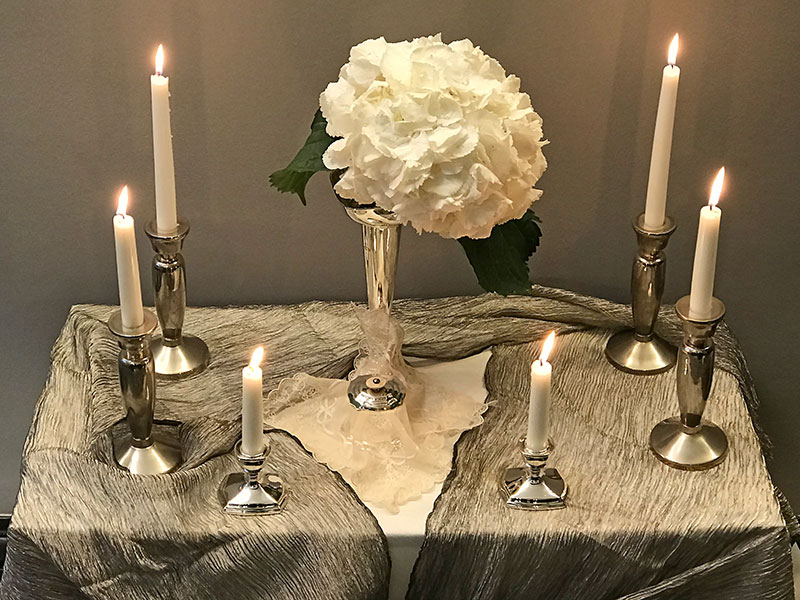
This is an alternative to the previous arrangement which includes the same Snowball hydrangea. In this version the colour scheme is silver, and the composition is illuminated, at different levels, with three pairs of flames. Again, a length of subtle, antique lace protrudes from a delicate silver-plated box, which could contain appropriate symbolic elements of the marriage sofreh, such as gilded coins (sekkeh), a symbol of wealth and prosperity.
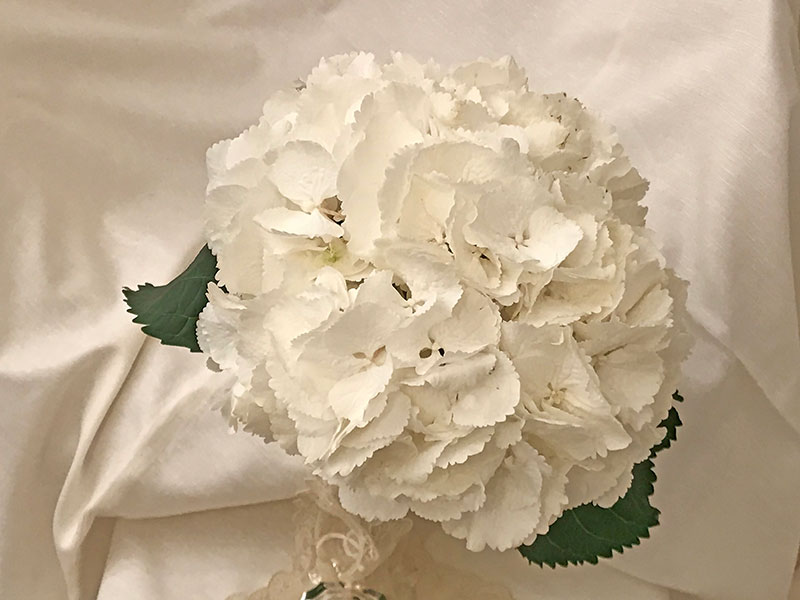
This is a close-up of the spectacular, ample and amazing single hydrangea, known as Snowball, which was the inspiration for creating the compact compositions above, which echo the Persian marriage sofreh (sofreh-ye aqd). The opulent textured sphere speaks to the draping and movement of the textiles which form the background spread in the simple arrangements above, with two different colour schemes.
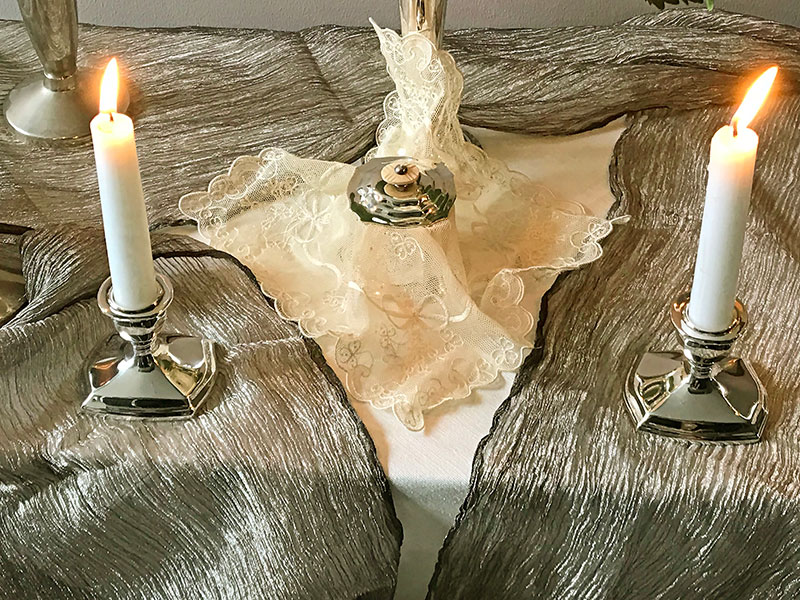
The focus of this image is the length of intricate, antique lace which flows from the delicate silver-plated box and is partially covered by its fine and elegant lid. This charming miniature composition features in both the compact arrangements above. A pair of flames illuminates this appealing ensemble. The silver-plated box could contain appropriate symbolic elements of the Persian marriage sofreh, such as noql or sekkeh.
Art Deco Box
This theatrical miniature sofreh is inspired by a silver art deco box which acts as a candleholder and supports the mirror mosaic. The bouquet of delicate roses, known as Chiffon, and fine asparagus ferns takes centre stage. A length of ivory and gold silk with a paisley (boteh) design is elegantly draped over the surface. Fragments of lace and antique-gold trim, tassels, leaves of ivy and sprigs of asparagus fern enhance the beauty of the composition. A few of the symbolic elements of the Persian marriage sofreh (sofreh-ye aqd), including sheaves of wheat, decorated eggs, sugared almonds, crystal sugar, gilded coins, rosewater and flames are imaginatively presented.
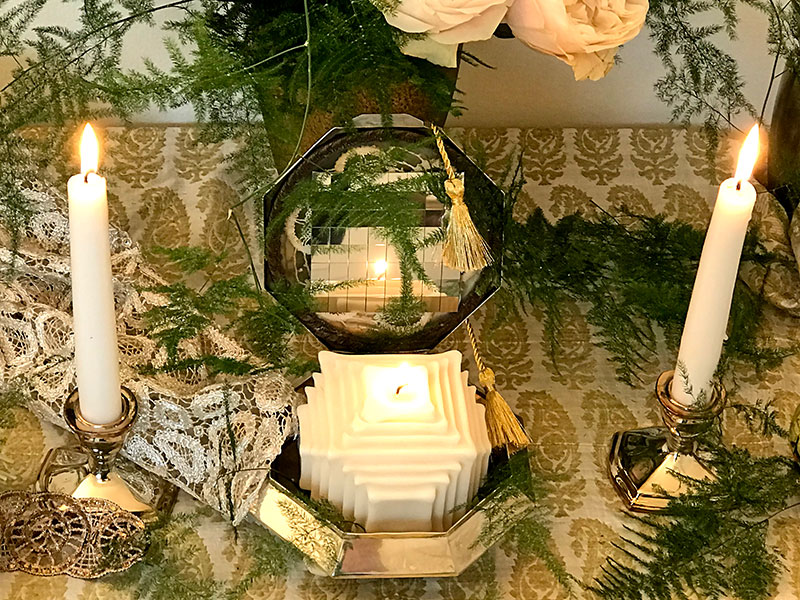
This is the heart of the theatrical miniature sofreh. The silver art deco box holds a single distinctive, candle with art deco-style relief. A mirror mosaic is propped up inside the box’s open lid. The box is embellished with fine gold tassels. This central section is illuminated with a pair of flames, and its beauty is enhanced by fragments of lace and antique-gold trim.

This enchanting and shapely silver-plated miniature tray of crystal sugar (nabat) in gold tones is placed at the front of the sofreh. It is subtly embellished with a few leaves of ivy and sprigs of asparagus fern. The gold paisley (boteh) design of the silk textile elegantly complements the shades of the crystal sugar, which is a symbol of sweetness and harmony.
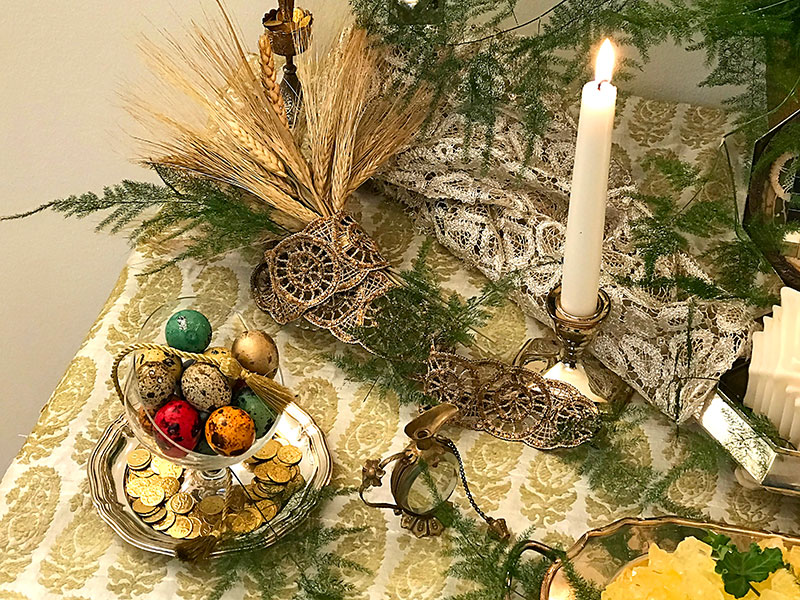
The focus of this image is the sheaves of wheat (a symbol of blessing and abundance), coloured eggs (a symbol of fertility), gilded coins (a symbol of prosperity) and a mirrored antique flask of rosewater (golab) to perfume the air. The beauty of this section is enhanced by sprigs of asparagus fern, fragments of lace and antique-gold trim, as well as delicate metallic-gold tassels. A single flame subtly illuminates this corner.
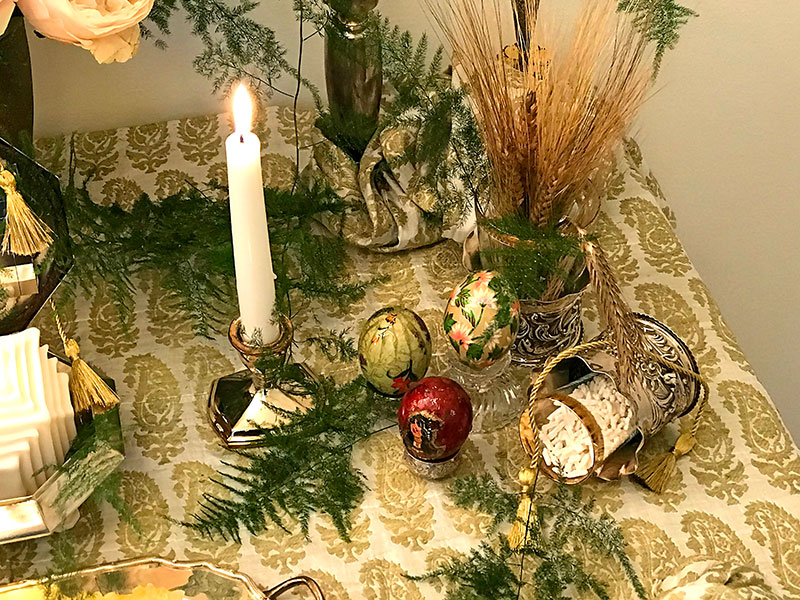
The focus of this image is also the sheaves of wheat, hand-decorated eggs and sugared almonds (noql, a symbol of sweetness and harmony), presented in a reclining glass cup, placed inside an antique silver vessel. The beauty of this section is also enhanced by sprigs of asparagus fern, delicate metallic-gold tassels, as well as the elegantly ruched ivory and gold silk that covers the surface. Another single flame illuminates this corner.
Furusato Rose
This is another simple and compact set-up which alludes to a marriage sofreh (sofreh-ye aqd). It is inspired by a soft bouquet of Furusato roses and foliage, and is again created on a mantelpiece in front of a mirror, both of which are antique and in the European style.
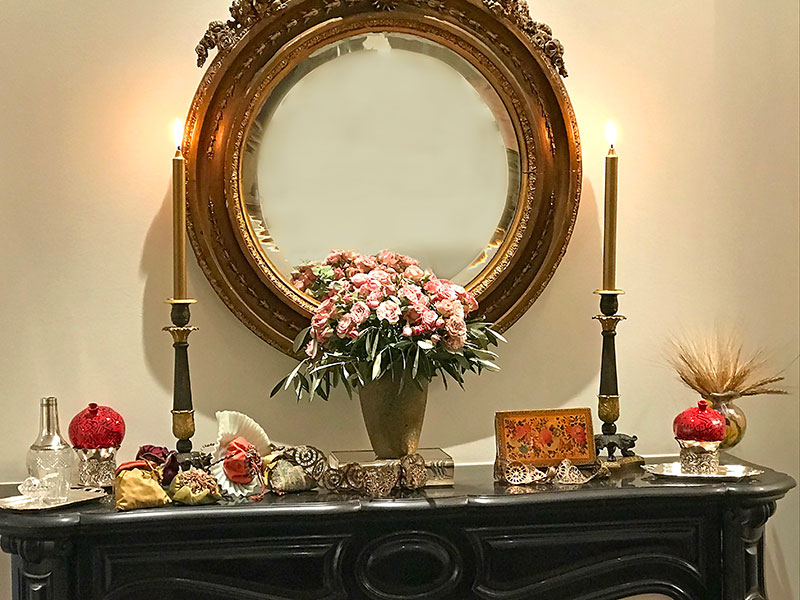
This is the overall view of the composition. The flowers take centre stage. Ceramic pomegranates, sheaves of wheat, an antique Qur’an, and a selection of bonbonnières are on display. The set-up is illuminated with flames and perfumed with rosewater, presented in an antique flask. Decorative metallic trims enhance the beauty of the arrangement.
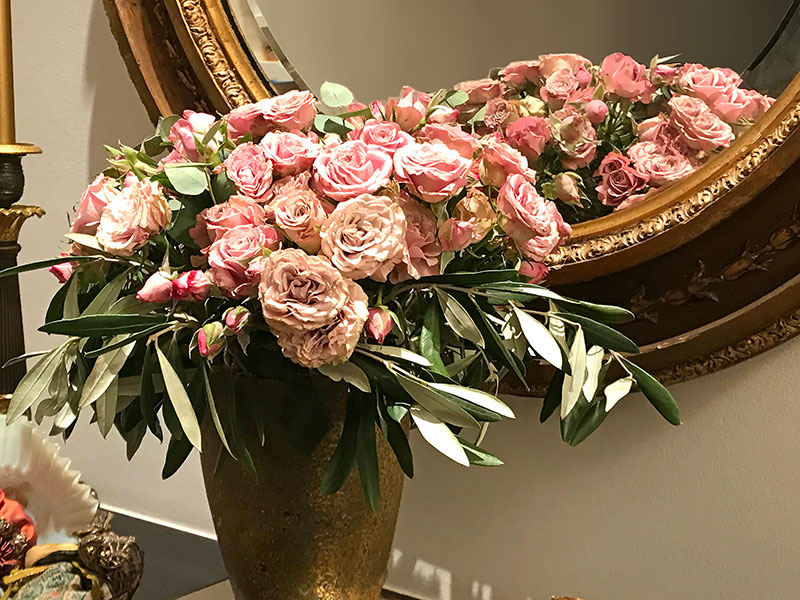
This is the heart of the composition, focusing on the delightful bouquet of a new variety of spray roses in subtle shades of smoky pink/peach, known as Furusato, and olive branches. The gold-finish vessel that contains the flowers complements the frame of the antique mirror above the mantelpiece. The reflection of the pastel bouquet of roses is spellbinding.
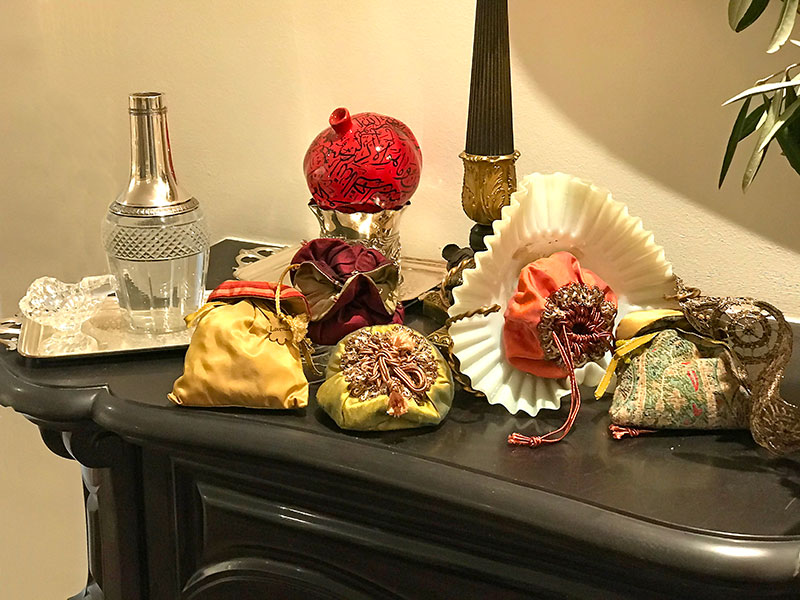
The focus of this image is one corner of the set-up, showcasing an antique silver and crystal flask of rosewater, which perfumes the air. Its crystal stopper is displayed separately. A single, bright red ceramic pomegranate is on view. Handmade bonbonnières, in the Persian spirit, are on show on the mantelpiece and in a reclining antique, frill-edged vessel.
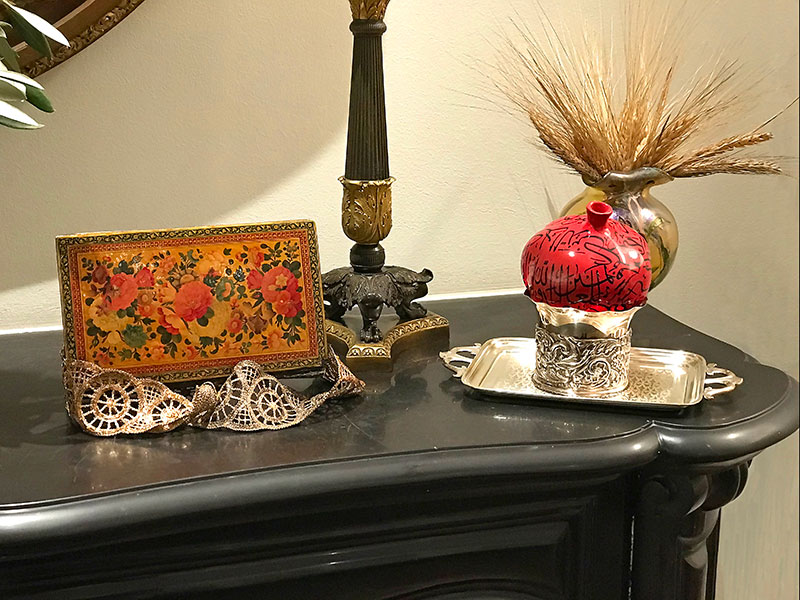
This image focuses on the other corner of the arrangement, showcasing an antique Qur’an with an exquisite papier mâché binding, embellished with an antique-gold trim. Sheaves of wheat, which are a symbol of blessing and abundance, as well as a single bright red ceramic pomegranate, which is a symbol of fertility, are presented in different antique containers.
Crimson Velvet
This pleasing arrangement alludes to a Persian marriage or Nowruz sofreh—soreh-ye aqd or soreh-ye haft sinn. It is inspired by an antique, intricately embroidered piece of rich-deep-red velvet.
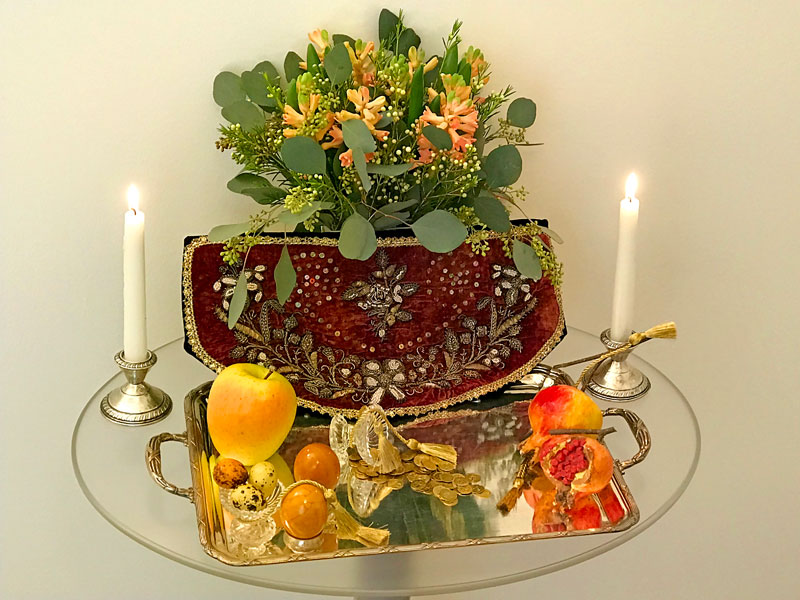
This is the overall view of the set-up. A bouquet of soft peach hyacinths, wax flowers and seeded Eucalyptus is on display. An attractive silver-plated tray contains a single apple, decorated eggs, sculptures of pomegranates and gilded coins. The crimson velvet is placed at the heart of the composition, which is illuminated with a pair of flames.
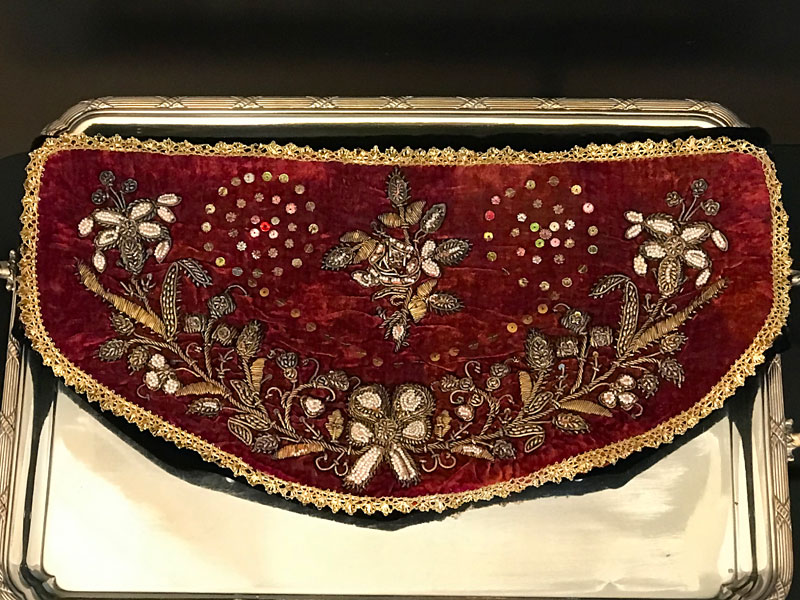
This is a close-up of the antique piece of embroidery that inspired the creation of this composition. The rich-deep-red velvet, which is embroidered with silver threads and seed-pearls, is probably Persian. The ornamental motifs are floral with leaves and tendrils. This decorative piece is also embellished with sequins and a gold-finish trim.
Wave Classica
This is a colourful and ornate arrangement, including a few of the symbolic elements of the Persian marriage sofreh (sofreh-ye aqd). The creation was inspired by an impressive bouquet of Wave Classica, a variety of Japanese Lisianthus, and foliage. The mirror and the candelabra, which are part of the traditional Persian marriage sofreh, are antique and in the European style.
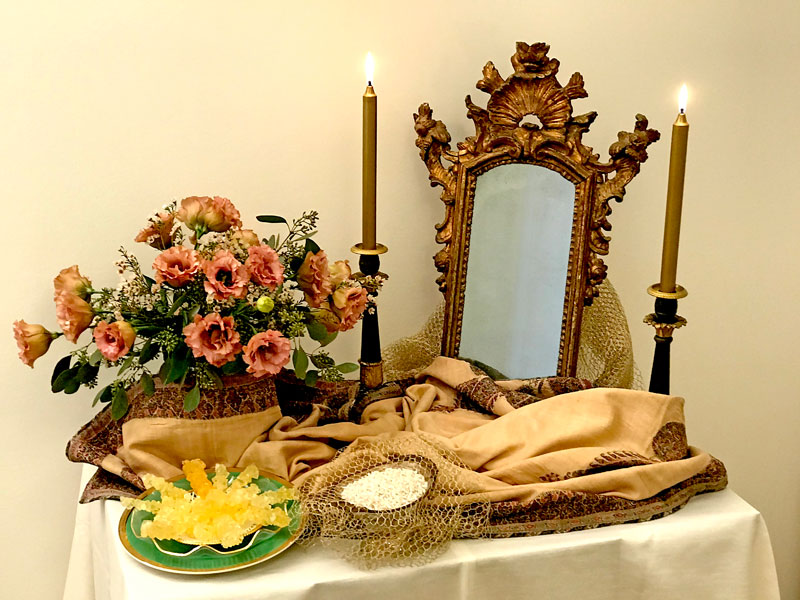
Here is the overall view of this vivid arrangement. A mirror and a pair of candelabra, a bouquet of flowers and foliage, sugared almonds and crystal sugar (noql o nabat) are on display. The arrangement is elegantly draped with an antique length of Persian silk, and brightened with fragments of open weave gold tulle which enhance its beauty.
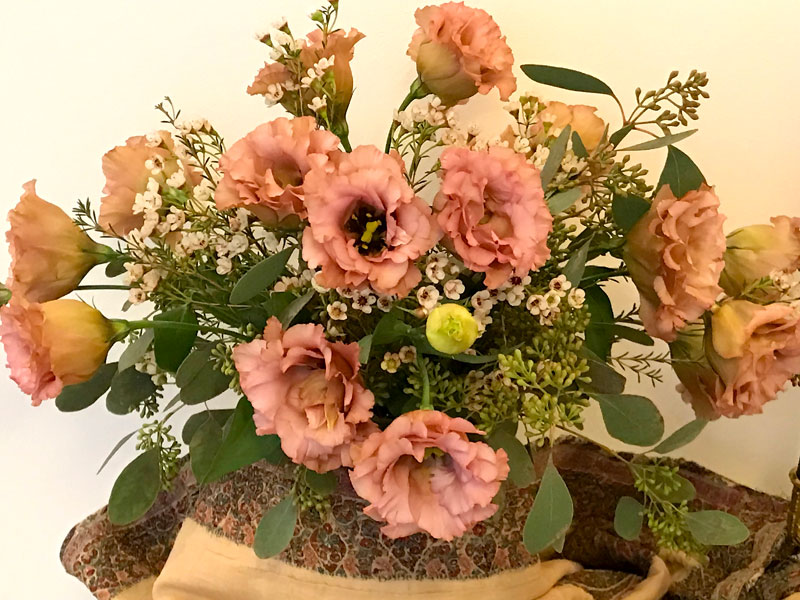
This splendid bouquet of Japanese Lisianthus, known as Wave Classica, wax flowers and Eucalyptus populus inspired the creation of this ornate set-up. This rare variety of Lisianthus presents soft, subtle and dusty tones of cream, pink and peach, which are nicely complemented by the colours of the antique Persian textile that is draped around it.
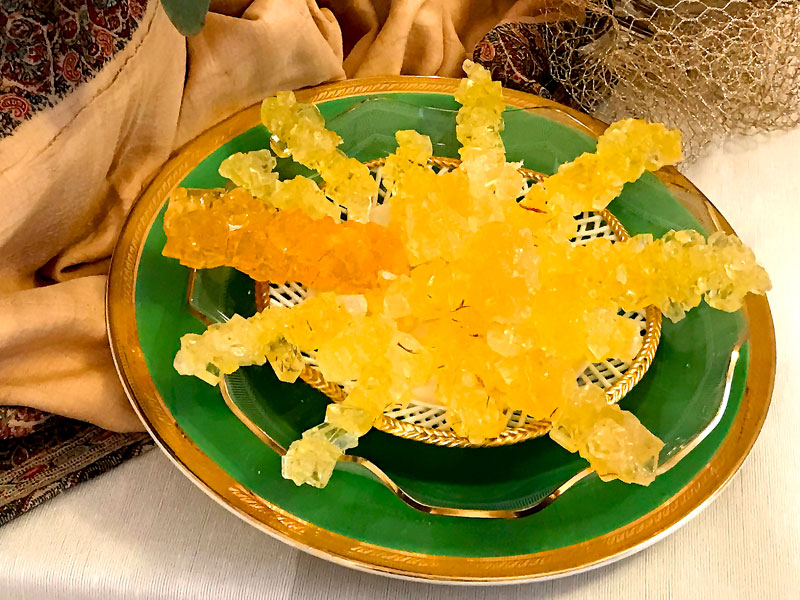
This is an original display of crystal sugar (nabat), employing a layering approach. The base is a bright green, gold-rimmed porcelain plate. A glass scalloped, gold-rimmed plate is placed on it and the sticks of crystal sugar are arranged on a smaller plate with a lace-like and gold-rimmed edge. Nabat is a symbol of sweetness and peace.
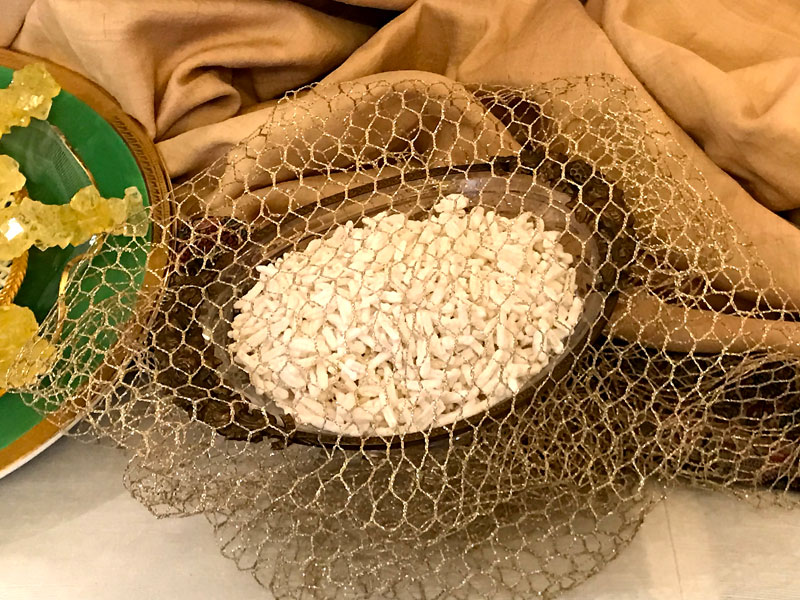
This is a close-up of the antique crystal and bronze container of the traditional Persian-style sugared almonds (noql)—a symbol of sweetness and harmony. In the Persian weddings, noql also plays the role of confetti. The elegant draping of the antique Persian silk and the movement of the gold tulle are manifestly apparent in this depiction.
Bubble Rose
This simple and compact arrangement alludes to a marriage sofreh (sofreh-ye aqd). It is created on a mantelpiece in front of a mirror, both of which are antique and in the European style.
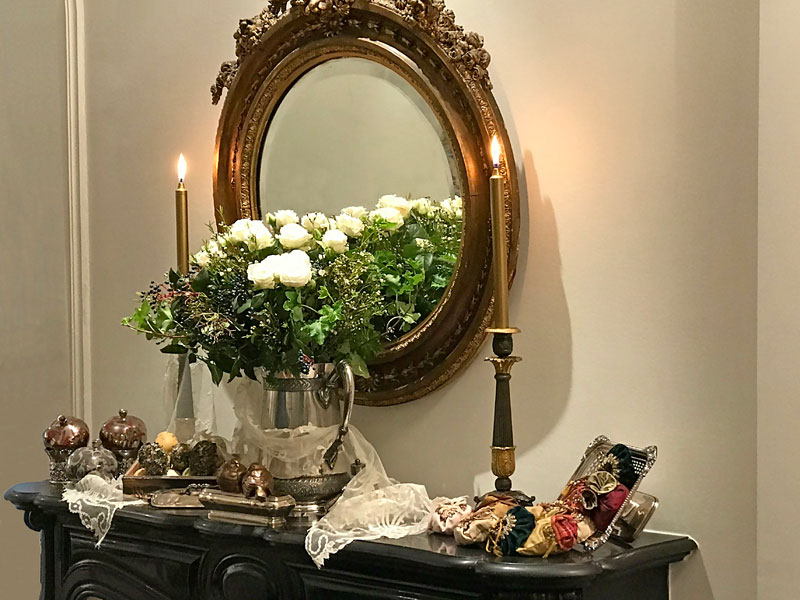
This is the overall view of the composition. A beautiful bouquet of white roses and foliage takes centre stage. Ceramic pomegranates, decorated eggs, a pair of birds and a selection of bonbonnières are on show. The set-up is illuminated with a pair of flames, while a length of antique lace is elegantly draped around the arrangement.
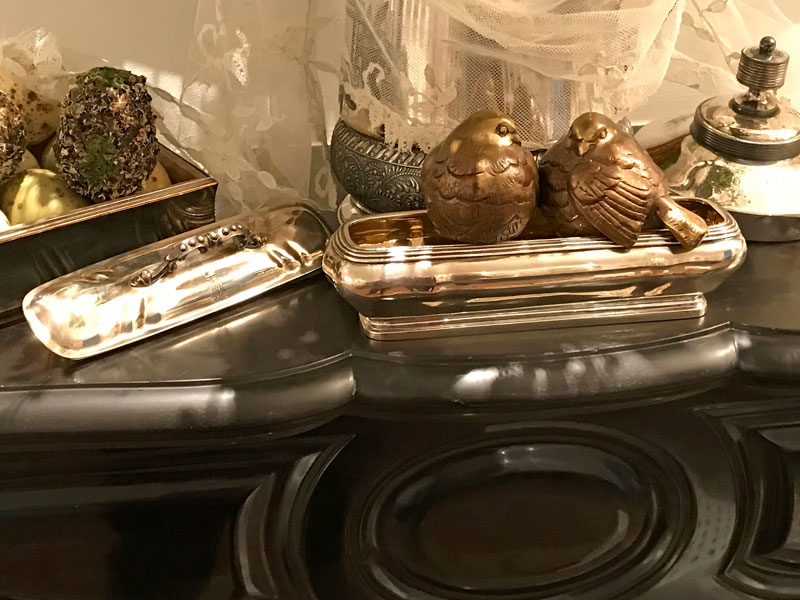
This image focuses on the lovely pair of antique-gold finish birds which personifies the couple. The statuettes are presented on top of an exquisite antique silver box, with its attractive lid elegantly displayed at a slant. A gracefully draped length of delicate antique lace is faintly visible in the background.
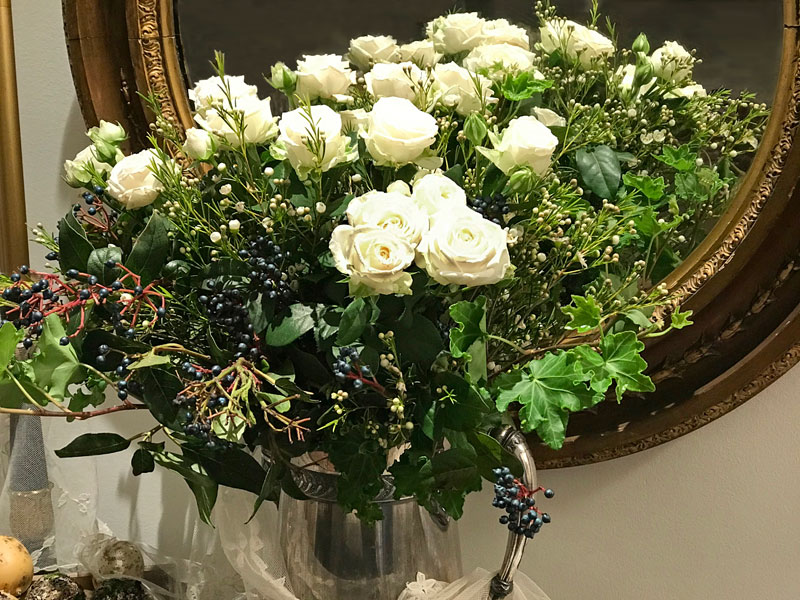
This airy and natural bouquet, which is composed of white Bubble spray roses, wax flowers, Viburnum tinus and an ornamental type of Japanese trailing ivy, is presented in an antique silver-plated urn, which is placed at the heart of the composition. The reflection of the bouquet in the mirror is dazzling.
Tisanières
In an attempt to introduce an original touch to the conventional sofreh for Nowruz, a collection of enchanting and colourful, antique tisanières (teapots on burners) are utilized to present some of the symbolic elements of the sofreh-ye haft sinn.
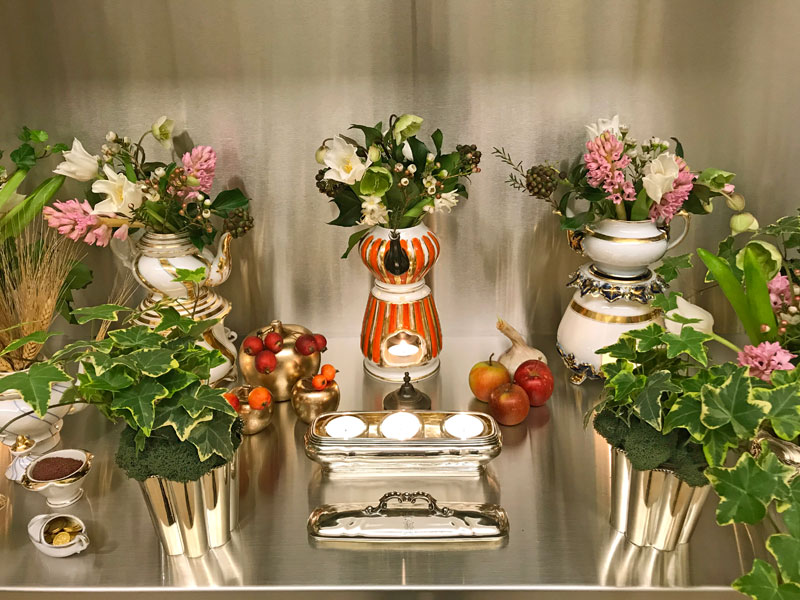
In this image the tisanières contain bouquets of tulips, hyacinths, hellebores, wax flowers and berried ivy. Flames shimmer inside the burners and an antique silver box with a lovely lid. Sculptures of apples embellished with crab apples are on display, as well as mini apples and a single bulb of garlic. The beauty of this composition is enhanced with two pots of variegated ivy.
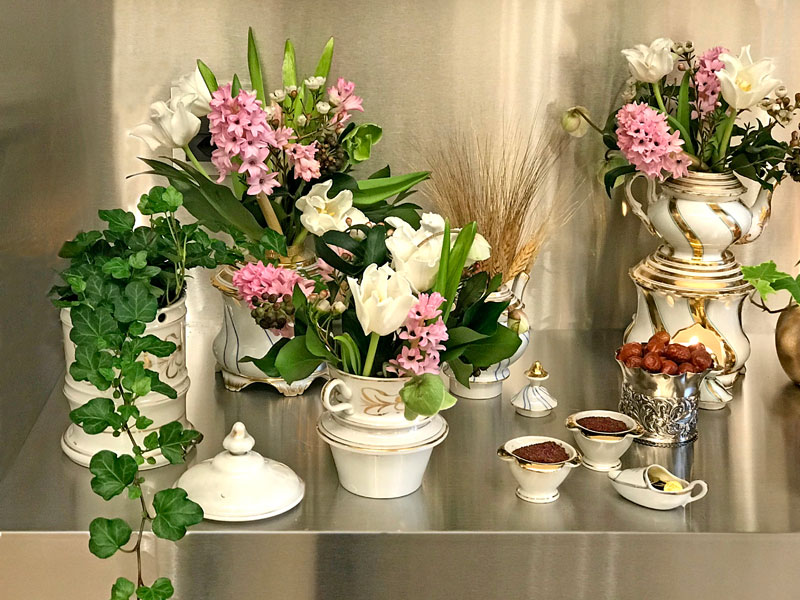
This image focuses on the other attractive tisanières holding bouquets of white tulips, pink hyacinths, hellebores, wax flowers and berried ivy. The tips of a spray of wheat, and the lid of the teapot holding it, can be seen in the background. The base of one of the tisanières holds a pot of trailing ivy which gracefully hangs over the forefront and enhances the beauty of this set-up.
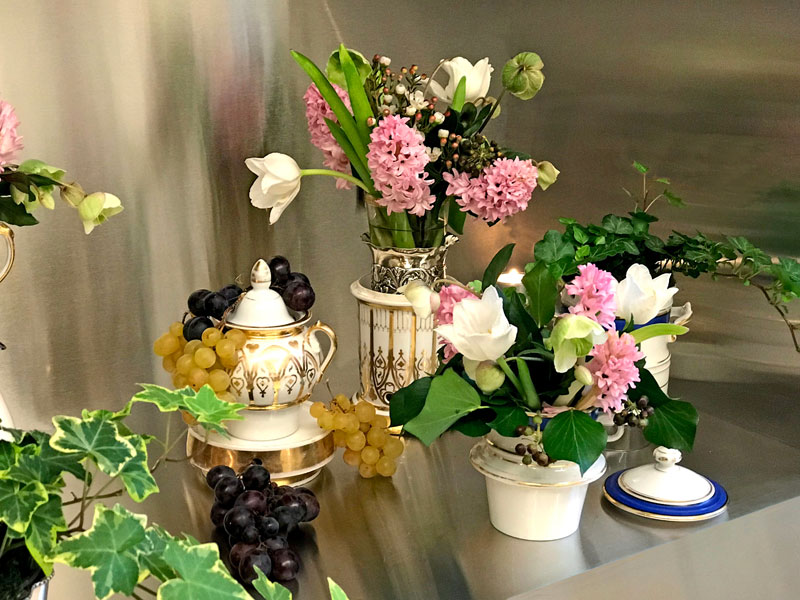
In this image a teapot with metallic-gold embellishment contains vinegar and is adorned with bunches of different colours of grapes. Its base holds a silver vase of hyacinths, tulips, hellebores, wax flowers and berried ivy. Another bouquet of the same flowers is presented in another tisanière with its blue-rimmed lid placed next to it. Graceful branches of trailing ivy are visible in the background.

In this image the teapots hold bouquets of spring flowers, hellebores and berried ivy. Flames shimmer inside the burners. A pair of miniature containers of ground sumac (somaq), a shapely burner containing gilded coins (sekkeh), and an antique silver vessel of jujube fruit (senjed) are on display. A pot of variegated ivy enhances the beauty of this original arrangement, which alludes to a sofreh.
Nowruz, 2020
In anticipation of Nowruz, this delightful sofreh was created, incorporating some of the symbolic elements of the sofreh-ye haft sinn. This original three-level composition is illuminated with numerous tea lights. Germinated wheat (sabzeh), spring flowers (hyacinths and tulips), an apple, and ceramic and fresh pomegranates are elegantly displayed. Statuettes of fish substitute live goldfish. Variegated trailing ivy, an impressive antique, carved-wood bow, and several pieces of antique textiles and embroideries enhance the beauty of this enchanting sofreh.
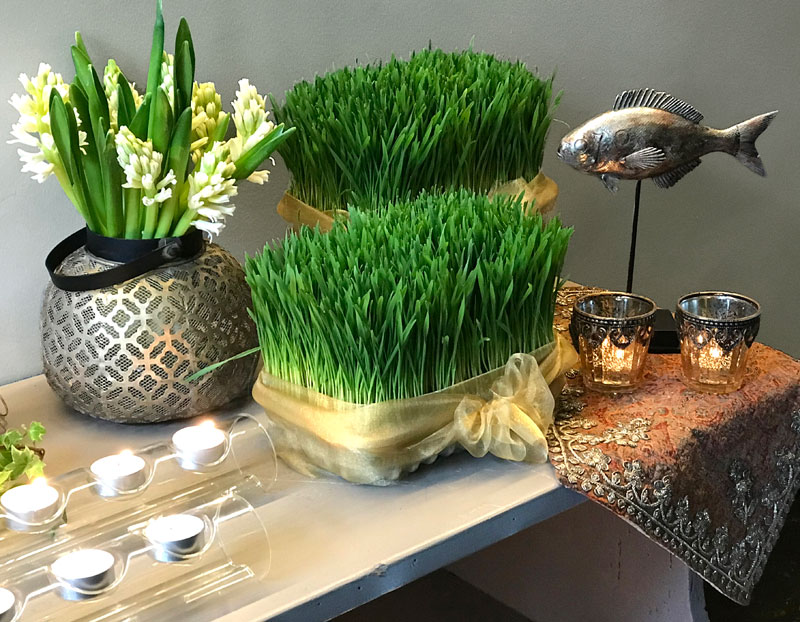
This is a close-up of one corner of the above sofreh. The image focuses on the blocks of germinated wheat (sabzeh), a symbol of growth and rebirth and the essence of this spring festival (Nowruz). Hyacinths, presented in an attractive vessel, lend beauty and herald the arrival of spring. A statuette of fish substitutes goldfish, a symbol of a number of things, including life, plenitude and blessing. Several flames illuminate this corner, and an exquisite piece of antique Persian textile (termeh) embroidered with silver thread enhances its beauty.
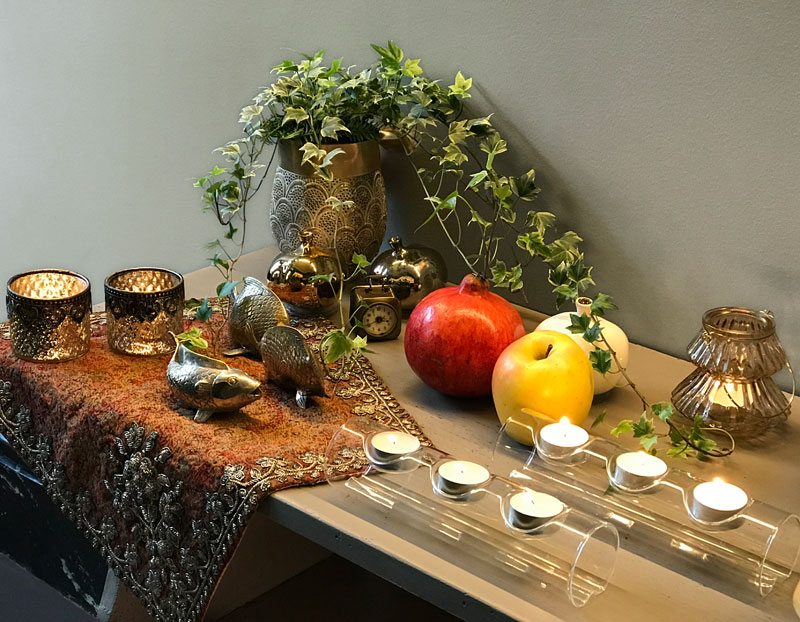
This is the other corner of the above sofreh. The focus of this image is the ceramic pomegranates in metallic gold and silver, as well as a single white one. A sole fresh, bright red, plump pomegranate and a single vivid Delblush apple, both among heavenly fruits (miveh-ye beheshti) symbolizing heaven and fertility, are on display. Statuettes of fish substitute live goldfish. A charming antique clock indicates the time at the start of the new year (sal tahvil). The beauty of this corner is enhanced with flames, variegated trailing ivy and another exquisite, embroidered antique Persian textile (termeh).
SOFREH as a Gift
The following compositions were especially designed to introduce the book on social media as a gift for different occasions. The posts present the book as a two-volume, lavishly illustrated publication which makes an enduring gift for those interested in art, culture and design. They also add that SOFREH includes many decorating ideas in the Persian spirit, as well as images of exquisite textiles, rare manuscripts and imaginative floral designs. To order your copy, please go to THE BOOK page.
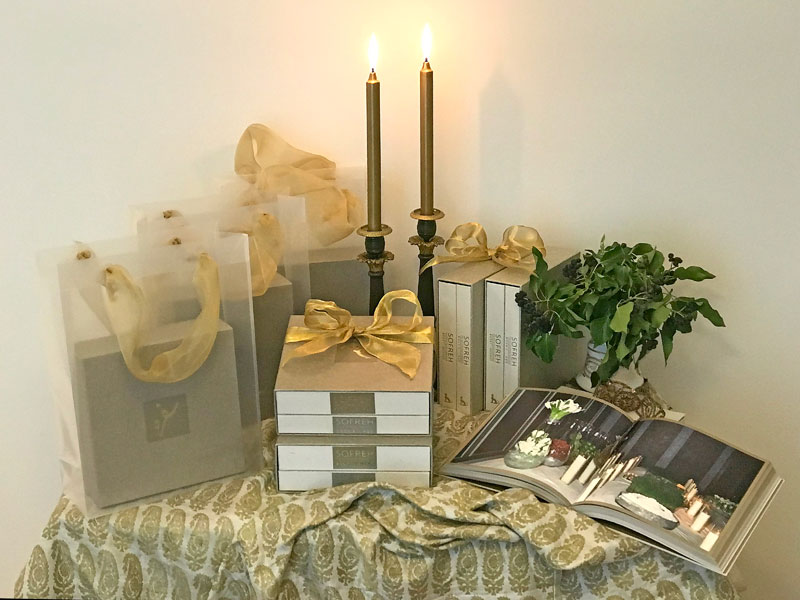
This simple sofreh was designed to present the book as a gift for any occasion. It is arranged over a lovely draped gold and off-white Indian silk. Different volumes of the book are on display, some of which are presented inside transparent gift bags to highlight the elegance of the binding. The composition is subtly illuminated with a pair of gold-finish candles and embellished with a simple bouquet of berried ivies.

This simple composition was designed in the Christmas spirit to suggest the book as a Christmas present. It incorporates holly and pine sprigs, as well as tea lights, presented in subtly gleaming holders, which illuminate the composition. The shimmering flame, which is displayed inside the attractive slipcase of the book, adds an original touch to the arrangement, which otherwise presents the books embellished with traditional Christmas bows and berries.
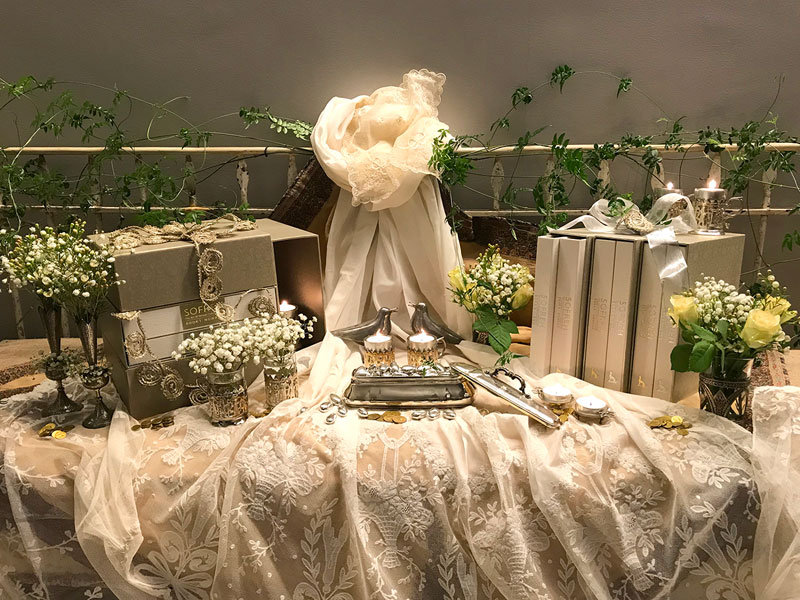
This original arrangement alludes to a marriage sofreh (sofreh-ye aqd). The elegant composition comprising different lengths of antique lace was created to suggest SOFREH as an appropriate wedding gift, as the book provides numerous ideas for decorating the sofreh-ye aqd. The composition is illuminated with flames, one of which shimmers inside a slipcase. Several other symbolic elements, such as a pair of enchanting bird sculptures, sugared almonds, gilded coins and flowers (roses, wax flower, baby’s breath and crawling jasmine) are on display.
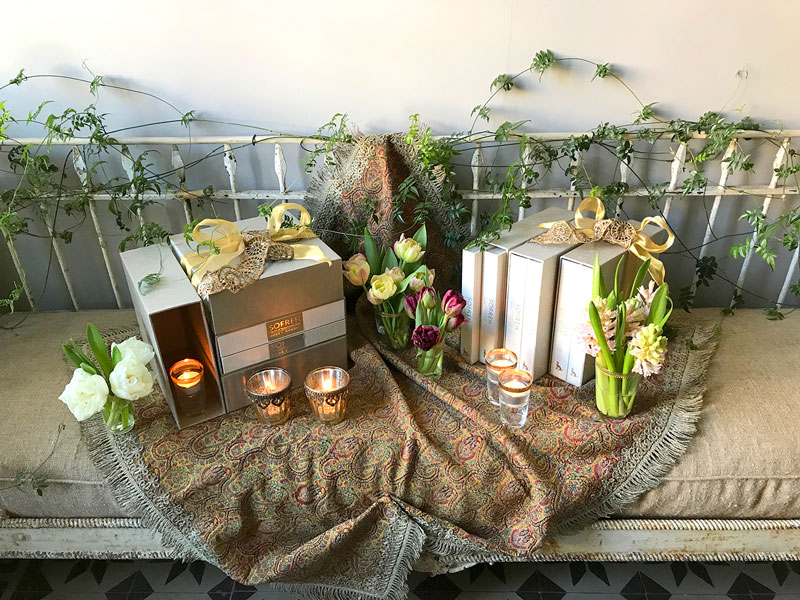
This charming composition alludes to a sofreh for Nowruz (sofreh-ye haft sinn). The background is gracefully embellished with crawling jasmine. A draped piece of antique Persian textile, known as termeh, is on display. Spring flowers, hyacinths and tulips, in a variety of colours are included. The composition is illuminated with flames, one of which shimmers inside a slipcase. This composition was designed to suggest SOFREH as an appropriate gift for Nowruz, as the book provides numerous ideas for decorating the sofreh-ye haft sinn.
Christmas Versus Nowruz
December 2019. This unconventional and original sofreh is inspired by Christmas ornaments such as pine cones, nuts, and holly and pine sprigs, as well as the symbolic elements of sofreh-ye Nowruz (haft sinn) such as germinated wheat (sabzeh), spring flowers (hyacinths and tulips), apples and pomegranates.
As the “Seven Steps” sofreh was well received, here the display has been presented on seven levels/steps. The first two images showcase the overall composition from two different views—from above and from below—which reveal a fascinating contrast.
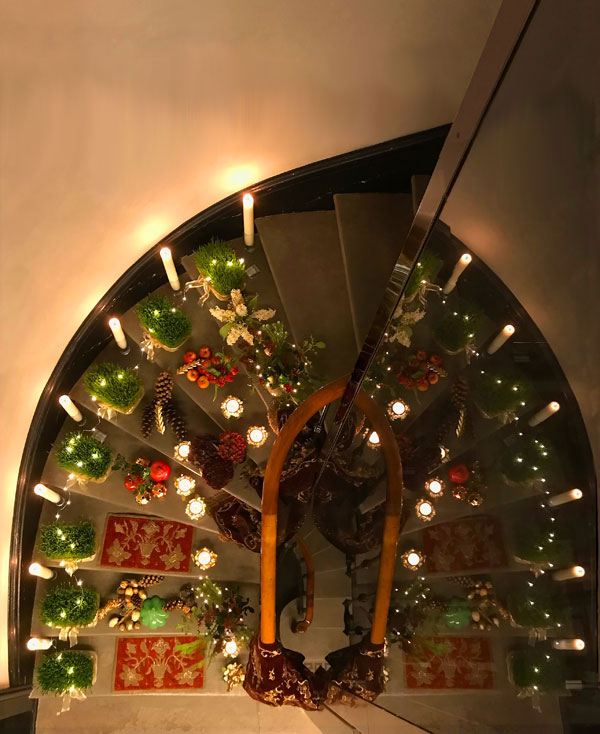
This image showcases an unusual view from the top of this original and descending sofreh, inspired by Christmas and Nowruz. The dazzling reflection of lights and flames in the glass stairway enclosure is alluring and magical. The image shows the actual illuminated sofreh on the left and its phenomenal mirror image on the right.
Apart from the many Christmas and Nowruz ornaments and symbolic elements, different shades of red and metallic gold evoke the spirit of Christmas, and echo the joy of Nowruz. This unusual and dazzling sofreh is illuminated with miniature Christmas lights, seven shimmering pillar candles and seven tea lights—flames are part of both Christmas and Nowruz adornments. The opposite image demonstrates the details of this creative sofreh more visibly.
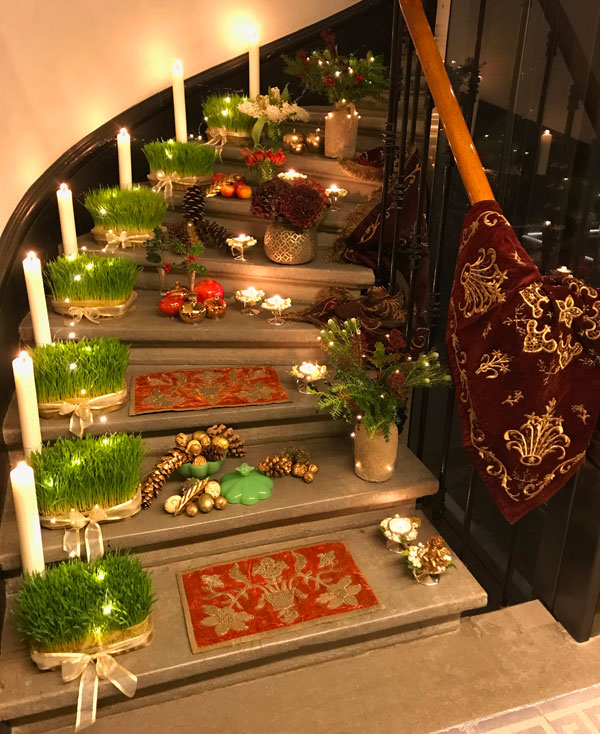
This is an overall image of the sofreh embracing the spirit of Christmas and Nowruz. Two ewers contain a variety of Christmas foliage. Seven blocks of sabzeh and seven glowing pillar candles, which echo the spirit of Nowruz, are included. The foliage and sabzeh are illuminated with Christmas lights which elegantly link the two important symbols of both celebrations. There are seven silver containers of shimmering tea lights, and the shiny ceramic pomegranates are reminiscent of baubles. Spring flowers, fresh apples and gold-finish sculptures of apples, decorated nuts, eggs and pine cones, gold-finish leaves, as well as a vase of hydrangeas are on display. This inclining sofreh is adorned with a pair of antique, European, embroidered pieces of velvet. Two other lengths of deep-red, Ottoman velvet embroidered with gold thread are draped around the handrail.
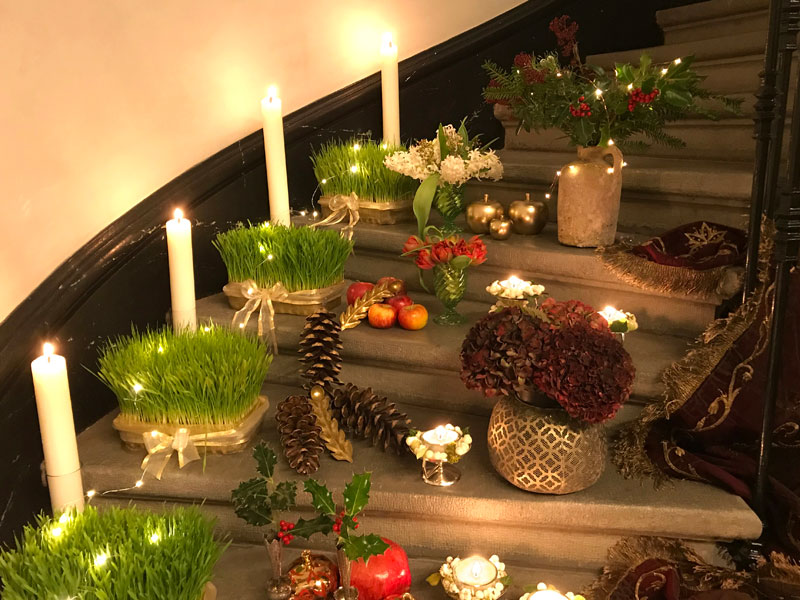
The focus of this image is the upper part of the sofreh on seven levels, embracing the spirit of Christmas and Nowruz. This section showcases the sabzeh (a prominent symbol of Nowruz), pillar candles, some of the tea lights and one of the ewers containing Christmas foliage—sprigs of holly, pine, Leucadendron ayoba, and Skimmia. The foliage and the sabzeh are decorated with miniature Christmas lights. Fresh apples, hyacinths and tulips echo the spirit of Nowruz. The hydrangeas in deep-red, gold-finish leaves and sculptures of apples, as well as the pine cones portray the spirit of Christmas.
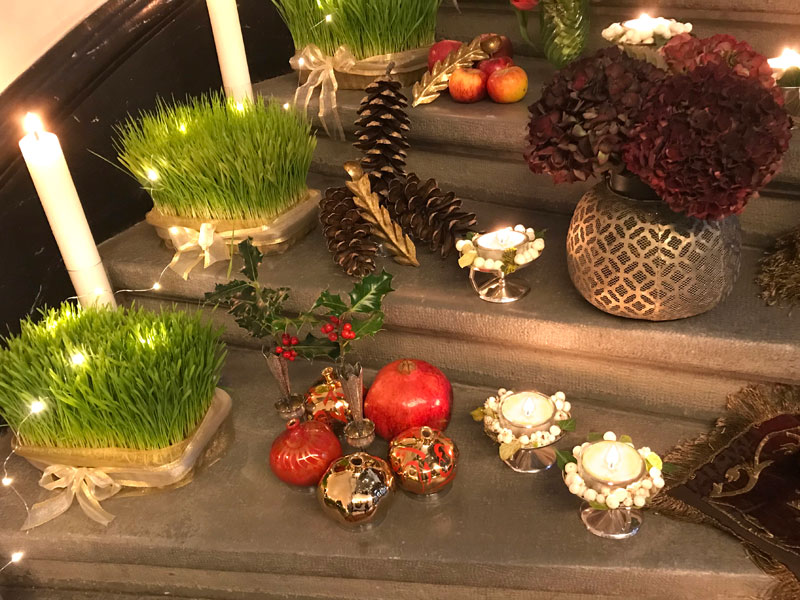
This is the midsection of the sofreh on seven levels, embracing the spirit of Christmas and Nowruz. The sabzeh (a prominent symbol of Nowruz) decorated with miniature Christmas lights, pillar candles, tea lights, pine cones and deep-red hydrangeas are on display. One fresh, oversized pomegranate (a symbol of fertility in the Nowruz tradition) is grouped with shiny ceramic pomegranates, reminiscent of Christmas baubles. A pair of miniature antique silver vases contains sprigs of holly, echoing the spirit of Christmas. The tea lights are placed in silver containers and surrounded by the white berries and a few leaves of the Symphoricarpos (snowberry) plant.
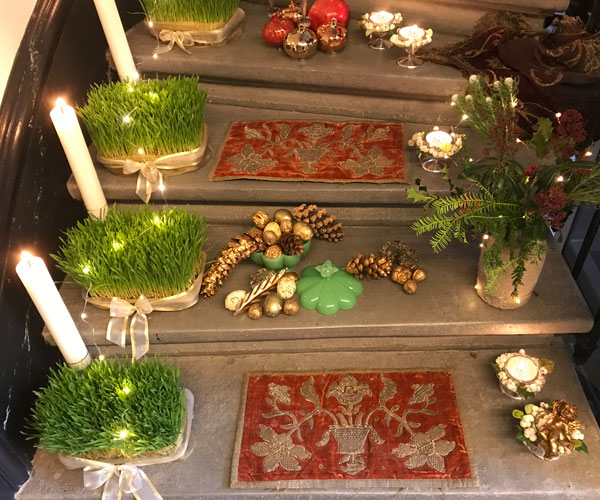
This is the lower section of the sofreh on seven levels, embracing the spirit of Christmas and Nowruz. The focus of this image is the pair of European, antique velvet textiles, embroidered with gold thread, as well as a lovely, shiny green container of decorated nuts, eggs, pine cones and gold-finish leaves. The sabzeh (a symbol of Nowruz) and an ewer containing Christmas foliage, decorated with miniature Christmas lights are visible. Pillar candles and tea lights are on display, as well as a charming, antique, gold-finish cherub, another hallmark of Christmas.
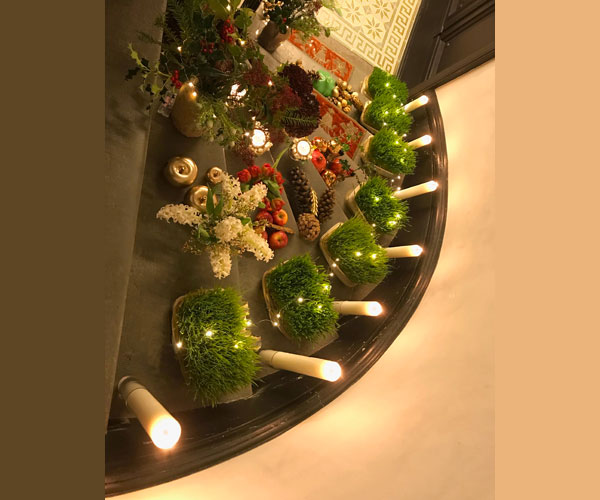
This is an engaging view from above the sofreh on seven levels, embracing the spirit of Christmas and Nowruz. In this image taken from an unusual angle, apart from the seven sabzeh decorated with miniature Christmas lights and the pillar candles, which are fully visible, the bouquet of white hyacinths, echoing the Nowruz tradition, has come to life. The fresh apples and especially the gold-finish sculptures of apples are more prominent. This is the last of the images of this group, effectively capturing the combined spirit of Christmas and Nowruz.
Shab-e Yalda, Winter Solstice
December 2019. Shab-e Yalda, or the winter solstice, is the longest night of the year. It is the eve of 1 Dey in the Persian calendar, corresponding to 21 December. The feast of Yalda originates in the pre-Islamic period and is associated with agriculture. The divan-e Hafez (works of 14th-century Persian poet, Hafez) to recite poetry, and fruits—watermelons and pomegranates—are important components of this celebration, heralding the crimson hues of sunrise after absolute darkness, and the promise of longer days ahead. In the Persian tradition people get together, tea, sweets, fruits and nuts are served, and stories and poetry are recited and fortunes are told, to get through the darkest and longest night of the year, when it is believed that demons are most active.
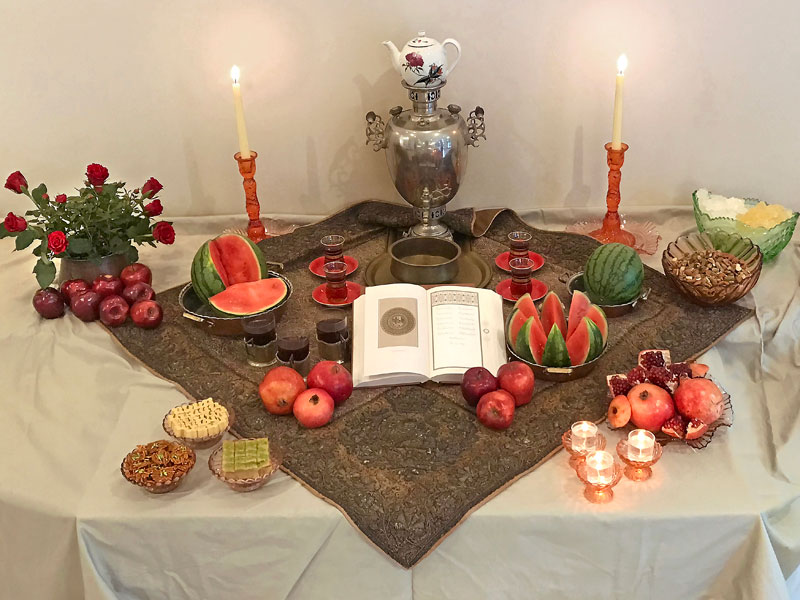
This is a variation on the previous sofreh. In this image the divan-e Hafez is open, and the ornamental container of crystal sugar has been moved to the background. Like the original sofreh, this one incorporates a samovar to serve tea, an exquisitely embroidered Persian textiles known as termeh, Persian sweets, crystal sugar, nuts, red fruits, flowers, flames and a divan-e Hafez.
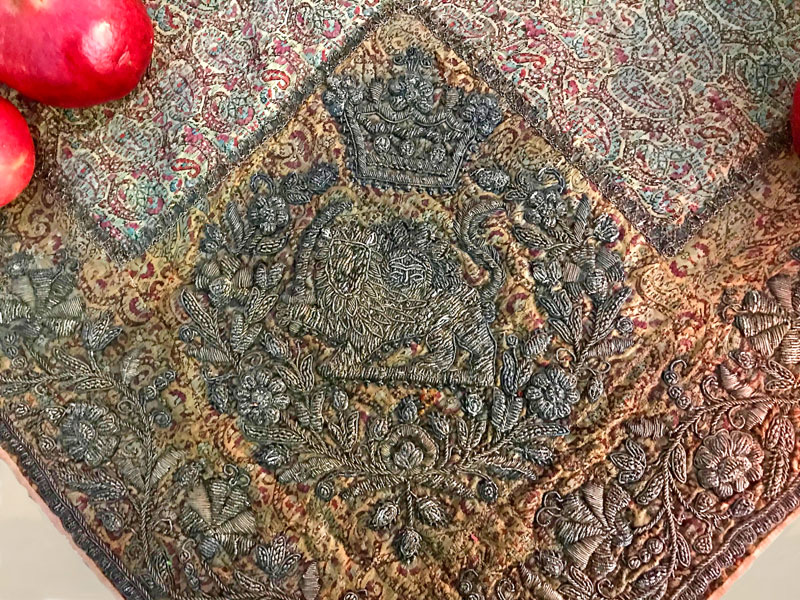
This is a close-up of the exquisite early 20th-century Persian textile, probably from Kerman, known as termeh. The focus of the image is the intricately embroidered lion and sun motif with silver threads. The symbol is enhanced with a crown, flowers and tendrils. In the Persian culture the lion and sun emblem has many historical meanings which have evolved over the years. Describing and summarizing its significance and evolution in this brief caption would not do justice to its influence, prominence and history.

The focus of this image is a corner of the sofreh. This is a lovely display of miniature deep-red rose plant and Freedom cut roses, arranged in a traditional copper vessel, surrounded by deep-red (Red Delicious) apples. A cut watermelon is presented in another copper vessel. Some glasses of tea and a lovely tinted-glass candleholder are on display. Red fruits are important components of this celebration, heralding the crimson hues of sunrise after absolute darkness, and the promise for longer days ahead.
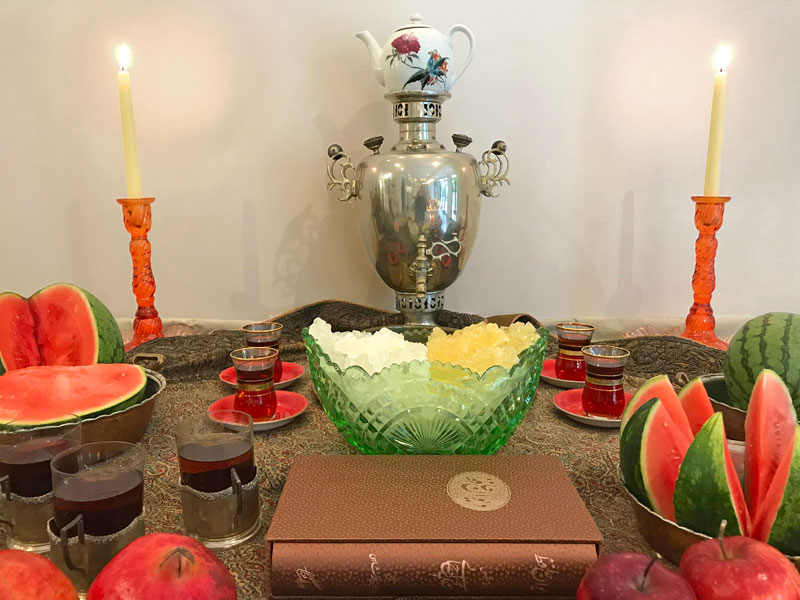
This is the heart of the sofreh which focuses on the samovar and the traditional teapot together with the tea ready to be served in traditional Persian glasses. A copy of the divan-e Hafez (works of the 14th-century Persian poet) is displayed in the forefront. The ornamental glass bowl, which contains the translucent pieces of crystal sugar in soft white and gold shades, takes a central position. This section is illuminated with a pair of candles in lovely tinted-glass candleholders.
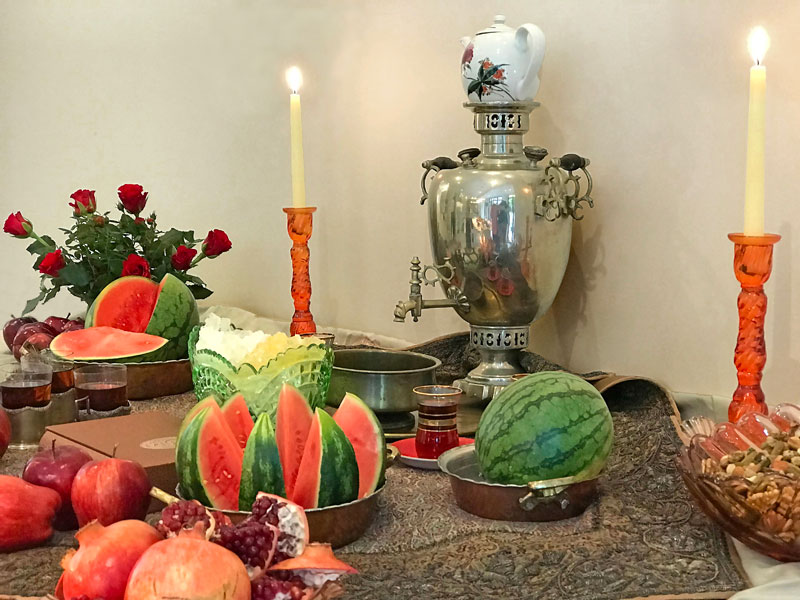
This is a side view of the heart of the sofreh. In this image the "tea paraphernalia”, tinted-glass candleholders, crystal sugar, whole and cut watermelons, pomegranates and apples, as well as deep-red roses are evident. Red fruits—watermelons and pomegranates—are important components of this celebration, heralding the crimson hues of sunrise after absolute darkness, and the promise of longer days ahead.
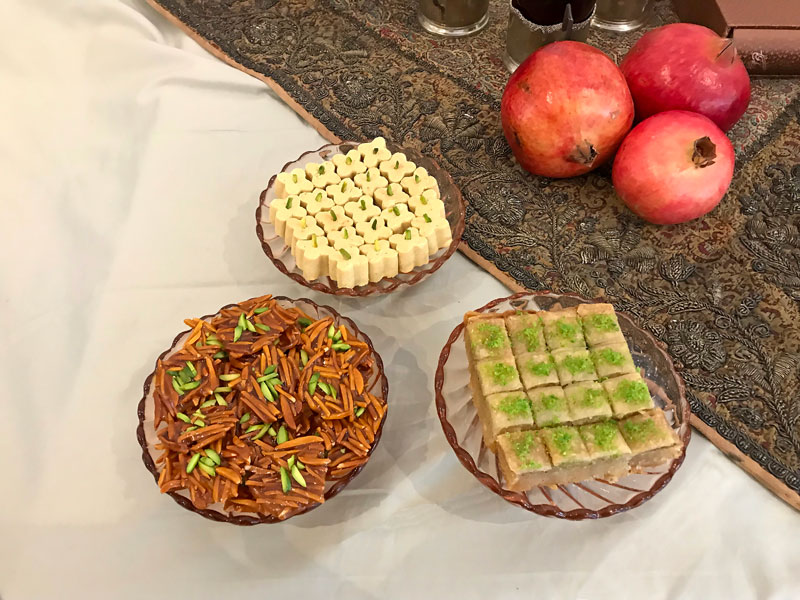
This is a close-up of the traditional Persian sweets and some whole pomegranates. The jewel-like, homemade sweets are usually served on festive occasions. Here three different varieties—principally made of almonds, pistachios, chickpeas and honey—are presented in lovely Persian tinted-glass dishes similar to the candleholders.
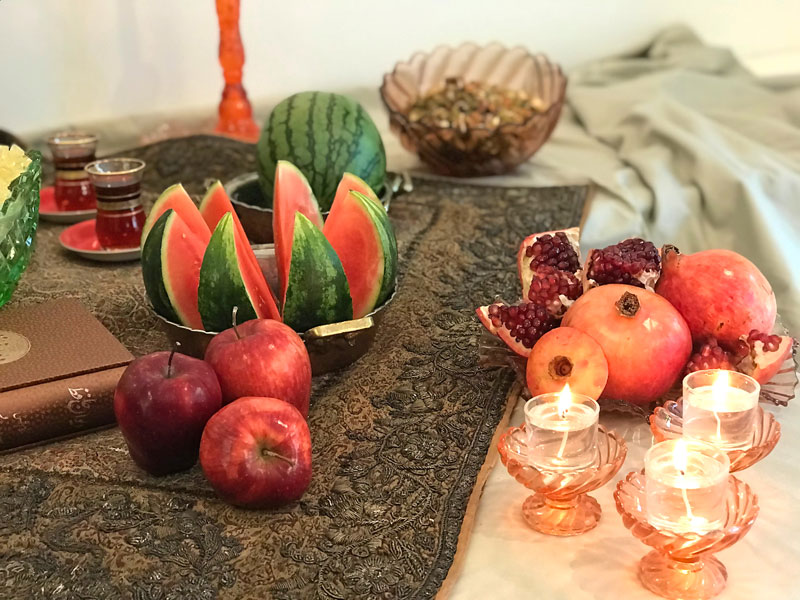
The focus of this image is another corner of the sofreh. This is a lovely display of whole and cut watermelons, arranged in traditional copper vessels. The pomegranates are presented both whole and opened on a tinted glass platter. Deep-red apples (Red Delicious) are displayed on the termeh. This corner is illuminated with three flames shimmering inside delicate Persian tinted-glass holders.
Jashn-e Mehregan
October 2019. Jashn-e Mehregan is an Iranian festival which is apparently dedicated to the god of Mithra (Mehr). To read more, please visit http://www.iranicaonline.org/articles/mehragan. Very briefly, in the Persian culture, Mehregan is believed to have the same significance as Nowruz, with Nowruz signalling the beginning of spring and Mehregan marking the arrival of autumn. The celebrations, which have their origins in the pre-Islamic period and are associated with agriculture and harvest, are usually held between 16 and 21 Mehr in the Persian calendar, which correspond to 8 and 13 October. Presently, sofreh is not part of the Mehregan customs, though apparently in the past it was. To mark the occasion, here is a sofreh showcasing a contemporary interpretation of past practices.
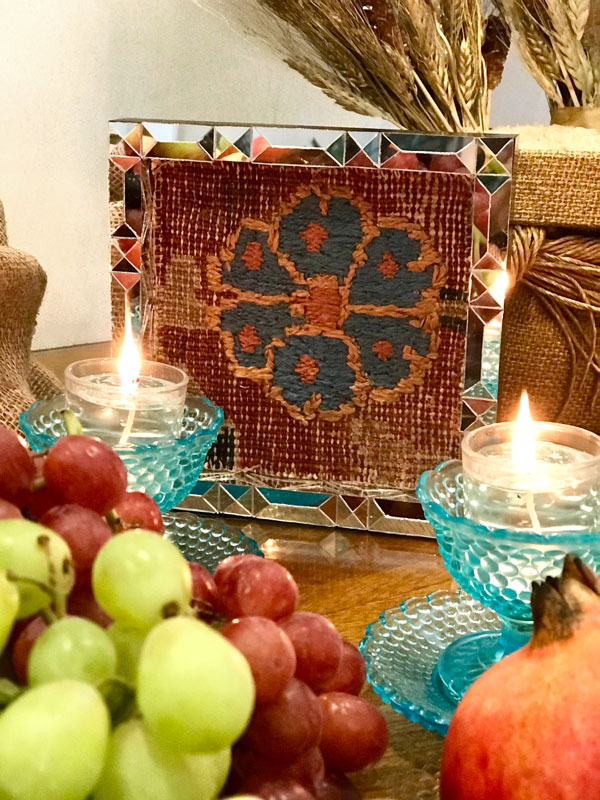
This is a section of the sofreh, created to mark the occasion of Jashn-e Mehregan. This image focuses on an artwork by the Iranian artist, Bita Ghezelayagh, who typically works with woven material. Here she has combined a fragment of worn Persian carpet with the classic Persian art of mirror-work (ayeneh kari). This original piece of art which echoes fabrics and a customary mirror—elements which are usually part of a sofreh—is illuminated with flames inside a pair of turquoise-tinted holders. The vivid colour of the holders complements the pattern of the artwork.

This is a corner of the sofreh, created to mark the occasion of Jashn-e Mehregan. This image focuses on the natural and gold-tinted sheaves of wheat and translucent shades of crystal sugar, tied together and made into bouquets. They are placed inside an attractive hessian bag filled with rice. The combination of the soft tones of the bouquet and the hessian creates a pleasant harmony. Wheat and rice are associated with harvest and are symbols of blessing and abundance (barekat), and crystal sugar indicates the aspiration for a sweet and pleasant time ahead.

This is the central section of the sofreh, created to mark the occasion of Jashn-e Mehregan. This image focuses on a free-flowing bouquet of miniature and spray cream roses and baby’s breath. The soft, natural arrangement is draped with an open-weave length of hessian, which partially covers the surface, and alludes to a traditional sofreh.
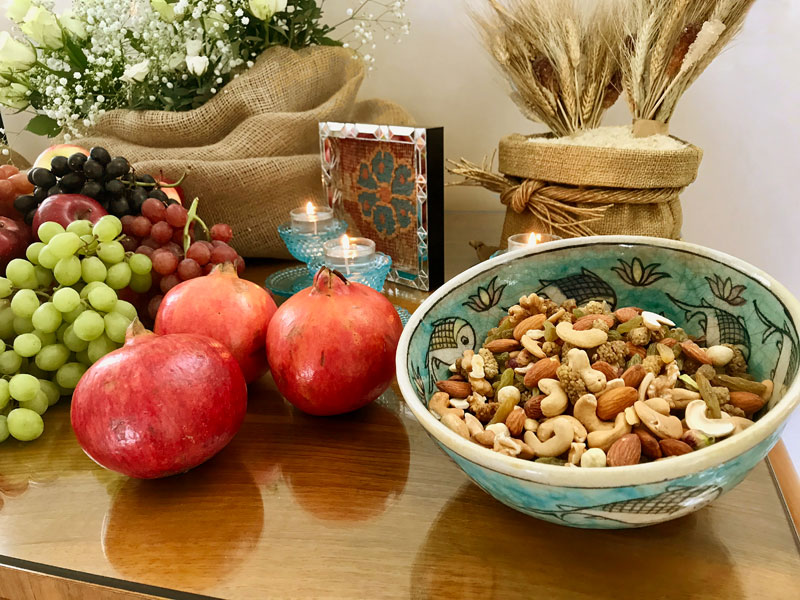
This is another feature from the sofreh, created to mark the occasion of Jashn-e Mehregan. This image focuses on the other heavenly fruit (miveh-ye beheshti)—plump, shiny pomegranates, a symbol of fertility—as well as a vivid turquoise-coloured container of mixed dried fruit and nuts, which are usually served on festive occasions.

This is a corner of the sofreh, created to mark the occasion of Jashn-e Mehregan. This image focuses on more heavenly fruit (miveh-ye beheshti)—a ceramic turquoise-coloured pomegranate, next to crimson pomegranates, a symbol of fertility. Attractive Persian ceramic bowls with fish motifs, containing sugared almonds (noql) and gilded coins, symbols of festivity and prosperity, are elegantly displayed. This corner is illuminated by a single tea light, set inside a brightly-coloured turquoise Persian glass holder placed on a matching saucer.
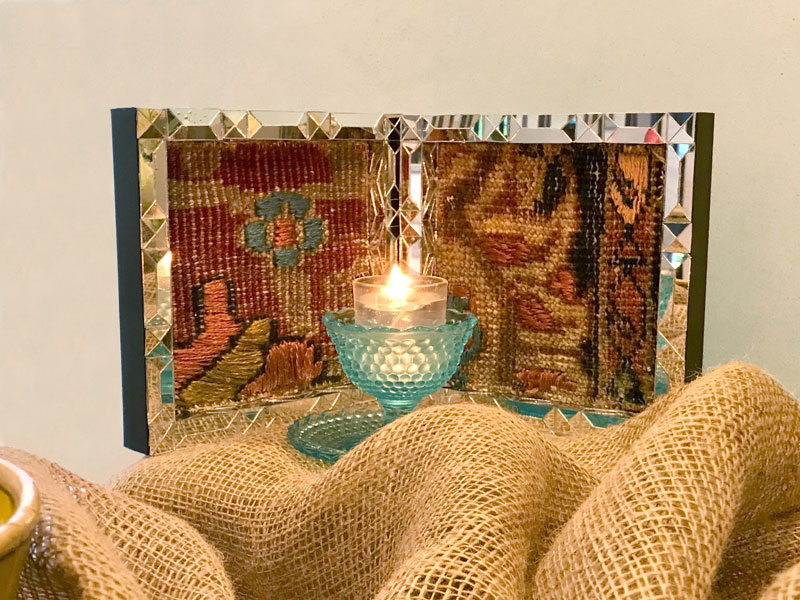
This is the last image of the sofreh, created to mark the occasion of Jashn-e Mehregan. Here, the focus is on another original artwork by Bita Ghezelayagh. This piece, too, is a combination of the fragments of worn Persian carpets and the classic Persian art of mirror-work (ayeneh kari). This piece also echoes fabrics and a customary mirror—elements which are usually part of a sofreh. This novel work has been illuminated with a single flame inside a delicate turquoise-coloured holder, which picks up the shades of the weaves of the artwork.
Simple Ideas for Marriage Sofreh, 2019
The following arrangements, which allude to a marriage sofreh (sofreh-ye aqd), present some quite simple decorating ideas. They have been inspired by a variety of alluring flowers with distinct and different textures, colours and forms.
Secret Garden Rose
This dainty sofreh incorporates a single open rose, known as Secret Garden, and a few sprigs of asparagus fern. They are placed in a 19th-century Bohemian emerald green vase, with gold decoration and a medallion with hand-painted floral design. A pair of silver candleholders and a piece of antique lace are included in this natural and quiet arrangement.
Country Garden Roses
Here is another simple suggestion for decorating a marriage sofreh. It comprises only three stems of a new variety of rose, mixed with foliage. A draped crêpe-like, antique gold-coloured textile covers the vase and the surface. The arrangement is illuminated with a pair of antique gold-coloured candles and a flame, shimmering inside a lantern. Fabrics, flowers and flames are paramount in decorating a sofreh.
Hydrangeas & Lace
This is a simple suggestion, incorporating a low, rectangular, modern glass vase of hydrangeas and asparagus ferns, placed on a lavishly draped, silver-green raw silk. The arrangement is subtly illuminated with a pair of candelabra, and gracefully draped with a length of antique lace.
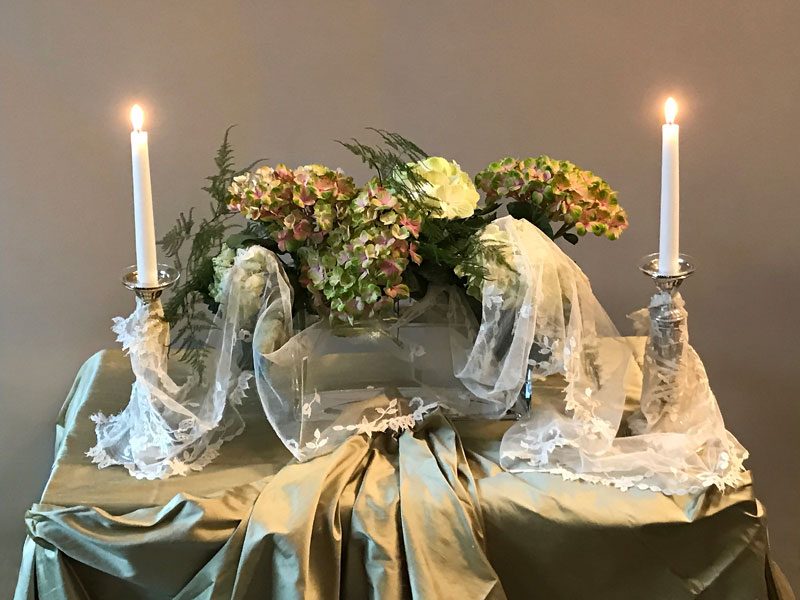
This is the overall view of the Hydrangeas & Lace composition, arranged on a lavishly draped silver-green raw silk and elegantly adorned with a length of fine ivory antique lace. This simple sofreh emanates softness and serenity, with the folds of the voluminous silk illuminating the elegant arrangement.
Juliet Roses & Lace
This composition is a variation on the sofreh with hydrangeas. The lavishly draped green silk forms the background. Here roses in a white, modern, upright vase have replaced the hydrangeas in a glass rectangular vase. The same candelabra illuminate the flowers, and the gracefully draped length of antique lace enhances the beauty of the arrangement. Again the importance of fabrics, flowers and flames is demonstrated in this simple arrangement.
Piano Garden Roses, Silver & Gold
These lovely garden roses, known as Piano, are at the heart of this original sofreh, which is arranged on an acrylic table, placed over a lavishly draped, crêpe-like silver textile. Several lengths of gold tulle adorn the arrangement and a fragment of lace partially covers the table. The sofreh is subtly illuminated by the flames of the tea lights in silver containers and in the “pocket” of the table. A silver bottle of rosewater perfumes the air.
New Ideas for the Wedding Season, 2019
Spring/Summer 2019. The wedding season is upon us. A selection of new design ideas for the marriage sofreh (sofreh-ye aqd) have been added to this page. Here are two introductory images of decorated miniature sugarloaves (kalleh qand), presented on two different antique Persian textiles. Sugarloaves reflect an aspiration for a sweet and harmonious married life.
Lace & Pearl Diamond Rose
This soft compact marriage sofreh juxtaposes the beauty of European antique lace with the striking effect of the silk, satin and velvet handmade bonbonnières, in the Persian spirit. A silver box holds an arrangement of ivory spray roses and foliage. Two pairs of silver candelabra flank the flowers. Some other symbolic elements included are ceramic pomegranates, sugared almonds, bunches of wheat and gilded coins.

This is the heart of the sofreh. The focus of this image is the Indian silver box with its open lid which is lined with lace. It holds the delicate ivory spray roses, known as Pearl Diamond, and a fine foliage (Lepidium), which complements the arrangement. The shimmering flames subtly illuminate the dainty ivory roses and foliage.
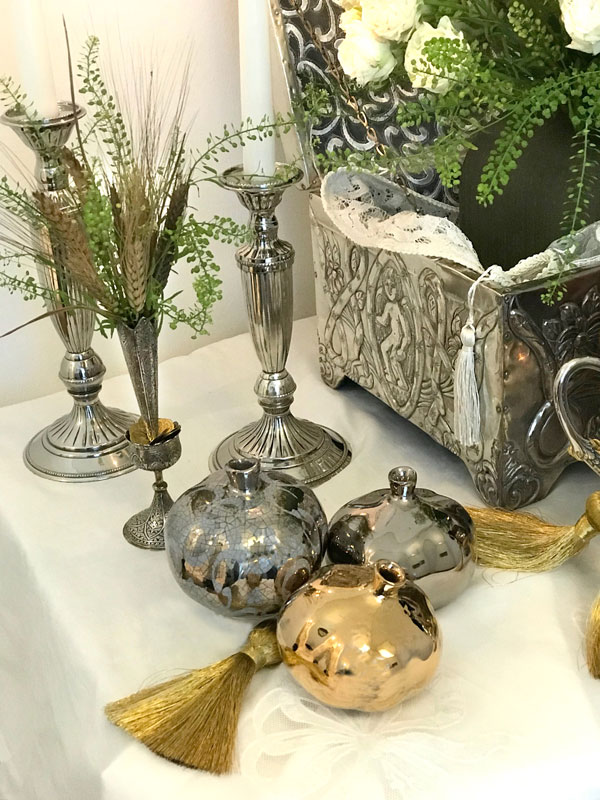
This image showcases the left side of the sofreh. It focuses on the shiny gold-and silver-finish ceramic pomegranates, symbolizing fertility. A bouquet of fine foliage (Lepidium) and wheat, representing bread (a symbol of abundance and blessing), is on display. The “pocket” of the slim, antique, Persian silver vase is filled with gilded coins, a symbol of wealth and prosperity.
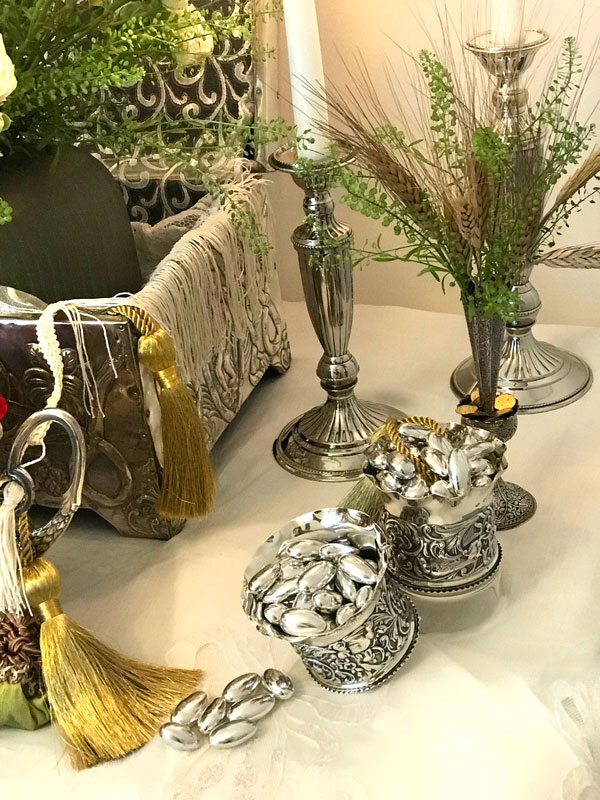
This image showcases the right side of the sofreh. It focuses on the silver-finish sugared almonds, symbolizing a sweet married life. Again, a bouquet of fine foliage (Lepidium) and wheat, representing bread (a symbol of abundance and blessing), is on display. The “pocket” of the slim, antique, Persian silver vase is filled with gilded coins, a symbol of wealth and prosperity.
Parrot Tulips & Termeh
Sensual Touch, which is a very late and rare variety of parrot tulip with variegated leaves, was the inspiration for creating this marriage sofreh.

This is the overall view of the sofreh, known as Parrot Tulips & Termeh. The composition includes some of the symbolic elements of the sofreh, such as candelabra, decorated hen and quail eggs, and ceramic pomegranates. They are elegantly displayed on an antique, intricately embroidered Persian textile, known as termeh. This image reveals the pleasing contrast between the deep-red termeh and the elegantly draped rich and voluminous ivory raw silk.
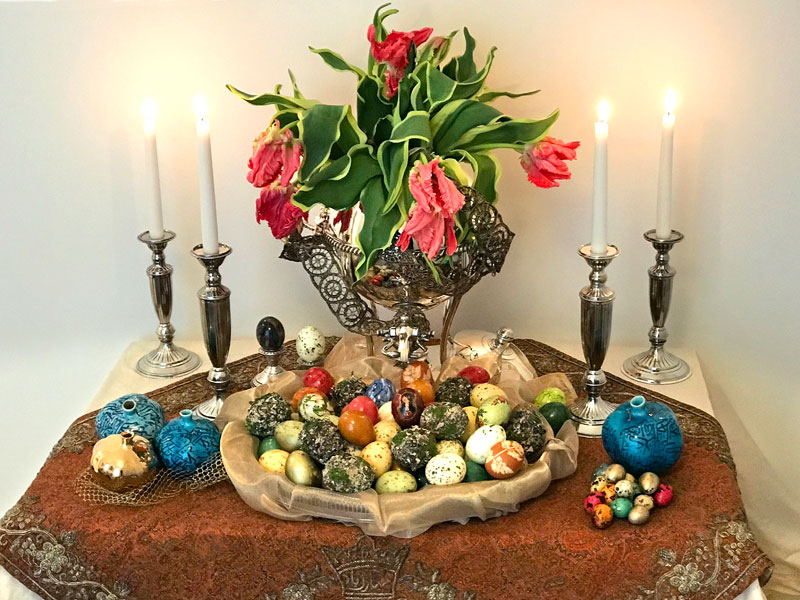
This is a close-up of the sofreh which was inspired by the Sensual Touch parrot tulips, displayed in a large antique silver-plated urn. The graceful movement of the stems of the parrot tulips is intriguing. The shiny surface of the urn, which is embellished with antique gold trims, substitutes the mirror. The turquoise shade of the ceramic pomegranates, embellished with calligraphy, is reminiscent of the radiant Persian tiles that are lavishly included in Persian architecture.
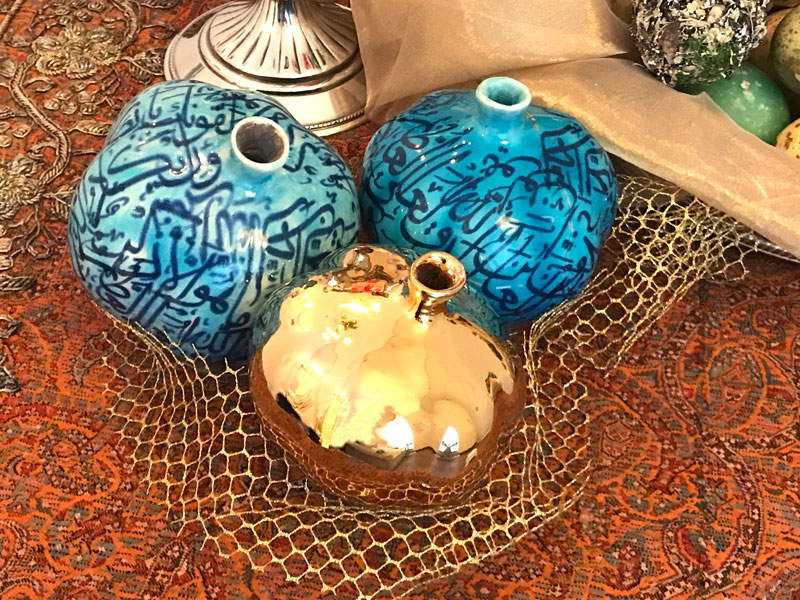
This image focuses on the left side of the marriage sofreh. It showcases ceramic pomegranates, a symbol of fertility, placed on a length of gold-toned open mesh. The juxtaposition of shiny, radiant gold and turquoise ceramic pomegranates, embellished with calligraphy, enhances the allure of this colourful composition.
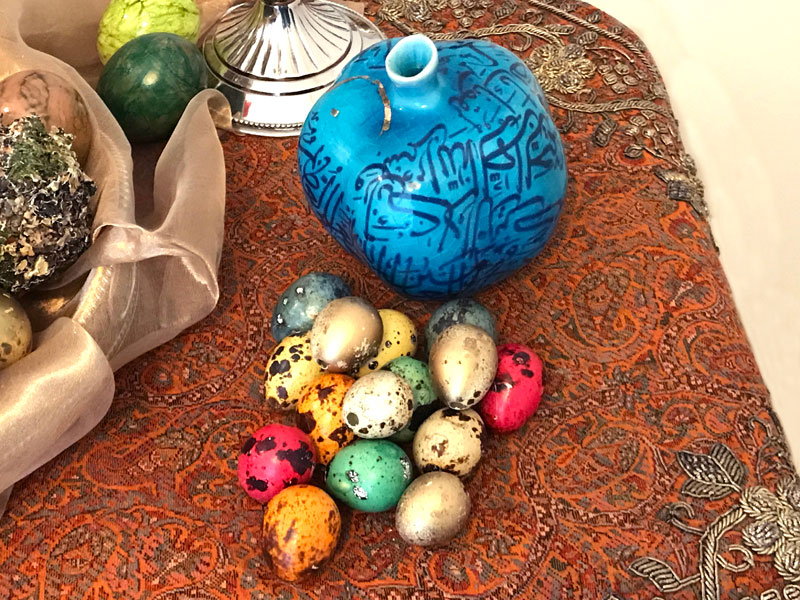
This image focuses on the right side of the marriage sofreh. It showcases a ceramic pomegranate and decorated quail eggs, both symbols of fertility. The juxtaposition of a radiant turquoise ceramic pomegranate, embellished with calligraphy, and the decorated quail eggs enhances the allure of this colourful composition.
Tulips & Kilim
This arrangement on an acrylic side table, placed on an antique Afshar kilim, alludes to a marriage sofreh (sofreh-ye aqd). The fantastic double tulips are at the heart of the composition. A folded silver-plated serving tray stands in for the mirror, surrounded by several of the symbolic elements of the marriage sofreh—candelabra, handmade bonbonnières in the Persian spirit, crystal sugar, antique gold coins and hand-painted eggs.
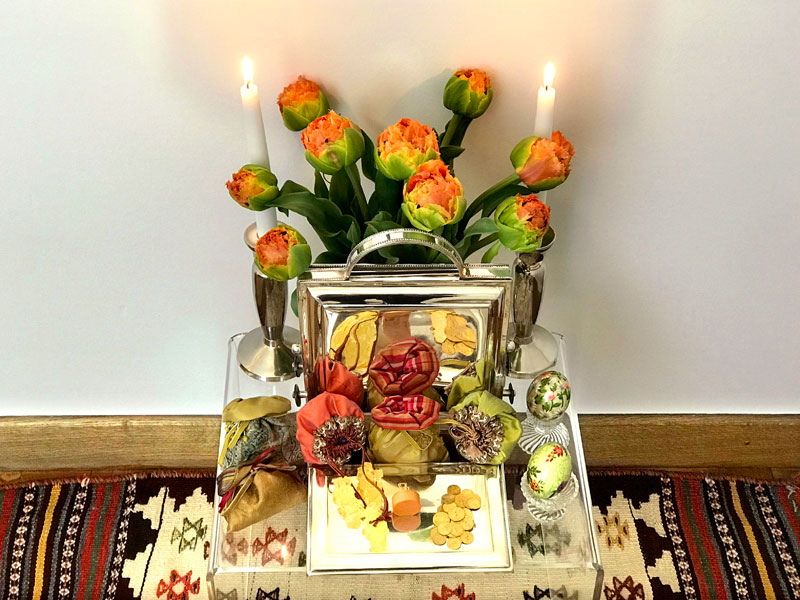
This image showcases the overall view of the marriage sofreh, which is designed around the lovely, bright orange, double tulips, known as Sensual Touch. The pleasing orange and green colour scheme is evident throughout the composition, with the plump tulips on the top, and the bonbonnières made of silk, in the same tones, placed at a lower level.

This is a close-up of the central section of the Tulip & Kilim sofreh. The colourful handmade bonbonnières in the Persian spirit, protrude from a silver-plated box. The antique gold coins and the translucent gold crystal sugar are placed on the lid of the box. Their subtle reflection is evident in the shiny silver-plated panel, which has substituted the mirror.
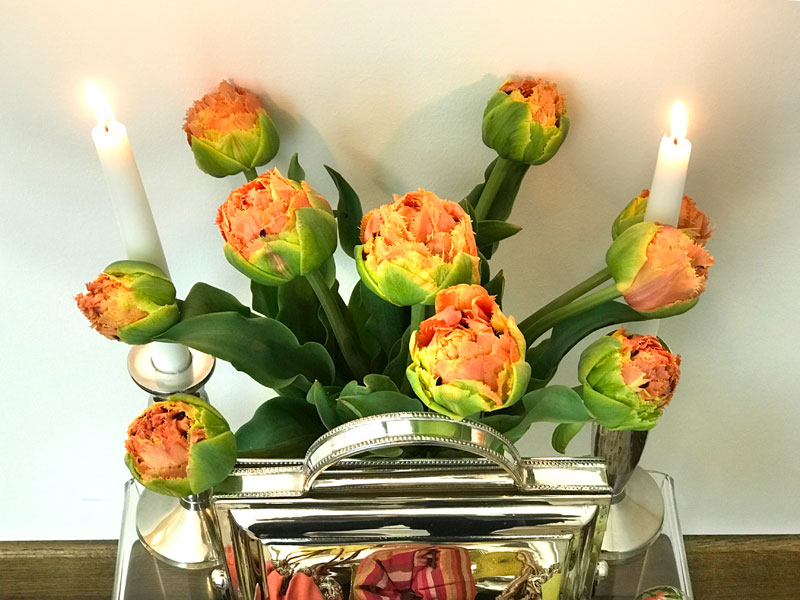
These stunning late double tulips, known as Sensual Touch, inspired the creation of this composition, as well as the two that will follow. This is a close-up of the bright orange and pistachio green luscious flowers next to the candlelight. Flowers and flames are vital symbolic elements of any Persian sofreh, enhancing its natural beauty and sparkle.
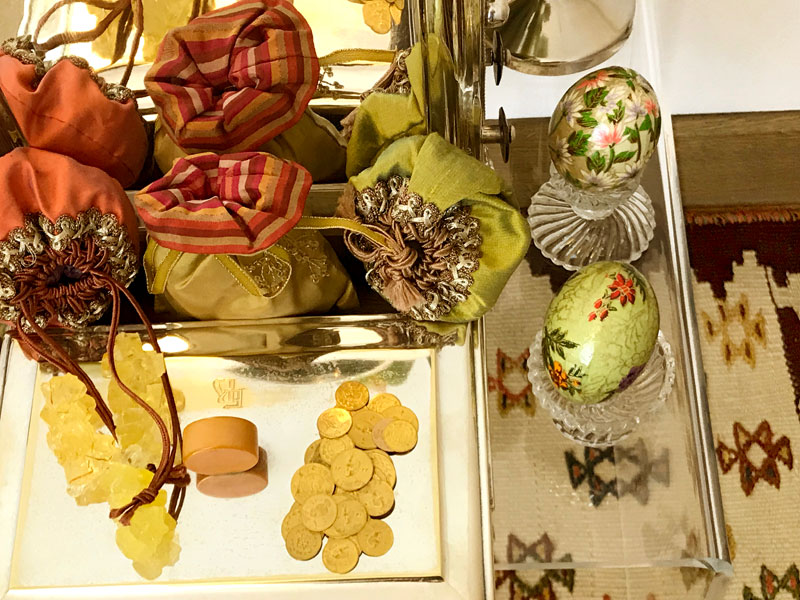
This image focuses on the right and central section of the Tulip & Kilim sofreh, so the intricate details of the handmade bonbonnière are more visible. The hand-painted eggs (a symbol of fertility) are presented inside tiny glass containers. Gold coins and translucent gold crystal sugar, symbols of prosperity and harmony, add sparkle to this composition.
Tulips & Victorian-Style Bread Warmer
This arrangement on an acrylic side table, placed on fragments of an antique textile, alludes to a marriage sofreh (sofreh-ye aqd). The fantastic double tulips are at the heart of the composition. A Victorian-style bread warmer holds the bread. Two sets of candelabra are included. A jug of rosewater and a container of sugared almonds adorned with a single gold coin are presented on a delicate silver tray. Gold tassels and trims enhance the beauty of this original arrangement.
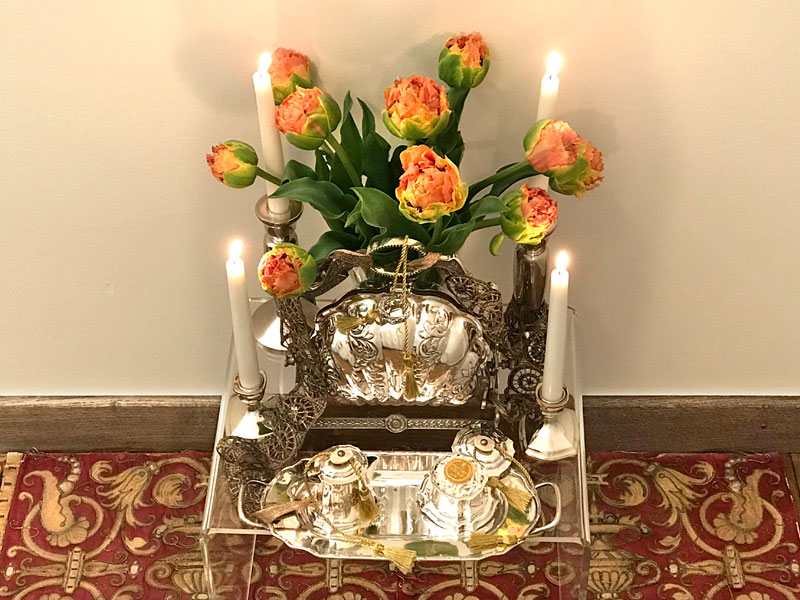
This image showcases the overall view of the marriage sofreh, which is designed around the shimmering orange, double tulips, and a Victorian-style bread warmer. The acrylic side table is placed on lengths of antique European textile in subdued tones of red and gold. The juxtaposition of the shiny silver-finish containers and the illuminated, brightly coloured tulips creates an appealing and dazzling ambience.
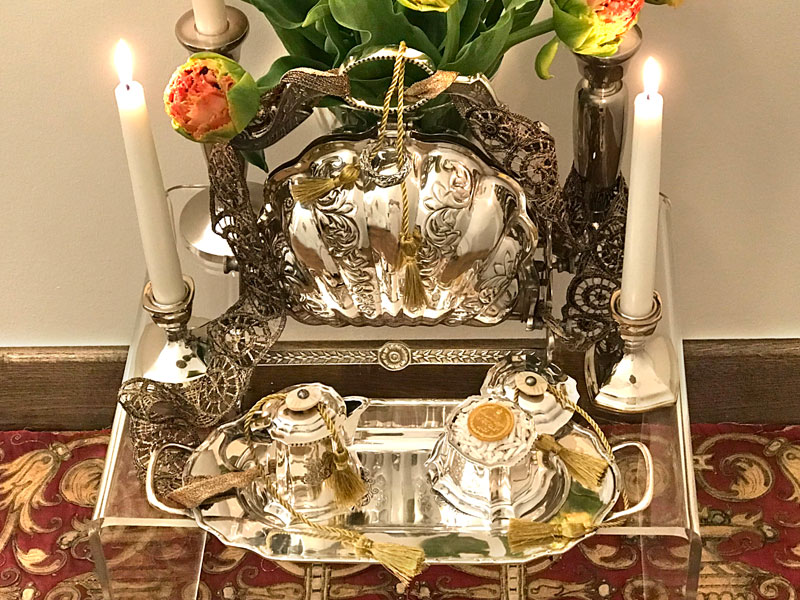
This is a close-up of the central section of this sofreh. The silver-plated Victorian-style bread warmer contains the bread, symbolizing abundance and blessing. It has a shiny silver finish, which provides reflection like a mirror. An elegant silver tray holds a jug of rosewater, and a container of sugared almonds adorned with a single gold coin. Gold tassels and trims enhance the beauty of this original arrangement.
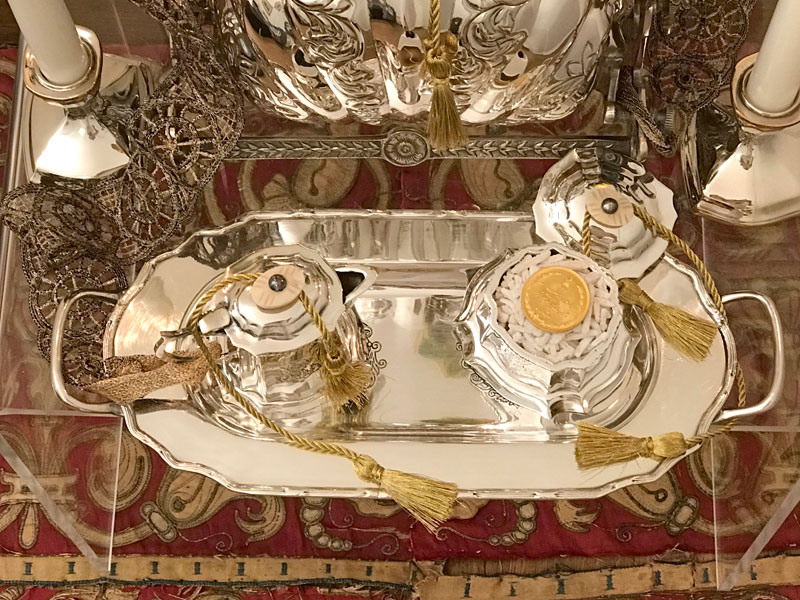
This is a close-up of the delicate tray, which showcases a jug of Persian rosewater to perfume the air, and a lidded container of sugared almonds adorned with a single gold coin, which symbolize a pleasant and prosperous married life. Fine gold tassels elegantly adorn this dainty silver-plated tray and the miniature containers it holds.
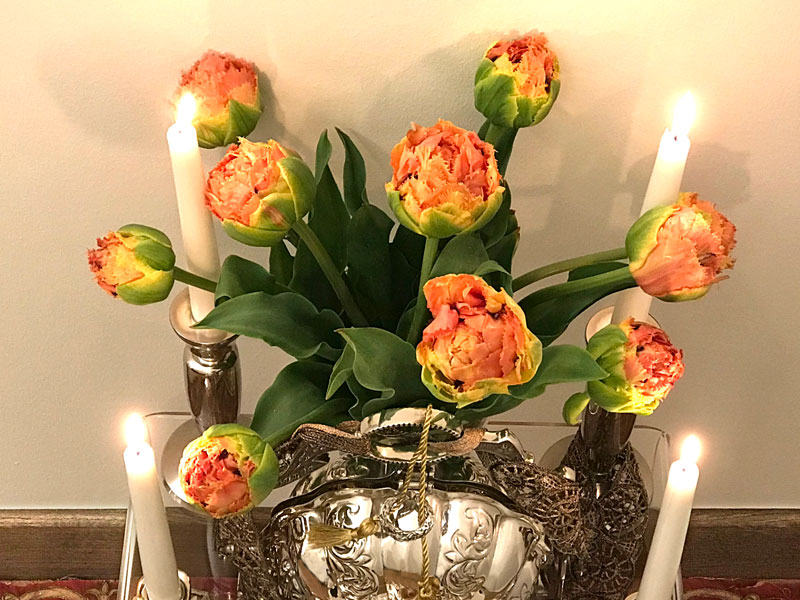
These stunning late double tulips, known as Sensual Touch, inspired the creation of this composition, as well as the ones above and below. This is a close-up of their luscious flowers, illuminated with two pairs of shimmering flames. Flowers and flames are vital symbolic elements of any sofreh, enhancing its natural beauty and sparkle.
Tulips & Ottoman Textile
This arrangement on and underneath an acrylic table, placed on raw silk, alludes to a marriage sofreh (sofreh-ye aqd). The fantastic double tulips are at the heart of the composition. A fragment of an Ottoman textile is presented in an antique frame. The shimmering flames illuminate the arrangement. A single white ceramic pomegranate, containers of decorated quail eggs, shiny red and gold ceramic pomegranates and a ruffled container of crystal sugar adorn the composition.
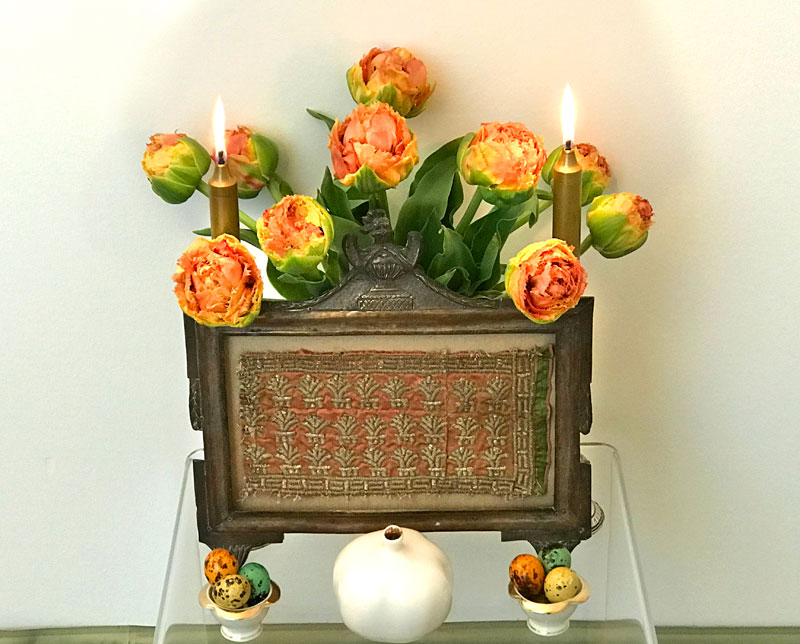
This is the heart of the sofreh showcasing the fragment of the Ottoman textile, next to the stunning candle-lit tulips. The single white ceramic pomegranate with a subtle gold rim and the white and gold containers of decorated quail eggs, which are symbols of life and fertility, complement the composition.
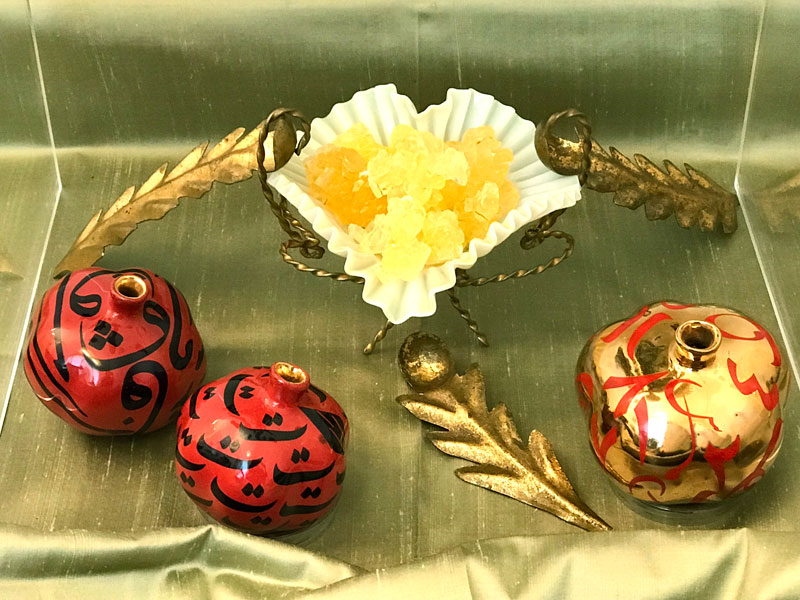
The focus of this image is the symbolic elements which decorate the floor under the transparent table, and over a ruffled piece of silk. The two-level arrangement brings an original touch to the sofreh. The ceramic pomegranates (a symbol of fertility) are embellished with calligraphy. A ruffled container of translucent crystal sugar (aspiring to a pleasant married life) and a few antique gold-finish leaves enhance the beauty of this original sofreh.
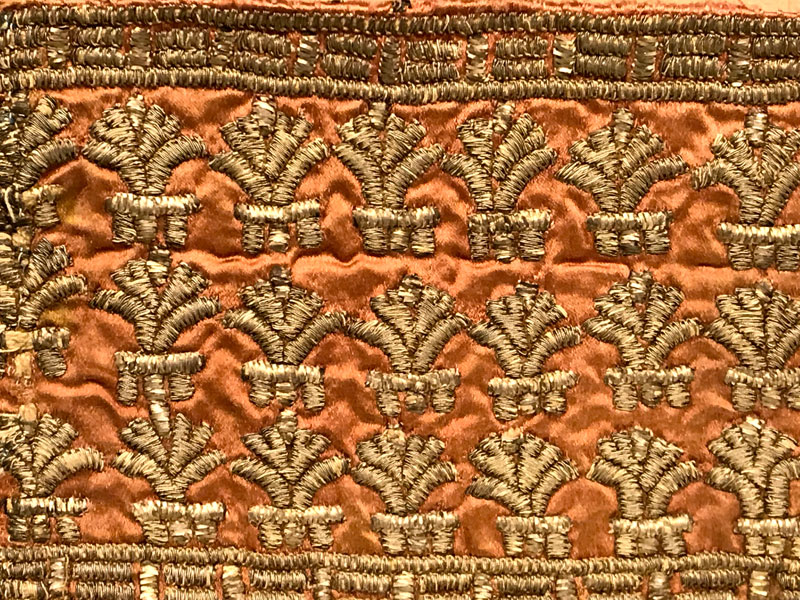
This image focuses on the details of the fragment of the fine Ottoman silk textile, lavishly and intricately embroidered with delicate gold-coloured and silver-finish threads, showcasing rows of stylized botanical motifs. The shiny, orange background of the antique silk complements the lovely hues of the stunning Sensual Touch, orange and pistachio green double tulips, which inspired a group of three Persian sofreh arrangements presented here.
Indian Textile
This refreshing and compact sofreh features an antique silver container of bright orange Pom Pom ranunculi, a pair of candles and two birds, representing the couple. An antique Indian textile, embroidered with gold-wrapped thread and iridescent wing-cases of jewel beetles, is draped around these symbolic elements of the marriage sofreh. For more information about this type of textile, visit https://www.vam.ac.uk/articles/indian-embroidery.
Soft Gold
This soft marriage sofreh (sofreh-ye aqd), arranged on a draped antique Persian textile, showcases some of the symbolic elements of the sofreh including a mirror, candelabra, a bowl made of crystal sugar (kaseh nabat), a pair of decorated miniature sugarloaves (kalleh qand), embellished eggs and walnuts, a pair of antique, ruby-red rosewater bottles and a delightful bouquet of Pom Pom ranunculi.
Blue, Gold & Silver
This delightful composition, arranged on and in front of an antique Persian brocade, features a silver container of roses, arranged around a blue ornament, a pair of candleholders, gold-rimmed tumblers showcasing crystal sugar, as well as bottles of rosewater that are displayed horizontally, and a pair of birds—some of the symbolic elements of the marriage sofreh.
Radiant Ranunculi & Termeh
This sofreh, arranged on an elaborately embroidered antique Persian textile known as termeh, showcases a silver container of dazzling Pom Pom ranunculi, a pair of candleholders, decorated eggs, crystal sugar in the form of an apple, sugared almonds speckled with gilded coins, and a delicate mirrored antique rosewater jug—some of the symbolic elements of the marriage sofreh.
Mantelpiece

This is the frontal view of the overall composition. Plump full-bodied roses are beautifully reflected in the mirror. A lovely piece of termeh with an elaborate trim is draped over the mantelpiece. Different shades and sizes of apples, two miniature containers (one containing sugared almonds, the other gilded coins) and lots of glowing flames complement this simple arrangement.
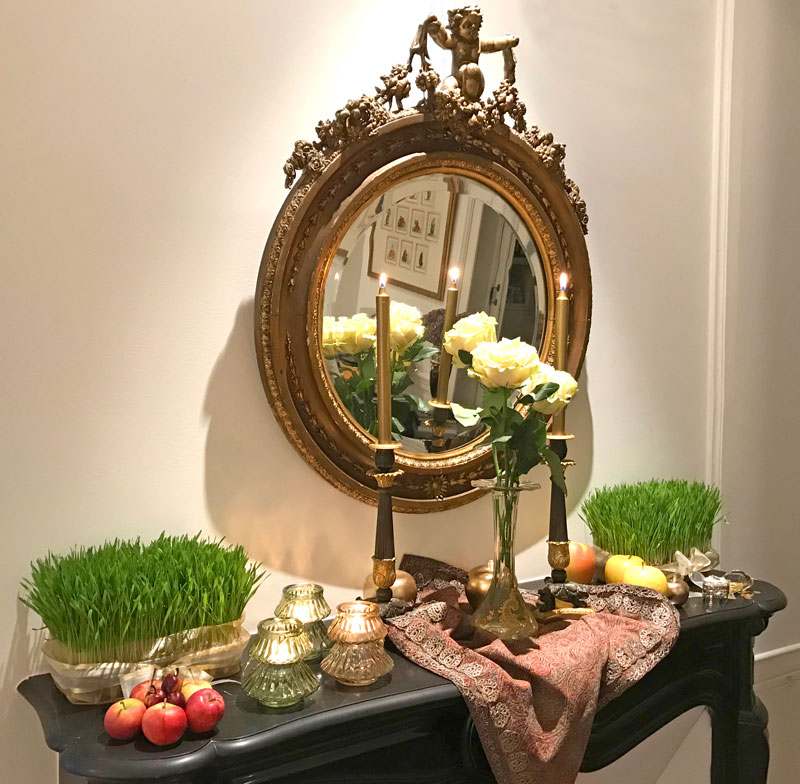
This is a slightly angled view of the overall composition. Again, plump full-bodied roses are beautifully reflected in the mirror. A lovely piece of termeh with an elaborate trim is draped over the mantelpiece. Different shades and sizes of apples, two miniature containers (one containing sugared almonds, the other gilded coins) and lots of glowing flames complement this simple arrangement.
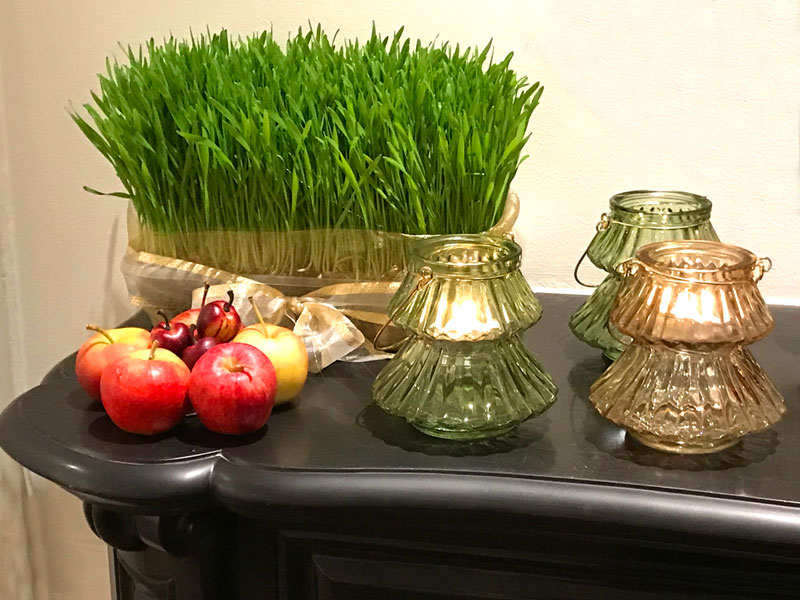
The focus of this image is one end of the arrangement on an antique mantelpiece, incorporating sabzeh (the essence of the Nowruz festival and a symbol of growth and rebirth), and tiny red and yellow apples, which create a pleasant contrast with the vivid green sabzeh. The flickering flames of the tea lights softly illuminate this corner.
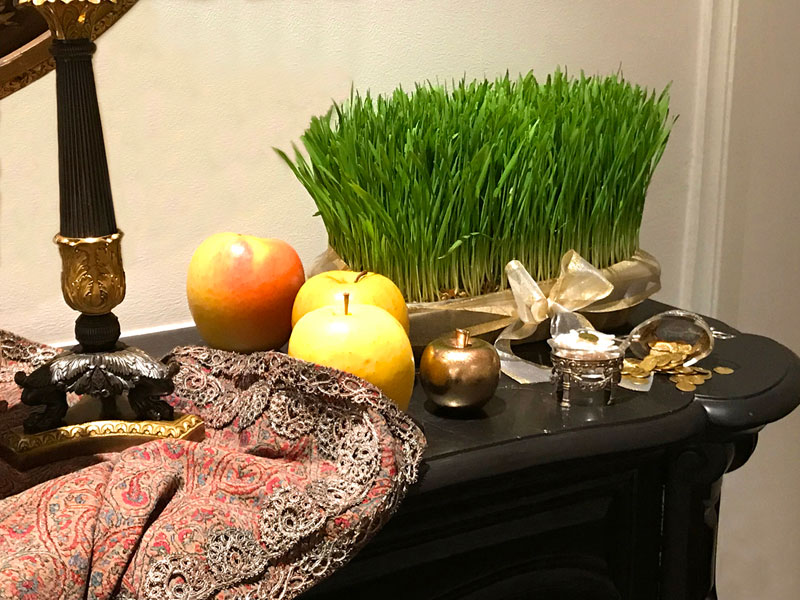
This image focuses on the other end of the arrangement on an antique mantelpiece, incorporating sabzeh, oversized apples, a delicate gold-painted apple sculpture, two miniature containers—one upright, containing sugared almonds, the other on its side containing gilded coins—and a piece of termeh with an elaborate border.
Ceramic Pomegranates

A rectangular sabzeh is placed in the centre of the silver tray presenting the ceramic pomegranates. Some other symbolic elements of Nowruz such as apples, hyacinths, tulips and shimmering flames adorn the arrangement. The exquisite embroidered antique textile, known as termeh, enhances this compact sofreh’s beauty.
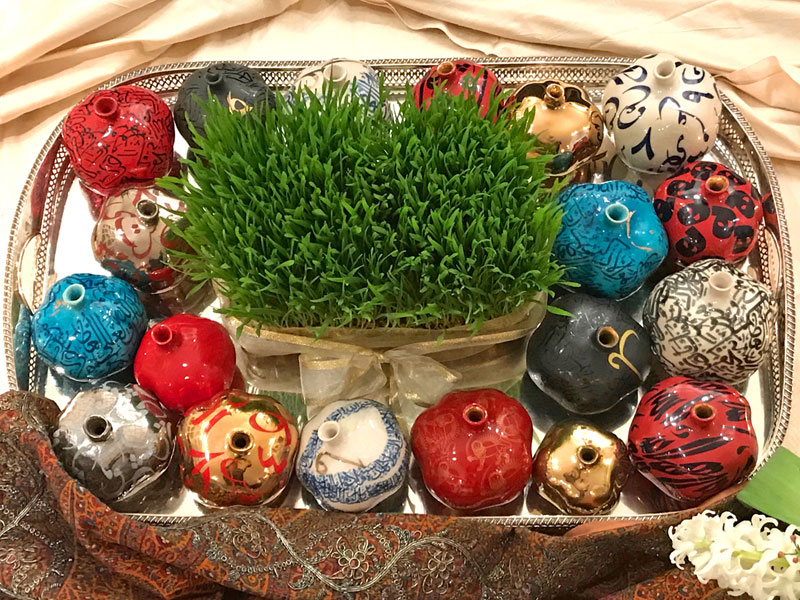
This image focuses on the sabzeh placed in the centre of a collection of ceramic pomegranates, principally created by the Iranian/Canadian artist, Keyvan Fehri. This is the central section of the sofreh, which was inspired by this collection. The embroidered border of the termeh enhances the beauty of the sculptured pomegranates.
Seven Steps
Nowruz Versus Christmas
December 2018. This unconventional and original outdoor sofreh is inspired by the symbolic elements of the sofreh-ye Nowruz (haft sinn) such as germinated wheat (sabzeh), spring flowers (hyacinths and tulips), apples and pomegranates, as well as Christmas ornaments such as pine cones, nuts, and holly and pine sprigs.
The first two images present the overall composition in two different lights—before and after sunset—which demonstrate a fascinating contrast.

This appealing image was taken before sunset. The sofreh is displayed on four levels—the surface of a round, metal table covered with artificial snow, two garden chairs, an acrylic side table and the floor itself. The shiny ceramic pomegranates are reminiscent of baubles. The most dazzling characteristic of this unusual sofreh is the numerous shimmering candles, which are part of both Nowruz and Christmas adornments.
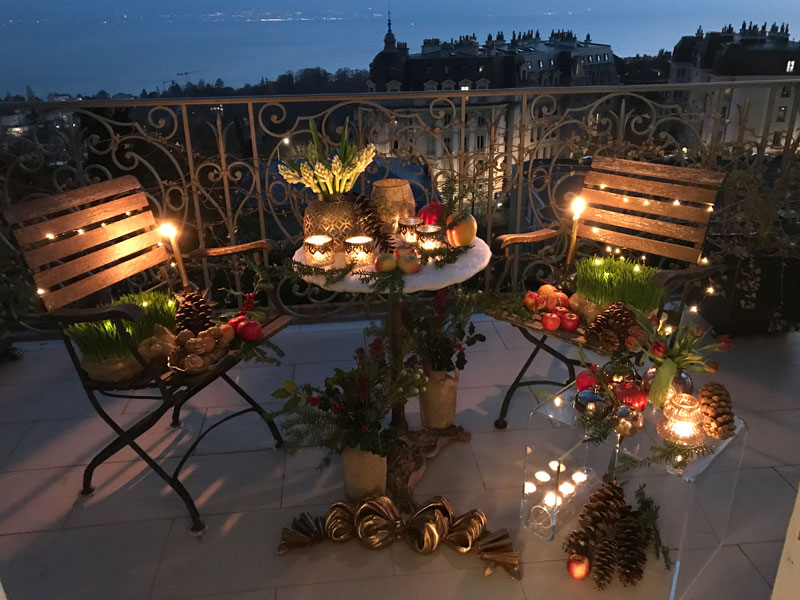
This image, which also reveals the engaging backdrop, was taken after sunset. The sofreh is displayed on four levels—the surface of a round, metal table covered with artificial snow, two garden chairs, an acrylic side table and the floor itself. The shiny ceramic pomegranates are reminiscent of baubles. The most dazzling characteristic of this unusual sofreh is the numerous shimmering candles, which are part of both Nowruz and Christmas adornments.
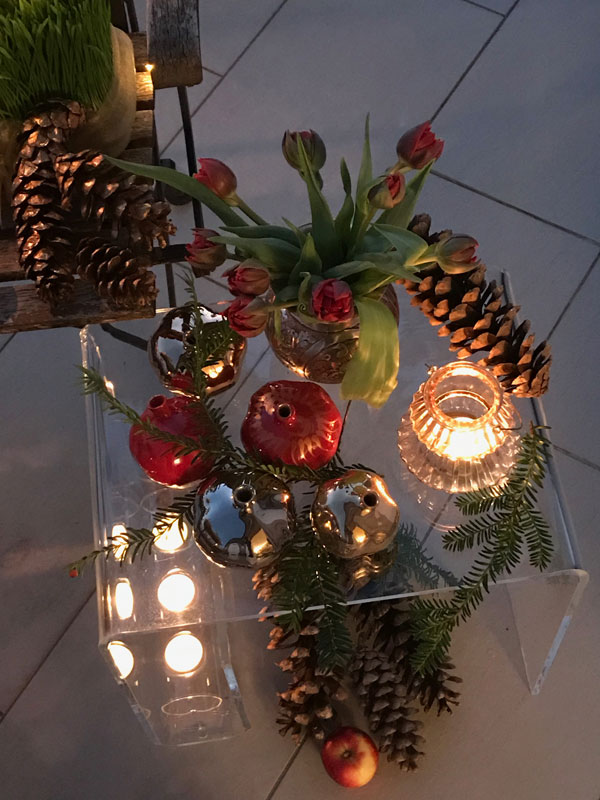
The focus of this image is the acrylic side table, providing an unusual base for the ceramic pomegranates in various shades, which are enchanting alternatives to baubles. The rough and natural pine cone on the table, as well as similar pine cones and a single tiny apple underneath the table provide an interesting contrast with the glossy pomegranates. A bouquet of red tulips brings a touch of spring. The composition is illuminated by a row of shimmering tea lights placed in the “pocket” of the table, and a separate tea light in an elegant holder.

The focus of this image is the central table covered with artificial snow, presenting the juxtaposition of the symbolic elements of Nowruz (a bouquet of hyacinths, a jumbo crimson pomegranate, an oversized apple, as well as tiny apples) with Christmas ornaments (pine tree sprigs and a giant pine cone). This original arrangement is subtly illuminated by five tea lights placed in a variety of elegant holders. Underneath the snow-covered table sit bouquets of various traditional Christmas foliage, including branches of pine tree and berried holly.
Shab-e Yalda, Winter Solstice
Jashn-e Mehregan
The Mehregan customs have evolved over the years, and while there are celebrations, people do not spread a sofreh. However, a sofreh was apparently part of the celebrations in the past.
Marriage Ceremony (aqd), Outdoor Sofreh
August 2018. This delightful outdoor sofreh was put together by the author in Vancouver, B.C., Canada, for the marriage ceremony of a friend.
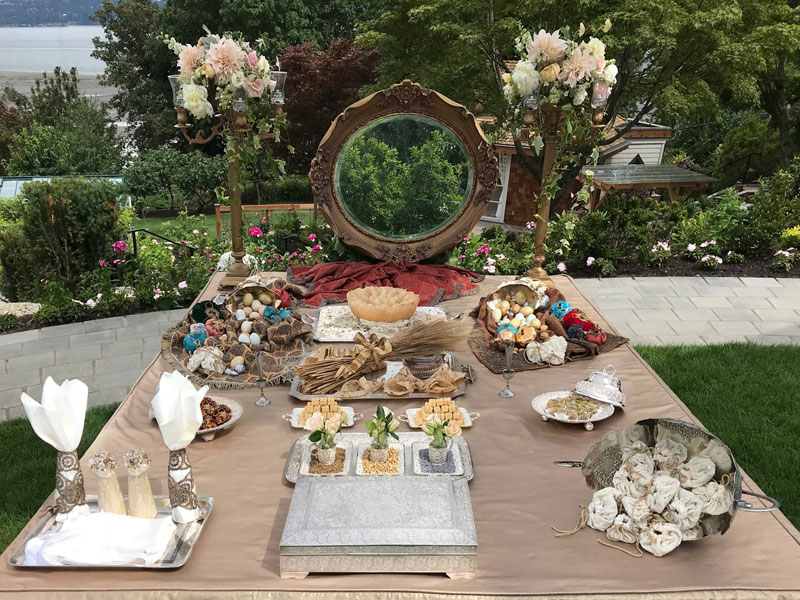
In August 2018 this refreshing outdoor sofreh was put together by the author in Vancouver, Canada. This image presents the overall composition, incorporating many of the symbolic elements of the marriage sofreh (sofreh-ye aqd). The next images show the intricate details of this sofreh. Undoubtedly the breathtaking view, as the backdrop, made this elegant and harmonious sofreh truly unique.
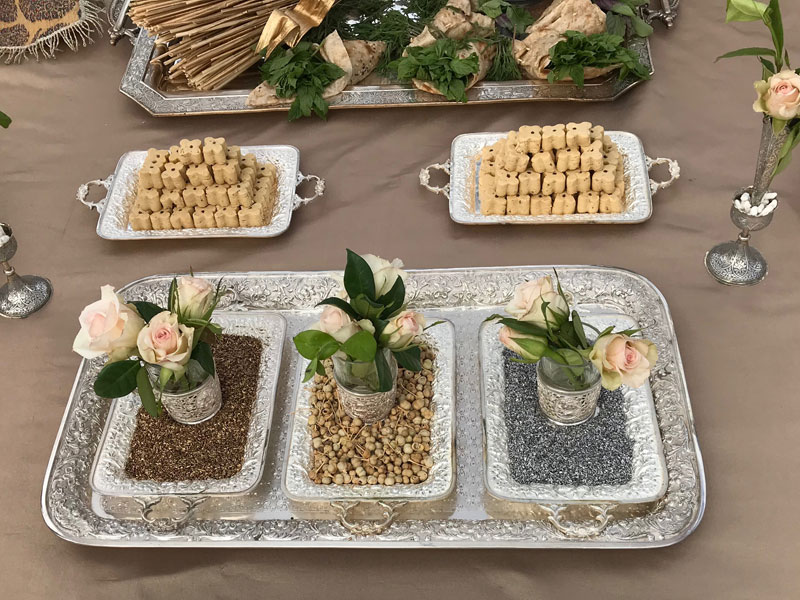
This is the central part of the sofreh. Three small trays, known as farmanbar, contain natural pods of rue (esfand), as well as its gold and silver decorated seeds. A traditional Persian tea glass containing miniature roses and foliage is placed in the centre of each tray. Behind this delicate composition, there are two farmanbars containing traditional Persian homemade pastries.
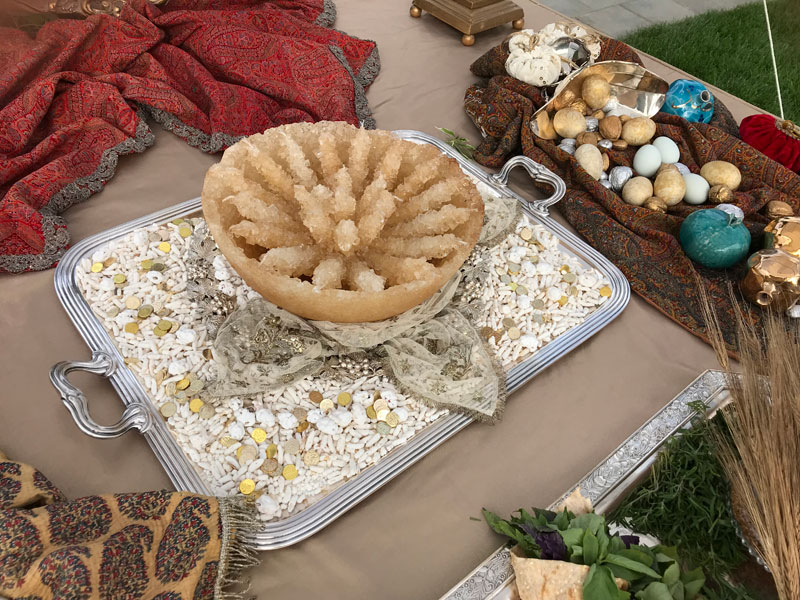
This delightful bowl of crystal sugar, known as kaseh nabat, forms part of the August 2018 outdoor sofreh. The kaseh nabat is placed on a round silver tray and embellished with a piece of antique embroidered tulle, known as naqdeh. The round tray is presented on a bed of Persian sugared almonds and gilded coins, known as noql and sekkeh, on a larger silver tray.

This is another section from the August 2018 outdoor sofreh showcasing an impressive antique silver tray containing a bunch of hand-tied wheat and traditional Persian flat bread in the shape of cones holding fresh herbs—all symbols of growth, abundance and flourishing. In the foreground two silver farmanbars contain traditional Persian homemade pastries.
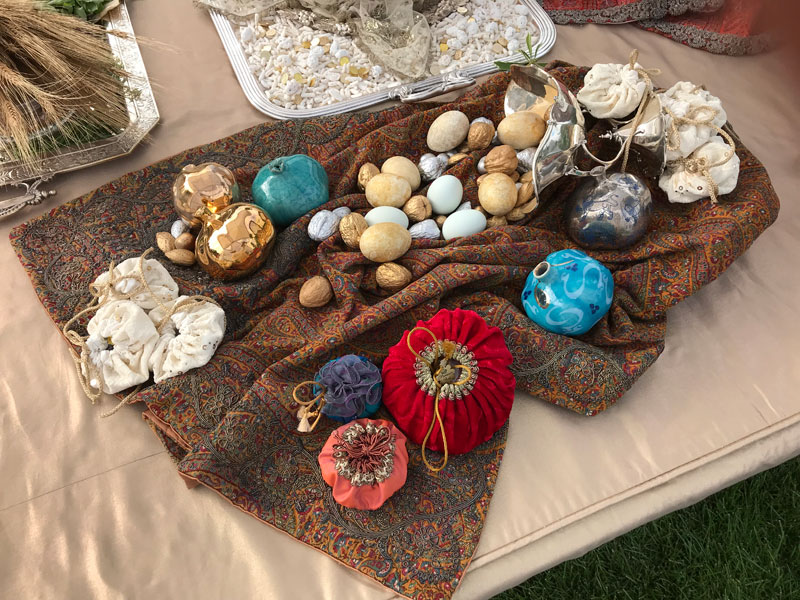
This section of the August 2018 outdoor sofreh includes a piece of antique Persian textile, known as termeh, beautifully embroidered with metallic thread. A mixture of natural and hand-decorated eggs, nuts, ceramic pomegranates and handmade bonbonnières flow out of a tilted, antique silver container.
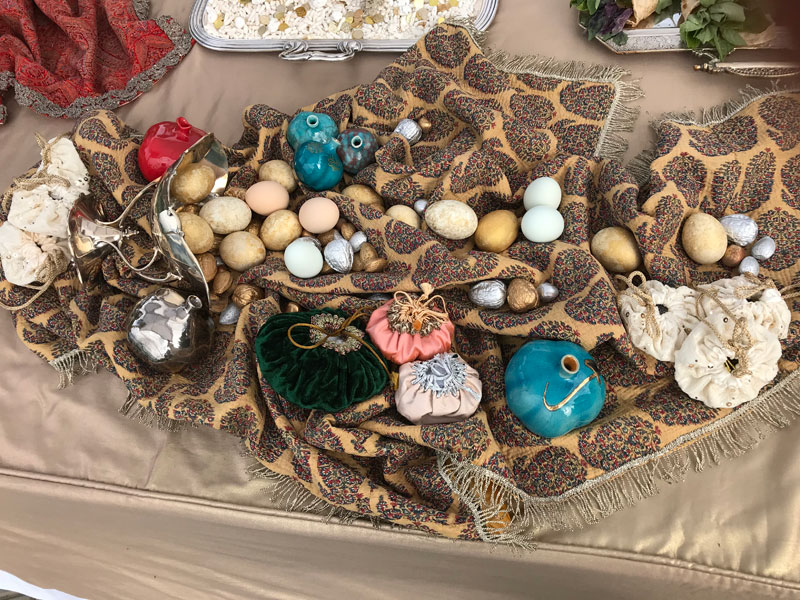
This corner of the August 2018 outdoor sofreh includes a different piece of termeh in a pale yellow tone, with a lovely metallic fringe. Once again, a mixture of natural and hand-decorated eggs, nuts, colourful ceramic pomegranates and handmade bonbonnières flow out of a tilted, antique silver container.

